The {Page-Turner-Cookbook} featuring
italy Is My Kitchen
ITALY Breakfast Appetizers & Soups
Weight & temperature Measures
non-liquid ingredients
Top 5 countries
Last Page
Artichokes vinaigrette
Asparagus and tomato salad with feta
Asparagus mimosa
Baked goat cheese with salad greens
Beet with frizzled leek and gorgonzola crostini
Broccoli au gratin
Broccoli rabe with parmesan cheese
Broccoli salad
Bruschetta dip
Bruschetta orzo salad
Caprese salad
Carrot gnocchi
Cauliflower risotto
Celery root and mashed potatoes
Cheese tart with artichoke hearts
Cold broccoli soup
Creamed spinach
Creamed spinach with mushrooms
Creamy polenta with gorgonzola
Crispy fried tomato slices
Dried tomato and fennel stuffing
Eggplant and tomato with chevre
Eggplant caponata
Eggplant caviar
Eggplant soufflé
Flatbread pizzas
Fried green tomatoes
Frittata
Garlic roasted potatoes
Goat cheese and sun-dried tomato toasts
Grilled tomatoes kebabs
Italian stuffing with sausage
Onion parmesan gratin
Orzo salad with lemon and herb
Orzo with wild mushrooms
Panettone
Parmesan and thyme crackers
Parmesan sage polenta sticks
Pesto
Polenta fries
Pumpkin and sweet garlic custards
Pumpkin gnocchi with almond pesto
Roasted tomato caprese salad
Roasted tomatoes
Roasted tomatoes and red peppers
Roman maritozzi
Sicilian arancini
Soft polenta
Sparkling lemon cream
Spring green risotto
Stuffed tomatoes with mussels
Summer salad
Sweet onion risotto cakes
Sweet potato gnocchi with sage and brown butter
Tomato aspic
Tomato-feta phyllo kisses
Vegetable and herb orzo salad
Zucchini carpaccio salad
Zucchini carpaccio with pesto, lemon and parmesan
ITALY Main Dishes
Asparagus and tomato salad with feta
Asparagus mimosa
Baked goat cheese with salad greens
Beet with frizzled leek and gorgonzola crostini
Broccoli au gratin
Broccoli rabe with parmesan cheese
Broccoli salad
Bruschetta dip
Bruschetta orzo salad
Caprese salad
Carrot gnocchi
Cauliflower risotto
Celery root and mashed potatoes
Cheese tart with artichoke hearts
Cold broccoli soup
Creamed spinach
Creamed spinach with mushrooms
Creamy polenta with gorgonzola
Crispy fried tomato slices
Dried tomato and fennel stuffing
Eggplant and tomato with chevre
Eggplant caponata
Eggplant caviar
Eggplant soufflé
Flatbread pizzas
Fried green tomatoes
Frittata
Garlic roasted potatoes
Goat cheese and sun-dried tomato toasts
Grilled tomatoes kebabs
Italian stuffing with sausage
Onion parmesan gratin
Orzo salad with lemon and herb
Orzo with wild mushrooms
Panettone
Parmesan and thyme crackers
Parmesan sage polenta sticks
Pesto
Polenta fries
Pumpkin and sweet garlic custards
Pumpkin gnocchi with almond pesto
Roasted tomato caprese salad
Roasted tomatoes
Roasted tomatoes and red peppers
Roman maritozzi
Sicilian arancini
Soft polenta
Sparkling lemon cream
Spring green risotto
Stuffed tomatoes with mussels
Summer salad
Sweet onion risotto cakes
Sweet potato gnocchi with sage and brown butter
Tomato aspic
Tomato-feta phyllo kisses
Vegetable and herb orzo salad
Zucchini carpaccio salad
Zucchini carpaccio with pesto, lemon and parmesan
Asparagus and tomato salad with feta
Asparagus mimosa
Asparagus with cream cheese and prosciutto
Asparagus with Parma ham and roasted pepper coulis
Baked carrot terrine
Baked polenta with fontina and gorgonzola
Baked salmon fillet with basil sauce
Baked shrimp with orzo and feta
Balsamic potato salad
Bowtie pasta with shrimp and asparagus
Braised salmon steaks with fennel and thyme
Brunch strata with crabmeat and asparagus
Bruschetta orzo salad
Cacio e pepe pasta
Cajun salmon fillet grenobloise with angel hair pasta
Calzones
Campanelle pasta with hen of the woods mushrooms
Cannellonis
Caprese pasta salad
Caprese portobello mushrooms
Carrot gnocchi
Cauliflower and pasta
Chicken breasts in vermouth
Chicken breasts parma
Chicken breasts veronique
Chicken primavera
Chicken provencale
Chicken salad with pasta and asparagus
Chicken with endive radicchio and balsamic vinegar glaze
Chicken with portobello mushroom sauce
Crown roast of lamb in a parmesan-sage crust
Curried mussel salad with tiny pasta
Eggplant meatballs in marinara
Fall greens with walnuts feta and walnut vinaigrette
Fettuccini primavera and pesto dressing
Frittata
Garlic mussels with pasta and cherry tomatoes
Gnocchi alla romana
Gnocchi with green chive sauce
Gnocchi with spinach and ricotta
Grilled bruschetta chicken
Grilled chicken and vegetable pasta salad
Grilled chicken pesto
Grilled salmon fillets with sun-dried tomatoes
Grilled sardines
Homemade pizza dough
Lasagna
Lemon chicken breast
Lemon chicken cutlets
Linguine alla carbonara
Linguine primavera
Mediterranean farro salad
Minestrone with cabbage and spinach
Mussels and spaghetti
Mussels marinara with linguine
Neapolitan pizza for a home kitchen
Nicoise orzo salad
Onion and cheese frittata
Orecchiette with shiitake mushroom sauce
Orzo pilaf with green onions
Orzo salad with lemon and herb
Panzanella salad
Parmesan and basil chicken salad
Parmesan polenta soufflé
Pasta and tuna with caper dressing
Pasta e fagioli with pesto and butternut squash
Pasta fagioli
Pasta roll with three cheese
Pasta salad in parmesan baskets
Pasta with summer vegetables
Penne in cream sauce and sausage
Pissaladière Provençale
Pistou soup
Pizza margherita
Polenta a la romaine
Pork chops parmigiana
Potato gnocchi -gnocchi di patate
Potato gnocchi with lobster
Rack of lamb with mushroom crust
Risotto with mushrooms asparagus and spring peas
Roast tomato tart
Roasted salmon with white beans tomato and spinach
Roasted tomato caprese salad
Rollatines of chicken
Rosemary chicken salad
Rosemary-roasted chicken with potatoes and fennel
Rotolo di spinaci - spinach and ricotta lasagne roll-ups
San remo pasta salad
Sardines with confit thyme tomatoes
Scallopine of cod piccata
Shrimp scampi
Shrimp-tortellini pesto
Silk handkerchiefs with pesto
Smoky cheddar and tomato cornbread
Soft potato ravioli with truffle pan sauce
Soufflé renversé
Spaghetti bake
Spaghetti meat sauce
Spaghetti squash pesto with tomatoes
Spaghetti with creamy garlic and leeks
Spinach and pasta salad
Spring green risotto
Striped bass italienne
Stuffed chicken breasts
Stuffed pork chops with polenta and tomatoes
Summer pasta vegetable salad
Summer squash skins with garlic bread crumbs
Summer tomato salad
The pasta salad
Tomato and Seafood Penne
Tomato pie with polenta crust
Tomato-basil tortellini
Tomatoes stuffed with goat cheese
Tortellini tomato soup
Tri-color salad
Tuscan ribollita soup
Tuscan soup
Vegetable lasagna
Vegetarian minestrone
ITALY Desserts
Asparagus mimosa
Asparagus with cream cheese and prosciutto
Asparagus with Parma ham and roasted pepper coulis
Baked carrot terrine
Baked polenta with fontina and gorgonzola
Baked salmon fillet with basil sauce
Baked shrimp with orzo and feta
Balsamic potato salad
Bowtie pasta with shrimp and asparagus
Braised salmon steaks with fennel and thyme
Brunch strata with crabmeat and asparagus
Bruschetta orzo salad
Cacio e pepe pasta
Cajun salmon fillet grenobloise with angel hair pasta
Calzones
Campanelle pasta with hen of the woods mushrooms
Cannellonis
Caprese pasta salad
Caprese portobello mushrooms
Carrot gnocchi
Cauliflower and pasta
Chicken breasts in vermouth
Chicken breasts parma
Chicken breasts veronique
Chicken primavera
Chicken provencale
Chicken salad with pasta and asparagus
Chicken with endive radicchio and balsamic vinegar glaze
Chicken with portobello mushroom sauce
Crown roast of lamb in a parmesan-sage crust
Curried mussel salad with tiny pasta
Eggplant meatballs in marinara
Fall greens with walnuts feta and walnut vinaigrette
Fettuccini primavera and pesto dressing
Frittata
Garlic mussels with pasta and cherry tomatoes
Gnocchi alla romana
Gnocchi with green chive sauce
Gnocchi with spinach and ricotta
Grilled bruschetta chicken
Grilled chicken and vegetable pasta salad
Grilled chicken pesto
Grilled salmon fillets with sun-dried tomatoes
Grilled sardines
Homemade pizza dough
Lasagna
Lemon chicken breast
Lemon chicken cutlets
Linguine alla carbonara
Linguine primavera
Mediterranean farro salad
Minestrone with cabbage and spinach
Mussels and spaghetti
Mussels marinara with linguine
Neapolitan pizza for a home kitchen
Nicoise orzo salad
Onion and cheese frittata
Orecchiette with shiitake mushroom sauce
Orzo pilaf with green onions
Orzo salad with lemon and herb
Panzanella salad
Parmesan and basil chicken salad
Parmesan polenta soufflé
Pasta and tuna with caper dressing
Pasta e fagioli with pesto and butternut squash
Pasta fagioli
Pasta roll with three cheese
Pasta salad in parmesan baskets
Pasta with summer vegetables
Penne in cream sauce and sausage
Pissaladière Provençale
Pistou soup
Pizza margherita
Polenta a la romaine
Pork chops parmigiana
Potato gnocchi -gnocchi di patate
Potato gnocchi with lobster
Rack of lamb with mushroom crust
Risotto with mushrooms asparagus and spring peas
Roast tomato tart
Roasted salmon with white beans tomato and spinach
Roasted tomato caprese salad
Rollatines of chicken
Rosemary chicken salad
Rosemary-roasted chicken with potatoes and fennel
Rotolo di spinaci - spinach and ricotta lasagne roll-ups
San remo pasta salad
Sardines with confit thyme tomatoes
Scallopine of cod piccata
Shrimp scampi
Shrimp-tortellini pesto
Silk handkerchiefs with pesto
Smoky cheddar and tomato cornbread
Soft potato ravioli with truffle pan sauce
Soufflé renversé
Spaghetti bake
Spaghetti meat sauce
Spaghetti squash pesto with tomatoes
Spaghetti with creamy garlic and leeks
Spinach and pasta salad
Spring green risotto
Striped bass italienne
Stuffed chicken breasts
Stuffed pork chops with polenta and tomatoes
Summer pasta vegetable salad
Summer squash skins with garlic bread crumbs
Summer tomato salad
The pasta salad
Tomato and Seafood Penne
Tomato pie with polenta crust
Tomato-basil tortellini
Tomatoes stuffed with goat cheese
Tortellini tomato soup
Tri-color salad
Tuscan ribollita soup
Tuscan soup
Vegetable lasagna
Vegetarian minestrone
Almond sherry ice cream with honeyed figs
Apricot tart
Baked alaska snow balls
Bavarois turinoise
Bomba italian doughnuts
Candied grapefruit peel
Caramelized figs with fudge sauce
Chocolate hazelnut cheesecake
Chocolate raspberry ice cream
Chocolate-mocha soufflé
Chocolate-orange sorbet
Cocoa sponge cake
Coconut-almond bars
Coffee custards
Fruit sorbet
Lemon cream tart
Lemon custard
Lemon krumkake
Lemon meringue pie tart
Lemon mousse
Lemon pudding cake
Lemon sorbet in lemon shells
Lemon tart #2
Lime curd and almond tart
Marbled strawberry bombe
Meringue baked apples
Meringue-strawberry
Orange mousse meringue pie
Panna cotta with berry compote
Peach custard ice cream with fresh peach compote
Peach ice cream
Pear tart tatin
Pears vigneronne
Pizzellis
Poached pears in red wine
Raspberry hazelnut praline soufflé glacé
Rose shaped apple dessert
Sicilian cannoli
Strawberries with zabaglione sauce
Strawberry-topped lime mousse tart
Upside-down peach cake
White chocolate and raspberry tart
Wine jelly
liquid MeasuresApricot tart
Baked alaska snow balls
Bavarois turinoise
Bomba italian doughnuts
Candied grapefruit peel
Caramelized figs with fudge sauce
Chocolate hazelnut cheesecake
Chocolate raspberry ice cream
Chocolate-mocha soufflé
Chocolate-orange sorbet
Cocoa sponge cake
Coconut-almond bars
Coffee custards
Fruit sorbet
Lemon cream tart
Lemon custard
Lemon krumkake
Lemon meringue pie tart
Lemon mousse
Lemon pudding cake
Lemon sorbet in lemon shells
Lemon tart #2
Lime curd and almond tart
Marbled strawberry bombe
Meringue baked apples
Meringue-strawberry
Orange mousse meringue pie
Panna cotta with berry compote
Peach custard ice cream with fresh peach compote
Peach ice cream
Pear tart tatin
Pears vigneronne
Pizzellis
Poached pears in red wine
Raspberry hazelnut praline soufflé glacé
Rose shaped apple dessert
Sicilian cannoli
Strawberries with zabaglione sauce
Strawberry-topped lime mousse tart
Upside-down peach cake
White chocolate and raspberry tart
Wine jelly
Weight & temperature Measures
non-liquid ingredients
Top 5 countries
Last Page
Add to that the fact that Italy became a unified nation only in 1861, after having mainly been a confederation of states for the previous thousand of years, and this diversity becomes even more obvious.
The Italian menu is typically structured in much the same way all over Italy, with an antipasto, primo, secondo and dessert.
Typical Italian foods and dishes include assorted appetizers (antipasti misti), all types of pasta, risotto and pizza, soups (minestroni and zuppe) and delicious meat and fish dishes.
The main regional differences are in the sources of carbohydrates, the origin of the proteins and the choice of vegetables or contorni (side dishes).
Appetizer Artichokes vinaigrette 
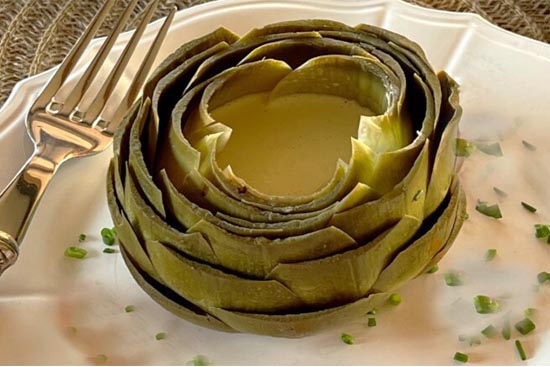
Serves: 6
1 cup red wine vinegar
1/4 cup salad oil
1/4 cup lemon juice
1 teaspoon Tabasco
1/4 teaspoon ground pepper
1/2 teaspoon salt
1 teaspoon oregano
1 teaspoon garlic powder
6 whole artichokes
Vinaigrette: makes 1 cup
1 tablespoon Dijon mustard
4 tablespoons red wine vinegar
1 teaspoon granulated sugar
1/2 teaspoon salt
1/2 teaspoon ground black pepper
1/2 cup olive oil
2 tablespoons minced parsley and/or chopped fresh chives
Preparation time: 20 minutes
Cooking time:35 minutes
1 gallon water 1 cup red wine vinegar
1/4 cup salad oil
1/4 cup lemon juice
1 teaspoon Tabasco
1/4 teaspoon ground pepper
1/2 teaspoon salt
1 teaspoon oregano
1 teaspoon garlic powder
6 whole artichokes
Vinaigrette: makes 1 cup
1 tablespoon Dijon mustard
4 tablespoons red wine vinegar
1 teaspoon granulated sugar
1/2 teaspoon salt
1/2 teaspoon ground black pepper
1/2 cup olive oil
2 tablespoons minced parsley and/or chopped fresh chives
Bring water to a boil and add all ingredients except artichokes. Wash and trim the artichoke stems to 1 inch. Remove stems.
Add to water with spices, and boil for 25 to 35 minutes or until bottoms are tender. Remove from pan and invert artichokes to drain thoroughly and cool. Using spoon, remove chokes and discard.
Vinaigrette:
In a mixing bowl, whisk mustard, vinegar, sugar, salt and pepper. Slowly whisk in oil until mixture thickens. Adjust seasoning to taste.
Stir the herbs. Whisk again just before serving.
Add to water with spices, and boil for 25 to 35 minutes or until bottoms are tender. Remove from pan and invert artichokes to drain thoroughly and cool. Using spoon, remove chokes and discard.
Vinaigrette:
In a mixing bowl, whisk mustard, vinegar, sugar, salt and pepper. Slowly whisk in oil until mixture thickens. Adjust seasoning to taste.
Stir the herbs. Whisk again just before serving.
Appetizer Asparagus and tomato salad with feta 
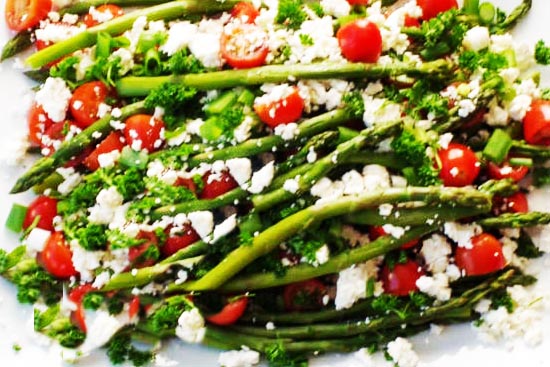
This Asparagus and Tomato Salad is easy to make with steamed asparagus, grape tomatoes, creamy feta, fresh herbs and a light dressing. The tarragon gives it a welcome hint of licorice. It can be eaten cold, warm or hot.
Asparagus is popular in the spring, especially around Easter and in the summer. It's peak season is April. This dish makes a great vegetable side dish and pairs perfectly with Easter.
Serves: 4
1 tbsp red wine vinegar
2 tsp Dijon mustard
1/2 tsp salt
1/2 tsp black pepper
1/2 cup olive oil
2 tbsp freshly chopped parsley
1 tsp dried tarragon (use 1 tablespoon if using fresh)
2 lbs asparagus, trimmed - 2 bunches
3 green onions, chopped
1 pint grape tomatoes, halved (551 ml)
3/4 cup feta cheese crumbled
Asparagus is popular in the spring, especially around Easter and in the summer. It's peak season is April. This dish makes a great vegetable side dish and pairs perfectly with Easter.
Serves: 4
Preparation time:10 minutes
Cooking time:10 minutes
1 tbsp balsamic vinegar1 tbsp red wine vinegar
2 tsp Dijon mustard
1/2 tsp salt
1/2 tsp black pepper
1/2 cup olive oil
2 tbsp freshly chopped parsley
1 tsp dried tarragon (use 1 tablespoon if using fresh)
2 lbs asparagus, trimmed - 2 bunches
3 green onions, chopped
1 pint grape tomatoes, halved (551 ml)
3/4 cup feta cheese crumbled
Snap off the woody ends of asparagus where they naturally break when you bend them or cut them off with a knife.
Boil water in a large pot or saucepan with steamer then reduce to simmer, add asparagus, cover with lid and steam asparagus until tender (about 8-10 minutes) *This will depend on your preference.
Use tongs to remove asparagus
In a small bowl, whisk balsamic vinegar, oil, red wine, dijon mustard, salt and pepper together.
Cover and set aside until ready to use.
Arrange cooked asparagus tomatoes on a large platter.
Sprinkle with feta cheese and parsley.
Drizzle with ½ the dressing and serve the remainder on the side *Can be served warm, room temperature or chilled.
????Variations & Substitutions
Tomatoes- you could use cherry tomatoes instead of grape tomatoes
Asparagus -you could use grilled or oven-roasted asparagus instead of steamed
Tarragon- fresh tarragon is ideal, but you can use dried
Feta cheese - you can use regular, light or fat-free feta or use goat cheese
Add-ins- you could also sprinkle on a little parmesan cheese and/or add red onions or green onion
Boil water in a large pot or saucepan with steamer then reduce to simmer, add asparagus, cover with lid and steam asparagus until tender (about 8-10 minutes) *This will depend on your preference.
Use tongs to remove asparagus
In a small bowl, whisk balsamic vinegar, oil, red wine, dijon mustard, salt and pepper together.
Cover and set aside until ready to use.
Arrange cooked asparagus tomatoes on a large platter.
Sprinkle with feta cheese and parsley.
Drizzle with ½ the dressing and serve the remainder on the side *Can be served warm, room temperature or chilled.
????Variations & Substitutions
Tomatoes- you could use cherry tomatoes instead of grape tomatoes
Asparagus -you could use grilled or oven-roasted asparagus instead of steamed
Tarragon- fresh tarragon is ideal, but you can use dried
Feta cheese - you can use regular, light or fat-free feta or use goat cheese
Add-ins- you could also sprinkle on a little parmesan cheese and/or add red onions or green onion
Appetizer Asparagus mimosa 
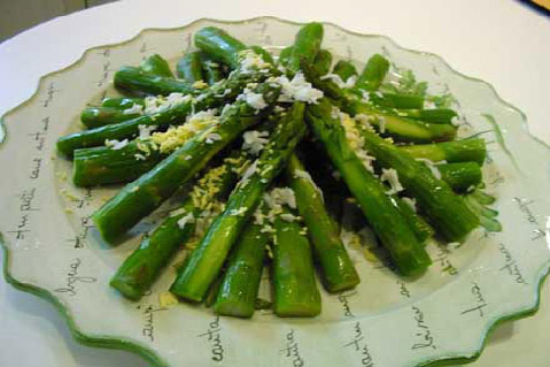
Serves: 6
Preparation time: 15 minutes
Cooking time:10 minutes
3 pounds fresh green asparagus 2 hard-cooked eggs, peeled
2 tablespoons chopped parsley
1 cup herb-vinaigrette dressing
Peel and trim the asparagus.
Boil 4 quarts of water in a pot. Cook asparagus in boiling water for 5 to 7 minutes or until just tender.
Gently remove asparagus from boiling water and cool in ice cold water. Drain on paper towels, and set aside.
Separate egg yolks and whites. Wash egg whites in cold water. Drain on paper towel and set aside. Finely chop egg yolks; set aside in a small bowl. Chop egg whites and save in a bowl.
Arrange asparagus on a serving platter. Sprinkle egg yolk and egg white and parsley over asparagus.
Serve cold with the herb-vinaigrette.
Boil 4 quarts of water in a pot. Cook asparagus in boiling water for 5 to 7 minutes or until just tender.
Gently remove asparagus from boiling water and cool in ice cold water. Drain on paper towels, and set aside.
Separate egg yolks and whites. Wash egg whites in cold water. Drain on paper towel and set aside. Finely chop egg yolks; set aside in a small bowl. Chop egg whites and save in a bowl.
Arrange asparagus on a serving platter. Sprinkle egg yolk and egg white and parsley over asparagus.
Serve cold with the herb-vinaigrette.
Appetizer Baked goat cheese with salad greens 
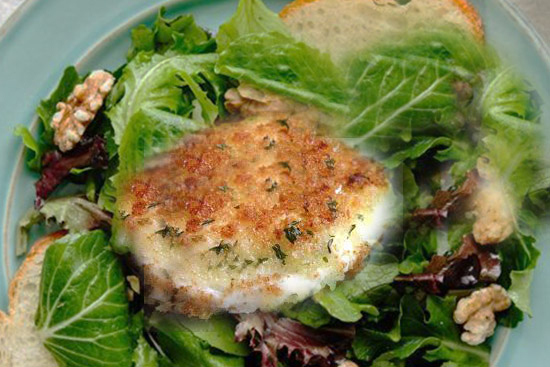
Serves: 6
Preparation time: 15 minutes
Cooking time:6 minutes
3 small rounds fresh goat cheese, each about 1/4 pound 2 tablespoons olive oil
1 1/2 cups finely dried bread crumbs
4 large handfuls mesclun or mixed salad greens
1 clove garlic, minced
12 walnut halves
Toasts
VINAIGRETTE:
5 tablespoons olive oil
1 tablespoon red wine vinegar
1 tablespoon balsamic vinegar
Salt and freshly ground pepper
Whisk together the oil, and two vinegar. Season to taste with salt and pepper and stir in the minced garlic.
Preheat oven to 400 degrees.
Cut each cheese round horizontally to make 6 rounds.
Place on a plate and drizzle with the olive oil, turning once to lightly coat both sides.
Spread the bread crumbs on a plate. Coat the rounds of goat cheese on both sides with the crumbs and then place well spaced on a baking sheet.
Bake until the cheese rounds are slightly bubbling around the edges, 4-6 minutes.
Drizzle salad greens with the dressing. Toss well and divide the greens evenly among 6 salad plates.
Place a hot cheese round in the center of each mound of greens. Garnish with walnuts and toasts. Serve immediately.
Preheat oven to 400 degrees.
Cut each cheese round horizontally to make 6 rounds.
Place on a plate and drizzle with the olive oil, turning once to lightly coat both sides.
Spread the bread crumbs on a plate. Coat the rounds of goat cheese on both sides with the crumbs and then place well spaced on a baking sheet.
Bake until the cheese rounds are slightly bubbling around the edges, 4-6 minutes.
Drizzle salad greens with the dressing. Toss well and divide the greens evenly among 6 salad plates.
Place a hot cheese round in the center of each mound of greens. Garnish with walnuts and toasts. Serve immediately.
Appetizer Beet with frizzled leek and gorgonzola crostini 
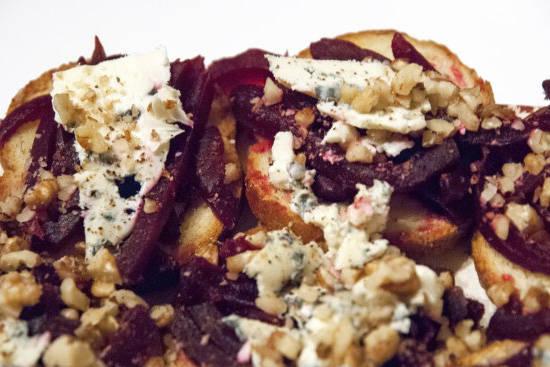
Serve as appetizers or as first course
Serves: 4
1 tablespoon extra virgin olive oil
2 teaspoons white wine vinegar
2 teaspoons chopped fresh Italian parsley
To taste salt and ground black pepper
1 leek, white part only
1 cup canola oil
4 slices Italian bread, cut diagonally
2 ounces Gorgonzola cheese
Serves: 4
Preparation time: 30 minutes
Cooking time:50 minutes
3 medium beets, (3/4 lb), trimmed and scrubbed 1 tablespoon extra virgin olive oil
2 teaspoons white wine vinegar
2 teaspoons chopped fresh Italian parsley
To taste salt and ground black pepper
1 leek, white part only
1 cup canola oil
4 slices Italian bread, cut diagonally
2 ounces Gorgonzola cheese
Wash beets. Place in a saucepan, cover with water and cook over medium heat for 30 to 40 minutesor until tender. Drain. When cool enough to handle, slide the peel off by hand, and slice into small wedges. Place in a medium bowl. Season with oil, vinegar, parsley, salt and pepper. Set aside and cover.
Cut leek crosswise about 3-inch long. Slice lengthwise into thin strips. Wash in cold water and dry. Heat the oil in a cast iron pan over moderate heat. The oil should not be too hot. Fry the leeks until golden brown. Drain on paper towel. Set aside. Can be made a day ahead, and kept in an air tight container.
Toast the bread until golden. Spread each toast with Gorgonzola. Top with 2 to 3 slices of beet mixture, and a few more on the plate. Sprinkle leeks on top, and serve at once.
Cut leek crosswise about 3-inch long. Slice lengthwise into thin strips. Wash in cold water and dry. Heat the oil in a cast iron pan over moderate heat. The oil should not be too hot. Fry the leeks until golden brown. Drain on paper towel. Set aside. Can be made a day ahead, and kept in an air tight container.
Toast the bread until golden. Spread each toast with Gorgonzola. Top with 2 to 3 slices of beet mixture, and a few more on the plate. Sprinkle leeks on top, and serve at once.
Appetizer Broccoli au gratin 
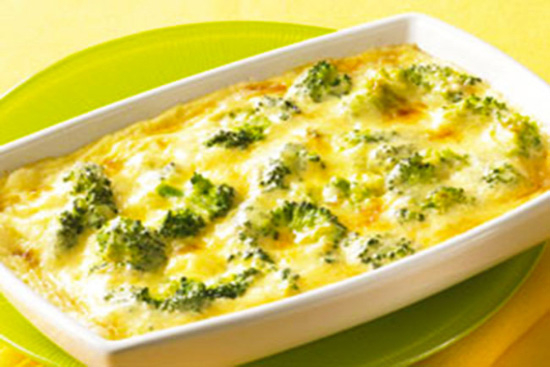
Serves: 8
Preparation time: 40 minutes
Cooking time:20 minutes
3 pounds broccoli, cleaned, cut into 2-inch florets 1/4 cup butter
1/4 cup flour
4 cups boiling milk
salt and pepper to taste
1/8 teaspoon grated nutmeg
1 cup grated Swiss cheese
1 teaspoon melted butter
In a kettle of salted boiling water, cook the broccoli flowerets for 3 to 4 minutes, or until tender.
Drain broccoli, and plunge into ice cold water to stop the cooking.
Drain broccoli. Pat dry, and transfer to a buttered 2-quart baking dish.
Preheat oven to 350 degrees.
In a saucepan, cook the onion in 3 tablespoons of butter over moderate low heat, stirring until it is softened.
Stir in the flour and cook the roux over low heat, stirring, for 3 minutes.
Add milk and whisk over moderate heat until the sauce thickens. Simmer the sauce for 10 minutes. Season with salt, pepper and grated nutmeg.
Pour the sauce over broccoli. Sprinkle the cheese over the sauce. Pour butter over cheese.
Bake for 15 to 20 minutes until golden brown.
Broccoli with cheddar sauce:
A variation of this recipe uses the cream sauce with the addition of 2 cups grated cheddar cheese, and dry breadcrumbs sprinkled over the top of broccoli.
Drain broccoli, and plunge into ice cold water to stop the cooking.
Drain broccoli. Pat dry, and transfer to a buttered 2-quart baking dish.
Preheat oven to 350 degrees.
In a saucepan, cook the onion in 3 tablespoons of butter over moderate low heat, stirring until it is softened.
Stir in the flour and cook the roux over low heat, stirring, for 3 minutes.
Add milk and whisk over moderate heat until the sauce thickens. Simmer the sauce for 10 minutes. Season with salt, pepper and grated nutmeg.
Pour the sauce over broccoli. Sprinkle the cheese over the sauce. Pour butter over cheese.
Bake for 15 to 20 minutes until golden brown.
Broccoli with cheddar sauce:
A variation of this recipe uses the cream sauce with the addition of 2 cups grated cheddar cheese, and dry breadcrumbs sprinkled over the top of broccoli.
Appetizer Broccoli rabe with parmesan cheese 
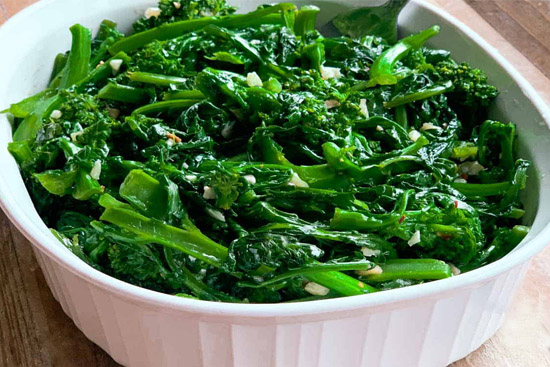
Serves: 6
Preparation time: 20 minutes
Cooking time:10 minutes
2 pounds broccoli rabe1/4 cup extra-virgin olive oil
5 garlic cloves, peeled and coarsely chopped
5 tablespoons freshly grated Parmesan cheese or Asiago cheese
Wash and drain broccoli, discarding tough stems. Cook broccoli rabe in large pot of boiling salted water until crisp-tender, about 4 minutes.
Drain and immerse in a bowl of ice water to cool. Drain again;
Heat olive oil in heavy large skillet over medium heat. Add garlic and sauté about 2 minute. Add broccoli rabe and sauté until heated through. Remove from heat. Sprinkle 4 tablespoons cheese over and toss to combine.
Season with salt and pepper to taste. Transfer to warm platter. Sprinkle remaining 2 tablespoons cheese over.
Drain and immerse in a bowl of ice water to cool. Drain again;
Heat olive oil in heavy large skillet over medium heat. Add garlic and sauté about 2 minute. Add broccoli rabe and sauté until heated through. Remove from heat. Sprinkle 4 tablespoons cheese over and toss to combine.
Season with salt and pepper to taste. Transfer to warm platter. Sprinkle remaining 2 tablespoons cheese over.
Appetizer Broccoli salad 
Serves: 6
Preparation time: 20 minutes
Cooking time:15 minutes
5 cups broccoli florets ( from 1 large head) 1/2 pound bacon, cooked crisp and crumbled
1/2 cup raisins
1 cup unsalted sunflower seeds, toasted
Dressing:
2/3 cup olive oil
2 tablespoons red wine vinegar
1 cup chopped red onion
salt and pepper to taste
Cook broccoli in medium pot of boiling salted water until crisp-tender, about 4 minutes. Drain. Immerse in ice cold water. Drain well.
Dressing:
Whisk oil and vinegar in medium bowl to blend. Mix in chopped red onion. Season to taste with salt and pepper. Combine broccoli, bacon and raisins in large bowl. Toss with dressing to coat.
Garnish with sunflower seeds. Refrigerate until ready to serve.
Dressing:
Whisk oil and vinegar in medium bowl to blend. Mix in chopped red onion. Season to taste with salt and pepper. Combine broccoli, bacon and raisins in large bowl. Toss with dressing to coat.
Garnish with sunflower seeds. Refrigerate until ready to serve.
Appetizer Bruschetta dip 

Quick preparation – You can have this on the table in less than 10 minutes.
Versatility – It’s a dip, a topping, or a salad depending on your needs.
Serves: 5
1 clove garlic, minced
2 tablespoons extra virgin olive oil
1 tablespoon balsamic vinegar
1 teaspoon dried Italian seasoning
Salt and black pepper, to taste
2 tablespoons chopped fresh basil
Optional: shredded parmesan cheese
To serve: toasted baguette slices, crackers, or fresh veggie sticks
Serves: 5
Preparation time:10 minutes
4–5 Roma tomatoes, diced (about 2 cups)1 clove garlic, minced
2 tablespoons extra virgin olive oil
1 tablespoon balsamic vinegar
1 teaspoon dried Italian seasoning
Salt and black pepper, to taste
2 tablespoons chopped fresh basil
Optional: shredded parmesan cheese
To serve: toasted baguette slices, crackers, or fresh veggie sticks
Prepare the Tomatoes: Dice the Roma tomatoes and add them to a medium-sized mixing bowl.
Add Garlic and Seasoning: Stir in the minced garlic, Italian seasoning, a pinch of salt, and freshly cracked black pepper.
Mix in Oil and Vinegar: Drizzle in the olive oil and balsamic vinegar. Stir gently to combine all the flavors.
Add Basil Last: Fold in the freshly chopped basil just before serving to keep it bright and aromatic.
Taste and Adjust: Taste your dip and adjust seasoning if needed. You can add a little more vinegar or salt based on your preference.
Serve with Toasted Bread or Crackers: Spoon into a serving bowl and enjoy with warm baguette slices or crunchy crackers.
Add Garlic and Seasoning: Stir in the minced garlic, Italian seasoning, a pinch of salt, and freshly cracked black pepper.
Mix in Oil and Vinegar: Drizzle in the olive oil and balsamic vinegar. Stir gently to combine all the flavors.
Add Basil Last: Fold in the freshly chopped basil just before serving to keep it bright and aromatic.
Taste and Adjust: Taste your dip and adjust seasoning if needed. You can add a little more vinegar or salt based on your preference.
Serve with Toasted Bread or Crackers: Spoon into a serving bowl and enjoy with warm baguette slices or crunchy crackers.
Appetizer Bruschetta orzo salad 

Serves: 2
Preparation time: 15 minutes
Cooking time:None
3/4 cup orzo, freshly cooked, rinsed and drained 2 medium Italian tomatoes, cored, seeded and chopped
2 tablespoons chopped black olives
1/2 cup red onion finely diced
1/3 cup fresh basil leaves, chopped
2 1/2 tablespoons balsamic vinegar
2 large garlic cloves, finely chopped
1 1/2 tablespoons olive oil
Combine all ingredients in bowl. Cover and chill at least 1 hour. Serve with toasted garlic bread
Appetizer Caprese salad 
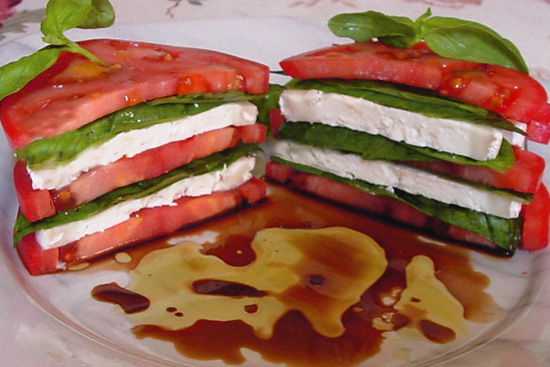
Insalata Caprese, also known as Caprese Salad is a traditional Italian appetizer. Fresh summer tomatoes, fresh basil, and soft mozzarella cheese (not the rubbery and dry version) make this salad a summer favorite. The salad has its origins from the island of Capri in Italy, south of the coast of Naples.
The creamy mozzarella in this salad is arguably the perfect counterbalance to the humble tomato, thanks to its rich yet subtle taste and mellow dairy notes.
Serves: 4
1 pound fresh mozzarella cheese sliced into 1/4 inch slices
15-20 basil leaves sliced into ribbons
3 tablespoons extra virgin olive oil
kosher/sea salt and pepper to taste
1 tablespoon balsamic reduction (optional)
The creamy mozzarella in this salad is arguably the perfect counterbalance to the humble tomato, thanks to its rich yet subtle taste and mellow dairy notes.
Serves: 4
Preparation time:15 minutes
Cooking time:None
4 large vine-ripened or heirloom tomatoes sliced into 1/4 inch slices1 pound fresh mozzarella cheese sliced into 1/4 inch slices
15-20 basil leaves sliced into ribbons
3 tablespoons extra virgin olive oil
kosher/sea salt and pepper to taste
1 tablespoon balsamic reduction (optional)
More presentations
Sprinkle sliced tomatoes with salt.
Arrange tomatoes and mozzarella on platter in alternating and overlapping pattern, or stacked as shown on the image above.
Either tuck whole leaves of basil in between layers of tomatoes or sprinkle salad with the ribbons of basil.
Drizzle the salad evenly with extra virgin olive oil.
Sprinkle with freshly cracked black pepper.
Drizzle with balsamic glaze if using.
Serve immediately or within one hour of preparation.
There is really no “dressing” for Caprese Salad. Instead a generous drizzle of extra virgin olive oil and salt is all that is needed.
A drizzle of balsamic reduction enhances the taste of this simple salad, but that is optional.
Notes
Beefsteak, vine-ripened, or heirloom tomatoes are all great for this Tomato and Mozzarella Salad.
Balsamic Reduction
You can easily purchase a balsamic reduction or glaze or you can make it at home.
Place 1/2 cup balsamic vinegar into heavy bottomed saucepan.
Bring to a boil, then reduce heat to a low simmer.
Allow to reduce, stirring occasionally, until the balsamic is reduced by half and coats the back of a spoon. This takes about 10 minutes.
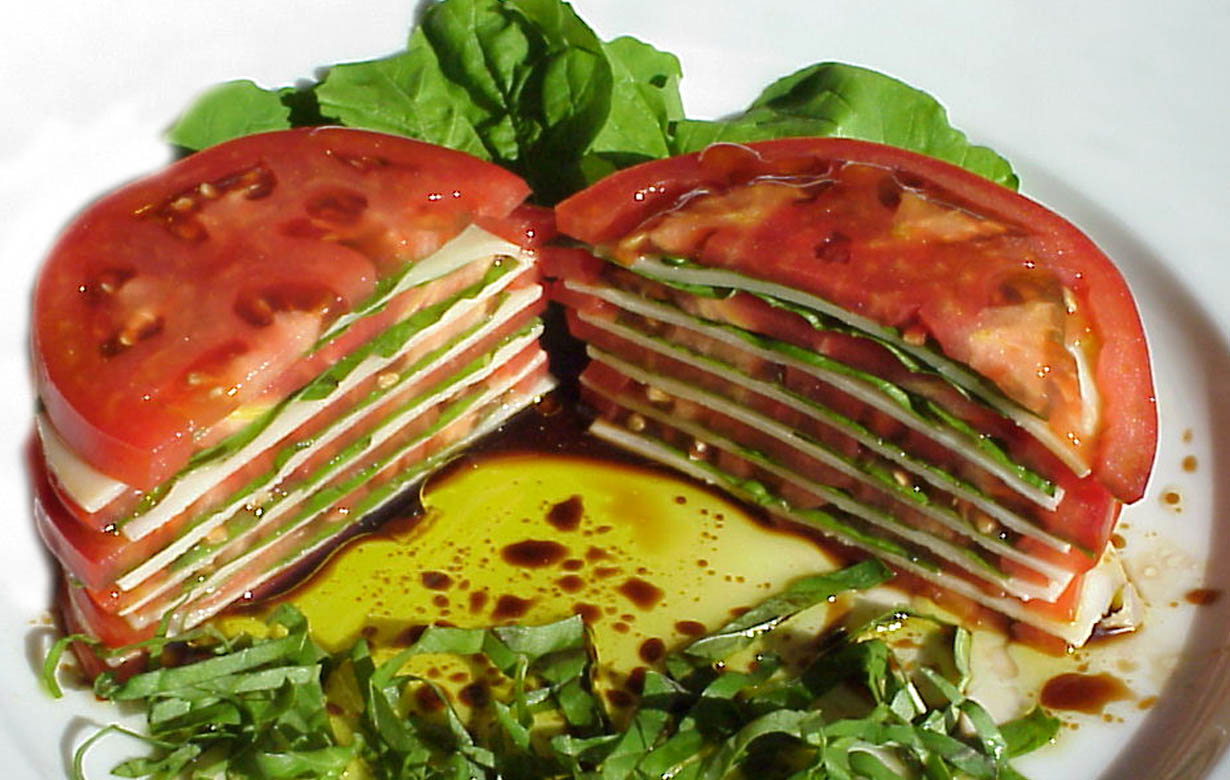
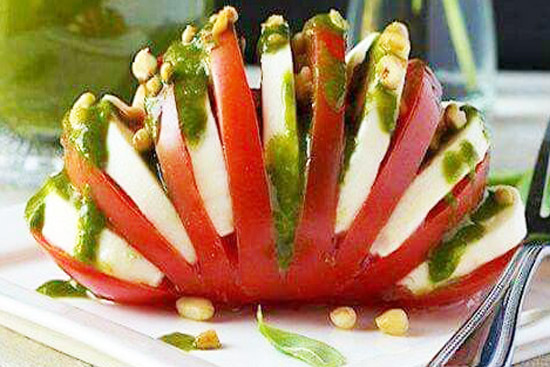
Sprinkle sliced tomatoes with salt.
Arrange tomatoes and mozzarella on platter in alternating and overlapping pattern, or stacked as shown on the image above.
Either tuck whole leaves of basil in between layers of tomatoes or sprinkle salad with the ribbons of basil.
Drizzle the salad evenly with extra virgin olive oil.
Sprinkle with freshly cracked black pepper.
Drizzle with balsamic glaze if using.
Serve immediately or within one hour of preparation.
There is really no “dressing” for Caprese Salad. Instead a generous drizzle of extra virgin olive oil and salt is all that is needed.
A drizzle of balsamic reduction enhances the taste of this simple salad, but that is optional.
Notes
Beefsteak, vine-ripened, or heirloom tomatoes are all great for this Tomato and Mozzarella Salad.
Balsamic Reduction
You can easily purchase a balsamic reduction or glaze or you can make it at home.
Place 1/2 cup balsamic vinegar into heavy bottomed saucepan.
Bring to a boil, then reduce heat to a low simmer.
Allow to reduce, stirring occasionally, until the balsamic is reduced by half and coats the back of a spoon. This takes about 10 minutes.
Appetizer Carrot gnocchi 
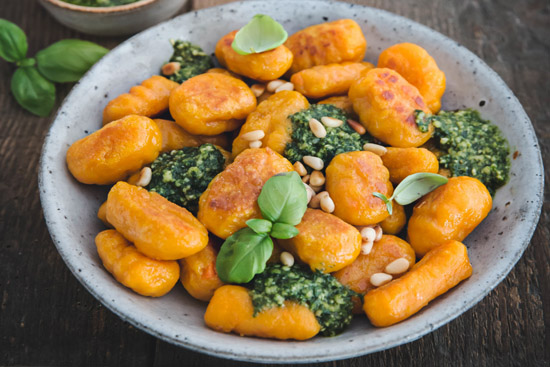
Serves: 2
Preparation time: 40 minutes
Cooking time:30 minutes
1/2 pound carrots 1 teaspoon finely chopped onion
3 teaspoons butter
1 cup Parmigiano-reggiano cheese
3 teaspoons flour
1 large egg yolk
salt, pepper, and nutmeg to taste
3 teaspoons chopped fresh chives
Preheat oven to 400 degrees.
Peel and slice carrots. Boil until tender. Drain.
In a medium skillet, cook the onion in 1 tablespoon butter, over moderate heat, stirring until pale gold.
Add carrots, and cook for 5 minutes while stirring occasionally.
Transfer the carrots to a food processor, and puree until smooth. Transfer the puree to a bowl. Add 3 tablespoons of the cheese, the flour and egg yolk, and season with salt, pepper, and nutmeg; mix well.
Bring a wide shallow saucepan of water to a boil and add 1 tablespoon salt. Prepare a bowl of ice cold water. Shape the carrot mixture into ovals, using two soup spoons, scooping a portion between the spoons.
Slide 4 of the gnocchi at the time into the boiling water and cook just until they rise to the surface, about a minute or less.
When the gnocchi are done, transfer to the cold water.
Lightly butter a baking dish large enough to hold the gnocchi in a layer without crowding.
Drain the gnocchi and arrange them in the prepared baking baking dish.
Sprinkle with remaining cheese and butter. Bake for 10 minutes. Sprinkle with chives and serve at once.
Peel and slice carrots. Boil until tender. Drain.
In a medium skillet, cook the onion in 1 tablespoon butter, over moderate heat, stirring until pale gold.
Add carrots, and cook for 5 minutes while stirring occasionally.
Transfer the carrots to a food processor, and puree until smooth. Transfer the puree to a bowl. Add 3 tablespoons of the cheese, the flour and egg yolk, and season with salt, pepper, and nutmeg; mix well.
Bring a wide shallow saucepan of water to a boil and add 1 tablespoon salt. Prepare a bowl of ice cold water. Shape the carrot mixture into ovals, using two soup spoons, scooping a portion between the spoons.
Slide 4 of the gnocchi at the time into the boiling water and cook just until they rise to the surface, about a minute or less.
When the gnocchi are done, transfer to the cold water.
Lightly butter a baking dish large enough to hold the gnocchi in a layer without crowding.
Drain the gnocchi and arrange them in the prepared baking baking dish.
Sprinkle with remaining cheese and butter. Bake for 10 minutes. Sprinkle with chives and serve at once.
Appetizer Cauliflower risotto 

The Cauliflower Risotto goes well with pork tenderloin, baked chicken breast, baked chicken legs, or baked pork chops. It also pairs well with baked cod, grilled shrimp, or roasted beef.
Serves: 4
1 Tbsp olive oil (15 mL)
1 shallot finely chopped
1 clove garlic minced
1 cup vegetable broth (240 mL)
1/2 cup grated Parmesan cheese (80 g)
1/4 cup heavy cream 60 mL
Salt and pepper to taste
Serves: 4
Preparation time:10 minutes
Cooking time:15 minutes
1 medium head cauliflower1 Tbsp olive oil (15 mL)
1 shallot finely chopped
1 clove garlic minced
1 cup vegetable broth (240 mL)
1/2 cup grated Parmesan cheese (80 g)
1/4 cup heavy cream 60 mL
Salt and pepper to taste
Remove any leaves around the cauliflower. Chop the cauliflower using large pices that fit in a food processor or by grating with a box grater.
Heat oil in a large sauté pan over medium heat, then add shallot and garlic. Cook until shallot is softened, then stir in riced cauliflower and vegetable broth. Cover and cook for 10 minutes, or until cauliflower is tender.
Puree 1/4 of the cauliflower mixture in a blender or food processor until smooth and creamy. Drain excess water from the remaining ¾ of the cauliflower.
Stir pureed cauliflower back into the cauliflower rice, along with the parmesan and heavy cream. Taste and add salt and pepper, as needed.
Heat oil in a large sauté pan over medium heat, then add shallot and garlic. Cook until shallot is softened, then stir in riced cauliflower and vegetable broth. Cover and cook for 10 minutes, or until cauliflower is tender.
Puree 1/4 of the cauliflower mixture in a blender or food processor until smooth and creamy. Drain excess water from the remaining ¾ of the cauliflower.
Stir pureed cauliflower back into the cauliflower rice, along with the parmesan and heavy cream. Taste and add salt and pepper, as needed.
Appetizer Celery root and mashed potatoes 
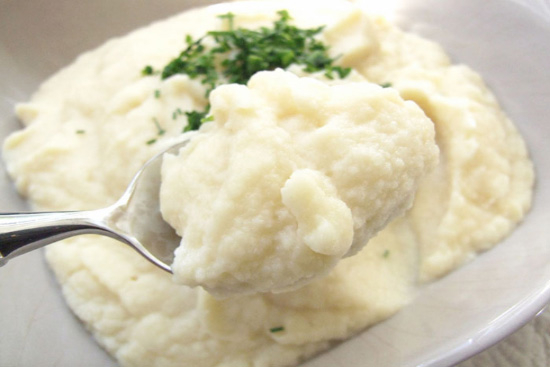
Serves: 4
Preparation time: 30 minutes
Cooking time:30 minutes
2 tablespoons lemon juice 1 celery root (about 1 pound)
4 medium potatoes, peeled
4 cloves garlic, peeled
1/2 cup whipping cream
2 tablespoons butter
salt and pepper to taste
1/4 cup chopped fresh parsley
Fill a large bowl with ice water and add lemon juice. With sharp knife, peel celery root; cut into 2-in chunks, dropping them into the water and lemon juice as you go. (This stops the celery root from discoloring.)
Cut potatoes into 2-in chunks. Drain celery root. In large saucepan, combine celery root, potatoes, garlic and enough water to cover them. Bring to boil. Reduce heat to medium-low; cook, covered, 20 minutes or until celery root and potatoes are very tender. Drain well; return vegetables to saucepan. Place over low heat to dry out slightly, shaking saucepan occasionally.
Heat butter and cream in small saucepan; transfer to large bowl. Add vegetables to cream mixture and cream until smooth and creamy. Season with salt and pepper to taste; stir in parsley.
Transfer to heated serving dish; serve immediately.
Cut potatoes into 2-in chunks. Drain celery root. In large saucepan, combine celery root, potatoes, garlic and enough water to cover them. Bring to boil. Reduce heat to medium-low; cook, covered, 20 minutes or until celery root and potatoes are very tender. Drain well; return vegetables to saucepan. Place over low heat to dry out slightly, shaking saucepan occasionally.
Heat butter and cream in small saucepan; transfer to large bowl. Add vegetables to cream mixture and cream until smooth and creamy. Season with salt and pepper to taste; stir in parsley.
Transfer to heated serving dish; serve immediately.
Appetizer Cheese tart with artichoke hearts 
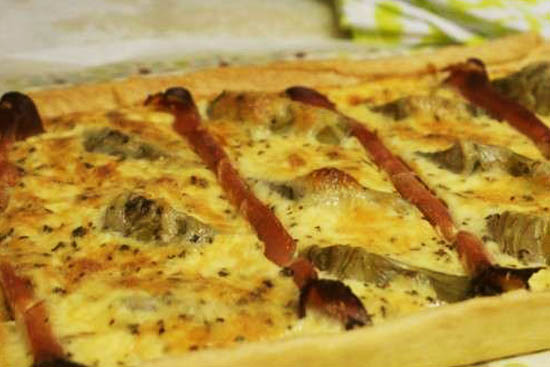
Serves: 6
Preparation time:15 minutes
Cooking time:30 minutes
1 puff pastry sheet, store-bought1 egg, whisked
A handful of finely chopped parsley
1 cup mozzarella cheese
1/2 cup ricotta cheese
A heaping tablespoon crème fraiche or sour cream, or cream cheese
A dozen artichoke hearts, jarred ones
1 to 2 tablespoons capers
1 Serrano pepper, thinly sliced
Lemon zest
Basil or cilantro
Salt and pepper
Shaved Parmesan
1. Preheat the oven at 400°F or 205°C.
2. Roll the pastry sheet to 0.5 cm or 1/4 inches. Trim the pastry into a 12 x 9 inch rectangle (or 30 x 23 cm). Sketch a border around the pastry using your knife. You can layer the excess dough over the borders and create a rim for the dough.
3. Brush the edges of the pastry with egg. Combine the mozzarella, ricotta, parsley, crème fraiche, remaining egg (from brushing the pastry), salt and pepper in a bowl.
4. Spread the cheese filling all over the pastry. Arrange the artichoke hearts, Serrano peppers, and capers on top, and bake for 25-30 minutes. You can broil the tart for 2 mins at the end.
5. Finish off the tart with shaved Parmesan, cilantro, and lemon zest on top.
2. Roll the pastry sheet to 0.5 cm or 1/4 inches. Trim the pastry into a 12 x 9 inch rectangle (or 30 x 23 cm). Sketch a border around the pastry using your knife. You can layer the excess dough over the borders and create a rim for the dough.
3. Brush the edges of the pastry with egg. Combine the mozzarella, ricotta, parsley, crème fraiche, remaining egg (from brushing the pastry), salt and pepper in a bowl.
4. Spread the cheese filling all over the pastry. Arrange the artichoke hearts, Serrano peppers, and capers on top, and bake for 25-30 minutes. You can broil the tart for 2 mins at the end.
5. Finish off the tart with shaved Parmesan, cilantro, and lemon zest on top.
Appetizer Cold broccoli soup 
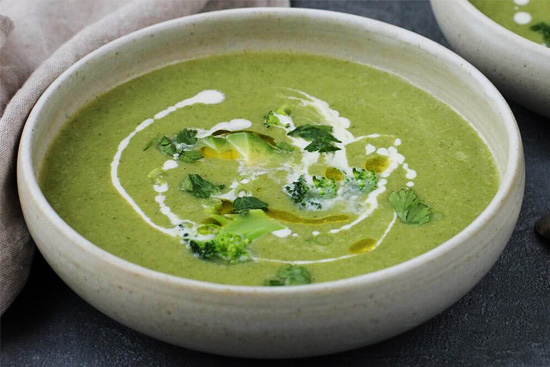
Serves: 6
Preparation time: 20 minutes
Cooking time:20 minutes
4 medium potatoes 4 medium chopped onions
1 1/2 quarts chicken stock
2 cups chopped broccoli
1/2 cup heavy cream
1 teaspoon lemon juice
1 teaspoon salt
1/4 teaspoon ground white pepper
In a soup pot, combine potatoes and onions with the stock. Simmer until the vegetables are tender.
Add the broccoli and continue cooking for 10 minutes. Puree soup in a blender.
Refrigerate for several hours until thoroughly chilled.
At serving time stir in the cream, lemon juice, salt and pepper. Garnish soup with lemon slices
Add the broccoli and continue cooking for 10 minutes. Puree soup in a blender.
Refrigerate for several hours until thoroughly chilled.
At serving time stir in the cream, lemon juice, salt and pepper. Garnish soup with lemon slices
Appetizer Creamed spinach 
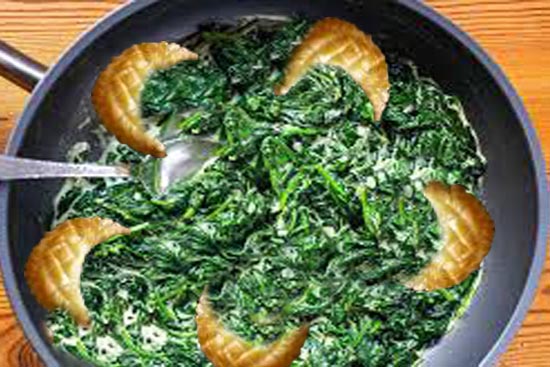
Serves: 6
Preparation time: 15 minutes
Cooking time:12 minutes
2 pounds cooked spinach, chopped to taste salt, pepper, grated nutmeg
5 ounces butter
1 cup heavy cream
12 puff pastry fleurons (crescent-shaped puff pastry)
In a saucepan, heat the spinach with butter. Season to taste with salt, pepper, and nutmeg.
Meanwhile, boil the cream until it is reduced to half. Arrange spinach in a dome on serving platter.
Pour cream over. Surround with fleurons. Serve hot.
Meanwhile, boil the cream until it is reduced to half. Arrange spinach in a dome on serving platter.
Pour cream over. Surround with fleurons. Serve hot.
Appetizer Creamed spinach with mushrooms 
Serves: 6
Preparation time: 20 minutes
Cooking time:20 minutes
3 bunches spinach, each about 3/4 pound Kosher salt and freshly ground black pepper to taste
2 tablespoons butter
2 ounces shitake mushrooms, stemmed and chopped
2 tablespoons minced shallots
3 tablespoons all-purpose flour
1 1/2 cups milk, warmed
Pinch cayenne pepper
Wash spinach thoroughly and remove any thick or blemished leaves. Put with boiling water into a large pot or wok.
Over medium heat, cook, stirring, until just wilted, about 5 minutes. Drain and gently squeeze out excess moisture. Chop, season with salt and pepper, and set aside. You should have about 3 cups.
Put butter in a large, heavy-bottomed saucepan over medium heat. When foaming stops add mushrooms and shallots. Cook, covered, until both wilt, about 3 to 4 minutes. Add flour and stir a few minutes, making sure flour is fully incorporated.
Add milk and bring to a simmer, stirring with a whisk.
Season with salt, pepper, and cayenne pepper and cook until thickened, about 5 minutes. Add spinach and cook, stirring gently until heated through.
Over medium heat, cook, stirring, until just wilted, about 5 minutes. Drain and gently squeeze out excess moisture. Chop, season with salt and pepper, and set aside. You should have about 3 cups.
Put butter in a large, heavy-bottomed saucepan over medium heat. When foaming stops add mushrooms and shallots. Cook, covered, until both wilt, about 3 to 4 minutes. Add flour and stir a few minutes, making sure flour is fully incorporated.
Add milk and bring to a simmer, stirring with a whisk.
Season with salt, pepper, and cayenne pepper and cook until thickened, about 5 minutes. Add spinach and cook, stirring gently until heated through.
Appetizer Creamy polenta with gorgonzola 
Instead of cooking the polenta in the the usual water or broth this rich polenta is cooked in a milk and cream mixture.
Serves: 6
1/2 cup whipping cream
1 cup polenta *
1 1/2 cups crumbled Gorgonzola cheese
1/2 cup coarsely chopped, lightly toasted walnuts
Serves: 6
Preparation time: 15 minutes
Cooking time:30 minutes
4 cups milk 1/2 cup whipping cream
1 cup polenta *
1 1/2 cups crumbled Gorgonzola cheese
1/2 cup coarsely chopped, lightly toasted walnuts
Bring milk and whipping cream to boil in heavy large saucepan over medium heat.
Reduce heat to medium-low and gradually whisk polenta into milk mixture in slow steady stream.
Cook polenta until creamy and tender, stirring frequently, about 20 minutes. Season to taste with salt and pepper.
Preheat broiler.
Transfer cooked polenta to 9-inch-diameter pie dish. Sprinkle Gorgonzola cheese over polenta.
Broil until cheese melts. Sprinkle with chopped toasted walnuts and serve immediately.
* If polenta is not available, substitute 1 cup regular yellow cornmeal, and cook mixture for about 10 minutes rather than 20 minutes.
Reduce heat to medium-low and gradually whisk polenta into milk mixture in slow steady stream.
Cook polenta until creamy and tender, stirring frequently, about 20 minutes. Season to taste with salt and pepper.
Preheat broiler.
Transfer cooked polenta to 9-inch-diameter pie dish. Sprinkle Gorgonzola cheese over polenta.
Broil until cheese melts. Sprinkle with chopped toasted walnuts and serve immediately.
* If polenta is not available, substitute 1 cup regular yellow cornmeal, and cook mixture for about 10 minutes rather than 20 minutes.
Appetizer Crispy fried tomato slices 
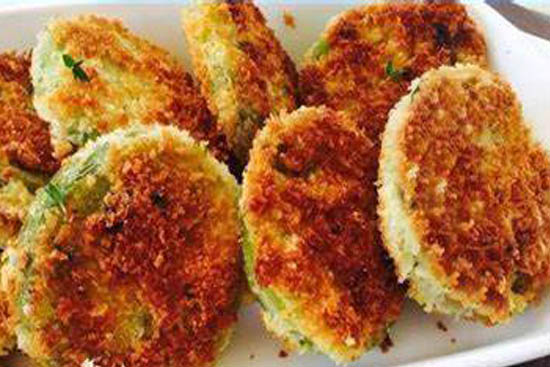
Use Green tomatoes if available as they give excellent results.
Serves: 6
• 1/4 teaspoon garlic powder
• 1/2 cup buttermilk
• 2 large eggs
• 1 cups cornmeal
• 1/2 cup all purpose flour
• 1 cup Parmesan cheese grated
• 1/2 teaspoon salt
• 1/4 teaspoon pepper
• 1 cup vegetable oil
• ¼ cup minced fresh basil optional garnish
• Lemon wedges optional garnish
Drain Tomatoes
1. Slice the tomatoes about ½ inch thick
2. Line wire rack and cover it with a triple layer of paper towels.
3. Space tomato slices out on your rack. Sprinkle all of the tomato slices with garlic powder.
4. Allow tomatoes to drain for around 30 minutes in total, flipping each tomato after 15 minutes.
Bread Tomatoes
1. Cover a rimmed baking sheet with parchment paper. Set aside.
2. In a medium sized bowl whisk buttermilk and egg.
3. Using a plate, combine cornmeal, flour, Parmesan cheese, salt, and pepper.
4. Dip each tomato slice in buttermilk mixture.
5. Dredge in cornmeal mixture, pressing down so the cornmeal sticks to all sides of the tomato slices. Repeat the same process.
6. Place the double dipped tomato on the baking sheet with parchment paper. Repeat until all tomatoes are dipped.
Fry Tomatoes
1. Heat oil in your large skillet over medium high heat.
2. Add coated tomato slices to skillet in batches and fry until golden brown, 2 to 4 minutes per side.
3. Flip tomatoes and fry another 2 minutes. Remove and drain on a paper towel.
4. Transfer fried tomatoes to a platter. Garnish with lemon wedges and fresh basil.
Serves: 6
Preparation time:30 minutes
Cooking time:10 minutes
• 5 plum or green tomatoes ends trimmed, sliced crosswise, ½ inch thick• 1/4 teaspoon garlic powder
• 1/2 cup buttermilk
• 2 large eggs
• 1 cups cornmeal
• 1/2 cup all purpose flour
• 1 cup Parmesan cheese grated
• 1/2 teaspoon salt
• 1/4 teaspoon pepper
• 1 cup vegetable oil
• ¼ cup minced fresh basil optional garnish
• Lemon wedges optional garnish
Drain Tomatoes
1. Slice the tomatoes about ½ inch thick
2. Line wire rack and cover it with a triple layer of paper towels.
3. Space tomato slices out on your rack. Sprinkle all of the tomato slices with garlic powder.
4. Allow tomatoes to drain for around 30 minutes in total, flipping each tomato after 15 minutes.
Bread Tomatoes
1. Cover a rimmed baking sheet with parchment paper. Set aside.
2. In a medium sized bowl whisk buttermilk and egg.
3. Using a plate, combine cornmeal, flour, Parmesan cheese, salt, and pepper.
4. Dip each tomato slice in buttermilk mixture.
5. Dredge in cornmeal mixture, pressing down so the cornmeal sticks to all sides of the tomato slices. Repeat the same process.
6. Place the double dipped tomato on the baking sheet with parchment paper. Repeat until all tomatoes are dipped.
Fry Tomatoes
1. Heat oil in your large skillet over medium high heat.
2. Add coated tomato slices to skillet in batches and fry until golden brown, 2 to 4 minutes per side.
3. Flip tomatoes and fry another 2 minutes. Remove and drain on a paper towel.
4. Transfer fried tomatoes to a platter. Garnish with lemon wedges and fresh basil.
Appetizer Dried tomato and fennel stuffing 
Serves: 12
Preparation time: 20 minutes
Cooking time:45 minutes
10 cups diced country style bread 11/2 pounds fennel bulbs
1/2 cup unsalted butter
1/2 cup drained oil-packed dried tomatoes, cut into 1/4-inch dice
3 cups chicken broth
2 tablespoons balsamic vinegar
1 teaspoon dried basil
1/2 teaspoon dried oregano
Salt and pepper to taste
Preheat oven at 325 degrees.
Toast bread cubes on a baking pan until just dry. Trim fennel bulbs, discarding stalks.
Dice stalks into 1/4-inch dice. In a large skillet, melt butter; cook fennel over moderate heat for about 15 minutes. Simmer tomatoes in chicken broth for 10 minutes.
In a large bowl, toss together all the ingredients. Cool. May be made a day ahead.
Toast bread cubes on a baking pan until just dry. Trim fennel bulbs, discarding stalks.
Dice stalks into 1/4-inch dice. In a large skillet, melt butter; cook fennel over moderate heat for about 15 minutes. Simmer tomatoes in chicken broth for 10 minutes.
In a large bowl, toss together all the ingredients. Cool. May be made a day ahead.
Appetizer Eggplant and tomato with chevre 
Serves: 6
Preparation time: 25 minutes
Cooking time:40 minutes
1 small eggplant (3/4 lb) 2 teaspoons coarse salt
1/4 cup olive oil
1 large red onion, thinly sliced
2 cloves garlic, minced
1/4 teaspoon hot pepper flakes
salt and pepper
3 tomatoes, thickly sliced
1 tablespoon fresh snipped chives or green onion tops
2 ounces creamy chevre
1/4 cup whipping cream
Trim eggplant; peel if desired. Cut crosswise into 1/4-in slices. Sprinkle slices with coarse salt; place in colander to drain for 30 minutes.
Rinse eggplant well under cool running eater; pat dry and set aside.
In skillet, heat 1 tablespoon of the oil over medium high heat; cook onion, garlic and hot pepper flakes, stirring often, 3 to 5 minutes or until onion is softened. Spoon half of onion mixture into greased 13-by-9-in baking dish. Sprinkle with salt and pepper.
Overlap slices of eggplant and tomato over onion mixture finishing with remaining onion mixture. sprinkle with chives and drizzle 2 tablespoons oil over top.
Cover with a piece of waxed or parchment paper cut to fit the dish, and applied directly to surface; bake in 400F oven 10 minutes. Remove paper; drizzle with remaining oil.
Replace paper; bake 20 minutes longer, basting occasionally with juices that collect in baking dish, until eggplant is tender.
Remove dish from oven; let stand 1 to 2 hours for flavors to develop.
About 10 minutes before serving, heat broiler and remove paper from baking dish.
In small bowl, combine goat cheese and cream until smooth. Dot teaspoonfuls of the mixture evenly over top of eggplant dish.
Broil about 2 minutes or until cheese is melted and lightly browned. Serve at once or at room temperature.
Rinse eggplant well under cool running eater; pat dry and set aside.
In skillet, heat 1 tablespoon of the oil over medium high heat; cook onion, garlic and hot pepper flakes, stirring often, 3 to 5 minutes or until onion is softened. Spoon half of onion mixture into greased 13-by-9-in baking dish. Sprinkle with salt and pepper.
Overlap slices of eggplant and tomato over onion mixture finishing with remaining onion mixture. sprinkle with chives and drizzle 2 tablespoons oil over top.
Cover with a piece of waxed or parchment paper cut to fit the dish, and applied directly to surface; bake in 400F oven 10 minutes. Remove paper; drizzle with remaining oil.
Replace paper; bake 20 minutes longer, basting occasionally with juices that collect in baking dish, until eggplant is tender.
Remove dish from oven; let stand 1 to 2 hours for flavors to develop.
About 10 minutes before serving, heat broiler and remove paper from baking dish.
In small bowl, combine goat cheese and cream until smooth. Dot teaspoonfuls of the mixture evenly over top of eggplant dish.
Broil about 2 minutes or until cheese is melted and lightly browned. Serve at once or at room temperature.
Appetizer Eggplant caponata 
Serves: 6
Preparation time: 40 minutes
Cooking time:15 minutes
2 medium-large eggplants (about 3 pounds) 1/4 cup coarse salt
1 cup olive oil
1 large onion, sliced
6 ribs celery, cut into 1/2 inch lengths, blanched for 1 minute
1 cup Sicilian green olives, pitted and sliced
1/2 cup capers, rinsed and drained
1cup fresh plum tomatoes, peeled, seeded and chopped
3 tablespoons tomato paste diluted with a little water
1/2 cup red wine vinegar
3 tablespoons sugar
1/2 cup slivered almonds, toasted
Peel the eggplants and cut into 3/4-inch cubes. Sprinkle with coarse salt and drain in a colander, weighted, for one hour. Rinse well, and dry in a kitchen towel.
Heat 1/2 cup olive oil in a large sauté pan and fry the eggplant in batches until golden on all sides, adding more oil if necessary.
Drain on paper towels.
Sauté the onion in a 1/2 cup olive oil, stirring to coat, cover and cook until just tender but not brown. Remove cover, add the blanched celery, and cook a minute longer. Add the olives, capers, tomatoes, tomato paste, vinegar, and sugar.
Stir in the eggplant and simmer for another 10 minutes. Season with salt to taste.
Cool and refrigerate for 24 hours. Serve chilled or at room temperature, sprinkled with the toasted, slivered almonds.
Heat 1/2 cup olive oil in a large sauté pan and fry the eggplant in batches until golden on all sides, adding more oil if necessary.
Drain on paper towels.
Sauté the onion in a 1/2 cup olive oil, stirring to coat, cover and cook until just tender but not brown. Remove cover, add the blanched celery, and cook a minute longer. Add the olives, capers, tomatoes, tomato paste, vinegar, and sugar.
Stir in the eggplant and simmer for another 10 minutes. Season with salt to taste.
Cool and refrigerate for 24 hours. Serve chilled or at room temperature, sprinkled with the toasted, slivered almonds.
Appetizer Eggplant caviar 
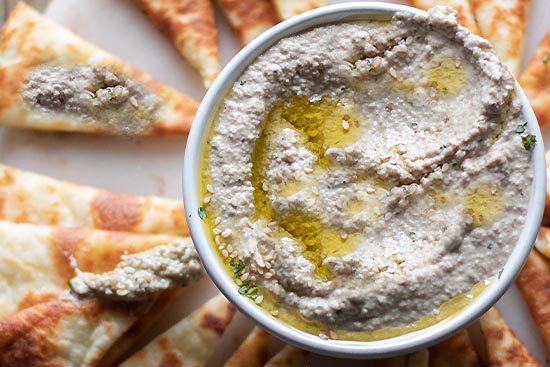
Serves: 6
Preparation time: 20 minutes
Cooking time:8 minutes
2 medium eggplants 2 teaspoons lemon juice
1 medium sliced onion
5 medium garlic cloves, sliced
1 teaspoon olive oil
to taste salt and pepper
Tabasco jalapeño
Aromat seasoning
1/2 cup chopped fresh basil
1 envelop unflavored gelatin
1/4 cup cold water
tomato coulis or roasted red pepper coulis .
Peel eggplants. Cut into halves lengthwise. Slice across and sprinkle with lemon juice.
In a microwavable dish, combine eggplants, onion, garlic and olive oil.
Microwave on high for 6 to 8 min. or until eggplants are tender. Season with salt and pepper, Tabasco jalapeño and Aromat seasoning. Mix in the basil.
Dissolve gelatin in water. Let set for 5 minutes. Melt over low heat, and stir into the warm eggplant mixture.
Spoon mixture in small ramekin dishes or molds. Refrigerate until set.
Unmold on cold plate. Serve with cold tomato coulis or red red pepper coulis
In a microwavable dish, combine eggplants, onion, garlic and olive oil.
Microwave on high for 6 to 8 min. or until eggplants are tender. Season with salt and pepper, Tabasco jalapeño and Aromat seasoning. Mix in the basil.
Dissolve gelatin in water. Let set for 5 minutes. Melt over low heat, and stir into the warm eggplant mixture.
Spoon mixture in small ramekin dishes or molds. Refrigerate until set.
Unmold on cold plate. Serve with cold tomato coulis or red red pepper coulis
Appetizer Eggplant soufflé 
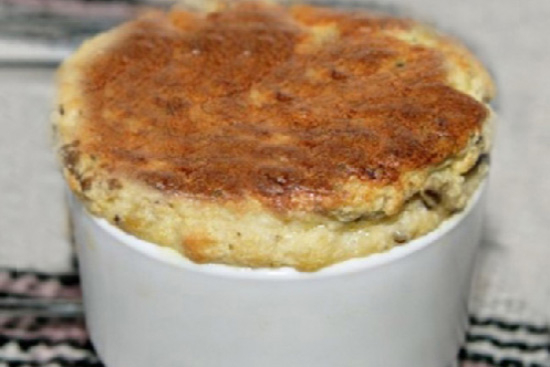
Serves: 6
Preparation time: 1 hour
Cooking time:30 minutes
1 tablespoon butter, softened 1 tablespoon flour
1 eggplant, about 1 pound
2 teaspoons olive oil
1/4 cup finely chopped onion
1 teaspoon finely minced garlic
2 teaspoons flour
1 teaspoon cornstarch
1 1/2 cups milk
salt and freshly ground pepper
6 eggs yolks
1/2 cup finely chopped parsley
6 egg whites
1/4 teaspoon cream of tartar
marinara sauce, or tomato sauce
Preheat the oven to 375 degrees Brush the interior of a 6-cup soufflé mold with the softened butter.
Cut the eggplant in half lengthwise. Place on a baking sheet. Brush eggplant with a teaspoon of olive oil.
Bake 20 to 30 minutes or until eggplant is soft to touch. Remove the eggplant from the oven. Scrape away the inner pulp and discard The skin. Chop the pulp. There should be about a cup. Cover and set aside.
In a heavy saucepan heat the remaining oil. Add the onions and garlic. Cook briefly while stirring, until onions are wilted. Stir in the flour and cornstarch. Add the milk. Cook while whisking until sauce becomes thick. Tranfer the Bubbly sauce to a large mixing bowl. Season with salt and pepper and chopped parsley. Mix egg yolks, and eggplant pulp into the thick cream sauce.
Using an electric beater, whip the egg whites and cream of tartar until stiff And glossy. Do not overbeat. Gently fold into cream sauce mixture. Pour and scrape the mixture into the prepared soufflé mold.
Place on a baking sheet. Cook in the middle of the oven for 20 to 30 minutes. Heat marinara sauce or tomato sauce. Serve with the soufflé.
Cut the eggplant in half lengthwise. Place on a baking sheet. Brush eggplant with a teaspoon of olive oil.
Bake 20 to 30 minutes or until eggplant is soft to touch. Remove the eggplant from the oven. Scrape away the inner pulp and discard The skin. Chop the pulp. There should be about a cup. Cover and set aside.
In a heavy saucepan heat the remaining oil. Add the onions and garlic. Cook briefly while stirring, until onions are wilted. Stir in the flour and cornstarch. Add the milk. Cook while whisking until sauce becomes thick. Tranfer the Bubbly sauce to a large mixing bowl. Season with salt and pepper and chopped parsley. Mix egg yolks, and eggplant pulp into the thick cream sauce.
Using an electric beater, whip the egg whites and cream of tartar until stiff And glossy. Do not overbeat. Gently fold into cream sauce mixture. Pour and scrape the mixture into the prepared soufflé mold.
Place on a baking sheet. Cook in the middle of the oven for 20 to 30 minutes. Heat marinara sauce or tomato sauce. Serve with the soufflé.
Appetizer Flatbread pizzas 
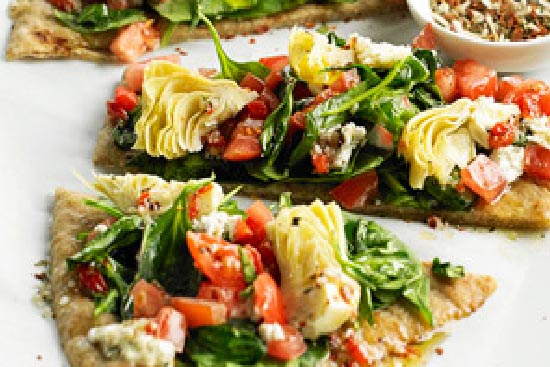
Serves: 2
Preparation time: 15 minutes
Cooking time:15 minutes
2 6-inch diameter whole wheat pita breads 1 6.5 ounce jar marinated artichoke hearts
1 1/2 cups crumbled feta cheese
1 14.5- ounce can diced tomatoes with Italian herbs, drained well
1 cup pitted Kalamata olives, coarsely chopped
2 teaspoons dried oregano
Preheat oven to 450 degrees.
Cut pita bread in half horizontally. Drain artichokes, reserve marinade, and cut any large pieces in halves. Place breads on large baking sheet.
Brush breads with some of artichoke marinade. Bake until just beginning to color. Cool on sheets. Sprinkle breads almost to edges with crumbled feta cheese.
Top with tomatoes, olives, oregano and artichokes. Drizzle with remaining artichoke marinade.
Bake pizzas until heated through, about 4 minutes. Cut into wedges.
Cut pita bread in half horizontally. Drain artichokes, reserve marinade, and cut any large pieces in halves. Place breads on large baking sheet.
Brush breads with some of artichoke marinade. Bake until just beginning to color. Cool on sheets. Sprinkle breads almost to edges with crumbled feta cheese.
Top with tomatoes, olives, oregano and artichokes. Drizzle with remaining artichoke marinade.
Bake pizzas until heated through, about 4 minutes. Cut into wedges.
Appetizer Fried green tomatoes 

Fried green tomatoes are a southern tradition made famous by the movie of the same name.
They are so popular in the south that gardeners plant extra slicing tomatoes to be harvested green for this recipe.
Serves: 5
1 cup flour
1 egg beaten with cup skim milk
1 cup yellow cornmeal
1 teaspoon each salt and black pepper
Canola oil for frying
Serves: 5
Preparation time: 20 minutes
Cooking time:20 minutes
4 green tomatoes, cut in 1/4-inch slices 1 cup flour
1 egg beaten with cup skim milk
1 cup yellow cornmeal
1 teaspoon each salt and black pepper
Canola oil for frying
Assemble ingredients. Spread flour on a sheet of waxed paper or on a plate. Put the egg wash in a shallow dish. Spread the cornmeal on a sheet of waxed paper or plate, add salt and pepper, and mix well.
Dredge the tomato slices in flour and shake off the excess. Dip each slice in the egg wash and drain off excess, and then coat with the cornmeal, shaking off excess gently.
Place on a tray and set aside. Heat the oil in a large heavy (preferably cast iron) skillet over a medium flame.
When hot, add the tomato slices. Do not overcrowd the skillet. Cook several minutes, until golden, then turn.
Drain on paper towels and serve while still hot.
Dredge the tomato slices in flour and shake off the excess. Dip each slice in the egg wash and drain off excess, and then coat with the cornmeal, shaking off excess gently.
Place on a tray and set aside. Heat the oil in a large heavy (preferably cast iron) skillet over a medium flame.
When hot, add the tomato slices. Do not overcrowd the skillet. Cook several minutes, until golden, then turn.
Drain on paper towels and serve while still hot.
Appetizer Frittata 
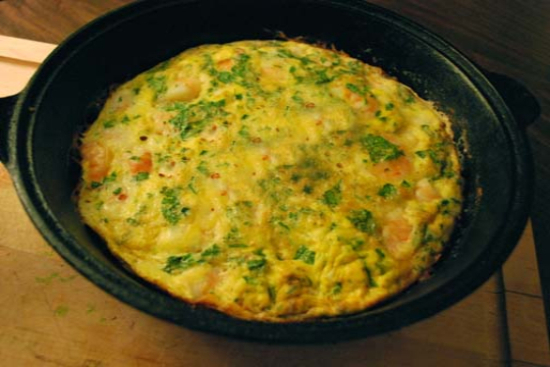
A frittata is an Italian-style flat omelet that's baked in a skillet. This frittata recipe features spinach, mushrooms and Fontina cheese. It's perfect for holiday brunches or other special occasions. Many variations are made using bacon, asparagus, peas and other ingredients.
Serves: 4
1 cup chopped leeks (white and pale green parts only)
½ lb fresh spinach, rinsed, dried and torn into roughly 1-inch pieces
1 cup sliced stemmed mushrooms
8 large eggs
1 cup diced Fontina cheese, divided
1/2 teaspoon salt
1/2 teaspoon ground black pepper
1/4 cup grated Parmesan cheese
Serves: 4
Preparation time: 15 minutes
Cooking time:20 minutes
2 tablespoons (1/4 stick) butter1 cup chopped leeks (white and pale green parts only)
½ lb fresh spinach, rinsed, dried and torn into roughly 1-inch pieces
1 cup sliced stemmed mushrooms
8 large eggs
1 cup diced Fontina cheese, divided
1/2 teaspoon salt
1/2 teaspoon ground black pepper
1/4 cup grated Parmesan cheese
Preheat broiler.
Melt butter in heavy broilerproof 10-inch-diameter nonstick skillet over medium heat. Add leeks and sauté 4 minutes. Add spinach and mushrooms, sprinkle lightly with salt, and sauté until tender, about 6 minutes.
In a medium bowl, Whisk eggs, 3/4 cup Fontina cheese, 1/2 teaspoon salt, and 1/2 teaspoon pepper. Add egg mixture to skillet; fold gently to combine. Cook until almost set. Sprinkle remaining 1/4 cup Fontina cheese and Parmesan cheese over. Broil until frittata is puffed and cheese begins to turn golden, about 3 minutes. Cut into wedges and serve.
Melt butter in heavy broilerproof 10-inch-diameter nonstick skillet over medium heat. Add leeks and sauté 4 minutes. Add spinach and mushrooms, sprinkle lightly with salt, and sauté until tender, about 6 minutes.
In a medium bowl, Whisk eggs, 3/4 cup Fontina cheese, 1/2 teaspoon salt, and 1/2 teaspoon pepper. Add egg mixture to skillet; fold gently to combine. Cook until almost set. Sprinkle remaining 1/4 cup Fontina cheese and Parmesan cheese over. Broil until frittata is puffed and cheese begins to turn golden, about 3 minutes. Cut into wedges and serve.
Appetizer Garlic roasted potatoes 
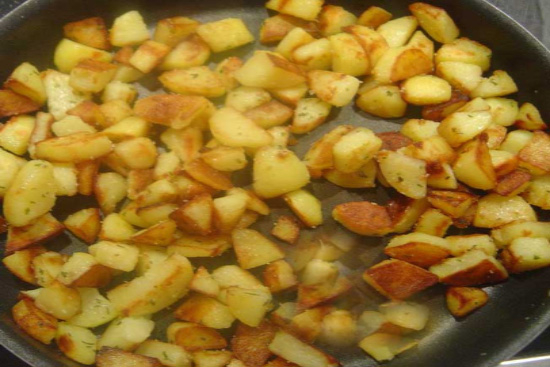
Serves: 8
Preparation time: 15 minutes
Cooking time:1 hour
3 pounds small red or white potatoes 1/4 cup olive oil
1 1/2 teaspoons salt
1 teaspoon freshly ground pepper
2 tablespoons minced garlic
2 tablespoons minced fresh flat leaf parsley
Heat oven to 400 degrees F.
Cut potatoes in half or quarters; toss with olive oil, salt, pepper, and garlic until well coated.
Spread potatoes in one layer on baking sheet, roast at least 1 hour, or until browned and crisp.
Flip twice with a spatula during cooking to ensure even browning. Remove potatoes from oven, toss with minced parsley; season to taste.
Cut potatoes in half or quarters; toss with olive oil, salt, pepper, and garlic until well coated.
Spread potatoes in one layer on baking sheet, roast at least 1 hour, or until browned and crisp.
Flip twice with a spatula during cooking to ensure even browning. Remove potatoes from oven, toss with minced parsley; season to taste.
Appetizer Goat cheese and sun-dried tomato toasts 
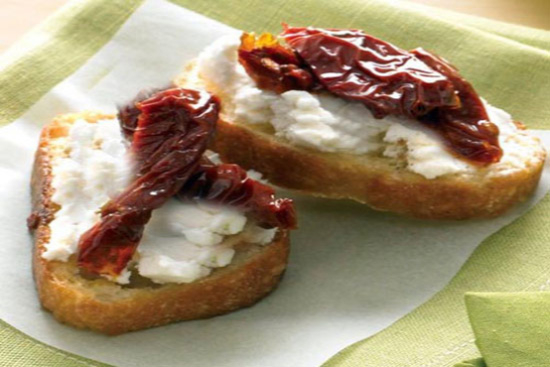
These simple, colorful little cheese toasts can be served as an appetizer or alongside a green salad.
Serves: 6
1 teaspoon cream
1 teaspoon fresh thyme, chopped
1teaspoon fresh rosemary, chopped
1/4 cup olive oil
12 long slices of baguette, cut diagonally about 1/4 inch thick
3 to 4 sun-dried tomatoes
freshly ground black pepper
Serves: 6
Preparation time: 15 minutes
Cooking time:10 minutes
5 ounces goat cheese 1 teaspoon cream
1 teaspoon fresh thyme, chopped
1teaspoon fresh rosemary, chopped
1/4 cup olive oil
12 long slices of baguette, cut diagonally about 1/4 inch thick
3 to 4 sun-dried tomatoes
freshly ground black pepper
Preheat the oven to 425 degrees. In a mixing bowl, combine the cheese and cream together.
Mix in half of the herbs and set it aside. Brush one side of the bread slices with olive oil, and toast them in the oven or under the broiler so that both sides are lightly colored.
Remove them from the oven and spread the cheese over the oiled sides. Drain the sun-dried tomatoes, and slice into narrow strips.
Lay the strips of tomato in a crisscross or diagonal pattern over the top and return the bread to the oven.
Bake until the cheese is warm and soft, about 3 minutes. Garnish with the remaining herbs and a grinding of black pepper over the top.
Mix in half of the herbs and set it aside. Brush one side of the bread slices with olive oil, and toast them in the oven or under the broiler so that both sides are lightly colored.
Remove them from the oven and spread the cheese over the oiled sides. Drain the sun-dried tomatoes, and slice into narrow strips.
Lay the strips of tomato in a crisscross or diagonal pattern over the top and return the bread to the oven.
Bake until the cheese is warm and soft, about 3 minutes. Garnish with the remaining herbs and a grinding of black pepper over the top.
Appetizer Grilled tomatoes kebabs 
Small tomatoes such as cherry, current or pear tomatoes are best eaten raw or briefly cooked. They are perfect for skewering and grilling because they do not fall apart, unless overcooked. If you are using wooden skewers, soak them for 30 minutes in cold water before using.
Serves: 6
1 tablespoon olive oil
1 tablespoon dried oregano
salt and black pepper to taste
Six wooden or metal skewers
Serves: 6
Preparation time: 20 minutes
Cooking time:4 minutes
36 small tomatoes, such as Cherry, Ping Pong, or Yellow Pear 1 tablespoon olive oil
1 tablespoon dried oregano
salt and black pepper to taste
Six wooden or metal skewers
Wash and drain tomatoes. Using a paper towel, dry each or spread on towels and allow to air dry so the oil will stick to the skins.
Place the dry tomatoes in a large bowl. Drizzle with olive oil, and season with oregano and pepper.
Toss to coat tomatoes. Thread 6 tomatoes, spaced at least an inch apart, on each of the 6 skewers.
Brush hot grill grate with oil to prevent sticking. Arrange skewers on grate.
Grill 2 to 4 minutes. Turn and grill the other side for 1 to 2 minutes. Remove skewers and sprinkle with salt, if desired.
Place the dry tomatoes in a large bowl. Drizzle with olive oil, and season with oregano and pepper.
Toss to coat tomatoes. Thread 6 tomatoes, spaced at least an inch apart, on each of the 6 skewers.
Brush hot grill grate with oil to prevent sticking. Arrange skewers on grate.
Grill 2 to 4 minutes. Turn and grill the other side for 1 to 2 minutes. Remove skewers and sprinkle with salt, if desired.
Appetizer Italian stuffing with sausage 
Serves: 10
Preparation time: 20 minutes
Cooking time:20 minutes
2 tbsp. extra-virgin olive oil 1 medium onion, chopped
2 medium celery ribs with leaves, chopped
2 medium red bell peppers, cored, seeded, and chopped
2 cloves garlic, minced
1 lb sweet or hot Italian sausage, casings removed
1 tsp. dried basil
1 tsp. dried oregano
1/2 tsp. salt
1/2 tsp. crushed hot red pepper
12 ounces day-old, crusty Italian bread, cut into 1-inch cubes (about 7 cups)
1 cup freshly grated Parmesan cheese (about 4 ounces)
8 tbsp unsalted butter(1 stick), melted
1/2 cup dry white wine
1 1/2 cups Homemade Turkey Stock or canned reduced-sodium chicken broth, or as needed
1. In a large skillet, heat the oil over medium heat. Add the onion, celery, bell peppers, and garlic. Cook, stirring often, until softened, about 5 minutes. Add the sausage and cook, breaking up the meat with a spoon, until it loses its pink color, 8 to 10 minutes. Stir in the basil, oregano, salt, and crushed red pepper. Transfer to a large bowl.
2. Add the bread and cheese and mix well. Stir in the butter, wine, and enough of the stock to moisten the dressing, about 1 cup. Use to stuff the turkey, or place in a buttered baking dish, drizzle with an additional ½ cup stock, cover, and bake as a side dish.
2. Add the bread and cheese and mix well. Stir in the butter, wine, and enough of the stock to moisten the dressing, about 1 cup. Use to stuff the turkey, or place in a buttered baking dish, drizzle with an additional ½ cup stock, cover, and bake as a side dish.
Appetizer Onion parmesan gratin 
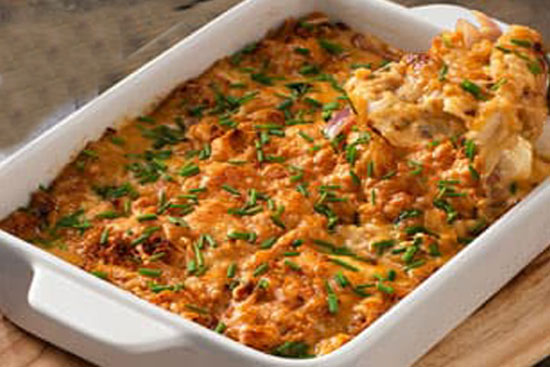
Serves: 6
Preparation time: 20 minutes
Cooking time:12 minutes
2 pounds yellow onions, peeled 4 tablespoons unsalted butter
1/2 teaspoon ground whole cloves
1/2 teaspoon fresh thyme leaves
fine sea salt to taste
2 large egg yolks
1/4 cup heavy cream
1/2 cup freshly grated Parmesan cheese
Slice the onions in half, lengthwise. Place, cut side down, on a cutting board and slice crosswise into very thin slices.
In large non-stick skillet, combine butter, cloves, onions, thyme and salt. Cover and cook over low heat until onions are very soft, about 10 minutes. Taste and adjust seasonings.
Transfer onion mixture to a gratin dish and smooth it. The recipe can be prepared several hours up to this point. Cover and store at room temperature.
Preheat the broiler. In a small bowl, combine egg yolks and cream and whisk well. Stir in the cheese.
Pour the mixture over the onions in the baking dish. Place dish under broiler about 2 inches from the heat.
Broil until the top is sizzling and golden. Serve immediately as a vegetable course or as an accompaniment to meat dishes.
In large non-stick skillet, combine butter, cloves, onions, thyme and salt. Cover and cook over low heat until onions are very soft, about 10 minutes. Taste and adjust seasonings.
Transfer onion mixture to a gratin dish and smooth it. The recipe can be prepared several hours up to this point. Cover and store at room temperature.
Preheat the broiler. In a small bowl, combine egg yolks and cream and whisk well. Stir in the cheese.
Pour the mixture over the onions in the baking dish. Place dish under broiler about 2 inches from the heat.
Broil until the top is sizzling and golden. Serve immediately as a vegetable course or as an accompaniment to meat dishes.
Appetizer Orzo salad with lemon and herb 
Serves: 4
Preparation time: 10 minutes
Cooking time:15 minutes
1 cup orzo pasta 2 tablespoons chopped dill
2 tablespoons chopped parsley
2 tablespoons chopped green onion
1 tablespoon olive oil
1/2 teaspoon grated lemon rind
1 2 tablespoon lemon juice
salt and pepper
In large pot of boiling salted water, cook orzo until tender but firm; drain well.
Toss with dill, parsley, onions, oil, lemon rind and juice. Season with salt and pepper to taste.
Toss with dill, parsley, onions, oil, lemon rind and juice. Season with salt and pepper to taste.
Appetizer Orzo with wild mushrooms 
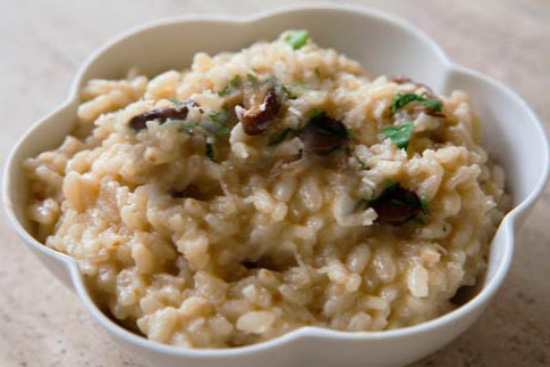
A version of risotto made with orzo
Serves: 4
5 tbsp. unsalted butter
8 oz. hen of the woods, chanterelle, or morel mushrooms, cleaned and halved if large
1/2 cup minced shallots
1 tablespoon minced garlic
1¾ cups (12 oz.) orzo
1 tsp. minced fresh thyme
salt and freshly ground black pepper, to taste
½ cup cream
½ cup finely grated Parmesan, plus more for serving
Serves: 4
Preparation time: 30 minutes
Cooking time:1 hour
6 cups chicken or vegetable stock5 tbsp. unsalted butter
8 oz. hen of the woods, chanterelle, or morel mushrooms, cleaned and halved if large
1/2 cup minced shallots
1 tablespoon minced garlic
1¾ cups (12 oz.) orzo
1 tsp. minced fresh thyme
salt and freshly ground black pepper, to taste
½ cup cream
½ cup finely grated Parmesan, plus more for serving
Heat chicken stock in a small saucepan over medium heat; set aside and keep warm. Heat butter in a 4-qt. saucepan over medium-high heat. Working in batches, add mushrooms and cook until golden, 5–7 minutes. Using a slotted spoon, transfer mushrooms to a bowl; set aside. Add shallots and garlic to saucepan; cook, stirring, until soft, 3 minutes.
Add orzo, thyme, salt, and pepper; cook 2 minutes. Add reserved stock ¼ cup at a time, cooking until each addition is absorbed before adding next amount. Cook, stirring often, until liquid has all been used and orzo is tender, about 25-30 minutes. Add cream and cook, stirring, until liquid is creamy, about 3 minutes more. Remove from heat and stir in reserved mushrooms, Parmesan, salt, and pepper; serve with additional Parmesan on the side.
Add orzo, thyme, salt, and pepper; cook 2 minutes. Add reserved stock ¼ cup at a time, cooking until each addition is absorbed before adding next amount. Cook, stirring often, until liquid has all been used and orzo is tender, about 25-30 minutes. Add cream and cook, stirring, until liquid is creamy, about 3 minutes more. Remove from heat and stir in reserved mushrooms, Parmesan, salt, and pepper; serve with additional Parmesan on the side.
Appetizer Panettone 
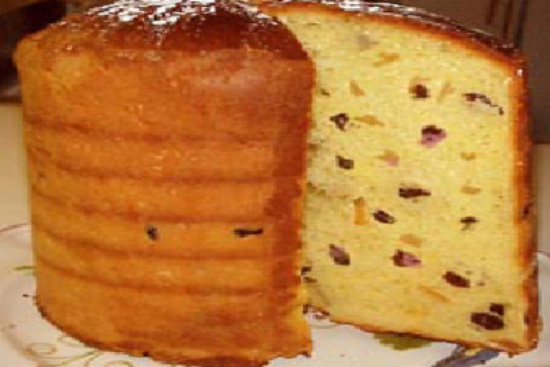
https://theseamanmom.com/classic-easy-panettone-cake-recipe/
This typical Italian dessert would have been the creation of a young baker whose name was Tony. To charm his Milanese girlfriend, he invented this dessert, that became "pan di Toni", the panettone
Serves: 10
1 tbsp dried yeast
8 tbsp sugar
2 sticks butter room temperature
5 large eggs beaten
2 tsp vanilla extract
grated zest of 1 lemon
grated zest of 1 orange
3 1/2 cups flour plus extra (up to 1/2 to 2/3 cups more)
pinch of salt
7 tbsp raisins
3 tbsp rum extract
8 tbsp candied lemon and orange peel finely chopped
butter for greasing
For the topping
1 tbsp egg white
1 tbsp icing sugar
more icing sugar for dusting
This typical Italian dessert would have been the creation of a young baker whose name was Tony. To charm his Milanese girlfriend, he invented this dessert, that became "pan di Toni", the panettone
Serves: 10
Preparation time:2 hours
Cooking time:1 hour
4 tbsp warm milk1 tbsp dried yeast
8 tbsp sugar
2 sticks butter room temperature
5 large eggs beaten
2 tsp vanilla extract
grated zest of 1 lemon
grated zest of 1 orange
3 1/2 cups flour plus extra (up to 1/2 to 2/3 cups more)
pinch of salt
7 tbsp raisins
3 tbsp rum extract
8 tbsp candied lemon and orange peel finely chopped
butter for greasing
For the topping
1 tbsp egg white
1 tbsp icing sugar
more icing sugar for dusting
Grease a Panettone pan with softened butter
Place the warm milk in a bowl and add the yeast and 1 tsp of sugar, mix well and leave for a few minutes.
Put the remaining sugar in a large bowl and beat together with the butter and vanilla extract, using a hand mixer, until light and creamy.
Add lemon and orange zest and mix.
Add the eggs a little at a time until all are well incorporated.
If the mixture starts to curdle, add a tablespoon of the flour and beat in with the eggs.
Place the flour in a large bowl and mix with a pinch of salt and make a well.
Add the yeast mixture then the butter and egg mixture, folding in with a large spoon to make a soft dough.
Knead for 5 mins in the bowl until the mixture starts to come together and is pretty sticky.
Put the dough onto a floured surface and knead for 10 more minutes, until everything has come together and you get a soft, stretchy dough. Add a light sprinkling of flour to the surface and your hands to stop the mixture sticking.
Place in a lightly greased bowl and cover with plastic wrap; keep in a warm place for 2 hrs or until it doubled in size.
Place the raisins in a small saucepan with the rum extract and heat on low for about 5 mins or until the fruit has absorbed the liquid; set aside to cool.
When the dough is risen, tip it out onto a lightly floured surface and knead for another 5 mins.
Gradually knead in the soaked raisins and chopped candied peel. Shape the dough into a ball and pop into the prepared Panettone pan.
If using an 8" deep cake pan, wrap a layer of baking parchment around the outside of the tin, to come up about 2" above the rim, and secure the paper with string. This will help contain the dough as it rises.
Cover lightly with a towel or plastic wrap and leave to rise for another hour until it has risen to the top of the pan or paper.
Preheat the oven to 350 F
Mix together the icing sugar and egg white and gently brush over the top of the Panettone.
Place the Panettone in the oven and bake for 50 - 55 mins or until golden and risen. Insert a skewer into the middle of the cake to test if done.
Leave to cool in the pan for 10 mins before turning out onto a cooling rack.
Leave to cool completely before dusting with icing sugar.
Cut into wedges to serve.
Notes
Notes: Start with 2 and 1/4 cup of flour. Initially the dough will be very sticky and hard to knead. Continue to work on the dough adding more flour. In the initial stage, you might need to add up to 1/4 cup more.
Then you will be dusting flour a lot throughout the entire process: you need to dust the bowl where you prepare the dough so you can remove the dough from the bowl and move it to the counter to knead. You also need to dust your hands to help the dough come together and remove it from the bowl. You’ll need to dust the working area so the dough doesn’t stick. While here, you’ll need more dusting for your hands so you can knead the dough.
Then you move the dough to a bowl and wait for it to rise. Next you’ll move the dough from the bowl to the counter top to knead one more time and incorporate the fruit.
You might end up adding up to 3 and 2/3 to 4 cups of flour in total. Adding flour bit by bit while kneading is what makes the bread so soft and gives it that special texture.
It’s a very soft, sticky, elastic dough. The stickiness is due to the amount of butter added. It makes this cake soft, fluffy and moist.
Place the warm milk in a bowl and add the yeast and 1 tsp of sugar, mix well and leave for a few minutes.
Put the remaining sugar in a large bowl and beat together with the butter and vanilla extract, using a hand mixer, until light and creamy.
Add lemon and orange zest and mix.
Add the eggs a little at a time until all are well incorporated.
If the mixture starts to curdle, add a tablespoon of the flour and beat in with the eggs.
Place the flour in a large bowl and mix with a pinch of salt and make a well.
Add the yeast mixture then the butter and egg mixture, folding in with a large spoon to make a soft dough.
Knead for 5 mins in the bowl until the mixture starts to come together and is pretty sticky.
Put the dough onto a floured surface and knead for 10 more minutes, until everything has come together and you get a soft, stretchy dough. Add a light sprinkling of flour to the surface and your hands to stop the mixture sticking.
Place in a lightly greased bowl and cover with plastic wrap; keep in a warm place for 2 hrs or until it doubled in size.
Place the raisins in a small saucepan with the rum extract and heat on low for about 5 mins or until the fruit has absorbed the liquid; set aside to cool.
When the dough is risen, tip it out onto a lightly floured surface and knead for another 5 mins.
Gradually knead in the soaked raisins and chopped candied peel. Shape the dough into a ball and pop into the prepared Panettone pan.
If using an 8" deep cake pan, wrap a layer of baking parchment around the outside of the tin, to come up about 2" above the rim, and secure the paper with string. This will help contain the dough as it rises.
Cover lightly with a towel or plastic wrap and leave to rise for another hour until it has risen to the top of the pan or paper.
Preheat the oven to 350 F
Mix together the icing sugar and egg white and gently brush over the top of the Panettone.
Place the Panettone in the oven and bake for 50 - 55 mins or until golden and risen. Insert a skewer into the middle of the cake to test if done.
Leave to cool in the pan for 10 mins before turning out onto a cooling rack.
Leave to cool completely before dusting with icing sugar.
Cut into wedges to serve.
Notes
Notes: Start with 2 and 1/4 cup of flour. Initially the dough will be very sticky and hard to knead. Continue to work on the dough adding more flour. In the initial stage, you might need to add up to 1/4 cup more.
Then you will be dusting flour a lot throughout the entire process: you need to dust the bowl where you prepare the dough so you can remove the dough from the bowl and move it to the counter to knead. You also need to dust your hands to help the dough come together and remove it from the bowl. You’ll need to dust the working area so the dough doesn’t stick. While here, you’ll need more dusting for your hands so you can knead the dough.
Then you move the dough to a bowl and wait for it to rise. Next you’ll move the dough from the bowl to the counter top to knead one more time and incorporate the fruit.
You might end up adding up to 3 and 2/3 to 4 cups of flour in total. Adding flour bit by bit while kneading is what makes the bread so soft and gives it that special texture.
It’s a very soft, sticky, elastic dough. The stickiness is due to the amount of butter added. It makes this cake soft, fluffy and moist.
Appetizer Parmesan and thyme crackers 
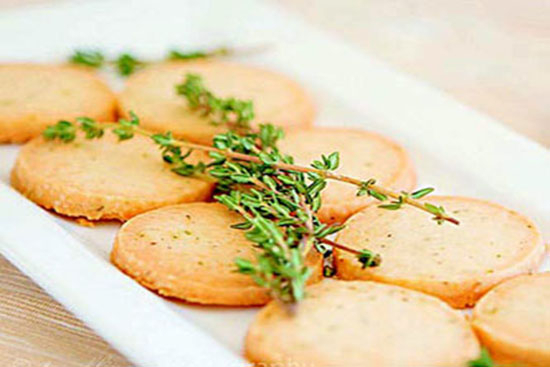
Serves: 8
Preparation time: 20 minutes
Cooking time:25 minutes
1/4 pound (1 stick) unsalted butter, at room temperature4 ounces freshly grated Parmesan cheese (about 1 cup)
1 teaspoon minced fresh thyme leaves
1/2 teaspoon kosher salt
1/2 teaspoon freshly ground black pepper
1 1/4 cups all-purpose flour
In the bowl of an electric mixer fitted with the paddle attachment, cream the butter for 1 minute. With the mixer on low speed, add the Parmesan, thyme, salt, and pepper and combine. With the mixer still on low, add the flour and combine until the mixture is in large crumbles, about 1 minute. If the dough is too dry, add 1 teaspoon water.
Dump the dough onto a floured board, press it into a ball, and roll into a 9-inch log. Wrap in plastic and refrigerate for at least 30 minutes or for up to 4 days.
Meanwhile, preheat the oven to 350 degrees F. Cut the log into 3/8-inch-thick rounds with a small, sharp knife and place them on a sheet pan lined with parchment paper. Bake for 22 minutes, until very lightly browned. Rotate the pan once during baking. Cool and serve at room temperature.
Dump the dough onto a floured board, press it into a ball, and roll into a 9-inch log. Wrap in plastic and refrigerate for at least 30 minutes or for up to 4 days.
Meanwhile, preheat the oven to 350 degrees F. Cut the log into 3/8-inch-thick rounds with a small, sharp knife and place them on a sheet pan lined with parchment paper. Bake for 22 minutes, until very lightly browned. Rotate the pan once during baking. Cool and serve at room temperature.
Appetizer Parmesan sage polenta sticks 
Serves: 7
Preparation time: 25 minutes
Cooking time:30 minutes
4 cups water 1 1/4 teaspoons salt
1 tablespoon minced fresh sage leaves or 1 teaspoon dried, crumbled
1 1/3 cups yellow cornmeal
1/2 stick (1/4 cup) unsalted butter
1 cup freshly grated Parmesan cheese (about 1/4 pound)
Butter a 13- by 9-inch glass baking dish. In a large heavy saucepan bring water to a boil and add salt. Add sage and 1/3 cup cornmeal., a little at a time, stirring constantly. Reduce heat to low and add remaining cup cornmeal in a slow stream, stirring constantly. Cook mixture over low heat, whisking, 1 minute and remove pan from heat. Add 2 tablespoons butter and 1/3 cup Parmesan and stir polenta until butter is incorporated.
Working quickly, spread polenta evenly in prepared dish and chill until firm, about 20 minutes. Polenta may be prepared up to this point 1 day ahead and chilled, covered.
Preheat broiler and line a baking sheet with foil. In a small saucepan melt remaining 2 tablespoons butter over low heat. Invert polenta onto a work surface.
Halve polenta lengthwise and cut each half crosswise into 14 sticks. Arrange sticks on prepared baking sheet and brush with melted butter.
Broil sticks about 4 inches from heat until golden, about 4 to 6 minutes.
Turn sticks over and sprinkle with remaining Parmesan. Broil sticks until cheese is golden, about 2 to 3 minutes more.
Working quickly, spread polenta evenly in prepared dish and chill until firm, about 20 minutes. Polenta may be prepared up to this point 1 day ahead and chilled, covered.
Preheat broiler and line a baking sheet with foil. In a small saucepan melt remaining 2 tablespoons butter over low heat. Invert polenta onto a work surface.
Halve polenta lengthwise and cut each half crosswise into 14 sticks. Arrange sticks on prepared baking sheet and brush with melted butter.
Broil sticks about 4 inches from heat until golden, about 4 to 6 minutes.
Turn sticks over and sprinkle with remaining Parmesan. Broil sticks until cheese is golden, about 2 to 3 minutes more.
Appetizer Pesto 

Serves: 6
Preparation time: 15 minutes
Cooking time:None
2 cups fresh basil leaves 1/2 cup olive oil
2 teaspoons pine nuts
2 cloves crushed garlic
1/4 teaspoon salt
1/2 cup grated parmesan
2 teaspoons grated romano or pecorino
3 teaspoons butter, soft
In a blender, combine basil, oil, pine nuts, garlic and salt. Blend to a puree.
Scrape edges of bowl to push all ingredients down.
Pour into a bowl.
Beat in the cheeses and soft butter. Serve with pasta.
Add a tablespoon of hot water in which pasta has boiled to pesto to soften.
Scrape edges of bowl to push all ingredients down.
Pour into a bowl.
Beat in the cheeses and soft butter. Serve with pasta.
Add a tablespoon of hot water in which pasta has boiled to pesto to soften.
Appetizer Polenta fries 
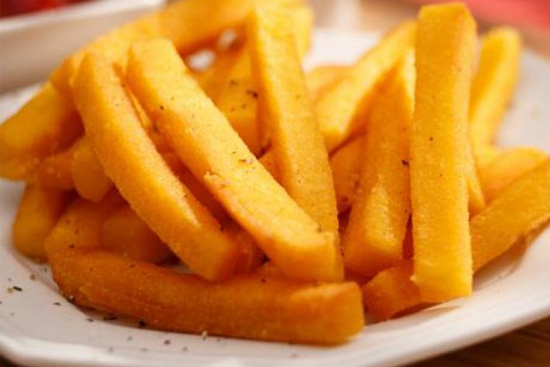
polenta or cornmeal
They're used interchangeably. Yet polenta is a dish, and cornmeal is an ingredient — often the main ingredient in that dish. Hailing from northern Italy, polenta was originally a meal of any grain, coarsely ground and slow-cooked in liquid until softened.
Serves: 4
3 ⅓ cups chicken or vegetable stock (800ml)
4 tbsp butter (60g)
½ cup freshly grated parmesan (30g)
2 sprigs fresh rosemary finely chopped
2 tsp dried oregano
½ tsp salt
Pinch of pepper
1 tbsp olive oil
Serves: 4
Preparation time:10 minutes
Cooking time:30 minutes
1 cup quick-cook polenta (190g)3 ⅓ cups chicken or vegetable stock (800ml)
4 tbsp butter (60g)
½ cup freshly grated parmesan (30g)
2 sprigs fresh rosemary finely chopped
2 tsp dried oregano
½ tsp salt
Pinch of pepper
1 tbsp olive oil
Add the stock to a medium sized pot and bring to a boil.
Once boiling turn the heat down to a simmer and slowly add the polenta whilst stirring until all the polenta is fully incorporated.
Next, add the butter, parmesan, herbs and salt and stir until the butter has melted and the polenta has thickened slightly (2-3 minutes).
Pour the cooked polenta into a lined baking dish (10x8 inch) and spread it out evenly. Let the polenta cool completely then chill in the fridge covered with plastic wrap for 1-2 hours or overnight.
Pre-heat the oven to 430F/220C.
Once chilled and completely set, remove the polenta from the tray and cut into fries.
Place the fries on a baking tray and brush with olive oil. Bake in the oven for 30 minutes until golden brown and crispy. Serve as a side or appetizer.
Once boiling turn the heat down to a simmer and slowly add the polenta whilst stirring until all the polenta is fully incorporated.
Next, add the butter, parmesan, herbs and salt and stir until the butter has melted and the polenta has thickened slightly (2-3 minutes).
Pour the cooked polenta into a lined baking dish (10x8 inch) and spread it out evenly. Let the polenta cool completely then chill in the fridge covered with plastic wrap for 1-2 hours or overnight.
Pre-heat the oven to 430F/220C.
Once chilled and completely set, remove the polenta from the tray and cut into fries.
Place the fries on a baking tray and brush with olive oil. Bake in the oven for 30 minutes until golden brown and crispy. Serve as a side or appetizer.
Appetizer Pumpkin and sweet garlic custards 
Serves: 8
Preparation time: 30 minutes
Cooking time:1 hour 20 minutes
2 heads garlic, separated into cloves but not peeled (approximately 20 cloves) 1 3-pound sugar pumpkin or butternut squash, peeled, seeded, and cut into 1-inch cubes
2 tablespoons unsalted butter
4 large eggs
2 cups heavy cream
2 teaspoons finely chopped fresh marjoram leaves
1/4 teaspoon freshly grated nutmeg
Coarse salt and freshly ground white pepper to taste
8 small sprigs
fresh marjoram, for garnish
Put the garlic cloves in a small saucepan. Add enough cold salted water to cover and bring to a boil over high heat. Drain, discarding the water. Return the garlic cloves to the pan, add more water and salt, and repeat twice more. When the water comes to a boil for the third time, reduce the heat and simmer for about 12 minutes, until the cloves are tender. Drain, and set aside 8 cloves for garnish. Peel the remaining cloves.
Meanwhile, put the pumpkin in a 2 1/2-quart saucepan. Add enough cold salted water to cover, and bring to a boil over high heat. Reduce the heat and simmer for about 6 to 8 minutes, or until tender when pierced with the tip of a small, sharp knife. Drain.
In a 12-inch sauté pan, heat the butter over medium-high heat. Add the squash and peeled garlic cloves, and cook for 5 to 10 minutes, stirring often to avoid scorching, until the excess moisture evaporates. Remove from the heat to cool to room temperature. Preheat the oven to 350°F.
Transfer the squash and garlic to a blender or a food processor fitted with the metal blade and process until smooth.
Add the eggs, cream, marjoram, and nutmeg. Season with salt and pepper, and pulse to combine. Ladle the custard into eight 4-ounce ramekins. Set the ramekins in a shallow roasting pan or baking pan, cover loosely with a sheet of foil, and put the pan in the oven. Pour enough hot water into the pan to come halfway up the sides of the ramekins.
Bake for 35 to 40 minutes, until the custards are set around the edges but still a little shaky in the center. Check the custards after about 15 minutes in the oven. If they are puffing up and resembling souffles, reduce the oven temperature to 325°F. Carefully remove the pan from the oven. If not serving right away, let the heat escape from the oven and, at the same time, reduce the temperature to its lowest setting (between 180° and 200°F). Let the custards cool slightly in the water bath, then lift the ramekins from the water and serve immediately or return them to the oven to keep warm. Serve the custards in the ramekins or unmolded, inverted onto a plate. To serve, garnish each custard with a reserved unpeeled clove of garlic and a sprig of marjoram.
NOTE:
If making well in advance, remove the ramekins from the water bath and allow to cool to room temperature. Cover the ramekins with plastic wrap and refrigerate them. To reheat, place the custards, still covered with plastic wrap, in a large saute pan and add enough water to come about 1/2 inch up the sides of the ramekins. Bring to a simmer over low heat for about 30 minutes, or until the custards are warmed through. Off the heat, the custards will keep warm in the water bath for up to 30 minutes.
VARIATIONS:
This recipe can be used to make custards with vegetables that have low fiber and water content, such as cauliflower, carrots, parsnips, and turnips. If using a more fibrous vegetable such as peas or asparagus, you must first sieve them.
Meanwhile, put the pumpkin in a 2 1/2-quart saucepan. Add enough cold salted water to cover, and bring to a boil over high heat. Reduce the heat and simmer for about 6 to 8 minutes, or until tender when pierced with the tip of a small, sharp knife. Drain.
In a 12-inch sauté pan, heat the butter over medium-high heat. Add the squash and peeled garlic cloves, and cook for 5 to 10 minutes, stirring often to avoid scorching, until the excess moisture evaporates. Remove from the heat to cool to room temperature. Preheat the oven to 350°F.
Transfer the squash and garlic to a blender or a food processor fitted with the metal blade and process until smooth.
Add the eggs, cream, marjoram, and nutmeg. Season with salt and pepper, and pulse to combine. Ladle the custard into eight 4-ounce ramekins. Set the ramekins in a shallow roasting pan or baking pan, cover loosely with a sheet of foil, and put the pan in the oven. Pour enough hot water into the pan to come halfway up the sides of the ramekins.
Bake for 35 to 40 minutes, until the custards are set around the edges but still a little shaky in the center. Check the custards after about 15 minutes in the oven. If they are puffing up and resembling souffles, reduce the oven temperature to 325°F. Carefully remove the pan from the oven. If not serving right away, let the heat escape from the oven and, at the same time, reduce the temperature to its lowest setting (between 180° and 200°F). Let the custards cool slightly in the water bath, then lift the ramekins from the water and serve immediately or return them to the oven to keep warm. Serve the custards in the ramekins or unmolded, inverted onto a plate. To serve, garnish each custard with a reserved unpeeled clove of garlic and a sprig of marjoram.
NOTE:
If making well in advance, remove the ramekins from the water bath and allow to cool to room temperature. Cover the ramekins with plastic wrap and refrigerate them. To reheat, place the custards, still covered with plastic wrap, in a large saute pan and add enough water to come about 1/2 inch up the sides of the ramekins. Bring to a simmer over low heat for about 30 minutes, or until the custards are warmed through. Off the heat, the custards will keep warm in the water bath for up to 30 minutes.
VARIATIONS:
This recipe can be used to make custards with vegetables that have low fiber and water content, such as cauliflower, carrots, parsnips, and turnips. If using a more fibrous vegetable such as peas or asparagus, you must first sieve them.
Appetizer Pumpkin gnocchi with almond pesto 
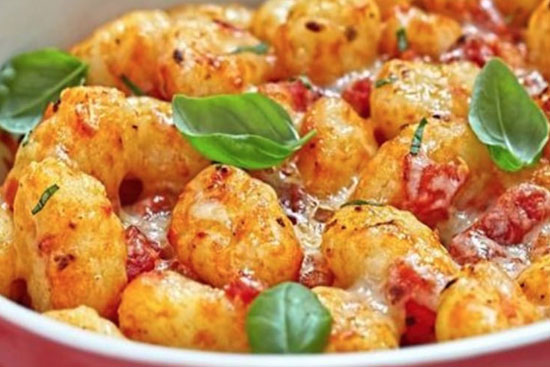
Serves: 4
Preparation time:30 minutes
Cooking time:40 minutes
1 lb butternut squash, halved, seeded, and cut into wedges3.5 oz flour
1 pinch freshly grated nutmeg
12 sage leaves
2 oz raw almonds
1 garlic clove
1 tsp nutritional yeast (yeast flakes)
5 tbsp extra virgin olive oil
2 oz oil-packed semi-dried or sun-dried tomatoes, drained, patted dry, and finely chopped
1 pinch each of salt and black pepper
1. Preheat the oven to 200°C/400°F/gas mark 6. Line a sheet pan with parchment paper.
2. Spread the pumpkin over the prepared pan. Cover with foil and bake for 20 minutes, then remove the foil and bake for about 20 minutes more, until the pumpkin is tender.
3. Remove from the oven and let cool, then scoop the flesh of the pumpkin into a bowl and mash it with a potato ricer.
4. Bring a large pot of salted water to a boil.
5. Add the flour, nutmeg, and a pinch of salt to the bowl with the pumpkin and stir briefly to combine.
6. On a lightly floured surface, roll the mixture into long cylinders around 2cm (¾in) in diameter, then cut the cylinders into 3cm-long (1¼in) gnocchi.
7. In a food processor, combine the sage, almonds, garlic, nutritional yeast, olive oil, a pinch of salt and pepper, and process until the mixture is well combined and smooth.
8. Add the gnocchi to the boiling water and cook until they start to float, then cook for 1 minute more. Drain the gnocchi and return them to the pot.
9. Toss the gnocchi with the sage pesto, add the tomatoes and serve.
2. Spread the pumpkin over the prepared pan. Cover with foil and bake for 20 minutes, then remove the foil and bake for about 20 minutes more, until the pumpkin is tender.
3. Remove from the oven and let cool, then scoop the flesh of the pumpkin into a bowl and mash it with a potato ricer.
4. Bring a large pot of salted water to a boil.
5. Add the flour, nutmeg, and a pinch of salt to the bowl with the pumpkin and stir briefly to combine.
6. On a lightly floured surface, roll the mixture into long cylinders around 2cm (¾in) in diameter, then cut the cylinders into 3cm-long (1¼in) gnocchi.
7. In a food processor, combine the sage, almonds, garlic, nutritional yeast, olive oil, a pinch of salt and pepper, and process until the mixture is well combined and smooth.
8. Add the gnocchi to the boiling water and cook until they start to float, then cook for 1 minute more. Drain the gnocchi and return them to the pot.
9. Toss the gnocchi with the sage pesto, add the tomatoes and serve.
Appetizer Roasted tomato caprese salad 
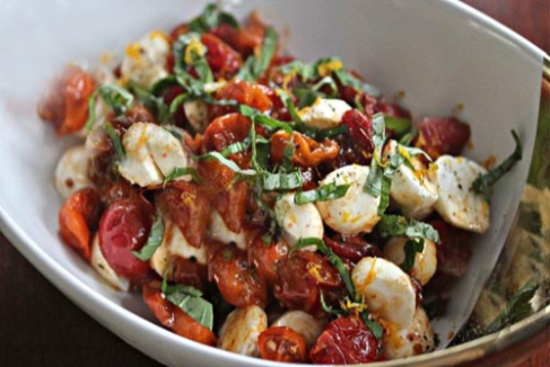
Serves: 6
Preparation time:10 minutes
Cooking time:1 hour
1 1/2 pounds cherry tomatoes1 1/2 tablespoons olive oil
1 teaspoon maple syrup
1 1/2 teaspoons balsamic vinegar
1/4 teaspoon sugar
Kosher salt and freshly ground black pepper
1 pound small fresh mozzarella balls (bocconcini), halved
1/4 cup basil leaves, finely sliced
1 teaspoon grated zest from 1 lemon
Heat oven to 375F. Add cherry tomatoes, olive oil, maple syrup, balsamic vinegar, and sugar to 9 by 13 inch baking dish. Toss to combine. Roast until just starting to char, about 40 minutes, tossing occasionally to cook evenly.
Remove from oven and cool 5 to 10 minutes. Transfer tomatoes along with any any accumulated juices to large bowl. Add mozzarella and basil. Gently toss to combine. Add lemon zest then season with salt and pepper. Toss again and serve.
Remove from oven and cool 5 to 10 minutes. Transfer tomatoes along with any any accumulated juices to large bowl. Add mozzarella and basil. Gently toss to combine. Add lemon zest then season with salt and pepper. Toss again and serve.
Appetizer Roasted tomatoes 
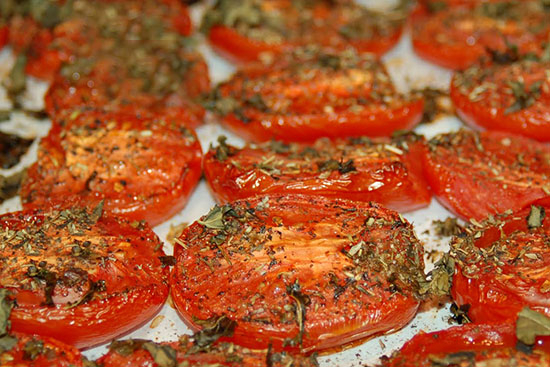
Serves: 10
Preparation time: 15 minutes
Cooking time:2 hours
4 pounds ripe plum tomatoes (20 whole) 4 cloves garlic, minced
1/4 cup chopped fresh basil
1/4 cup olive oil
1/4 teaspoon salt
1/4 teaspoon pepper
Trim stem ends of tomatoes; cut in half lengthwise.
Arrange, cut side up and without crowding, on large foil-lined rimmed baking sheet.
Stir together garlic, basil and oil; brush over tomatoes. Sprinkle with salt and pepper. Bake in 250 degree oven for 2 hours or until tomatoes are softened and shrivelled, and edges begin to darken.
Tip:
To make Roasted Tomato Crostini,
1 french baguette
4 ounces soft goat cheese Cut French baguette into 20 slices;
place on baking sheet and broil until toasted.
Evenly spread with goat cheese; top each with 2 tomato halves and 1 basil leaf.
Arrange, cut side up and without crowding, on large foil-lined rimmed baking sheet.
Stir together garlic, basil and oil; brush over tomatoes. Sprinkle with salt and pepper. Bake in 250 degree oven for 2 hours or until tomatoes are softened and shrivelled, and edges begin to darken.
Tip:
To make Roasted Tomato Crostini,
1 french baguette
4 ounces soft goat cheese Cut French baguette into 20 slices;
place on baking sheet and broil until toasted.
Evenly spread with goat cheese; top each with 2 tomato halves and 1 basil leaf.
Appetizer Roasted tomatoes and red peppers 
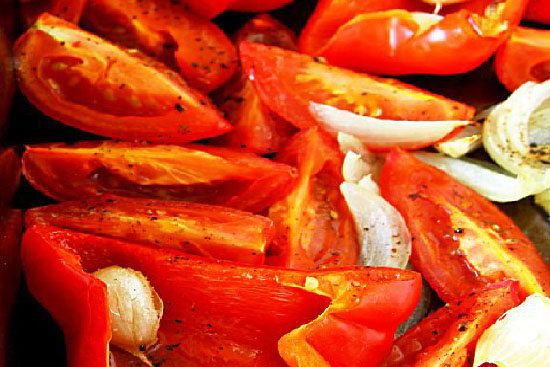
Serves: 8
Preparation time: 30 minutes
Cooking time:2 hours
2 1/2 pounds firm, ripe roma or plum tomatoes (about 15) 1 whole head of garlic
3 sweet red peppers
1/2 teaspoon each hot pepper flakes and salt
1/3 cup olive oil
Immerse tomatoes in large saucepan boiling water 10 seconds or until skins losen. Drain, then chill under running water. Remove core and slip off skins.
Cut tomatoes in half horizontally; squeeze tomatoes gently between hands to extract juice and seeds.
Place tomato flesh in 9-by-13in non metallic baking dish. Break head of garlic into individual cloves; peel cloves and add to tomatoes. Cut peppers in half and remove seeds and white membranes. Cut peppers into 1 1/2-in strips; add to tomatoes. Add olive oil to tomato mixture, tossing to coat ingredients well.
Spread ingredients out in single layer; sprinkle with hot pepper flakes and salt. Roast in 350 degree oven 1 1/2 to 2 hours or until tomatoes are shiny and reduces in volume by about half and no liquid remains in dish. Serve at once or spoon into hot sterilized jars and cover tightly. Refrigerate for up to 1 week or freeze for up to 1 month.
This irresistible appetizer captures the essence of summer in a jar. Serve it as part of an antipasto platter or use it to top crusty bread for instant bruschetta.
Cut tomatoes in half horizontally; squeeze tomatoes gently between hands to extract juice and seeds.
Place tomato flesh in 9-by-13in non metallic baking dish. Break head of garlic into individual cloves; peel cloves and add to tomatoes. Cut peppers in half and remove seeds and white membranes. Cut peppers into 1 1/2-in strips; add to tomatoes. Add olive oil to tomato mixture, tossing to coat ingredients well.
Spread ingredients out in single layer; sprinkle with hot pepper flakes and salt. Roast in 350 degree oven 1 1/2 to 2 hours or until tomatoes are shiny and reduces in volume by about half and no liquid remains in dish. Serve at once or spoon into hot sterilized jars and cover tightly. Refrigerate for up to 1 week or freeze for up to 1 month.
This irresistible appetizer captures the essence of summer in a jar. Serve it as part of an antipasto platter or use it to top crusty bread for instant bruschetta.
Appetizer Roman maritozzi 
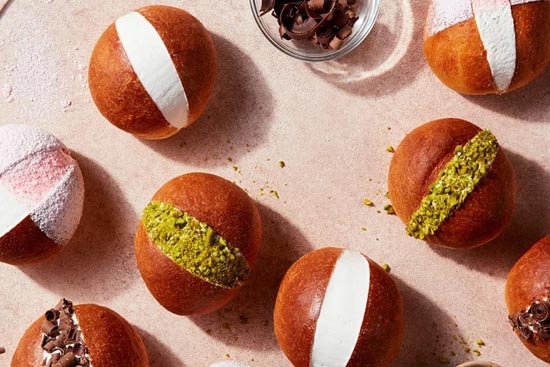
A Roman maritozzo is the epitome of simple and sublime: The two components — a fluffy roll (in this case, it's a mini brioche) and freshly-whipped cream — are elemental on their own but join forces to create a treat that's light yet decadent, rich. The whipped cream is a blank canvas for sliced fruit, chopped nuts, and chocolate.
The Resting Time for the dough: 3 hours
Total Time : about 4 hours 25 minutes
Serves: 6
1 teaspoon active dry yeast
2 cups +2½ tablespoons flour 00 (270 grams total)
3½ tablespoons fine sugar (divided)
1 large egg (room temperature)
4 tablespoons butter (softened)
½ tablespoon orange
½ teaspoon vanilla extract
¼ teaspoon salt (if you use unsalted butter then add ½ teaspoon of salt)
EGG WASH
1 large egg
1 tablespoon milk
SUGAR SYRUP
½ cup water
3-4 tablespoons granulated sugar
FOR THE CREAM FILLING
1 cup cream (whole, heavy or whipping cream at least 30% fat content)
1-2 tablespoons powdered sugar
Serves: 6
Preparation time:40 minutes
Cooking time:15 minutes
¼ cup + 3 tablespoons whole milk (lukewarm) (105 grams total)1 teaspoon active dry yeast
2 cups +2½ tablespoons flour 00 (270 grams total)
3½ tablespoons fine sugar (divided)
1 large egg (room temperature)
4 tablespoons butter (softened)
½ tablespoon orange
½ teaspoon vanilla extract
¼ teaspoon salt (if you use unsalted butter then add ½ teaspoon of salt)
EGG WASH
1 large egg
1 tablespoon milk
SUGAR SYRUP
½ cup water
3-4 tablespoons granulated sugar
FOR THE CREAM FILLING
1 cup cream (whole, heavy or whipping cream at least 30% fat content)
1-2 tablespoons powdered sugar
In a small bowl mix together the milk and 1½ teaspoons of sugar, sprinkle the yeast on top and let sit for 10 minutes, then mix together.
In the stand mixer add the flour, zest, remaining sugar, salt, egg, vanilla and yeast mixture, knead on low speed then increase the speed and knead for up to 7 minutes.
Add the butter and knead again for approximately 10-15 minutes, until the dough stops sticking to the side of the bowl and is soft, smooth and elastic.
Scrape the dough into a lightly buttered bowl to rise in a warm draft free area for approximately 2 hours or until doubled in bulk.
Transfer the dough to a lightly floured flat surface, divide into 6 parts and shape into a slightly oval shape. Place the buns on a parchment paper lined baked sheet, cover and let rise in a warm draft free area until doubled, approximately 1½ hours.
Pre-heat the oven to 350F/180C.
Brush the buns with the egg wash and bake for 18-20 minutes or until golden brown and baked through. Remove from the oven, move immediately to a wire rack to cool completely.
Brush the completely cooled buns with the sugar syrup, cut each bun on a slight angle be careful not to cut all the way through, fill the open area with whipped cream.
Dust with powdered sugar and serve immediately. Enjoy!
FOR THE EGG WASH
In a small bowl, beat together the egg and milk until combined well.
FOR THE CREAM FILLING
In a large bowl whip the cream until soft peaks appear then add the powdered sugar and continue to beat until thick peaks appear.
Notes
The dough can also be left to rise overnight in the fridge.
Storage
Once the maritozzi are filled with cream, they should be served and eaten immediately. Plan on making them and enjoying them the same day!
In the stand mixer add the flour, zest, remaining sugar, salt, egg, vanilla and yeast mixture, knead on low speed then increase the speed and knead for up to 7 minutes.
Add the butter and knead again for approximately 10-15 minutes, until the dough stops sticking to the side of the bowl and is soft, smooth and elastic.
Scrape the dough into a lightly buttered bowl to rise in a warm draft free area for approximately 2 hours or until doubled in bulk.
Transfer the dough to a lightly floured flat surface, divide into 6 parts and shape into a slightly oval shape. Place the buns on a parchment paper lined baked sheet, cover and let rise in a warm draft free area until doubled, approximately 1½ hours.
Pre-heat the oven to 350F/180C.
Brush the buns with the egg wash and bake for 18-20 minutes or until golden brown and baked through. Remove from the oven, move immediately to a wire rack to cool completely.
Brush the completely cooled buns with the sugar syrup, cut each bun on a slight angle be careful not to cut all the way through, fill the open area with whipped cream.
Dust with powdered sugar and serve immediately. Enjoy!
FOR THE EGG WASH
In a small bowl, beat together the egg and milk until combined well.
FOR THE CREAM FILLING
In a large bowl whip the cream until soft peaks appear then add the powdered sugar and continue to beat until thick peaks appear.
Notes
The dough can also be left to rise overnight in the fridge.
Storage
Once the maritozzi are filled with cream, they should be served and eaten immediately. Plan on making them and enjoying them the same day!
Appetizer Sicilian arancini 

Classic Sicilian Arancini Rice Balls
Arancini, rice balls stuffed with sauce peas or corn, are one of the best-loved Sicilian snacks and street foods, and they have become increasingly popular throughout Italy and worldwide.
The filling in this recipe is a meat ragù, green peas, and melty mozzarella, but there are endless other types of fillings including pistachios, mushrooms, prosciutto and mozzarella, ham, spinach, and more.
The rice is scented with saffron and the rice balls are rolled in breadcrumbs before frying them into balls. Usually, they're made with caciocavallo cheese, but since that can be difficult to find outside of Southern Italy, Parmigiano-Reggiano is used in this recipe.
They can be eaten as an antipasto or snack, or even as a meal when coupled with perhaps a salad or soup.
Serves: 6
10 1/2 ounces short-grain rice (Vialone Nano, Carnaroli, or Arborio)
1/4 teaspoon crushed saffron
1 1/2 cups water
2 tablespoons freshly grated Parmigiano-Reggiano cheese
3 oz unsalted butter
Fine sea salt (to taste)
Freshly ground black pepper (to taste)
For the Meat Sauce and Filling
1 tablespoon olive oil
1/3 cup yellow onion (about 1/2 small, finely chopped)
3 tablespoons carrot (finely chopped )
3 tablespoons celery (finely chopped)
3 ounces ground beef
3 ounces ground pork
2 tablespoons dry red wine
2 teaspoons tomato paste
1 cup tomato purée (passata di pomodoro)
1/3 cup green peas (fresh or frozen)
For the Rice Balls
Optional: 4.4 ounces fresh mozzarella cheese (diced)
1⁄4 cup all-purpose flour
2 large eggs
1/2 cup water
Pinch salt
2 cups breadcrumbs
2 inches vegetable oil (for frying)
Steps to Make It
Serves: 6
Preparation time:40 minutes
Cooking time:5 minutes
For the Rice10 1/2 ounces short-grain rice (Vialone Nano, Carnaroli, or Arborio)
1/4 teaspoon crushed saffron
1 1/2 cups water
2 tablespoons freshly grated Parmigiano-Reggiano cheese
3 oz unsalted butter
Fine sea salt (to taste)
Freshly ground black pepper (to taste)
For the Meat Sauce and Filling
1 tablespoon olive oil
1/3 cup yellow onion (about 1/2 small, finely chopped)
3 tablespoons carrot (finely chopped )
3 tablespoons celery (finely chopped)
3 ounces ground beef
3 ounces ground pork
2 tablespoons dry red wine
2 teaspoons tomato paste
1 cup tomato purée (passata di pomodoro)
1/3 cup green peas (fresh or frozen)
For the Rice Balls
Optional: 4.4 ounces fresh mozzarella cheese (diced)
1⁄4 cup all-purpose flour
2 large eggs
1/2 cup water
Pinch salt
2 cups breadcrumbs
2 inches vegetable oil (for frying)
Steps to Make It
Make the Rice
In a large saucepan over medium-high heat, place the rice, saffron, and 1 1/2 cups water and bring to a boil.
Cover, reduce heat to low, and let simmer about 15 to 20 minutes or until all of the water has been absorbed.
Remove lid, stir in grated Parmigiano, butter, salt, and pepper, to taste.
Spread the rice out on a large plate or baking dish to cool completely to room temperature.
Make the Meat Sauce and Filling
Heat the olive oil in a small saucepan over medium-high heat. Add the onions, carrots, and celery and sauté, stirring often, until softened and the onions are translucent - about 8 to 10 minutes.
Add the ground beef and pork and fry, stirring often, until browned - about 5 to 8 minutes.
Add the wine and let cook until the alcohol aroma has reduced - about 1 minute.
Stir in the tomato paste and tomato purée, reduce the heat to medium-low, and cook, stirring occasionally - about 10 minutes.
Stir in meat sauce.
Add the peas and continue to simmer the sauce for another 8 to 10 minutes, or until the peas are tender and the sauce is thickened. It should not be too liquidy.
Transfer the filling to a bowl and set aside to let it cool.
Once the rice and filling are completely cooled, start shaping your rice balls.
Place 1 heaping tablespoon of rice in the palm of one hand, then use your fingers and thumb to shape it into a hollow bowl shape.
Place about 1 teaspoon of the filling in the center and 1 to 2 small cubes of diced fresh mozzarella (if using).
Then gently close the rice around the filling to form either a round ball shape or a cone/pear shape.
When all of your arancini have been formed, whisk together the flour, eggs, 1/2 cup of water, and a pinch of salt in a shallow bowl until smooth.
Spread the bread crumbs in a plate or baking dish.
Gently roll each ball first in the egg-flour-water-salt mixture, letting any excess drip off.
Then roll them in the breadcrumbs until evenly coated.
At this point, you can refrigerate your arancini for 20 to 30 minutes to let them firm up if they seem a bit too loose or liquidy. If not, you can go directly to frying.
Heat about 2 inches of vegetable frying oil to 360F.
Fry your arancini in batches of just 2 to 3 at a time, being careful not to overcrowd the pot until they are evenly golden-brown - about 3 minutes.
Transfer them to a paper-towel-lined plate to drain.
Serve hot.
In a large saucepan over medium-high heat, place the rice, saffron, and 1 1/2 cups water and bring to a boil.
Cover, reduce heat to low, and let simmer about 15 to 20 minutes or until all of the water has been absorbed.
Remove lid, stir in grated Parmigiano, butter, salt, and pepper, to taste.
Spread the rice out on a large plate or baking dish to cool completely to room temperature.
Make the Meat Sauce and Filling
Heat the olive oil in a small saucepan over medium-high heat. Add the onions, carrots, and celery and sauté, stirring often, until softened and the onions are translucent - about 8 to 10 minutes.
Add the ground beef and pork and fry, stirring often, until browned - about 5 to 8 minutes.
Add the wine and let cook until the alcohol aroma has reduced - about 1 minute.
Stir in the tomato paste and tomato purée, reduce the heat to medium-low, and cook, stirring occasionally - about 10 minutes.
Stir in meat sauce.
Add the peas and continue to simmer the sauce for another 8 to 10 minutes, or until the peas are tender and the sauce is thickened. It should not be too liquidy.
Transfer the filling to a bowl and set aside to let it cool.
Once the rice and filling are completely cooled, start shaping your rice balls.
Place 1 heaping tablespoon of rice in the palm of one hand, then use your fingers and thumb to shape it into a hollow bowl shape.
Place about 1 teaspoon of the filling in the center and 1 to 2 small cubes of diced fresh mozzarella (if using).
Then gently close the rice around the filling to form either a round ball shape or a cone/pear shape.
When all of your arancini have been formed, whisk together the flour, eggs, 1/2 cup of water, and a pinch of salt in a shallow bowl until smooth.
Spread the bread crumbs in a plate or baking dish.
Gently roll each ball first in the egg-flour-water-salt mixture, letting any excess drip off.
Then roll them in the breadcrumbs until evenly coated.
At this point, you can refrigerate your arancini for 20 to 30 minutes to let them firm up if they seem a bit too loose or liquidy. If not, you can go directly to frying.
Heat about 2 inches of vegetable frying oil to 360F.
Fry your arancini in batches of just 2 to 3 at a time, being careful not to overcrowd the pot until they are evenly golden-brown - about 3 minutes.
Transfer them to a paper-towel-lined plate to drain.
Serve hot.
Appetizer Soft polenta 
Serves: 4
Preparation time: 10 minutes
Cooking time:10 minutes
3 cups chicken stock 2 teaspoons butter
coarse salt
white pepper
1 cup quick cooking polenta
1/4 cup creme fraiche
Place stock in medium saucepan over medium heat. Bring to a boil. Add butter and salt and pepper to taste.
Slowly add polenta, stirring constantly to keep lumps from forming. Lower heat and cook, stirring constantly, for 10 minutes, or until polenta is thickened and cooked.
Remove from heat and whip in the creme fraiche. Season to taste.
Slowly add polenta, stirring constantly to keep lumps from forming. Lower heat and cook, stirring constantly, for 10 minutes, or until polenta is thickened and cooked.
Remove from heat and whip in the creme fraiche. Season to taste.
Appetizer Sparkling lemon cream 
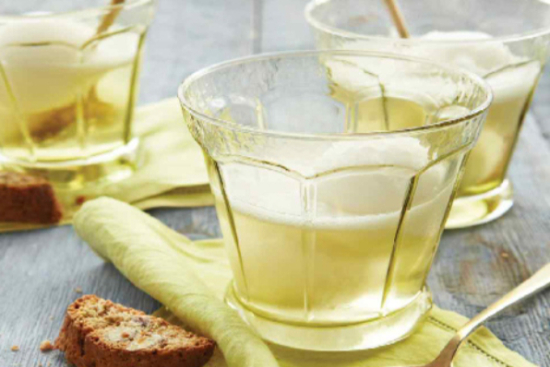
Serves: 8
Preparation time: 10 minutes
3 pints lemon sorbet 1 750-ml bottle chilled Prosecco or other dry white sparkling wine
1 1/2 cups chilled vodka
Place 1 pint sorbet, 1 cup chilled Proseco and 1/2 cup chilled vodka in blender and blend until smooth. Pour into large pitcher.
Repeat 2 more times with remaining sorbet, Proseco, and vodka; pour into same pitcher.
Place in freezer up to 3 hours. Whisk mixture to blend and, if necessary, let soften at room temperature 15 minutes. Pour into wine glasses or Champagne flutes.
To serve this as a dessert drink , serve with fresh berries and biscotti.
Repeat 2 more times with remaining sorbet, Proseco, and vodka; pour into same pitcher.
Place in freezer up to 3 hours. Whisk mixture to blend and, if necessary, let soften at room temperature 15 minutes. Pour into wine glasses or Champagne flutes.
To serve this as a dessert drink , serve with fresh berries and biscotti.
Appetizer Spring green risotto 
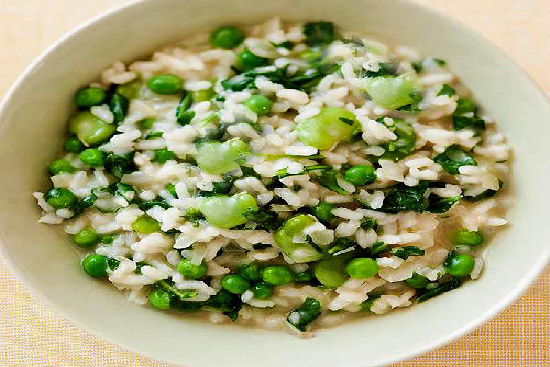
Recipe adaptation and courtesy of Courtesy Ina Garten from her new cookbook Back to Basics.
Serves: 6
1-1/2 tablespoons unsalted butter
3 cups chopped leeks, white and light green parts (2 leeks)
1 cup chopped fennel
1-1/2 cups Arborio rice
2/3 cup dry white wine
4 to 5 cups simmering chicken stock
1 pound thin asparagus
5 ounces frozen peas, defrosted, or 1 1/2 cups shelled fresh peas
5 ounces fava beans
1 tablespoon freshly grated lemon zest (2 lemons)
Kosher salt and freshly ground black pepper
2 tablespoons freshly squeezed lemon juice
1/3 cup mascarpone cheese, preferably Italian
1/2 cup freshly grated Parmesan cheese, plus extra for serving
3 tablespoons minced fresh chives, plus extra for serving
Serves: 6
Preparation time: 20 minutes
Cooking time:40 minutes
1- 1/2 tablespoons good olive oil1-1/2 tablespoons unsalted butter
3 cups chopped leeks, white and light green parts (2 leeks)
1 cup chopped fennel
1-1/2 cups Arborio rice
2/3 cup dry white wine
4 to 5 cups simmering chicken stock
1 pound thin asparagus
5 ounces frozen peas, defrosted, or 1 1/2 cups shelled fresh peas
5 ounces fava beans
1 tablespoon freshly grated lemon zest (2 lemons)
Kosher salt and freshly ground black pepper
2 tablespoons freshly squeezed lemon juice
1/3 cup mascarpone cheese, preferably Italian
1/2 cup freshly grated Parmesan cheese, plus extra for serving
3 tablespoons minced fresh chives, plus extra for serving
Heat the olive oil and butter in a medium saucepan over medium heat. Add the leeks and fennel and saute for 5 to 7 minutes, until tender. Add the rice and stir for a minute to coat with the vegetables, oil, and butter. Add the white wine and simmer over low heat, stirring constantly, until most of the wine has been absorbed. Add the chicken stock, 2 ladles at a time, stirring almost constantly and waiting for the stock to be absorbed before adding more. This process should take 25 to 30 minutes.
Meanwhile, cut the asparagus diagonally in 1 1/2-inch lengths and discard the tough ends. Blanch in boiling salted water for 4 to 5 minutes, until al dente. Drain and cool immediately in ice water. (If using fresh peas and fresh fava beans, blanch them in boiling water for a few minutes until the starchiness is gone.)
When the risotto has been cooking for 15 minutes, drain the asparagus and add it to the risotto with the peas, lemon zest, 2 teaspoons salt, and 1 teaspoon pepper. continue cooking and adding stock, stirring almost constantly, until the rice is tender but still firm.
Whisk the lemon juice and mascarpone together in a small bowl. When the risotto is done, turn off the heat and stir in the mascarpone mixture plus the Parmesan cheese and chives. set aside off the heat for a few minutes, sprinkle with salt and pepper, and serve hot with a sprinkling of chives and more Parmesan cheese.
Meanwhile, cut the asparagus diagonally in 1 1/2-inch lengths and discard the tough ends. Blanch in boiling salted water for 4 to 5 minutes, until al dente. Drain and cool immediately in ice water. (If using fresh peas and fresh fava beans, blanch them in boiling water for a few minutes until the starchiness is gone.)
When the risotto has been cooking for 15 minutes, drain the asparagus and add it to the risotto with the peas, lemon zest, 2 teaspoons salt, and 1 teaspoon pepper. continue cooking and adding stock, stirring almost constantly, until the rice is tender but still firm.
Whisk the lemon juice and mascarpone together in a small bowl. When the risotto is done, turn off the heat and stir in the mascarpone mixture plus the Parmesan cheese and chives. set aside off the heat for a few minutes, sprinkle with salt and pepper, and serve hot with a sprinkling of chives and more Parmesan cheese.
Appetizer Stuffed tomatoes with mussels 
Serves: 6
Preparation time: 20 minutes
6 medium ripe tomatoes 1/4 teaspoon salt
1/8 teaspoon white pepper
1 pound cooked mussels without shells
3/4 cup mayonnaise
1 teaspoon chopped fresh dill
6 lemon wedges
Wash tomatoes. Cut off the tops. scoop out insides, and sprinkle cavities with salt and pepper.
Combine mussels with mayonnaise and fill tomatoes.
Sprinkle with dill. Arrange tomatoes on a serving platter. Garnish with lemon wedges.
Combine mussels with mayonnaise and fill tomatoes.
Sprinkle with dill. Arrange tomatoes on a serving platter. Garnish with lemon wedges.
Appetizer Summer salad 
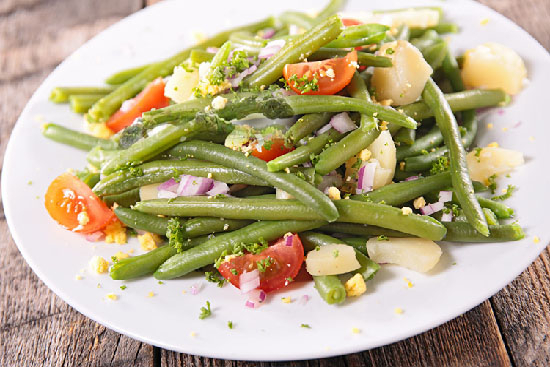
Serves: 4
Preparation time: 15 minutes
Cooking time:12 minutes
1/2 pound green beans (1-inch length) 1 pound cooked asparagus
2 cooked artichoke bottoms
2 tablespoons snipped chives
1 tablespoon minced parsley
1 tablespoon minced chervil
1 tomato
1 avocado
sherry vinegar mayonnaise
Cut green beans into 1-inch lengths.
Cook in boiling salted water until tender. Drain.
Cut asparagus into 1-inch lengths.
Cut each artichoke bottom into 6 wedges.
Combine beans, asparagus, artichokes, chives, parsley and chervil with enough mayonnaise to coat.
Peel and thinly slice the tomato.
Peel, pit and thinly slice the avocado.
Arrange the salad on four lettuce lined plates and garnish with tomato and avocado.
Cook in boiling salted water until tender. Drain.
Cut asparagus into 1-inch lengths.
Cut each artichoke bottom into 6 wedges.
Combine beans, asparagus, artichokes, chives, parsley and chervil with enough mayonnaise to coat.
Peel and thinly slice the tomato.
Peel, pit and thinly slice the avocado.
Arrange the salad on four lettuce lined plates and garnish with tomato and avocado.
Appetizer Sweet onion risotto cakes 
Serves: 6
Preparation time: 40 minutes
Cooking time:50 minutes
3 cups chicken stock 3 medium white onions
2 tablespoons olive oil
1 1/4 cups arborio rice
2 tablespoon chopped fresh parsley
2 tablespoon butter
coarse salt and pepper to taste
1/2 cup cornmeal
1/2 cup flour
Bring stock to a boil. Lower heat to just keep hot. Line a baking sheet with sides, with wax paper.
Peel onions and cut into fine dice. Heat olive oil, add onions and saute for 5 minutes, until slightly browned. Add the rice and stir to coat with oil. Add 2 cups of stock and bring to a simmer.
Simmer for 20 minutes, adding stock, 1/2 cup at a time, every 3 minutes, until you have used all the stock. Stir in parsley and butter. Taste and adjust seasoning with salt and pepper.
Pour out into lined pan and smooth top. Set aside to cool. Place cornmeal on a plate, set aside. When rice is cool, divide it into either six or twelve equal portions.
Press each portion into a 3-inch ring mold or pastry cutter to form a firm cake. Place cakes in cornmeal to coat each side generously.
Heat vegetable oil in a large saute pan over medium heat. Add the cakes and cook for about 2 minutes per side. until crisp and golden.
Peel onions and cut into fine dice. Heat olive oil, add onions and saute for 5 minutes, until slightly browned. Add the rice and stir to coat with oil. Add 2 cups of stock and bring to a simmer.
Simmer for 20 minutes, adding stock, 1/2 cup at a time, every 3 minutes, until you have used all the stock. Stir in parsley and butter. Taste and adjust seasoning with salt and pepper.
Pour out into lined pan and smooth top. Set aside to cool. Place cornmeal on a plate, set aside. When rice is cool, divide it into either six or twelve equal portions.
Press each portion into a 3-inch ring mold or pastry cutter to form a firm cake. Place cakes in cornmeal to coat each side generously.
Heat vegetable oil in a large saute pan over medium heat. Add the cakes and cook for about 2 minutes per side. until crisp and golden.
Appetizer Sweet potato gnocchi with sage and brown butter 
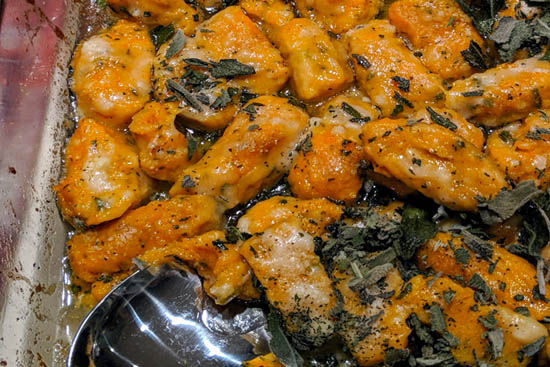
Make-ahead: the gnocchi can be boiled up to 4 hours ahead, and kept at room temperature.
Serves: 6
1/2 cup all-purpose flour, sifted, plus up to 1/2 cup for kneading
1/4 cup plus 2 tablespoons minced fresh sage
1/2 teaspoon salt
1 teaspoon freshly ground pepper
1/2 teaspoon nutmeg
1/2 cup grated Parmesan cheese, plus more for serving
1/2 cup (1 stick) unsalted butter
Serves: 6
Preparation time: 40 minutes
Cooking time:1 hour
1 1/2 pounds sweet potatoes, red skin variety 1/2 cup all-purpose flour, sifted, plus up to 1/2 cup for kneading
1/4 cup plus 2 tablespoons minced fresh sage
1/2 teaspoon salt
1 teaspoon freshly ground pepper
1/2 teaspoon nutmeg
1/2 cup grated Parmesan cheese, plus more for serving
1/2 cup (1 stick) unsalted butter
1. Preheat the oven to 350F/175C. Poke a few holes in each sweet potato to let steam escape, then place them on a baking sheet. Bake them until they're tender, about 45 minutes.
2. When the potatoes are cool enough to handle, peel them and pass them through a ricer, or a food mill with a fine grate.
3. Place the puree in a large bowl and add the flour, 2 tablespoons of the sage, the salt and pepper, nutmeg and the cheese. Mix gently until just combined.
4. Flour a work surface and scoop the dough out onto it. Dust the top and sides of the dough lightly with flour, and perhaps rub some flour between your hands so that they don't stick to the dough.
5. Divide the dough into 6 equal pieces. Roll each piece under your palms so that it forms a long rope. [The original recipe says that the ropes should be about 1 inch wide and 20 inches long, but your mileage might vary.] Go ahead and sprinkle the dough with a bit of extra flour if it's sticking. Cut the rope into 1-inch segments, and roll each segment over the tines of a fork to form the characteristic indentations. (Use a gnocchi board if you're lucky enough to have one.) Collect the formed gnocchi on a baking sheet.
6. When you've finished forming the gnocchi, bring a large pot of water to boiling and salt it generously. Drop several gnocchi into the boiling water (you'll need to work in batches so that you don't crowd the pot). Cook them for about 10 seconds after they rise to the surface. This could be only a couple of minutes, or up to five minutes. Use a slotted spoon to transfer the cooked gnocchi to a clean baking sheet, and cool completely.
7. Place a large, heavy saucepan over medium-high heat and add the butter. Melt the butter and cook it, swirling occasionally, until the milk solids have turned a lovely chestnut color and smell nutty, about 5 minutes. If you plan to add fried sage leaves as a garnish, go ahead and fry them.
8. Once the butter has browned, add the remaining chopped sage and turn off the heat. The mixture will bubble up, so don't be alarmed.
9. Add the gnocchi to the sage butter, place over medium-high heat, and cook until the gnocchi are heated through, about 5-6 minutes. You might have to do this in batches, in which case it's useful to have the oven preheated to 300F/150C so that your earlier batches don't get cold. Divide the gnocchi and sauce among bowls, garnish with sage leaves (if desired), and serve.
2. When the potatoes are cool enough to handle, peel them and pass them through a ricer, or a food mill with a fine grate.
3. Place the puree in a large bowl and add the flour, 2 tablespoons of the sage, the salt and pepper, nutmeg and the cheese. Mix gently until just combined.
4. Flour a work surface and scoop the dough out onto it. Dust the top and sides of the dough lightly with flour, and perhaps rub some flour between your hands so that they don't stick to the dough.
5. Divide the dough into 6 equal pieces. Roll each piece under your palms so that it forms a long rope. [The original recipe says that the ropes should be about 1 inch wide and 20 inches long, but your mileage might vary.] Go ahead and sprinkle the dough with a bit of extra flour if it's sticking. Cut the rope into 1-inch segments, and roll each segment over the tines of a fork to form the characteristic indentations. (Use a gnocchi board if you're lucky enough to have one.) Collect the formed gnocchi on a baking sheet.
6. When you've finished forming the gnocchi, bring a large pot of water to boiling and salt it generously. Drop several gnocchi into the boiling water (you'll need to work in batches so that you don't crowd the pot). Cook them for about 10 seconds after they rise to the surface. This could be only a couple of minutes, or up to five minutes. Use a slotted spoon to transfer the cooked gnocchi to a clean baking sheet, and cool completely.
7. Place a large, heavy saucepan over medium-high heat and add the butter. Melt the butter and cook it, swirling occasionally, until the milk solids have turned a lovely chestnut color and smell nutty, about 5 minutes. If you plan to add fried sage leaves as a garnish, go ahead and fry them.
8. Once the butter has browned, add the remaining chopped sage and turn off the heat. The mixture will bubble up, so don't be alarmed.
9. Add the gnocchi to the sage butter, place over medium-high heat, and cook until the gnocchi are heated through, about 5-6 minutes. You might have to do this in batches, in which case it's useful to have the oven preheated to 300F/150C so that your earlier batches don't get cold. Divide the gnocchi and sauce among bowls, garnish with sage leaves (if desired), and serve.
Appetizer Tomato aspic 
Serves: 8
Preparation time: 15 minutes
Cooking time:5 minutes
4 cups tomato juice 2 cups chicken stock
1/2 teaspoon lemon rind
1 teaspoon Worcestershire sauce
1 teaspoon salt
3 envelops unflavored gelatin
3/4 cup water
1 cup diced celery
In a large saucepan, heat tomato juice and chicken stock until hot. Stir in lemon rind, Worcestershire sauce and salt.
In a small bowl, combine gelatin with water. Set for 5 minutes. Stir in hot tomato mixture. Add celery.
Pour into ring mold or individual decorative molds.
Refrigerate to set. Dip mold in hot water for a few seconds. Unmold on platter or plates.
In a small bowl, combine gelatin with water. Set for 5 minutes. Stir in hot tomato mixture. Add celery.
Pour into ring mold or individual decorative molds.
Refrigerate to set. Dip mold in hot water for a few seconds. Unmold on platter or plates.
Appetizer Tomato-feta phyllo kisses 
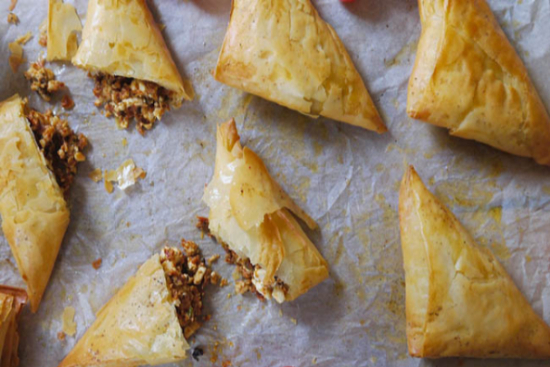
Serves: 12
Preparation time:25 minutes
Cooking time:15 minutes
3/4 cup crumbled feta 4 ounce pkg creamy goat cheese, about 3/4 cup crumbled
3 oil-packed sun-dried tomato halves
1/4 cup finely chopped chives or 2 green onions, thinly sliced
1/4 cup finely chopped fresh oregano or 2 teaspoons dried leaf oregano
1/4 teaspoon freshly ground black pepper
1/4 teaspoon cayenne (optional)
8 sheets phyllo dough
1/2 cup melted butter
Preheat oven to 375F. If feta is packed in liquid, rinse with cold water. Pat dry. Crumble into a measuring cup. Place in a medium-size bowl along with goat cheese. Finely chop tomatoes. They should measure 1/2 cup . Add to cheeses. Stir in chives, oregano, salt, pepper and cayenne, if using, just until evenly distributed.
Place a sheet of phyllo in front of you on a flat dry surface. Keep remainder of phyllo covered with a damp cloth to prevent it from drying out. Lightly brush phyllo with butter. Place another sheet on top. Brush lightly with butter. With a sharp knife, divide sheets into 12 squares by making 2 cuts lengthwise and 3 cuts crosswise. Place a rounded teaspoon of filling on each square. Gather up sides and pinch together above filling. Repeat until phyllo and filling are used up.
Place kisses on a lightly greased baking sheet. Bake in centre of 375F oven until golden and crispy, about 10 minutes. Serve warm.
Place a sheet of phyllo in front of you on a flat dry surface. Keep remainder of phyllo covered with a damp cloth to prevent it from drying out. Lightly brush phyllo with butter. Place another sheet on top. Brush lightly with butter. With a sharp knife, divide sheets into 12 squares by making 2 cuts lengthwise and 3 cuts crosswise. Place a rounded teaspoon of filling on each square. Gather up sides and pinch together above filling. Repeat until phyllo and filling are used up.
Place kisses on a lightly greased baking sheet. Bake in centre of 375F oven until golden and crispy, about 10 minutes. Serve warm.
Appetizer Vegetable and herb orzo salad 
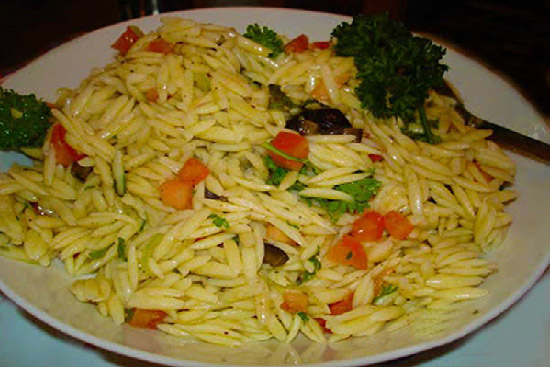
Serves: 8
Preparation time: 15 minutes
Cooking time:15 minutes
For salad: 6 ounces sugar snap peas, trimmed and cut into 3/4-inch
2 2/3 cups orzo
1 1/4 cups cubed seeded tomatoes
3/4 cup cubed seeded peeled cucumber
1/2 cup chopped green onions
1/4 cup chopped fresh parsley
1/4 cup chopped fresh mint
2 teaspoons finely chopped lemon peel
Dressing:
1/4 cup fresh lemon juice
2 teaspoons finely chopped lemon peel
1 teaspoon minced garlic
3/4 cup olive oil
1 head Boston lettuce
Salad:
Bring large pot of salted water to boil. Add snap peas; cook 1 minute. Using slotted spoon transfer beans to strainer. Rinse with cold water and drain. Add orzo to same pot. Boil until tender but still firm to bite. Drain and cool.
Place orzo in large bowl. Mix in snap peas, tomatoes, cucumber, green onions, parsley, mint and lemon peel. Season with salt and pepper.
Dressing:
Combine lemon juice, lemon peel and garlic. Gradually whisk in olive oil. Season to taste with salt and pepper. Pour half of dressing over salad; toss to coat. (Can be made 6 hours ahead. Cover salad and remaining dressing separately and chill. Bring to room temperature before serving.)
Toss salad with enough dressing to coat generously. Season with salt and pepper.
Line serving bowl with lettuce. Mound salad in bowl.
Bring large pot of salted water to boil. Add snap peas; cook 1 minute. Using slotted spoon transfer beans to strainer. Rinse with cold water and drain. Add orzo to same pot. Boil until tender but still firm to bite. Drain and cool.
Place orzo in large bowl. Mix in snap peas, tomatoes, cucumber, green onions, parsley, mint and lemon peel. Season with salt and pepper.
Dressing:
Combine lemon juice, lemon peel and garlic. Gradually whisk in olive oil. Season to taste with salt and pepper. Pour half of dressing over salad; toss to coat. (Can be made 6 hours ahead. Cover salad and remaining dressing separately and chill. Bring to room temperature before serving.)
Toss salad with enough dressing to coat generously. Season with salt and pepper.
Line serving bowl with lettuce. Mound salad in bowl.
Appetizer Zucchini carpaccio salad 
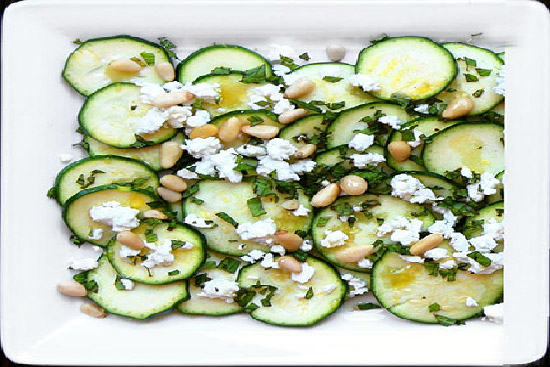
Serves: 4
Preparation time: 15 minutes
4 small zucchinis2 scallions, chopped
2 sun dried tomatoes, chopped
1/4 cup toasted pine nuts, chopped
1/4 cup crumbled feta
pinch of red pepper flakes (optional)
basil & parsley vinaigrette: (this will make extra)
1 cup flat leaf parsley
1 cup basil
1/4 cup olive oil
2 tablespoon wine vinegar
juice of 1/2 small lemon (about 2 tablespoons)
2 garlic cloves, crushed
1 teaspoon honey or agave
salt & pepper to taste
Put dressing ingredients into a food processer and blend until ingredients are combined, but not pureed. Taste and adjust seasonings. Set aside.
Using a mandoline slicer, shave un-peeled zucchinis into thin coins.
Toss zucchini, scallions and a quarter to a half cup of the vinaigrette together– . Adjust seasonings if necessary.
Arrange on a platter and top with sun dried tomatoes, pine nuts, feta and a pinch of red pepper flakes.
Cover leftover dressing and store it at room temperature.
Using a mandoline slicer, shave un-peeled zucchinis into thin coins.
Toss zucchini, scallions and a quarter to a half cup of the vinaigrette together– . Adjust seasonings if necessary.
Arrange on a platter and top with sun dried tomatoes, pine nuts, feta and a pinch of red pepper flakes.
Cover leftover dressing and store it at room temperature.
Appetizer Zucchini carpaccio with pesto, lemon and parmesan 

You can vary with a pesto of arugula, radish tops, or even cilantro. And for a more indulgent version, add a few slivers of toasted walnuts or almonds.
Serves: 4
Juice of 1 lemon
3 tbsp pesto
2 tbsp pine nuts
40g Parmesan cheese
2 tbsp olive oil
Fleur de sel, pepper
Edible flowers (pansies, nasturtiums, borage, etc.) – optional
Serves: 4
Preparation time:10 minutes
2 thin, firm zucchinisJuice of 1 lemon
3 tbsp pesto
2 tbsp pine nuts
40g Parmesan cheese
2 tbsp olive oil
Fleur de sel, pepper
Edible flowers (pansies, nasturtiums, borage, etc.) – optional
Wash the zucchini thoroughly. Using a mandolin or a peeler, slice them lengthwise into very thin strips.
Arrange them attractively on a platter or directly on plates, rolling or folding them to create volume.
Drizzle with lemon juice and olive oil. Season lightly with salt and pepper.
Add a few spoonfuls of pesto on top, scattering them over the top.
Sprinkle with Parmesan shavings and lightly toasted pine nuts.
Finish with the edible flowers for a stunning presentation. Serve chilled.
Arrange them attractively on a platter or directly on plates, rolling or folding them to create volume.
Drizzle with lemon juice and olive oil. Season lightly with salt and pepper.
Add a few spoonfuls of pesto on top, scattering them over the top.
Sprinkle with Parmesan shavings and lightly toasted pine nuts.
Finish with the edible flowers for a stunning presentation. Serve chilled.
Main Asparagus and tomato salad with feta 

This Asparagus and Tomato Salad is easy to make with steamed asparagus, grape tomatoes, creamy feta, fresh herbs and a light dressing. The tarragon gives it a welcome hint of licorice. It can be eaten cold, warm or hot.
Asparagus is popular in the spring, especially around Easter and in the summer. It's peak season is April. This dish makes a great vegetable side dish and pairs perfectly with Easter.
Serves: 4
1 tbsp red wine vinegar
2 tsp Dijon mustard
1/2 tsp salt
1/2 tsp black pepper
1/2 cup olive oil
2 tbsp freshly chopped parsley
1 tsp dried tarragon (use 1 tablespoon if using fresh)
2 lbs asparagus, trimmed - 2 bunches
3 green onions, chopped
1 pint grape tomatoes, halved (551 ml)
3/4 cup feta cheese crumbled
Asparagus is popular in the spring, especially around Easter and in the summer. It's peak season is April. This dish makes a great vegetable side dish and pairs perfectly with Easter.
Serves: 4
Preparation time:10 minutes
Cooking time:10 minutes
1 tbsp balsamic vinegar1 tbsp red wine vinegar
2 tsp Dijon mustard
1/2 tsp salt
1/2 tsp black pepper
1/2 cup olive oil
2 tbsp freshly chopped parsley
1 tsp dried tarragon (use 1 tablespoon if using fresh)
2 lbs asparagus, trimmed - 2 bunches
3 green onions, chopped
1 pint grape tomatoes, halved (551 ml)
3/4 cup feta cheese crumbled
Snap off the woody ends of asparagus where they naturally break when you bend them or cut them off with a knife.
Boil water in a large pot or saucepan with steamer then reduce to simmer, add asparagus, cover with lid and steam asparagus until tender (about 8-10 minutes) *This will depend on your preference.
Use tongs to remove asparagus
In a small bowl, whisk balsamic vinegar, oil, red wine, dijon mustard, salt and pepper together.
Cover and set aside until ready to use.
Arrange cooked asparagus tomatoes on a large platter.
Sprinkle with feta cheese and parsley.
Drizzle with ½ the dressing and serve the remainder on the side *Can be served warm, room temperature or chilled.
????Variations & Substitutions
Tomatoes- you could use cherry tomatoes instead of grape tomatoes
Asparagus -you could use grilled or oven-roasted asparagus instead of steamed
Tarragon- fresh tarragon is ideal, but you can use dried
Feta cheese - you can use regular, light or fat-free feta or use goat cheese
Add-ins- you could also sprinkle on a little parmesan cheese and/or add red onions or green onion
Boil water in a large pot or saucepan with steamer then reduce to simmer, add asparagus, cover with lid and steam asparagus until tender (about 8-10 minutes) *This will depend on your preference.
Use tongs to remove asparagus
In a small bowl, whisk balsamic vinegar, oil, red wine, dijon mustard, salt and pepper together.
Cover and set aside until ready to use.
Arrange cooked asparagus tomatoes on a large platter.
Sprinkle with feta cheese and parsley.
Drizzle with ½ the dressing and serve the remainder on the side *Can be served warm, room temperature or chilled.
????Variations & Substitutions
Tomatoes- you could use cherry tomatoes instead of grape tomatoes
Asparagus -you could use grilled or oven-roasted asparagus instead of steamed
Tarragon- fresh tarragon is ideal, but you can use dried
Feta cheese - you can use regular, light or fat-free feta or use goat cheese
Add-ins- you could also sprinkle on a little parmesan cheese and/or add red onions or green onion
Main Asparagus mimosa 

Serves: 6
Preparation time: 15 minutes
Cooking time:10 minutes
3 pounds fresh green asparagus 2 hard-cooked eggs, peeled
2 tablespoons chopped parsley
1 cup herb-vinaigrette dressing
Peel and trim the asparagus.
Boil 4 quarts of water in a pot. Cook asparagus in boiling water for 5 to 7 minutes or until just tender.
Gently remove asparagus from boiling water and cool in ice cold water. Drain on paper towels, and set aside.
Separate egg yolks and whites. Wash egg whites in cold water. Drain on paper towel and set aside. Finely chop egg yolks; set aside in a small bowl. Chop egg whites and save in a bowl.
Arrange asparagus on a serving platter. Sprinkle egg yolk and egg white and parsley over asparagus.
Serve cold with the herb-vinaigrette.
Boil 4 quarts of water in a pot. Cook asparagus in boiling water for 5 to 7 minutes or until just tender.
Gently remove asparagus from boiling water and cool in ice cold water. Drain on paper towels, and set aside.
Separate egg yolks and whites. Wash egg whites in cold water. Drain on paper towel and set aside. Finely chop egg yolks; set aside in a small bowl. Chop egg whites and save in a bowl.
Arrange asparagus on a serving platter. Sprinkle egg yolk and egg white and parsley over asparagus.
Serve cold with the herb-vinaigrette.
Main Asparagus with cream cheese and prosciutto 
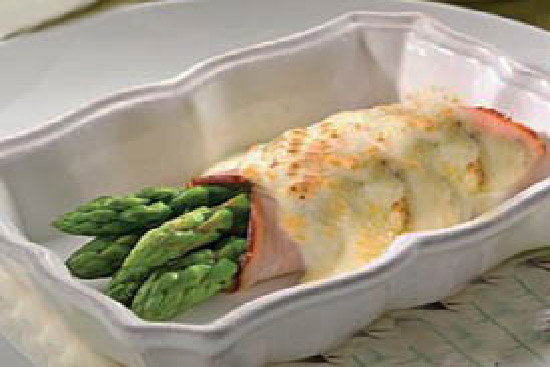
Serves: 6
Preparation time: 15 minutes
Cooking time:10 minutes
24 fresh asparagus spears, cut to 4 inches 4 ounces cream cheese, softened
2 ounces Stilton cheese
1/4 teaspoon minced garlic
to taste, salt and ground black pepper
12 thin slices of prosciutto, cut into halves
Clean and peel asparagus. Cook lightly in salted boiling water or steam until crisp. Plunge in ice cold water.
Preheat oven to 350 degrees.
In a mixing bowl, whisk cream cheese, Stilton cheese, garlic, and salt and pepper to taste.
Spread each half slice of prosciutto with some of the cream cheese mixture. Roll around an asparagus spear. Arrange on a baking sheet.
Bake for about 5 minutes or until heated through.
Preheat oven to 350 degrees.
In a mixing bowl, whisk cream cheese, Stilton cheese, garlic, and salt and pepper to taste.
Spread each half slice of prosciutto with some of the cream cheese mixture. Roll around an asparagus spear. Arrange on a baking sheet.
Bake for about 5 minutes or until heated through.
Main Asparagus with Parma ham and roasted pepper coulis 
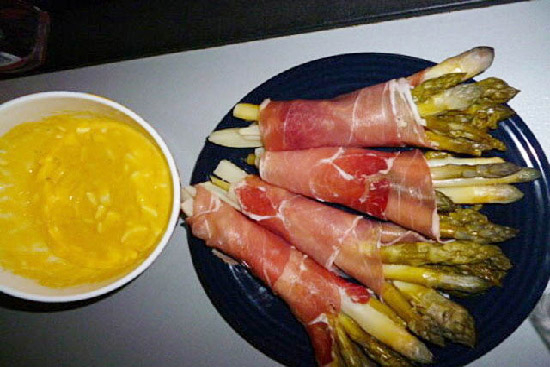
Serves: 6
Preparation time: 30 minutes
Cooking time:12 minutes
2 red bell peppers 5 teaspoons plus 1 teaspoon olive oil
1 teaspoon white wine vinegar
to taste, coarse salt and pepper
36 spears of asparagus
6 thin slices of Parma
4 sheets of phyllo
3/4 cup melted butter
6 teaspoons dry breadcrumbs
1 cup baby arugula leaves
Pepper coulis:
Preheat oven to 375 degrees. Rub peppers with 2 teaspoons olive oil. Place them on a baking sheet and roast for 25 minutes or until almost charred. Remove and place in plastic container with a lid to steam and cool. When cool enough to handle, push off the skins and remove stems and seeds. Place peppers in food processor fitted with metal blade and puree along with the vinegar, 1 teaspoon olive oil, and 1 tablespoon water. Season to taste.
Wash asparagus. with a sharp knife, trim bottoms to make spears of equal length. Place the asparagus in boiling water for 1 minute. Drain and refresh. Pat dry. Toss with 2 teaspoons olive oil. Cut the ham in half lengthwise.
Hold 3 asparagus spears together. Wrap one strip of ham around the center of the asparagus bundle and set aside. Continue making bundles until you have 12.
Carefully lay one sheet of phyllo dough on damp towel. Lightly brush it with some of the melted butter and sprinkle with 1 tablespoon bread crumbs. Butter another sheet and place on top of the crumbled sheet. Using a very sharp knife, carefully cut the phyllo sheets, from top to bottom, into 6 strips. Roll one phyllo strip around the center of an asparagus-ham bundle. continue until you have prepared 6 bundles. Repeat the process with the remaining phyllo sheets, butter, crumbs, and 6 remaining asparagus bundles. Place bundles on baking sheet . Bake for 9 to 12 minutes, or until pastry is golden brown.
Toss arugula leaves with remaining teaspoon of oil. Place a tablespoon or more of pepper puree in center of each plate. Cross 2 asparagus bundles over the puree. Garnish with a few arugula leaves and serve immediately.
Preheat oven to 375 degrees. Rub peppers with 2 teaspoons olive oil. Place them on a baking sheet and roast for 25 minutes or until almost charred. Remove and place in plastic container with a lid to steam and cool. When cool enough to handle, push off the skins and remove stems and seeds. Place peppers in food processor fitted with metal blade and puree along with the vinegar, 1 teaspoon olive oil, and 1 tablespoon water. Season to taste.
Wash asparagus. with a sharp knife, trim bottoms to make spears of equal length. Place the asparagus in boiling water for 1 minute. Drain and refresh. Pat dry. Toss with 2 teaspoons olive oil. Cut the ham in half lengthwise.
Hold 3 asparagus spears together. Wrap one strip of ham around the center of the asparagus bundle and set aside. Continue making bundles until you have 12.
Carefully lay one sheet of phyllo dough on damp towel. Lightly brush it with some of the melted butter and sprinkle with 1 tablespoon bread crumbs. Butter another sheet and place on top of the crumbled sheet. Using a very sharp knife, carefully cut the phyllo sheets, from top to bottom, into 6 strips. Roll one phyllo strip around the center of an asparagus-ham bundle. continue until you have prepared 6 bundles. Repeat the process with the remaining phyllo sheets, butter, crumbs, and 6 remaining asparagus bundles. Place bundles on baking sheet . Bake for 9 to 12 minutes, or until pastry is golden brown.
Toss arugula leaves with remaining teaspoon of oil. Place a tablespoon or more of pepper puree in center of each plate. Cross 2 asparagus bundles over the puree. Garnish with a few arugula leaves and serve immediately.
Main Baked carrot terrine 
Serves: 8
Preparation time: 30 minutes
Cooking time:2 hours
1 pound carrots 1 tablespoon butter
2 cloves garlic, minced
1 onion, chopped
1/2 teaspoon grated lemon rind
1 tablespoon lemon juice
pinch nutmeg
1/2 teaspoon salt
1/2 teaspoon pepper
2 eggs
2/3 cup 2% evaporated milk
Grease 8x4-inch loaf pan.
Line bottom with parchment or waxed paper; grease paper. Cook carrots until softened, drain. Let cool.
In nonstick skillet, melt butter over medium heat; cook garlic and onion, stirring until very soft.
Let cool completely. In food processor or blender, purée onion mixture, carrots, lemon rind. Lemon juice, nutmeg, salt and pepper until smooth; transfer to large bowl.
Whisk together eggs and evaporated milk. Add to carrot mixture, blending well.
Pour into prepared pan, smoothing top. Cut rectangle of parchment to fit directly on top of mixture.
Place loaf pan in large pan. Pour in boiling water to come halfway up side of loaf pan.
Bake in 350 degree oven for about 1 1/4 hours or until center of terrine is firm to the touch and knife inserted in center comes out clean.
Remove loaf pan from water; peel off top paper. Run knife around sides of pan. Let stand 10 minutes.
Line bottom with parchment or waxed paper; grease paper. Cook carrots until softened, drain. Let cool.
In nonstick skillet, melt butter over medium heat; cook garlic and onion, stirring until very soft.
Let cool completely. In food processor or blender, purée onion mixture, carrots, lemon rind. Lemon juice, nutmeg, salt and pepper until smooth; transfer to large bowl.
Whisk together eggs and evaporated milk. Add to carrot mixture, blending well.
Pour into prepared pan, smoothing top. Cut rectangle of parchment to fit directly on top of mixture.
Place loaf pan in large pan. Pour in boiling water to come halfway up side of loaf pan.
Bake in 350 degree oven for about 1 1/4 hours or until center of terrine is firm to the touch and knife inserted in center comes out clean.
Remove loaf pan from water; peel off top paper. Run knife around sides of pan. Let stand 10 minutes.
Main Baked polenta with fontina and gorgonzola 
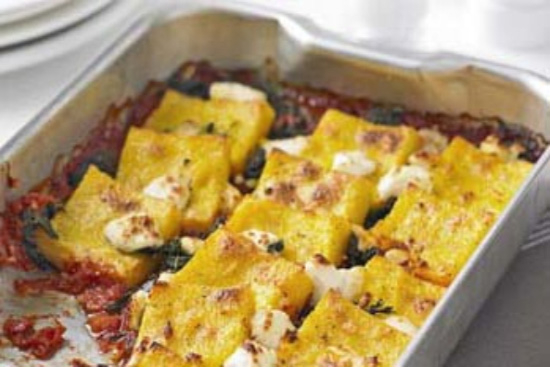
Serves: 6
Preparation time: 20 minutes
Cooking time:40 minutes
For the sauce: 2 pounds Italian tomatoes or canned whole tomatoes, coarsely chopped
1 tablespoon olive oil
1/2 small yellow onion, finely chopped
1 clove garlic, finely chopped
1 bay leaf
4 basil leaves
2 parsley stems
salt and pepper to taste
For the polenta:
1 1/2 cups polenta
8 ounces Fontina cheese, thinly sliced
5 ounces Gorgonzola cheese
1 tablespoon basil, chopped for garnish
For the sauce:
In a medium saucepan, heat the olive oil over medium heat. Add the onion, garlic, bay leaf, basil and parsley, and cook slowly for 3 to 4 minutes. Add the tomatoes. Bring to a boil, and simmer for 15 minutes. Put sauce in a food processor on pulse to chop tomatoes and make sauce smoother. Return to the sauce to the pan, and simmer until medium-thick. Season to taste with salt and pepper and a pinch of sugar to cut the acidity if necessary. This yields about 1 1/2 cups.
While the sauce is cooking, bring 4 1/2 cups water to a boil and add 1 teaspoon salt. Whisk in the polenta in a stream so that lumps do not form. Lower the heat, and simmer 12 to 15 minutes, while stirring with a wooden spoon. Pour polenta into a loaf pan or a 9-by12-inch baking dish, and set it aside to cool. When cold and firm, turn polenta out on a clean surface, and cut into 3-inch squares or diagonal pieces. Preheat the oven to 400 degrees.
Lightly butter individual gratin dishes, spreading a tablespoon of tomato sauce over bottom of dishes. Arrange the polenta and slices of Fontina in overlapping layers.
Spoon the remaining tomato sauce over the layers. Crumble Gorgonzola over the top, season with pepper, and bake the polenta uncovered until cheese is melted. Garnish with fresh basil.
In a medium saucepan, heat the olive oil over medium heat. Add the onion, garlic, bay leaf, basil and parsley, and cook slowly for 3 to 4 minutes. Add the tomatoes. Bring to a boil, and simmer for 15 minutes. Put sauce in a food processor on pulse to chop tomatoes and make sauce smoother. Return to the sauce to the pan, and simmer until medium-thick. Season to taste with salt and pepper and a pinch of sugar to cut the acidity if necessary. This yields about 1 1/2 cups.
While the sauce is cooking, bring 4 1/2 cups water to a boil and add 1 teaspoon salt. Whisk in the polenta in a stream so that lumps do not form. Lower the heat, and simmer 12 to 15 minutes, while stirring with a wooden spoon. Pour polenta into a loaf pan or a 9-by12-inch baking dish, and set it aside to cool. When cold and firm, turn polenta out on a clean surface, and cut into 3-inch squares or diagonal pieces. Preheat the oven to 400 degrees.
Lightly butter individual gratin dishes, spreading a tablespoon of tomato sauce over bottom of dishes. Arrange the polenta and slices of Fontina in overlapping layers.
Spoon the remaining tomato sauce over the layers. Crumble Gorgonzola over the top, season with pepper, and bake the polenta uncovered until cheese is melted. Garnish with fresh basil.
Main Baked salmon fillet with basil sauce 
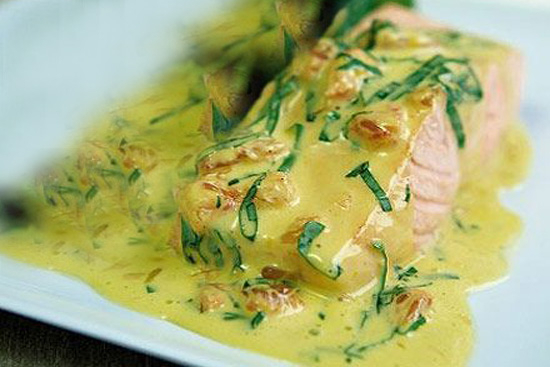
Serves: 6
Preparation time: 15 minutes
Cooking time:20 minutes
6-5-ounces salmon fillet, boneless and skinlessto taste salt and ground white pepper
3 tablespoons olive oil
1 tablespoon shallots, chopped
1 teaspoon garlic, minced
2 cups basil leaves, cut in small strips
1/2 cup dry white wine
1/2 cup heavy cream
Season the salmon fillets with salt and pepper. Heat a saute pan with the oil until hot. Saute the salmon fillets on one side for about 3 minutes. Turn salmon. Reduce the heat to medium and cook salmon for 3 to 5 minutes or until done. Transfer the salmon to a warm platter. Add the shallots and garlic to the pan. Cook over medium heat for a minute. Do not brown. Add the basil leaves and wine to the pan. Simmer to wilt the basil. Stir the cream into the sauce. Simmer to reduce sauce to half. Season to taste.
PRESENTATION
Arrange each salmon fillet on a hot plate. Spoon the sauce over.
PRESENTATION
Arrange each salmon fillet on a hot plate. Spoon the sauce over.
Main Baked shrimp with orzo and feta 
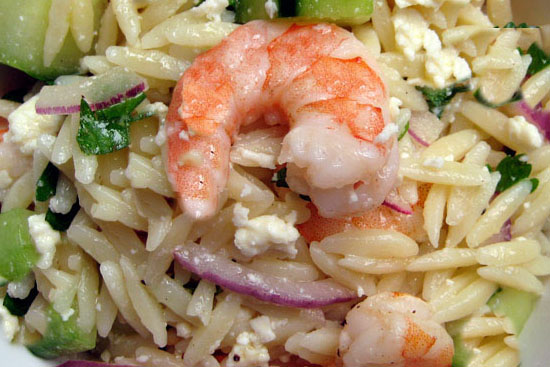
Serves: 6
Preparation time:20 minutes
Cooking time:15 minutes
Kosher saltGood olive oil
3/4 pound orzo pasta (rice-shaped pasta)
1/2 cup freshly squeezed lemon juice
Freshly ground black pepper
2 pounds (16 to 18 count) shrimp, peeled and deveined
3/4 cup minced scallions, white and green parts
3/4 cup chopped fresh dill
1 cup chopped fresh flat-leaf parsley
1 hothouse cucumber, unpeeled, seeded, and medium-diced
1/2 cup small-diced red onion
3/4 pound good feta cheese, large diced
Preheat the oven to 400 degrees F.
Fill a large pot with water, add 1 teaspoon of salt and a tablespoon of oil, and bring the water to a boil. Add the orzo and simmer for 9 to 11 minutes, stirring occasionally, until it's cooked al dente.
Drain and pour into a large bowl.
Whisk together the lemon juice, 1/2 cup olive oil, 2 teaspoons salt and 1 teaspoon of pepper.
Pour over the hot pasta and stir well.
Meanwhile, place the shrimp on a sheet pan, drizzle with olive oil, and sprinkle with salt and pepper. Toss to combine and spread out in a single layer. Bake for 5 to 6 minutes, until the shrimp are cooked through. Don't overcook!
Add the shrimp to the orzo and then add the scallions, dill, parsley, cucumber, onion, 1/2 teaspoon salt, and 1/4 teaspoon pepper. Toss well. Add the feta and stir carefully. Set aside at room temperature for 1 hour to allow the flavors to blend, or refrigerate overnight. If refrigerated, taste again for seasonings and bring back to room temperature before serving.
Fill a large pot with water, add 1 teaspoon of salt and a tablespoon of oil, and bring the water to a boil. Add the orzo and simmer for 9 to 11 minutes, stirring occasionally, until it's cooked al dente.
Drain and pour into a large bowl.
Whisk together the lemon juice, 1/2 cup olive oil, 2 teaspoons salt and 1 teaspoon of pepper.
Pour over the hot pasta and stir well.
Meanwhile, place the shrimp on a sheet pan, drizzle with olive oil, and sprinkle with salt and pepper. Toss to combine and spread out in a single layer. Bake for 5 to 6 minutes, until the shrimp are cooked through. Don't overcook!
Add the shrimp to the orzo and then add the scallions, dill, parsley, cucumber, onion, 1/2 teaspoon salt, and 1/4 teaspoon pepper. Toss well. Add the feta and stir carefully. Set aside at room temperature for 1 hour to allow the flavors to blend, or refrigerate overnight. If refrigerated, taste again for seasonings and bring back to room temperature before serving.
Main Balsamic potato salad 
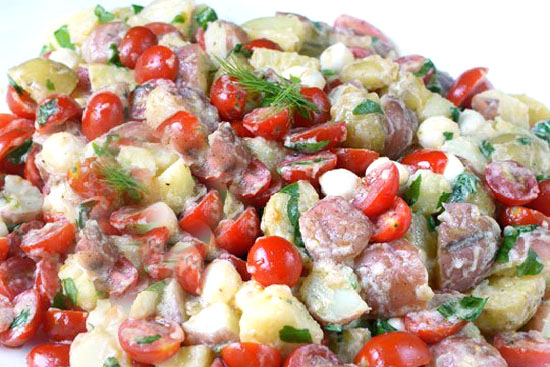
Serves: 6
Preparation time: 10 minutes
Cooking time:15 minutes
3 pounds new little red potatoes 1/2 cup slivered oil-packed sun-dried tomatoes
3 tablespoons capers
1/2 cup balsamic vinegar
1/4 cup olive oil
2 tablespoons sun-dried tomato oil
1 tablespoons Dijon mustard
1 teaspoon salt
1/2 teaspoon pepper
2 tablespoons chopped fresh oregano or basil
Cook potatoes in pot of boiling salted water until tender. Drain and let cool; cut in half. Add tomatoes and capers.
Whisk together vinegar, olive oil, sun dried tomato oil, mustard, salt and pepper; toss with potato mixture.
Let stand for 10 minutes. Sprinkle with oregano.
Whisk together vinegar, olive oil, sun dried tomato oil, mustard, salt and pepper; toss with potato mixture.
Let stand for 10 minutes. Sprinkle with oregano.
Main Bowtie pasta with shrimp and asparagus 
Serves: 4
Preparation time: 20 minutes
Cooking time:20 minutes
5 tablespoon olive oil 2 garlic cloves
8 ounce shrimp, peeled and deveined
1 pound asparagus
1 teaspoon salt
1 teaspoon hot red pepper flakes
1/2 cup vegetable stock
2 tablespoon Italian parsley
10 basil leaves
1 pound farfalle pasta
2 tablespoon Parmigiano-Reggiano cheese
1. Cook the pasta in a large pot of boiling salted water until al dente (firm to the bite), about 8 to 10 minutes.
2. While the pasta is cooking, heat olive oil in a large saute pan and cook the garlic until golden. Add the shrimp and saute for an additional 2 minutes.
3. Remove the shrimp from the pan and add the asparagus, salt, hot red pepper flakes, and vegetable stock. Bring the mixture to a boil and simmer for 3 minutes. Return the shrimp to the pan and add the parsley and basil and stir to combine.
4. Add the well-drained pasta to the sauce and stir over low heat until the pasta is coated with the sauce. Remove the pan from the heat and add the Parmigiano-Reggiano and stir. Serve immediately.
2. While the pasta is cooking, heat olive oil in a large saute pan and cook the garlic until golden. Add the shrimp and saute for an additional 2 minutes.
3. Remove the shrimp from the pan and add the asparagus, salt, hot red pepper flakes, and vegetable stock. Bring the mixture to a boil and simmer for 3 minutes. Return the shrimp to the pan and add the parsley and basil and stir to combine.
4. Add the well-drained pasta to the sauce and stir over low heat until the pasta is coated with the sauce. Remove the pan from the heat and add the Parmigiano-Reggiano and stir. Serve immediately.
Main Braised salmon steaks with fennel and thyme 
Serves: 4
Preparation time: 15 minutes
Cooking time:30 minutes
4 8-ounce salmon steaks 1 pound fennel bulbs
1 tablespoon olive oil
2 tablespoons fresh thyme, chopped
1/4 cup white wine
salt and pepper to taste
Preheat oven to 400 degrees. Rinse salmon in cold water. Pat dry with paper towels. Trim the base and stalks of the fennel bulbs. Cut across into thin slices.
Heat the oil in a medium frying pan. Add the fennel and saute about 5 minutes, until softened. Add one half of the chopped thyme, white wine, salt and pepper, and cook for 2 minutes.
Transfer the fennel to a buttered baking dish.
Arrange the salmon steaks on top, and season with salt and pepper, and the remaining chopped thyme. Cover the fish with foil and bake for 10 to 12 minutes.
PRESENTATION
Transfer salmon steaks to warm plates. Cover with fennel and pan juices. Serve hot.
Heat the oil in a medium frying pan. Add the fennel and saute about 5 minutes, until softened. Add one half of the chopped thyme, white wine, salt and pepper, and cook for 2 minutes.
Transfer the fennel to a buttered baking dish.
Arrange the salmon steaks on top, and season with salt and pepper, and the remaining chopped thyme. Cover the fish with foil and bake for 10 to 12 minutes.
PRESENTATION
Transfer salmon steaks to warm plates. Cover with fennel and pan juices. Serve hot.
Main Brunch strata with crabmeat and asparagus 
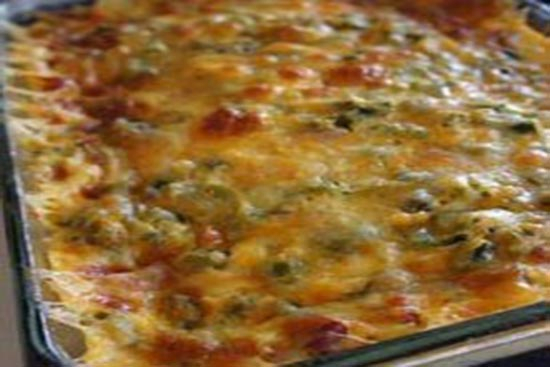
Serves: 12
Preparation time: 15 minutes
Cooking time:1 hour
1/2 cup melted butter 12 slices white bread
2 cups shredded cheddar cheese
12 ounces cooked asparagus, cut into small pieces
6 ounces cooked flaked crabmeat
8 eggs
2 1/2 cups milk
3 tablespoons chopped parsley
1 teaspoon salt
1 teaspoon paprika
1/4 teaspoon pepper
Preheat oven at 350 degrees. Spread butter over one side of each bread slice.
Arrange 6 slices, buttered sides down, in a 13 by 9-inch baking dish. Layer the cheese, asparagus and crab over bread. Place remaining bread slices, buttered sides up, over crab meat.
In a large bowl, combine the remaining ingredients; blend well.
Pour egg mixture evenly over bread.
Bake for 50 minutes to 1 hour.
Arrange 6 slices, buttered sides down, in a 13 by 9-inch baking dish. Layer the cheese, asparagus and crab over bread. Place remaining bread slices, buttered sides up, over crab meat.
In a large bowl, combine the remaining ingredients; blend well.
Pour egg mixture evenly over bread.
Bake for 50 minutes to 1 hour.
Main Bruschetta orzo salad 

Serves: 2
Preparation time: 15 minutes
Cooking time:None
3/4 cup orzo, freshly cooked, rinsed and drained 2 medium Italian tomatoes, cored, seeded and chopped
2 tablespoons chopped black olives
1/2 cup red onion finely diced
1/3 cup fresh basil leaves, chopped
2 1/2 tablespoons balsamic vinegar
2 large garlic cloves, finely chopped
1 1/2 tablespoons olive oil
Combine all ingredients in bowl. Cover and chill at least 1 hour. Serve with toasted garlic bread
Main Cacio e pepe pasta 
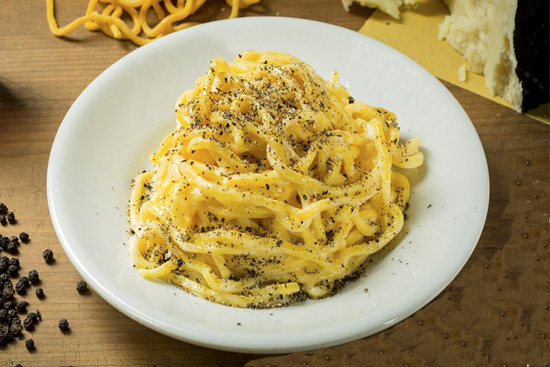
This incredibly simple dish requires only four ingredients and a few minutes of your time.
*
Cacio de Roma is a creamy, semi-soft cheese made from sheep's milk; it's a formaggio di pecora. This Italian gourmet cheese is made in the countryside of Rome and aged about one month. Often this cheese is referred to as a 'caciotta' because it is a small round cheese of approximately 4 pounds. Pecorino Romano cheese is the good substitute for Cacio de Roma.
Serves: 2
3 Tbsp. unsalted butter, cubed, divided
1 tsp. freshly grated black pepper
¾ cup finely grated Grana Padano or Parmesan (Parmigiano-Reggiano)
⅓ cup finely grated Pecorino
1/3 cup cream
Serves: 2
Preparation time:5 minutes
Cooking time:10 minutes
6 oz. pasta (such as bucatini, or spaghetti)3 Tbsp. unsalted butter, cubed, divided
1 tsp. freshly grated black pepper
¾ cup finely grated Grana Padano or Parmesan (Parmigiano-Reggiano)
⅓ cup finely grated Pecorino
1/3 cup cream
Bring 4 quarts water to a boil in a 6-qt. pot. Season with salt; add pasta and cook, stirring occasionally, until al dente (2 minutes before tender). Drain, reserving 1/2 cup pasta cooking water.
Meanwhile, melt 2 Tbsp. butter in a Dutch oven or other large pot or skillet over medium heat. Add pepper and cook, swirling pan, until toasted, about 1 minute.
In a blender, combine grated cheeses with reserved pasta cooking water and cream. Blend to a creamy consistensy.
Add pasta to pot or skillet. Reduce heat to low and add blender creamy cheese mixture, stirring and tossing with tongs until sauce coats the pasta. Transfer pasta to warm bowls and serve immediately.
It's about as creamy cacio e pepe gets.
When you're serving pasta,it's nice to use tongs and then give it a twist so it's got a little personality to it !.
Maybe a little bit more cheese, grate it over top with a grating of pepper.
Meanwhile, melt 2 Tbsp. butter in a Dutch oven or other large pot or skillet over medium heat. Add pepper and cook, swirling pan, until toasted, about 1 minute.
In a blender, combine grated cheeses with reserved pasta cooking water and cream. Blend to a creamy consistensy.
Add pasta to pot or skillet. Reduce heat to low and add blender creamy cheese mixture, stirring and tossing with tongs until sauce coats the pasta. Transfer pasta to warm bowls and serve immediately.
It's about as creamy cacio e pepe gets.
When you're serving pasta,it's nice to use tongs and then give it a twist so it's got a little personality to it !.
Maybe a little bit more cheese, grate it over top with a grating of pepper.
Main Cajun salmon fillet grenobloise with angel hair pasta 
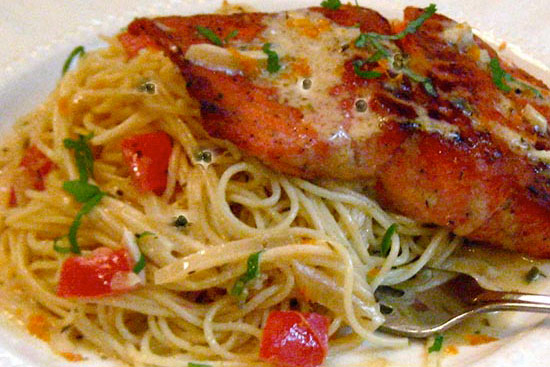
Serves: 6
Preparation time: 20 minutes
Cooking time:20 minutes
2 ounces butter 2 pounds fillet of salmon
1 tablespoon white wine Worcestershire sauce
1/2 teaspoon onion salt
1 teaspoon See recipe for fish seasoning
1 teaspoon dry oregano
2 tablespoons capers
8 ounces angel hair pasta
2 ounces butter
1 cup See recipe for White Butter Sauce
Preheat oven to 450 degrees.
Butter a baking dish large enough for the salmon fillet. Extract all bones from the fillet. Rinse under cold water and pat dry. Place the salmon fillet skin side down in the baking dish. Season with the white wine Worcestershire sauce, onion salt, fish seasoning, and oregano.
Bake the salmon for 10 minutes.
Brown under a hot broiler for 2 to 3 minutes. Sprinkle capers over the fish.
Cook the angel hair pasta in salted boiling water according to the directions on the package.
Drain the pasta, and toss in butter.
PRESENTATION
Divide the salmon fillet into equal portions. Arrange each portion on a hot plate. Top with capers and cooking liquid.
Garnish with the steaming pasta. Serve with the white butter sauce.
Butter a baking dish large enough for the salmon fillet. Extract all bones from the fillet. Rinse under cold water and pat dry. Place the salmon fillet skin side down in the baking dish. Season with the white wine Worcestershire sauce, onion salt, fish seasoning, and oregano.
Bake the salmon for 10 minutes.
Brown under a hot broiler for 2 to 3 minutes. Sprinkle capers over the fish.
Cook the angel hair pasta in salted boiling water according to the directions on the package.
Drain the pasta, and toss in butter.
PRESENTATION
Divide the salmon fillet into equal portions. Arrange each portion on a hot plate. Top with capers and cooking liquid.
Garnish with the steaming pasta. Serve with the white butter sauce.
Main Calzones 
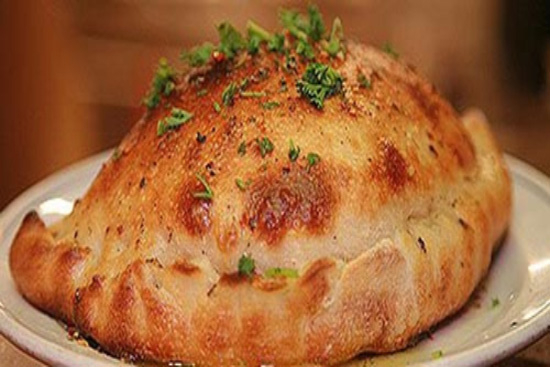
Serves: 8
Preparation time: 35 minutes
Cooking time:50 minutes
1/3 cup diced peeled eggplant 2 cups chopped onions
1 1/2 cups diced mushrooms
1 1/2 cups diced zucchini
1 cup diced red peppers
to taste salt and pepper
1 teaspoon olive oil
1 cup feta cheese or chèvre
1/2 cup chopped fresh basil
1 batch bread dough for calzones
1 egg white
Preheat oven to 425 degrees. Combine in a large bowl, diced peeled eggplant, chopped onion, diced mushrooms, diced zucchini, diced red pepper, salt and pepper. Toss together with olive oil.
Bake at 425 degree F. on baking sheet for 45 minutes stirring every 15 minutes or till soft. Spoon back in bowl.
Mix in crumbled feta cheese or chèvre, and chopped fresh basil. Roll out bread dough to a thickness of about 1/4 inch. Cut into 7-inch circles. Spoon 1/2 cup of the vegetable mixture over circles.
Brush edges of dough with egg white. Fold dough into turnovers. Seal and brush with egg white.
Bake till golden. Mixture can also be used for pizza or for pasta.
Bake at 425 degree F. on baking sheet for 45 minutes stirring every 15 minutes or till soft. Spoon back in bowl.
Mix in crumbled feta cheese or chèvre, and chopped fresh basil. Roll out bread dough to a thickness of about 1/4 inch. Cut into 7-inch circles. Spoon 1/2 cup of the vegetable mixture over circles.
Brush edges of dough with egg white. Fold dough into turnovers. Seal and brush with egg white.
Bake till golden. Mixture can also be used for pizza or for pasta.
Main Campanelle pasta with hen of the woods mushrooms 
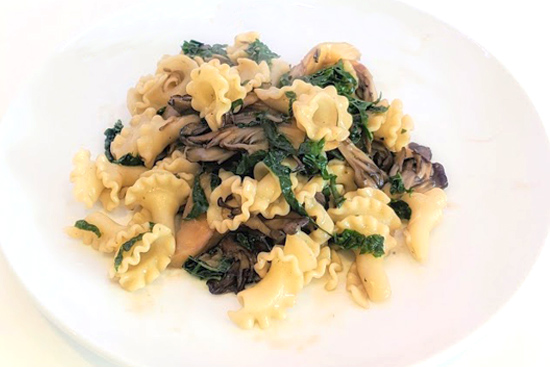
Campanelle is a type of pasta that is cone shaped with ruffled edges (aka Gigli or campanelle pasta and as riccioli). It literally means “little bells.
Campanelle noodles are ideal for dishes with special sauces as the curls in the recipe hold the sauce for a perfect dish.
Hen of the Woods Mushrooms have a dense, meaty texture and savory flavor.
Serves: 4
• 1 tablespoon olive oil
3 cloves garlic minced
12 ounces Hen of the Woods Mushrooms sliced
¼ cup white wine, vegetable broth, or chicken broth
1 cup heavy cream
3 tablespoons fresh parmesan cheese divided
1 teaspoon lemon zest
1 tablespoon fresh parsley chopped optional
Serves: 4
Preparation time: 20 minutes
Cooking time:20 minutes
• 12 ounces campanelle• 1 tablespoon olive oil
3 cloves garlic minced
12 ounces Hen of the Woods Mushrooms sliced
¼ cup white wine, vegetable broth, or chicken broth
1 cup heavy cream
3 tablespoons fresh parmesan cheese divided
1 teaspoon lemon zest
1 tablespoon fresh parsley chopped optional
1. Heat olive oil over medium high heat and cook garlic and mushrooms until mushrooms are tender.
2. Stir in wine (or broth) and cook until wine has almost evaporated. Add heavy cream and simmer 5 minutes.
3. Meanwhile, cook pasta according to package directions (do not rinse).
4. Remove from heat and stir in parmesan cheese, and lemon zest until smooth.
5. Toss with pasta. Top with parsley and extra parmesan cheese if desired.
2. Stir in wine (or broth) and cook until wine has almost evaporated. Add heavy cream and simmer 5 minutes.
3. Meanwhile, cook pasta according to package directions (do not rinse).
4. Remove from heat and stir in parmesan cheese, and lemon zest until smooth.
5. Toss with pasta. Top with parsley and extra parmesan cheese if desired.
Main Cannellonis 
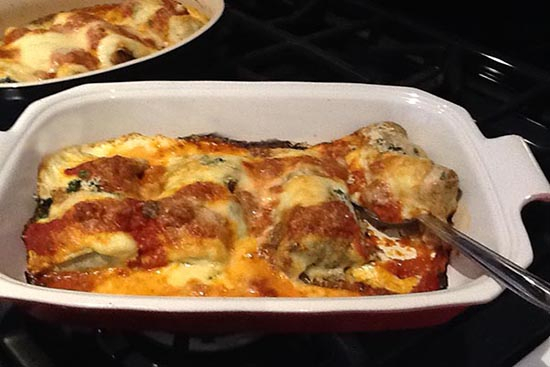
Serves: 6
Preparation time: 30 minutes
Cooking time:40 minutes
2 tablespoons olive oil 1/2 cup onion, chopped
1/4 cup parsley, chopped
1 teaspoon minced garlic
10 ounces spinach, cooked
2 tablespoons butter
1 pound ground beef, lean
2 tablespoons parmesan, grated
2 eggs
1 teaspoon oregano
1/2 teaspoon salt
1/4 teaspoon black pepper, ground
12 crêpes (see recipe)
2 cups cream sauce (see recipe)
1 cup marinara sauce
2 tablespoons Parmesan cheese
Preheat oven to 375 degrees.
Heat 1 tablespoon of oil in a sauté pan. Add onion, garlic and parsley and cook over medium heat for 3 to 5 minutes. Do not brown. Add chopped cooked spinach.
In a skillet, brown ground beef in remaining olive oil. Chop in a processor. Add grated Parmesan, eggs, oregano, salt and pepper to taste. Blend in the spinach mixture.
Divide filling in crêpes. Roll to enclose filling.
Coat the bottom of a baking dish with marinara sauce. Arrange stuffed crêpes in baking dish.
Spoon the cream sauce and tomato sauce over crêpes.
Sprinkle with parmesan.
Bake for 20 to 25 minutes or until brown.
Heat 1 tablespoon of oil in a sauté pan. Add onion, garlic and parsley and cook over medium heat for 3 to 5 minutes. Do not brown. Add chopped cooked spinach.
In a skillet, brown ground beef in remaining olive oil. Chop in a processor. Add grated Parmesan, eggs, oregano, salt and pepper to taste. Blend in the spinach mixture.
Divide filling in crêpes. Roll to enclose filling.
Coat the bottom of a baking dish with marinara sauce. Arrange stuffed crêpes in baking dish.
Spoon the cream sauce and tomato sauce over crêpes.
Sprinkle with parmesan.
Bake for 20 to 25 minutes or until brown.
Main Caprese pasta salad 
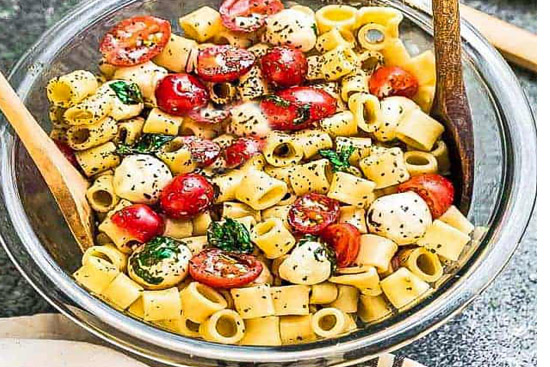
The traditional flavors of caprese, fresh mozzarella, basil, and tomato, are wonderfully represented in caprese pasta salad. Perfect for picnics, or a light summer dinner.
Serves: 6
8 oz. container fresh mozzarella pearls, drained and patted dry
2 pints grape tomatoes, halved or quartered
1 cup thinly sliced red onions (see note)
1/2 cup white balsamic vinegar (see note)
1/2 cup olive oil
1 teaspoon salt, or more to taste
1/2 teaspoon coarse ground black pepper
½ teaspoon garlic powder
1 cup minced fresh basil
Balsamic glaze, optional
Serves: 6
Preparation time: 30 minutes
Cooking time:15 minutes
16 oz. box dry pasta (mini penne)8 oz. container fresh mozzarella pearls, drained and patted dry
2 pints grape tomatoes, halved or quartered
1 cup thinly sliced red onions (see note)
1/2 cup white balsamic vinegar (see note)
1/2 cup olive oil
1 teaspoon salt, or more to taste
1/2 teaspoon coarse ground black pepper
½ teaspoon garlic powder
1 cup minced fresh basil
Balsamic glaze, optional
Bring pot of salted water to boil. Cook pasta to al dente as directed on package directions. In colander set in sink, drain, rinse with cold water, drain well.
Meanwhile make the dressing. In a small bowl or measuring cup, whisk together vinegar, olive oil, salt, pepper, and garlic powder.
In large bowl, combine pasta, mozzarella, tomatoes, and drained onions. Add one half of the dressing; stir well. Refrigerate until ready to serve.
Right before serving, add the remaining dressing and the fresh basil; stir well. Add more salt and pepper if needed.
If desired, garnish with a drizzle of balsamic glaze and basil leaves.
Notes
Try a different variety of tomato. Diced whole tomatoes are good, too.
Choose your favorite pasta. Any bite-size pasta will be fine. Use whole wheat or gluten-free pasta or make it with tortellini.
Add grilled chicken, pepperoni, or diced ham.
Add diced red or green bell peppers, kalamata olives, finely diced zucchini or cucumber, spinach, or another veggie of your choice.
Substitute bottled dressing instead of making your own balsamic vinaigrette.
Meanwhile make the dressing. In a small bowl or measuring cup, whisk together vinegar, olive oil, salt, pepper, and garlic powder.
In large bowl, combine pasta, mozzarella, tomatoes, and drained onions. Add one half of the dressing; stir well. Refrigerate until ready to serve.
Right before serving, add the remaining dressing and the fresh basil; stir well. Add more salt and pepper if needed.
If desired, garnish with a drizzle of balsamic glaze and basil leaves.
Notes
Try a different variety of tomato. Diced whole tomatoes are good, too.
Choose your favorite pasta. Any bite-size pasta will be fine. Use whole wheat or gluten-free pasta or make it with tortellini.
Add grilled chicken, pepperoni, or diced ham.
Add diced red or green bell peppers, kalamata olives, finely diced zucchini or cucumber, spinach, or another veggie of your choice.
Substitute bottled dressing instead of making your own balsamic vinaigrette.
Main Caprese portobello mushrooms 
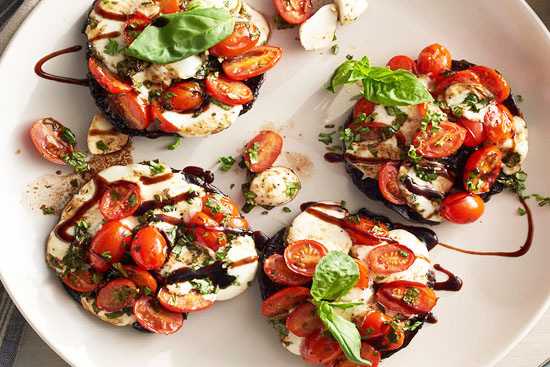
Serves: 4
Preparation time:25 minutes
Cooking time:35 minutes
3 tablespoons extra-virgin olive oil, divided1 medium clove garlic, minced
½ teaspoon salt, divided
½ teaspoon ground pepper, divided
4 portobello mushroom caps (about 1 lb), gills removed
1 cup cherry tomatoes, sliced
½ cup fresh mozzarella pearls, drained and patted dry
½ cup thinly sliced fresh basil
2 teaspoons balsamic vinegar
Preheat oven to 400 degrees F.
Combine 2 tablespoons oil, garlic, 1/4 teaspoon salt and 1/4 teaspoon pepper in a small bowl.
Brush and coat mushrooms all over with the oil mixture. Place on a large rimmed baking sheet and bake until the mushrooms are mostly soft, about 10 minutes.
Meanwhile, stir tomatoes, mozzarella, basil and the remaining 1/4 teaspoon salt, 1/4 teaspoon pepper and 1 tablespoon oil together in a medium bowl.
Once the mushrooms have softened, remove from the oven and fill with the tomato mixture. Bake until the cheese is fully melted and the tomatoes have wilted, about 12 to 15 minutes more.
Drizzle each mushroom with 1/2 teaspoon vinegar and serve.
Combine 2 tablespoons oil, garlic, 1/4 teaspoon salt and 1/4 teaspoon pepper in a small bowl.
Brush and coat mushrooms all over with the oil mixture. Place on a large rimmed baking sheet and bake until the mushrooms are mostly soft, about 10 minutes.
Meanwhile, stir tomatoes, mozzarella, basil and the remaining 1/4 teaspoon salt, 1/4 teaspoon pepper and 1 tablespoon oil together in a medium bowl.
Once the mushrooms have softened, remove from the oven and fill with the tomato mixture. Bake until the cheese is fully melted and the tomatoes have wilted, about 12 to 15 minutes more.
Drizzle each mushroom with 1/2 teaspoon vinegar and serve.
Main Carrot gnocchi 

Serves: 2
Preparation time: 40 minutes
Cooking time:30 minutes
1/2 pound carrots 1 teaspoon finely chopped onion
3 teaspoons butter
1 cup Parmigiano-reggiano cheese
3 teaspoons flour
1 large egg yolk
salt, pepper, and nutmeg to taste
3 teaspoons chopped fresh chives
Preheat oven to 400 degrees.
Peel and slice carrots. Boil until tender. Drain.
In a medium skillet, cook the onion in 1 tablespoon butter, over moderate heat, stirring until pale gold.
Add carrots, and cook for 5 minutes while stirring occasionally.
Transfer the carrots to a food processor, and puree until smooth. Transfer the puree to a bowl. Add 3 tablespoons of the cheese, the flour and egg yolk, and season with salt, pepper, and nutmeg; mix well.
Bring a wide shallow saucepan of water to a boil and add 1 tablespoon salt. Prepare a bowl of ice cold water. Shape the carrot mixture into ovals, using two soup spoons, scooping a portion between the spoons.
Slide 4 of the gnocchi at the time into the boiling water and cook just until they rise to the surface, about a minute or less.
When the gnocchi are done, transfer to the cold water.
Lightly butter a baking dish large enough to hold the gnocchi in a layer without crowding.
Drain the gnocchi and arrange them in the prepared baking baking dish.
Sprinkle with remaining cheese and butter. Bake for 10 minutes. Sprinkle with chives and serve at once.
Peel and slice carrots. Boil until tender. Drain.
In a medium skillet, cook the onion in 1 tablespoon butter, over moderate heat, stirring until pale gold.
Add carrots, and cook for 5 minutes while stirring occasionally.
Transfer the carrots to a food processor, and puree until smooth. Transfer the puree to a bowl. Add 3 tablespoons of the cheese, the flour and egg yolk, and season with salt, pepper, and nutmeg; mix well.
Bring a wide shallow saucepan of water to a boil and add 1 tablespoon salt. Prepare a bowl of ice cold water. Shape the carrot mixture into ovals, using two soup spoons, scooping a portion between the spoons.
Slide 4 of the gnocchi at the time into the boiling water and cook just until they rise to the surface, about a minute or less.
When the gnocchi are done, transfer to the cold water.
Lightly butter a baking dish large enough to hold the gnocchi in a layer without crowding.
Drain the gnocchi and arrange them in the prepared baking baking dish.
Sprinkle with remaining cheese and butter. Bake for 10 minutes. Sprinkle with chives and serve at once.
Main Cauliflower and pasta 
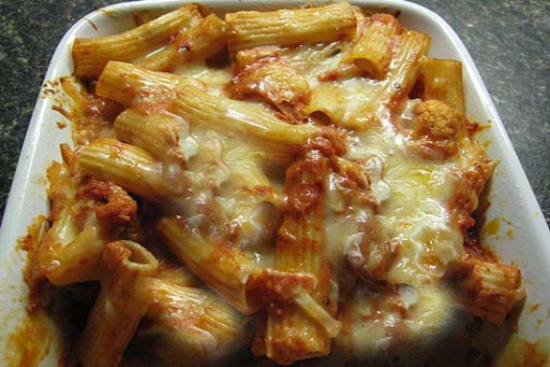
Serves: 4
Preparation time: 40 minutes
Cooking time:20 minutes
1/2 cup pine nuts 1/2 cup golden raisins
3 tablespoons olive oil
4 cloves garlic, peeled and minced
1 medium head cauliflower, rinsed and trimmed to 1-inch pieces
1/2 teaspoon red-pepper flakes
7 anchovy fillets, minced
3 tablespoons capers
1 cup white wine
coarse salt and freshly ground black pepper to taste
1 pound dried rigatoni
10 fresh basil leaves, very thinly sliced
roasted pepper, for garnish (recipe follows)
1. Heat a large skillet over medium-high heat.
Add pine nuts, and toast, stirring frequently until golden brown, about 5 minutes. Set aside in a small bowl.
2. Place raisins in a small bowl. Cover with 1 cup warm water. Set aside to plump, about 10 minutes.
3. Heat olive oil in the same large skillet over medium-low heat. Sauté garlic and cauliflower until golden, about 5 minutes. Add pepper flakes, anchovies, capers, and wine. Simmer 2 to 3 minutes. Meanwhile, drain raisins, discarding water. Add raisins; season with salt and black pepper. Cook, covered, 10 to 12 minutes, until cauliflower is fork-tender. Uncover, and let liquid reduce slightly over high heat, 1 to 2 minutes.
4. Meanwhile, cook rigatoni in salted boiling water until just tender, about 10 minutes or following label instructions. Drain; toss into warm cauliflower mixture. Just before serving, toss pasta with basil and pine nuts. Garnish with roasted pepper.
ROASTED PEPPER
1 yellow or red bell pepper.
Heat a gas burner to high. Place pepper over flame. Roast until blackened all over, turning as necessary. Wrap pepper in a paper towel, enclosing completely. Let steam for 2 minutes. Unwrap, and peel blackened skin from pepper, using a paper towel. Discard skin. Stem and seed pepper.
Add pine nuts, and toast, stirring frequently until golden brown, about 5 minutes. Set aside in a small bowl.
2. Place raisins in a small bowl. Cover with 1 cup warm water. Set aside to plump, about 10 minutes.
3. Heat olive oil in the same large skillet over medium-low heat. Sauté garlic and cauliflower until golden, about 5 minutes. Add pepper flakes, anchovies, capers, and wine. Simmer 2 to 3 minutes. Meanwhile, drain raisins, discarding water. Add raisins; season with salt and black pepper. Cook, covered, 10 to 12 minutes, until cauliflower is fork-tender. Uncover, and let liquid reduce slightly over high heat, 1 to 2 minutes.
4. Meanwhile, cook rigatoni in salted boiling water until just tender, about 10 minutes or following label instructions. Drain; toss into warm cauliflower mixture. Just before serving, toss pasta with basil and pine nuts. Garnish with roasted pepper.
ROASTED PEPPER
1 yellow or red bell pepper.
Heat a gas burner to high. Place pepper over flame. Roast until blackened all over, turning as necessary. Wrap pepper in a paper towel, enclosing completely. Let steam for 2 minutes. Unwrap, and peel blackened skin from pepper, using a paper towel. Discard skin. Stem and seed pepper.
Main Chicken breasts in vermouth 
Serves: 4
Preparation time: 15 minutes
Cooking time:30 minutes
4 boneless, skinless chicken breast halves2 Tbsp olive oil
1 clove garlic, minced
2 shallots, minced
¾ cup dry vermouth
½ pint sliced mushrooms
1 cup whipping cream
Salt and freshly ground pepper to taste
4 Tbsp flat, Italian parsley, chopped
Preheat oven to 200˚F.
In a medium sauté pan over medium flame, heat oil with garlic, being careful not to scorch the garlic. Sauté breast halves in the oil until browned on both sides (about 7 minutes per side for thick breasts)
Remove breasts to an ovenproof serving dish, keeping as much of the oil in the sauté pan as possible. Keep breasts warm in the oven while you prepare the cream sauce.
Add the shallot and sauté until softened and turning golden brown. Add the vermouth and deglaze the pan, scraping brown pits from the side of the pan. simmer until reduced by about half. Add mushrooms and quickly heat through. Pour in cream and bring to a boil and allow to thicken. Reduce the heat and season with salt and pepper.
Pour the sauce over the chicken, sprinkle parsley over the sauce and serve.
In a medium sauté pan over medium flame, heat oil with garlic, being careful not to scorch the garlic. Sauté breast halves in the oil until browned on both sides (about 7 minutes per side for thick breasts)
Remove breasts to an ovenproof serving dish, keeping as much of the oil in the sauté pan as possible. Keep breasts warm in the oven while you prepare the cream sauce.
Add the shallot and sauté until softened and turning golden brown. Add the vermouth and deglaze the pan, scraping brown pits from the side of the pan. simmer until reduced by about half. Add mushrooms and quickly heat through. Pour in cream and bring to a boil and allow to thicken. Reduce the heat and season with salt and pepper.
Pour the sauce over the chicken, sprinkle parsley over the sauce and serve.
Main Chicken breasts parma 
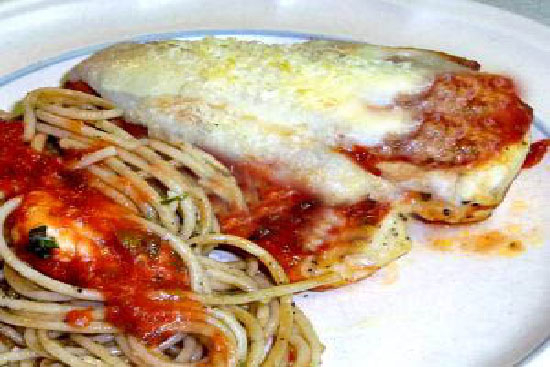
This is a quick, easy, light Italian-American chicken Parmesan recipe.To make it even faster, use your favorite store-bought tomato sauce.
Serves: 4
2 teaspoons olive oil
1/4 cup finely chopped onion
1/4 cup finely chopped green pepper
3 large garlic cloves, minced
1 can (14.5 ounces) whole tomatoes, preferably no salt added, crushed
1 can (8 ounces) tomato sauce
1 teaspoon chopped oregano
2 tablespoons chopped fresh basil
1 tablespoon chopped fresh parsley
Salt and pepper to taste
Chicken
4 boneless, skinless chicken breasts, about 4 ounces each
Salt and pepper to taste
1 tablespoon olive oil
Thinly sliced asiago or provolone cheese, about 2 ounces
Freshly grated Parmesan or Romano cheese
4 cups cooked pasta
Serves: 4
Preparation time: 15 minutes
Cooking time:15 minutes
Sauce:2 teaspoons olive oil
1/4 cup finely chopped onion
1/4 cup finely chopped green pepper
3 large garlic cloves, minced
1 can (14.5 ounces) whole tomatoes, preferably no salt added, crushed
1 can (8 ounces) tomato sauce
1 teaspoon chopped oregano
2 tablespoons chopped fresh basil
1 tablespoon chopped fresh parsley
Salt and pepper to taste
Chicken
4 boneless, skinless chicken breasts, about 4 ounces each
Salt and pepper to taste
1 tablespoon olive oil
Thinly sliced asiago or provolone cheese, about 2 ounces
Freshly grated Parmesan or Romano cheese
4 cups cooked pasta
To make the sauce, heat the olive oil in a medium saucepan over medium-high heat. Add the onions and peppers and sauté until softened, about 5 minutes. Add the garlic and sauté another minute. Add the tomatoes, tomato sauce, and seasonings. Stir well. Partially cover and simmer over low heat until slightly thickened, about 20 minutes. Remove from heat until use.
Meanwhile, prepare the chicken. Preheat the oven to 375° F. Season the chicken on both sides with salt and pepper. Heat the 2 tablespoons olive oil in a large oven-proof skillet over medium-high heat. Add the chicken breasts and brown on both sides, about 3 minutes per side. Remove the chicken and drain any excess oil from the pan. Place just enough of the sauce in the pan to cover the bottom. Add the chicken breasts in a single layer. Spread the tops with a little sauce. Place a thin layer of the sliced cheese on top of each breast, then sprinkle with the Parmesan or Romano cheese. Place in the oven and bake until the chicken is cooked, about 15 minutes depending on the thickness. Place on individual serving dishes; pass sauce and grated cheese separately. Extra sauce can be spooned on a pasta side dish.
Heat the pasta and serve with chicken
Meanwhile, prepare the chicken. Preheat the oven to 375° F. Season the chicken on both sides with salt and pepper. Heat the 2 tablespoons olive oil in a large oven-proof skillet over medium-high heat. Add the chicken breasts and brown on both sides, about 3 minutes per side. Remove the chicken and drain any excess oil from the pan. Place just enough of the sauce in the pan to cover the bottom. Add the chicken breasts in a single layer. Spread the tops with a little sauce. Place a thin layer of the sliced cheese on top of each breast, then sprinkle with the Parmesan or Romano cheese. Place in the oven and bake until the chicken is cooked, about 15 minutes depending on the thickness. Place on individual serving dishes; pass sauce and grated cheese separately. Extra sauce can be spooned on a pasta side dish.
Heat the pasta and serve with chicken
Main Chicken breasts veronique 
Serves: 4
Preparation time: 15 minutes
Cooking time:20 minutes
4 chicken breasts, boned, skinned to taste salt and black pepper
2 tablespoons all purpose flour
4 tablespoons butter
2 cups dry white wine
2 tablespoons fresh lemon juice
2 tablespoons slivered almonds
1/2 pound seedless green grapes, washed, stems removed, and halved lengthwise
1.Season the chicken breasts with a mixture of salt and pepper and flour.
2. Melt the butter in a sauté pan or heavy skillet over medium high heat. Add the chicken breasts and sauté for 2 to 3 minutes.
3. Add the wine and lemon juice, lower the heat, and simmer for 8 to 10 minutes, or until the breasts are tender. Add the almonds and grapes for the last minute.
4. Transfer the chicken to individual plates and spoon the sauce and grapes over each serving.
2. Melt the butter in a sauté pan or heavy skillet over medium high heat. Add the chicken breasts and sauté for 2 to 3 minutes.
3. Add the wine and lemon juice, lower the heat, and simmer for 8 to 10 minutes, or until the breasts are tender. Add the almonds and grapes for the last minute.
4. Transfer the chicken to individual plates and spoon the sauce and grapes over each serving.
Main Chicken primavera 
Serves: 4
Preparation time: 30 minutes
Cooking time:25 minutes
1/2 cup chicken stock 1/3 cup oil
2 tablespoons soy sauce
2 cloves minced garlic
1 teaspoon cornstarch
1/2 teaspoon ground ginger
1/4 teaspoon dried chilies
4 chicken breasts
4 cups Broccoli florets
1 red pepper
1 medium chopped onion
12 ounces egg noodles
salt and black pepper to taste .
Combine chicken stock, half of oil, soy sauce, garlic, cornstarch, ginger and chilies.
Skin and bone chicken breasts. Place in mixture. Stir to coat evenly. Set aside.
Cut red pepper into strips. Heat remaining oil in a skillet. Drain chicken breasts and brown on both sides. Cook pasta according to standard directions.
Transfer chicken to a warm platter. Add vegetables to skillet. Cook until tender.
Pour soy mixture over vegetables. Stir until sauce thickens. Season to taste with salt and pepper. Toss drained noodles in sauce. Place chicken breasts on top and serve hot
Skin and bone chicken breasts. Place in mixture. Stir to coat evenly. Set aside.
Cut red pepper into strips. Heat remaining oil in a skillet. Drain chicken breasts and brown on both sides. Cook pasta according to standard directions.
Transfer chicken to a warm platter. Add vegetables to skillet. Cook until tender.
Pour soy mixture over vegetables. Stir until sauce thickens. Season to taste with salt and pepper. Toss drained noodles in sauce. Place chicken breasts on top and serve hot
Main Chicken provencale 
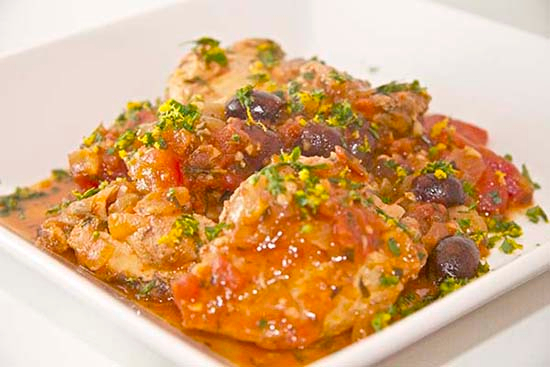
Serves: 4
Preparation time: 20 minutes
Cooking time:40 minutes
1 3-pound chicken, cut into 8 serving pieces 1 teaspoon salt
1/2 teaspoon pepper
2 tablespoons olive oil
1 tablespoon chopped garlic
1/4 cup chopped onion
1 teaspoon rosemary
1/2 teaspoon thyme
1/2 pound small mushrooms
1 cup peeled, seeded, chopped tomatoes
1/2 cup dry white wine
1/2 cup chicken bouillon
4 tablespoons chopped fresh parsley or basil
Sprinkle the chicken with salt and pepper.
Heat the oil in a heavy skillet and add the chicken, skin side down. Cook for 10 minute, or until golden brown. Turn the pieces. Add the garlic, onion, rosemary, thyme and mushrooms. Cook, stirring, for another 5 minutes.
Pour off the fat in the pan and add tomatoes, wine and bouillion. Scrape the bottom of the pan with a spatula. Simmer, uncovered, for 10 minutes. Thicken the sauce by reducing it briefly over high heat. Add the parsley or basil and serve.
Heat the oil in a heavy skillet and add the chicken, skin side down. Cook for 10 minute, or until golden brown. Turn the pieces. Add the garlic, onion, rosemary, thyme and mushrooms. Cook, stirring, for another 5 minutes.
Pour off the fat in the pan and add tomatoes, wine and bouillion. Scrape the bottom of the pan with a spatula. Simmer, uncovered, for 10 minutes. Thicken the sauce by reducing it briefly over high heat. Add the parsley or basil and serve.
Main Chicken salad with pasta and asparagus 
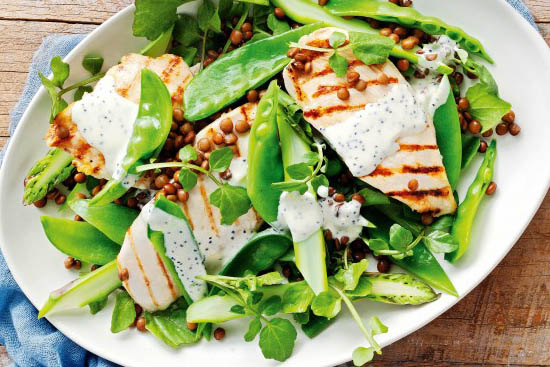
Serves: 10
Preparation time: 40 minutes
Cooking time:1 hour
Oven-Poached Chicken: 1 4 to 5 pound roasting chicken
1 1/2 cups chicken stock
1/2 cup dry white wine
1 bay leaf
1 teaspoon dried tarragon
1 teaspoon dried thyme
Salad:
1 pound rotini pasta
1 pound asparagus
1/2 pound snow peas, trimmed
1 red pepper, seeded and sliced
1/2 cup unblanched almonds, toasted
Basil-Tarragon Dressing:
1/2 cup chopped onion
2 tablespoons white sugar
2 tablespoons chopped fresh basil
2 tablespoons chopped fresh tarragon
1 clove garlic, minced
1 cup canola oil
1/2 cup white wine vinegar
1 1/2 teaspoons salt
1/2 teaspoon pepper
Place chicken in large roasting pan. Combine chicken stock, wine, bay leaf, tarragon and thyme; pour over chicken, cover with foil and bake in a 375 degree oven until drumsticks move easily and liquid runs clear.
Remove from pan and cool completely. Remove all meat from chicken and cut into bite size pieces. Cover and refrigerate up to 24 hours. Cook pasta until al dente. Drain and rinse under cold running water. Break off tough ends of asparagus. Cook in boiling water until tender-crisp. Add snow peas to asparagus for 30 seconds. Drain vegetables and rinse under cold running water. Cut asparagus into bite-size pieces; add asparagus and snow peas to chicken, along with red pepper and almonds.
In food processor, combine onion, parsley, sugar, basil, tarragon and garlic; process until finely chopped. Add oil, vinegar, salt and pepper; process until creamy. Add dressing to salad and toss well.
Remove from pan and cool completely. Remove all meat from chicken and cut into bite size pieces. Cover and refrigerate up to 24 hours. Cook pasta until al dente. Drain and rinse under cold running water. Break off tough ends of asparagus. Cook in boiling water until tender-crisp. Add snow peas to asparagus for 30 seconds. Drain vegetables and rinse under cold running water. Cut asparagus into bite-size pieces; add asparagus and snow peas to chicken, along with red pepper and almonds.
In food processor, combine onion, parsley, sugar, basil, tarragon and garlic; process until finely chopped. Add oil, vinegar, salt and pepper; process until creamy. Add dressing to salad and toss well.
Main Chicken with endive radicchio and balsamic vinegar glaze 
Serves: 4
Preparation time: 30 minutes
Cooking time:40 minutes
3 tablespoons olive oil 4 skinless boneless chicken breast halves
1 large red onion, cut into 1/2 inch thick slices, separated into rings
1 teaspoon chopped fresh oregano or 1/2 teaspoon dried
6 medium size heads Belgian endive, trimmed, halved lengthwise
1 medium size head radicchio, cut into 8 wedges
1 tablespoon dark brown sugar
1/2 cup balsamic vinegar
chopped fresh parsley
Heat 1 tablespoon oil in heavy large skillet over medium high heat. Season chicken with salt and pepper. Add to skillet; sauté until cooked through, about 6 minutes per side.
Transfer chicken to platter (do not clean skillet). Tent chicken with foil.
Heat 2 tablespoons oil in same skillet over medium high heat. Add onion and oregano; sauté until onion softens, about 10 minutes. Using tongs, transfer onion to plate. Reduce heat to medium.
Add endive to skillet and sauté until beginning to brown, turning occasionally, about 5 minutes. Add radicchio.
Cover skillet and cook until radicchio begins to brown and endive softens, about 5 minutes.
Return onion to skillet. Sprinkle vegetables with sugar. Stir until sugar melts, about 1 minute. Transfer vegetables to plate. Add vinegar to skillet; boil until slightly thickened, scraping up any browned bits, about 2 minutes.
Add chicken to skillet; turn to coat with glaze. Arrange chicken on platter. Arrange vegetables around chicken. Drizzle remaining glaze from skillet over vegetables. Top with parsley.
Transfer chicken to platter (do not clean skillet). Tent chicken with foil.
Heat 2 tablespoons oil in same skillet over medium high heat. Add onion and oregano; sauté until onion softens, about 10 minutes. Using tongs, transfer onion to plate. Reduce heat to medium.
Add endive to skillet and sauté until beginning to brown, turning occasionally, about 5 minutes. Add radicchio.
Cover skillet and cook until radicchio begins to brown and endive softens, about 5 minutes.
Return onion to skillet. Sprinkle vegetables with sugar. Stir until sugar melts, about 1 minute. Transfer vegetables to plate. Add vinegar to skillet; boil until slightly thickened, scraping up any browned bits, about 2 minutes.
Add chicken to skillet; turn to coat with glaze. Arrange chicken on platter. Arrange vegetables around chicken. Drizzle remaining glaze from skillet over vegetables. Top with parsley.
Main Chicken with portobello mushroom sauce 
Serves: 8
Preparation time: 30 minutes
Cooking time:1 hour
2 large portobello mushrooms, stems discarded 2 tablespoons olive oil
salt and freshly ground pepper to taste
8 medium boneless chicken breast halves with skin
1 medium sliced onion, sliced
1 cup dry white wine
1/2 cup chicken stock
1/2 cup heavy cream
Preheat oven to 425 degrees.
Arrange the mushrooms stem sides down on a baking sheet.
Brush the mushrooms with 1 tablespoon olive oil and season with salt and pepper.
Roast for about 10 minutes or until tender. Slice the mushrooms thinly. Reserve. Heat the remaining oil. Season the chicken with salt and pepper. Cook the chicken breasts over moderate heat with onion, or roast the chicken breast with onion in a roasting pan until done. Pour off fat. Transfer chicken to a plate and keep warm. Add the wine to the skillet or pan.
Reduce over high heat for 5 minutes. Add chicken stock. Reduce by half. Add the cream, and continue to boil for 5 minutes. Stir in the sliced mushrooms. Season with salt and pepper.
Set the chicken breast or slice chicken breast on plates or a platter. Spoon the sauce over and serve with potato and fennel hash.
Arrange the mushrooms stem sides down on a baking sheet.
Brush the mushrooms with 1 tablespoon olive oil and season with salt and pepper.
Roast for about 10 minutes or until tender. Slice the mushrooms thinly. Reserve. Heat the remaining oil. Season the chicken with salt and pepper. Cook the chicken breasts over moderate heat with onion, or roast the chicken breast with onion in a roasting pan until done. Pour off fat. Transfer chicken to a plate and keep warm. Add the wine to the skillet or pan.
Reduce over high heat for 5 minutes. Add chicken stock. Reduce by half. Add the cream, and continue to boil for 5 minutes. Stir in the sliced mushrooms. Season with salt and pepper.
Set the chicken breast or slice chicken breast on plates or a platter. Spoon the sauce over and serve with potato and fennel hash.
Main Crown roast of lamb in a parmesan-sage crust 
Serves: 8
Preparation time: 20 minutes
Cooking time:55 minutes
1 crown roast of lamb 2 teaspoons minced fresh sage
2 tablespoon parmesan cheese
2 tablespoon bread crumbs
2 cloves garlic, peeled and minced
salt and ground pepper to taste
Preheat oven to 425 degrees.
Place the roast, crown side down, in a roasting pan. Bake for 35 to 55 minutes according to he degree of doneness.
Meanwhile, combine the sage, Parmesan, bread crumb and garlic, salt and pepper in a bowl.
Remove the roast from the oven and pat the sage mixture on the outside of the roast.
Bake for 5 more minutes. Remove from oven. Cut the roast and serve immediately.
Place the roast, crown side down, in a roasting pan. Bake for 35 to 55 minutes according to he degree of doneness.
Meanwhile, combine the sage, Parmesan, bread crumb and garlic, salt and pepper in a bowl.
Remove the roast from the oven and pat the sage mixture on the outside of the roast.
Bake for 5 more minutes. Remove from oven. Cut the roast and serve immediately.
Main Curried mussel salad with tiny pasta 
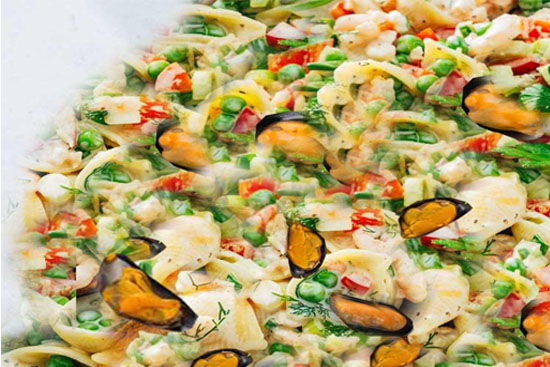
Serves: 6
Preparation time: 20 minutes
Cooking time:20 minutes
1 1/2 cups tiny shell pasta 4 quarts steamed mussels
10 ounces frozen tiny peas, thawed
1/2 cup chopped parsley
For the curried French dressing:
2 teaspoons olive oil
2 teaspoons wine vinegar
1 teaspoon minced green onions
1/2 teaspoon curry powder
1/2 teaspoon salt
For the curried mayonnaise dressing:
1/3 cup mayonnaise
2 teaspoons curry powder
1/2 teaspoon salt
Cook the pasta until al dente. Drain, rinse with cold water and drain again. Toss with 2 tablespoons of the curried French dressing. Clean and cook the mussels.
Cool and discard the shells and any black rims.
In a salad bowl toss with 1/4 cup of the Curried French dressing. Pour boiling water over the peas and drain.
In the salad bowl combine the pasta with the peas and mussels and remaining French dressing.
Mix the Curried Mayonnaise dressing ingredients and carefully fold into the salad ingredients.
Chill at least 2 hours and sprinkle with the chopped parsley before serving.
Cool and discard the shells and any black rims.
In a salad bowl toss with 1/4 cup of the Curried French dressing. Pour boiling water over the peas and drain.
In the salad bowl combine the pasta with the peas and mussels and remaining French dressing.
Mix the Curried Mayonnaise dressing ingredients and carefully fold into the salad ingredients.
Chill at least 2 hours and sprinkle with the chopped parsley before serving.
Main Eggplant meatballs in marinara 
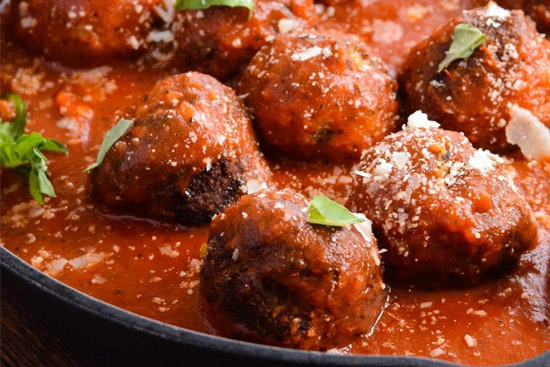
Eggplant Meatballs in Marinara Sauce is actually a meat-free recipe that is vegetarian and Vital wheat gluten is the principal ingredient in seitan. It is what gives it the meaty, chewy texture and great for replicating all kinds of meat dishes.
Serves: 4
3 tablespoons olive oil
2 cups marinara sauce
1/2 cup (100 grams) cooked white beans
5 cloves of garlic, minced
2 tablespoons soy sauce
1/2 cup (130 grams) vital wheat gluten
4 tablespoons nutritional yeast
1/3 cup grated Parmesan cheese
1 tablespoon fresh basil, chopped
1 tablespoon fresh parsley, chopped
1/2 cup (120 ml) vegetable stock
Serves: 4
Preparation time:15 minutes
Cooking time:40 minutes
1 large purple eggplant about 1 lb3 tablespoons olive oil
2 cups marinara sauce
1/2 cup (100 grams) cooked white beans
5 cloves of garlic, minced
2 tablespoons soy sauce
1/2 cup (130 grams) vital wheat gluten
4 tablespoons nutritional yeast
1/3 cup grated Parmesan cheese
1 tablespoon fresh basil, chopped
1 tablespoon fresh parsley, chopped
1/2 cup (120 ml) vegetable stock
1. Wash and cut eggplant into 2-inch cubes. Heat olive oil in a frying pan. Add eggplant and cook over low heat until tender while stirring occasionally.
2. Meanwhile add marinara to a pan and heat over low heat until simmering.
In a large bowl add bean, garlic, soy, Parmesan cheese, vital wheat gluten, nutritional yeast, herbs, and mashed eggplant and vegetable stock. Mix to combine then use your hands to mash the mixture together into a dough.
3. Shape mixture into 2-inch size balls. Packing the mixture tightly together.
4. Place them on a lightly greased or paper-lined pan
5. and bake for 20 minutes, flipping them over at 10 minutes. You can eat them still warm from the oven or you can let them cool and reheat them in the sauce later. Letting them cool helps them firm up to a more meaty texture.
6. Transfer meatballs to simmering marinara sauce.
7. Continue until all meatballs are added to marinara sauce and toss to coat, cooking until heated through completely about 10 minutes.
8. Serve topped with additional Parmesan cheese and basil.
2. Meanwhile add marinara to a pan and heat over low heat until simmering.
In a large bowl add bean, garlic, soy, Parmesan cheese, vital wheat gluten, nutritional yeast, herbs, and mashed eggplant and vegetable stock. Mix to combine then use your hands to mash the mixture together into a dough.
3. Shape mixture into 2-inch size balls. Packing the mixture tightly together.
4. Place them on a lightly greased or paper-lined pan
5. and bake for 20 minutes, flipping them over at 10 minutes. You can eat them still warm from the oven or you can let them cool and reheat them in the sauce later. Letting them cool helps them firm up to a more meaty texture.
6. Transfer meatballs to simmering marinara sauce.
7. Continue until all meatballs are added to marinara sauce and toss to coat, cooking until heated through completely about 10 minutes.
8. Serve topped with additional Parmesan cheese and basil.
Main Fall greens with walnuts feta and walnut vinaigrette 
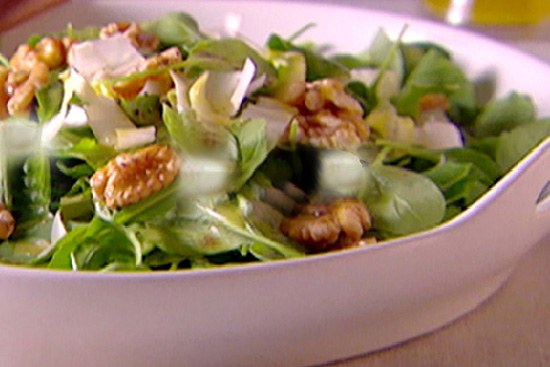
Serves: 8
Preparation time: 20 minutes
2 heads radicchio, washed, dried and separated into leaves 2 large Belgian endives, washed, root end cut off separated into leaves
1 bunch watercress, stems trimmed, washed and dried
3 ounces feta cheese, crumbled
1/2 cup walnut halves, lightly toasted
For dressing:
1 tespoon Dijon mustard
2 tablespoons red wine vinegar
salt and pepper to taste
1/4 cup walnut oil
1/4 cup extra virgin olive oil
Toss radicchio, endive and watercress in a large salad bowl.
Top with crumbled feta cheese and sprinkle with walnuts.
Beat together the dressing ingredients.
Just before serving, toss salad with the dressing
Top with crumbled feta cheese and sprinkle with walnuts.
Beat together the dressing ingredients.
Just before serving, toss salad with the dressing
Main Fettuccini primavera and pesto dressing 
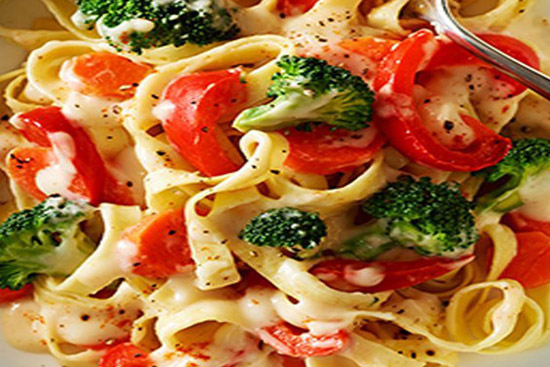
Serves: 6
Preparation time: 30 minutes
Cooking time:15 minutes
12 ounces fettuccini 1 teaspoons olive oil
2 large tomatoes
1 bunch broccoli
3 ounces pitted black olives
1/2 cup chopped walnuts
PESTO DRESSING
2 cups fresh basil
2/3 cup olive oil
2 cloves garlic
1/4 cup grated parmesan
1/4 cup chopped walnuts
1/4 cup red wine vinegar
1 teaspoon salt
1/4 teaspoon ground pepper
Cook pasta in large pot of boiling salted water until tender but still firm to bite.
Drain pasta, rinse in cold water and drain thoroughly. Place in a large bowl.
Mix with olive oil. Seed tomatoes and chop coarsely.
Slice peeled broccoli stems 1/4 inch thick and break florets into smaller pieces. Cook 3 minutes in boiling water. Drain, rinse in cold water and drain again.
Add tomatoes, broccoli, olives and walnuts to the pasta and toss gently.
Serve with pesto dressing
PESTO DRESSING
In a blender or food processor, chop the basil, garlic, walnuts, Parmesan cheese and vinegar.
Add the olive oil in a slow stream until it is all combined. Stir in salt and pepper.
Drain pasta, rinse in cold water and drain thoroughly. Place in a large bowl.
Mix with olive oil. Seed tomatoes and chop coarsely.
Slice peeled broccoli stems 1/4 inch thick and break florets into smaller pieces. Cook 3 minutes in boiling water. Drain, rinse in cold water and drain again.
Add tomatoes, broccoli, olives and walnuts to the pasta and toss gently.
Serve with pesto dressing
PESTO DRESSING
In a blender or food processor, chop the basil, garlic, walnuts, Parmesan cheese and vinegar.
Add the olive oil in a slow stream until it is all combined. Stir in salt and pepper.
Main Frittata 

A frittata is an Italian-style flat omelet that's baked in a skillet. This frittata recipe features spinach, mushrooms and Fontina cheese. It's perfect for holiday brunches or other special occasions. Many variations are made using bacon, asparagus, peas and other ingredients.
Serves: 4
1 cup chopped leeks (white and pale green parts only)
½ lb fresh spinach, rinsed, dried and torn into roughly 1-inch pieces
1 cup sliced stemmed mushrooms
8 large eggs
1 cup diced Fontina cheese, divided
1/2 teaspoon salt
1/2 teaspoon ground black pepper
1/4 cup grated Parmesan cheese
Serves: 4
Preparation time: 15 minutes
Cooking time:20 minutes
2 tablespoons (1/4 stick) butter1 cup chopped leeks (white and pale green parts only)
½ lb fresh spinach, rinsed, dried and torn into roughly 1-inch pieces
1 cup sliced stemmed mushrooms
8 large eggs
1 cup diced Fontina cheese, divided
1/2 teaspoon salt
1/2 teaspoon ground black pepper
1/4 cup grated Parmesan cheese
Preheat broiler.
Melt butter in heavy broilerproof 10-inch-diameter nonstick skillet over medium heat. Add leeks and sauté 4 minutes. Add spinach and mushrooms, sprinkle lightly with salt, and sauté until tender, about 6 minutes.
In a medium bowl, Whisk eggs, 3/4 cup Fontina cheese, 1/2 teaspoon salt, and 1/2 teaspoon pepper. Add egg mixture to skillet; fold gently to combine. Cook until almost set. Sprinkle remaining 1/4 cup Fontina cheese and Parmesan cheese over. Broil until frittata is puffed and cheese begins to turn golden, about 3 minutes. Cut into wedges and serve.
Melt butter in heavy broilerproof 10-inch-diameter nonstick skillet over medium heat. Add leeks and sauté 4 minutes. Add spinach and mushrooms, sprinkle lightly with salt, and sauté until tender, about 6 minutes.
In a medium bowl, Whisk eggs, 3/4 cup Fontina cheese, 1/2 teaspoon salt, and 1/2 teaspoon pepper. Add egg mixture to skillet; fold gently to combine. Cook until almost set. Sprinkle remaining 1/4 cup Fontina cheese and Parmesan cheese over. Broil until frittata is puffed and cheese begins to turn golden, about 3 minutes. Cut into wedges and serve.
Main Garlic mussels with pasta and cherry tomatoes 
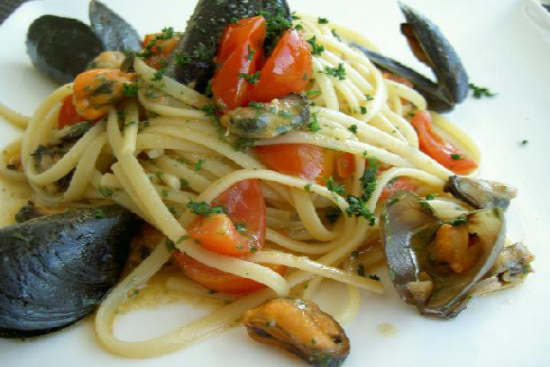
Serves: 2
Preparation time:20 minutes
1/2 pound fettuccine or spaghetti 2 pounds mussels
2 tablespoon butter
1 large onion, coarsely chopped
5 large garlic cloves, minced or crushed
2 cups whole cherry tomatoes or 1 pint grape tomatoes
1 cup dry white wine, preferably Chardonnay
1 teaspoon dried leaf tarragon
1/2 teaspoon hot red chili flakes
1/2 teaspoon salt
5 cups baby spinach leaves or 1/2 (10-oz) bag spinach
To cook pasta, bring a large pot of water to a rapid boil.
Meanwhile, yank off any hairy beards protruding from mussel shells, then rinse shells under cold running water. Heat butter in a large wide saucepan set over medium heat. Add onion and garlic and sauté, stirring often, just until onion softens a bit, about 2 min. Then add tomatoes, wine, tarragon, chili flakes and salt. Increase heat to high and boil, uncovered and stirring occasionally, until wine is almost evaporated, about 8 min.
Add pasta to boiling water and stir until all strands are separated. Then boil rapidly, uncovered and stirring occasionally, until al dente, from 8 to 10 min. Meanwhile, add all of mussels to onion mixture. Cover, reduce heat to medium and cook until most mussels have opened, about 6 min. Stir spinach into mussel mixture just until it starts to wilt, no more than 2 minutes. Discard any mussels that haven't opened. Add well-drained pasta to pan and toss until coated with sauce. Serve immediately.
Meanwhile, yank off any hairy beards protruding from mussel shells, then rinse shells under cold running water. Heat butter in a large wide saucepan set over medium heat. Add onion and garlic and sauté, stirring often, just until onion softens a bit, about 2 min. Then add tomatoes, wine, tarragon, chili flakes and salt. Increase heat to high and boil, uncovered and stirring occasionally, until wine is almost evaporated, about 8 min.
Add pasta to boiling water and stir until all strands are separated. Then boil rapidly, uncovered and stirring occasionally, until al dente, from 8 to 10 min. Meanwhile, add all of mussels to onion mixture. Cover, reduce heat to medium and cook until most mussels have opened, about 6 min. Stir spinach into mussel mixture just until it starts to wilt, no more than 2 minutes. Discard any mussels that haven't opened. Add well-drained pasta to pan and toss until coated with sauce. Serve immediately.
Main Gnocchi alla romana 
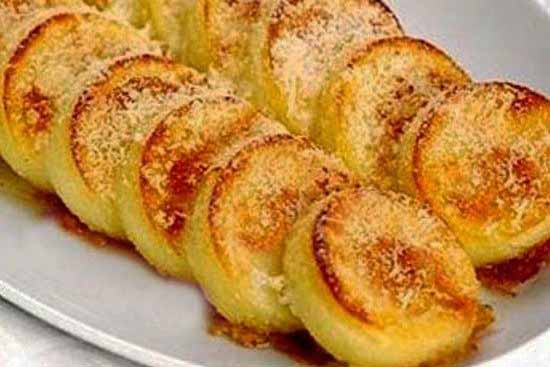
Serves: 6
Preparation time: 25 minutes
Cooking time:30 minutes
3 cups whole or low fat milk 3/4 cup semolina flour or yellow polenta
1/2 teaspoon salt
1/4 cup plus 2 tablespoons unsalted butter, melted
3 oz finely grated Parmigiano-Reggiano (1 1/2 cups)
2 large eggs
2 cups of pasta or Marinara sauce (optional)
Whisk together milk, semolina, and 1/2 teaspoon salt in a 2-quart heavy saucepan and bring to a boil over moderate heat, whisking. Simmer, stirring constantly with a wooden spoon, until very stiff, 5 to 8 minutes.
Remove from heat and stir in 2 tablespoons butter and 3/4 cup Parmigiano-Reggiano. Beat in eggs.
Spread gnocchi mixture 1 inch thick on an oiled baking sheet or a 9-inch square baking pan and chill, uncovered, until very firm, about 1 hour.
Preheat oven to 425°F.
Cut out squares, or other shapes from gnocchi mixture and arrange, slightly overlapping, in a well-buttered 13- by 9-inch baking dish. Brush gnocchi with remaining 1/4 cup melted butter and sprinkle with remaining 3/4 cup Parmigiano-Reggiano.
Bake in middle of oven until gnocchi are beginning to brown, 15 to 20 minutes. Let stand 5 minutes before serving.
Serve with hot pasta or Marinara sauce (optional).
Remove from heat and stir in 2 tablespoons butter and 3/4 cup Parmigiano-Reggiano. Beat in eggs.
Spread gnocchi mixture 1 inch thick on an oiled baking sheet or a 9-inch square baking pan and chill, uncovered, until very firm, about 1 hour.
Preheat oven to 425°F.
Cut out squares, or other shapes from gnocchi mixture and arrange, slightly overlapping, in a well-buttered 13- by 9-inch baking dish. Brush gnocchi with remaining 1/4 cup melted butter and sprinkle with remaining 3/4 cup Parmigiano-Reggiano.
Bake in middle of oven until gnocchi are beginning to brown, 15 to 20 minutes. Let stand 5 minutes before serving.
Serve with hot pasta or Marinara sauce (optional).
Main Gnocchi with green chive sauce 
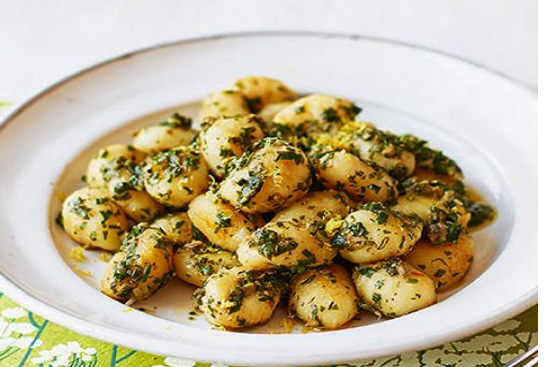
Serves: 6
Preparation time: 50 minutes
Cooking time:5 minutes.
For gnocchi: 3 russet potatoes
1 egg, beaten
2 teaspoons cream
1 teaspoon salt
1/2 teaspoon nutmeg
3 cups flour
For sauce:
4 bunches chives, chopped
1 tablespoon butter
1 teaspoon white wine vinegar
1 cup cream
1 cup grated Parmesan cheese
Peel and boil potatoes. Drain, and mash coarsely. Mix in egg, cream and seasonings.
Place flour in a large mixing bowl. Add potato mixture. Using a spatula, mix well. If sticky, add more flour. The dough should be soft but not elastic. On a work surface, form the mass into a log.
Divide the log into smaller portions and using your hands, roll out into 1/2-inch-long pieces.
Dust them well with flour. Hold a flour-dusted fork, concave side up, in one hand. With the other hand, push a piece of dough into the tines, making an indentation with your thumb. Then roll the dough off the tines, making a shape like a tiny bowl with ridges on the bottom. Flour the fork and repeat with rest of dough.
Sauce:
Saute chives in butter and a tablespoon water and vinegar. Simmer for 2 minutes Add cream. Simmer 10 minutes. Cook gnocchi in boiling water for 4 to 5 minutes.
Drain. Stir in the chive sauce. Heat and serve with Parmesan cheese.
Place flour in a large mixing bowl. Add potato mixture. Using a spatula, mix well. If sticky, add more flour. The dough should be soft but not elastic. On a work surface, form the mass into a log.
Divide the log into smaller portions and using your hands, roll out into 1/2-inch-long pieces.
Dust them well with flour. Hold a flour-dusted fork, concave side up, in one hand. With the other hand, push a piece of dough into the tines, making an indentation with your thumb. Then roll the dough off the tines, making a shape like a tiny bowl with ridges on the bottom. Flour the fork and repeat with rest of dough.
Sauce:
Saute chives in butter and a tablespoon water and vinegar. Simmer for 2 minutes Add cream. Simmer 10 minutes. Cook gnocchi in boiling water for 4 to 5 minutes.
Drain. Stir in the chive sauce. Heat and serve with Parmesan cheese.
Main Gnocchi with spinach and ricotta 
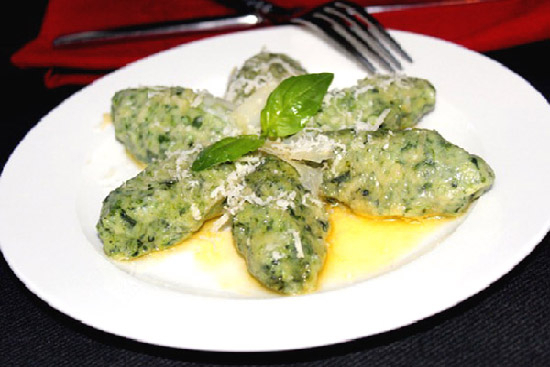
Serves: 4
Preparation time: 30 minutes
Cooking time:5 minutes
1 teaspoon chopped onion 2 teaspoons butter
2 teaspoons fine chopped pancetta or unsmoked ham
1-10 ounce package frozen spinach, thawed or 1 pound fresh
salt to taste
3/4 cup ricotta
2/3 cup flour
2 egg yolks
1 cup grated Parmesan
1/4 teaspoon nutmeg
Melt butter in a skillet, and saute onion until golden. Add ham and continue cooking for 3-4 minutes. Add spinach, salt to taste and saute for 5 to 6 minutes, stirring frequently.
Transfer to a mixing bowl. Stir in ricotta, flour, mixing thoroughly. Add egg yolks, cheese and nutmeg. Season to taste.
To shape gnocchi:
Roll into little sausages. Shape on butter ball wooden board or make small pellets out of the mixture, shaping them quickly in the palm of your hands. Ideally, they should 1/2-inch in diameter.
If the mixture begins to stick to your hands, dust your hands lightly with flour.
Cook gnocchi in salted boiling water for two to three minutes.
Serving suggestions:
- melted butter and Parmesan cheese. Bake to melt cheese.
- Boil in chicken broth, serve with Parmesan.
- tomato and/or cream sauce, and Parmesan.
Transfer to a mixing bowl. Stir in ricotta, flour, mixing thoroughly. Add egg yolks, cheese and nutmeg. Season to taste.
To shape gnocchi:
Roll into little sausages. Shape on butter ball wooden board or make small pellets out of the mixture, shaping them quickly in the palm of your hands. Ideally, they should 1/2-inch in diameter.
If the mixture begins to stick to your hands, dust your hands lightly with flour.
Cook gnocchi in salted boiling water for two to three minutes.
Serving suggestions:
- melted butter and Parmesan cheese. Bake to melt cheese.
- Boil in chicken broth, serve with Parmesan.
- tomato and/or cream sauce, and Parmesan.
Main Grilled bruschetta chicken 
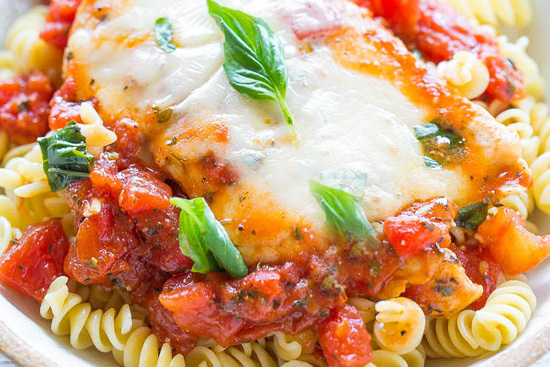
Chicken may be marinated for an hour and baked instead of grilled.
The bruschetta can be made ahead of time
Serves: 4
1/4 cup sun Dried Tomato Vinaigrette Dressing, divided OR Balsamic vinegar
1 tomato, finely chopped, or canned diced tomatoes
1/2 cup shredded Mozzarella Cheese
1/4 cup chopped fresh basil
Serves: 4
Preparation time:25 minutes
Cooking time:15 minutes
4 small boneless skinless chicken breasts (1 lb.)1/4 cup sun Dried Tomato Vinaigrette Dressing, divided OR Balsamic vinegar
1 tomato, finely chopped, or canned diced tomatoes
1/2 cup shredded Mozzarella Cheese
1/4 cup chopped fresh basil
Flatten the chicken breast slightly.
Coat chicken with 2 tablespoons of the dressing Marinate chicken in a shallow glass dish for 30 minutes to an hour.
Grill the chicken breasts or bake in a 400F oven t for 5 to 6 minutes. Discard the dressing.
Meanwhile, combine remaining dressing, tomatoes, cheese and basil.
Turn chicken over; place on foil. Top with tomato mixture. Grill or bake 8 min. or until chicken is done (165ºF).
Serve with pasta.
Coat chicken with 2 tablespoons of the dressing Marinate chicken in a shallow glass dish for 30 minutes to an hour.
Grill the chicken breasts or bake in a 400F oven t for 5 to 6 minutes. Discard the dressing.
Meanwhile, combine remaining dressing, tomatoes, cheese and basil.
Turn chicken over; place on foil. Top with tomato mixture. Grill or bake 8 min. or until chicken is done (165ºF).
Serve with pasta.
Main Grilled chicken and vegetable pasta salad 
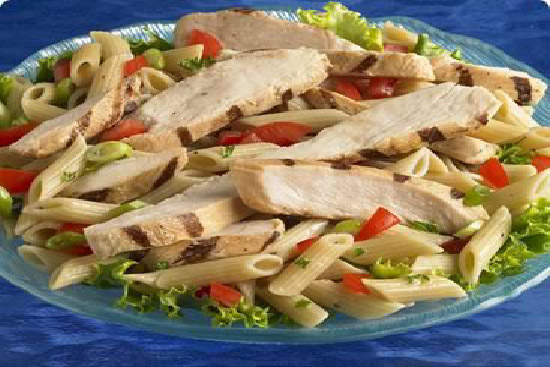
Serves: 4
Preparation time: 30 minutes
Cooking time:40 minutes
2 red peppers 3 zucchini
2 corn cobs
1/3 cup olive oil
1/4 cup red wine vinegar
2 tablespoons chopped fresh thyme or oregano
1 tablespoon Dijon mustard
1/2 teaspoon salt
1/4 teaspoon each pepper and sugar
3/4 pound boneless skinless chicken breasts
4 cups fusilli noodles
Seed and core red peppers; cut into 1-inch wide strips. Cut zucchini diagonally into 1/2 inch thick slices. Brush corn and zucchini with 2 tablespoons of the oil.
On lightly greased grill over medium heat and with lid closed, cook vegetables, turning corn often and peppers and zucchini halfway through cooking time until tender. Cool.
Slice kernels off corn and transfer to a large bowl. Cut red pepper strips into 3/4-inch chunks; add to bowl along with zucchini slices. Meanwhile, whisk together remaining oil, vinegar, thyme, mustard, salt, pepper and sugar.
Brush 2 tablespoons of the dressing over chicken. Grill chicken over medium-high heat with lid closed until no longer pink inside.
Slice into thin strips.
Cook pasta until tender but firm. Drain and rinse under cold water. Add to vegetables along with remaining dressing; toss to coat.
Top with chicken.
On lightly greased grill over medium heat and with lid closed, cook vegetables, turning corn often and peppers and zucchini halfway through cooking time until tender. Cool.
Slice kernels off corn and transfer to a large bowl. Cut red pepper strips into 3/4-inch chunks; add to bowl along with zucchini slices. Meanwhile, whisk together remaining oil, vinegar, thyme, mustard, salt, pepper and sugar.
Brush 2 tablespoons of the dressing over chicken. Grill chicken over medium-high heat with lid closed until no longer pink inside.
Slice into thin strips.
Cook pasta until tender but firm. Drain and rinse under cold water. Add to vegetables along with remaining dressing; toss to coat.
Top with chicken.
Main Grilled chicken pesto 
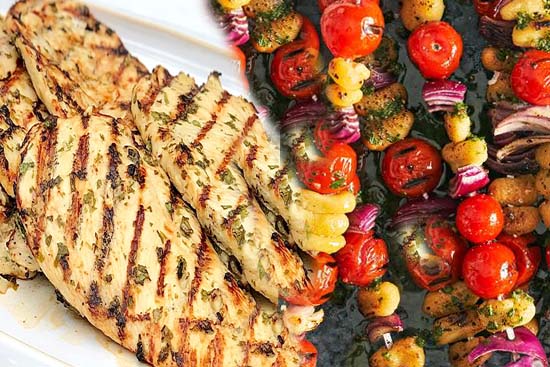
Serves: 4
Preparation time: 15 minutes
Cooking time:30 minutes
4 boneless chicken breasts 1/2 cup fresh basil leaves
1 tablespoon wine vinegar
1 teaspoon Dijon mustard
2 cloves minced garlic
salt and black pepper to taste
1/2 cup olive oil
2 sweet potatoes
20 cherry tomatoes
6 cups lettuce leaves
Cut a slit in thickest part of chicken; insert 2 fresh basil leaves in each one. Chop remaining basil.
Whish together vinegar, mustard, garlic, salt and pepper. Whisk in oil and chopped basil.
Remove 2 tablespoons of the dressing and brush over chicken. Peel and cut potatoes into 1 inch cubes.
Blanch potatoes in boiling water for 8 minutes. Drain.
Thread potatoes and tomatoes onto separate skewers. Brush with some of the reserved dressing.
Grill or broil chicken, potato and tomato skewers. Season lettuce with remaining dressing. Arrange on plates.
Slice chicken diagonally.
Fan over lettuce with vegetables.
Whish together vinegar, mustard, garlic, salt and pepper. Whisk in oil and chopped basil.
Remove 2 tablespoons of the dressing and brush over chicken. Peel and cut potatoes into 1 inch cubes.
Blanch potatoes in boiling water for 8 minutes. Drain.
Thread potatoes and tomatoes onto separate skewers. Brush with some of the reserved dressing.
Grill or broil chicken, potato and tomato skewers. Season lettuce with remaining dressing. Arrange on plates.
Slice chicken diagonally.
Fan over lettuce with vegetables.
Main Grilled salmon fillets with sun-dried tomatoes 
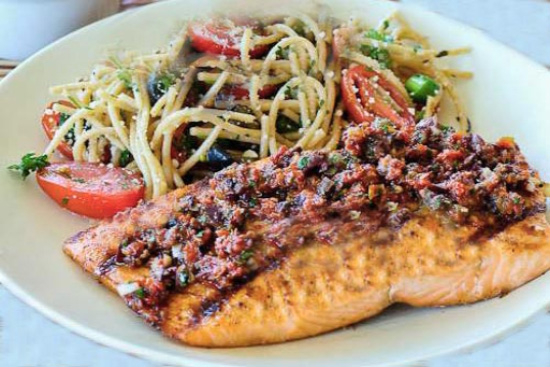
Serves: 4
Preparation time: 15 minutes
Cooking time:15 minutes
4 salmon fillets with skin on (6 ounce portions)3/4 cup sun dried tomatoes, finely chopped
2 tablespoons unsalted butter, softened
2 tablespoons grapeseed oil
1 tablespoon Mrs. Dash original blend seasoning
Pam cooking spray for high temp cooking
Aluminum foil
Remove salmon fillets from refrigerator and allow them to reach room temperature.
Make topping: In a small bowl, combine sun dried tomatoes and butter. Mix thoroughly and set aside.
Preheat grill or cast iron griddle to medium heat. Brush fillets with grapeseed oil and season with Mrs. Dash seasoning.
Generously spray cooking surface with cooking spray. Place fillets on the grill, skin side up. Grill side without skin for approximately 2-3 minutes, watching carefully not to burn.
Flip to skin down side and grill for 3-4 minutes. Cover with foil until skin is crispy.
Preheat oven to 375 degrees. Place generous portion of sun dried tomato topping on top of fillets. Heat for another 6-7 minutes, until sun dried tomatoes begin to crisp.
Serve immediately.
Make topping: In a small bowl, combine sun dried tomatoes and butter. Mix thoroughly and set aside.
Preheat grill or cast iron griddle to medium heat. Brush fillets with grapeseed oil and season with Mrs. Dash seasoning.
Generously spray cooking surface with cooking spray. Place fillets on the grill, skin side up. Grill side without skin for approximately 2-3 minutes, watching carefully not to burn.
Flip to skin down side and grill for 3-4 minutes. Cover with foil until skin is crispy.
Preheat oven to 375 degrees. Place generous portion of sun dried tomato topping on top of fillets. Heat for another 6-7 minutes, until sun dried tomatoes begin to crisp.
Serve immediately.
Main Grilled sardines 

Serves: 2
Preparation time:15 minutes
Cooking time:10 minutes
For The Sardines:600 grams (1.3 pound) whole fresh sardines
3 tablespoons olive oil
⅔ teaspoon kosher salt
dried oregano to serve with
lemon quarters to serve with
For The Lemon Dressing:
4 tablespoons extra virgin olive oil
3 tablespoons lemon juice
Prepare The Sardines:
Place the sardines in a bowl with very cold water. And allow them to soak for 20 minutes. This will help firm their skin so it won't break as you clean them.
Rub the skin to remove any scales.
Gut the sardines by making a small incision with a knife on the belly right after the head.Pull out the innards.
Rinse the sardines well.
Prepare The Lemon Dressing:
Add the extra virgin olive oil and lemon juice to a small bowl and whisk until it thickens.e one.
Grill The Sardines:
Heat a grill pan, griddle, or bbq on high. Brush the grates with oil.
Pat dry the sardines. Then drizzle with the 3 tablespoons of olive oil and sprinkle the salt on top. Gently mix so the oil and salt spread all over.
The cooking surface must be very hot so that the fish won't stick. If cooking on a bbq you may need to adjust the heat to medium. Sardines tend to flame up due to their fat content.
Cook the sardines for 2 minutes on high or 5-6 minutes on medium before flipping them.
Flip the sardines carefully.
Cook for 3 more minutes on high or 6-7 minutes on medium.
Add sardines to a plate, and pour the emulsified dressing all over the fish. Sprinkle some dried oregano on top and serve with a few pieces of lemon on the side.
Place the sardines in a bowl with very cold water. And allow them to soak for 20 minutes. This will help firm their skin so it won't break as you clean them.
Rub the skin to remove any scales.
Gut the sardines by making a small incision with a knife on the belly right after the head.Pull out the innards.
Rinse the sardines well.
Prepare The Lemon Dressing:
Add the extra virgin olive oil and lemon juice to a small bowl and whisk until it thickens.e one.
Grill The Sardines:
Heat a grill pan, griddle, or bbq on high. Brush the grates with oil.
Pat dry the sardines. Then drizzle with the 3 tablespoons of olive oil and sprinkle the salt on top. Gently mix so the oil and salt spread all over.
The cooking surface must be very hot so that the fish won't stick. If cooking on a bbq you may need to adjust the heat to medium. Sardines tend to flame up due to their fat content.
Cook the sardines for 2 minutes on high or 5-6 minutes on medium before flipping them.
Flip the sardines carefully.
Cook for 3 more minutes on high or 6-7 minutes on medium.
Add sardines to a plate, and pour the emulsified dressing all over the fish. Sprinkle some dried oregano on top and serve with a few pieces of lemon on the side.
Main Homemade pizza dough 
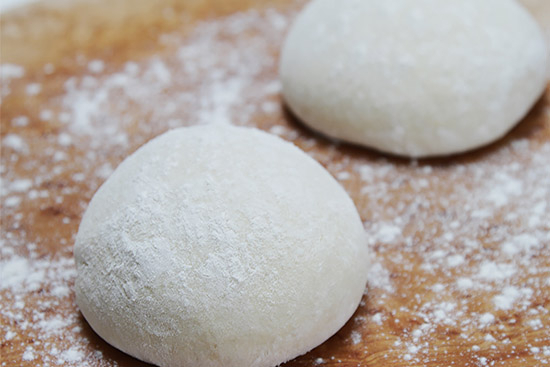
Manitoba flour: what it is and it is used for
2 cups – warm water
2 tbsp. – dry milk powder
2 tbsp. – granulated sugar
2 tbsp. – olive oil
4 cups - white bread flour or Manitoba flour or Tipo '00' flour
1 tsp. – salt
Preparation time: 15 minutes
1 tbsp. – dry active yeast2 cups – warm water
2 tbsp. – dry milk powder
2 tbsp. – granulated sugar
2 tbsp. – olive oil
4 cups - white bread flour or Manitoba flour or Tipo '00' flour
1 tsp. – salt
Using a bread machine:
Place all dry ingredients into a bread machine maker pan if available
Add lukewarm water. Set the bread machine to dough cycle. Place the bread machine pan into the bread machine maker.
It takes about 30 minutes for the dough cycle to mix the dough. The rest of the cycle the dough will be rising for about one hour.
To make dough by hand:
Combine yeast, water, milk powder and olive oil in a large mixing bowl. Stir well and allow the yeast to develop. Add flour and salt. Knead the dough into a ball shape. Transfer the dough onto a large greased bowl. Let dough rise until doubled in volume.
Knead the dough and split in two equal halves. Each half of the dough makes one 13” pizza. You can freeze the second half of the dough is it is not used. Just coat it with olive oil, and place it into a freezing bag. You can freeze the dough for a couple of months, and then when the dough is needed, just place it overnight into refrigerator to thaw.
Place all dry ingredients into a bread machine maker pan if available
Add lukewarm water. Set the bread machine to dough cycle. Place the bread machine pan into the bread machine maker.
It takes about 30 minutes for the dough cycle to mix the dough. The rest of the cycle the dough will be rising for about one hour.
To make dough by hand:
Combine yeast, water, milk powder and olive oil in a large mixing bowl. Stir well and allow the yeast to develop. Add flour and salt. Knead the dough into a ball shape. Transfer the dough onto a large greased bowl. Let dough rise until doubled in volume.
Knead the dough and split in two equal halves. Each half of the dough makes one 13” pizza. You can freeze the second half of the dough is it is not used. Just coat it with olive oil, and place it into a freezing bag. You can freeze the dough for a couple of months, and then when the dough is needed, just place it overnight into refrigerator to thaw.
Main Lasagna 
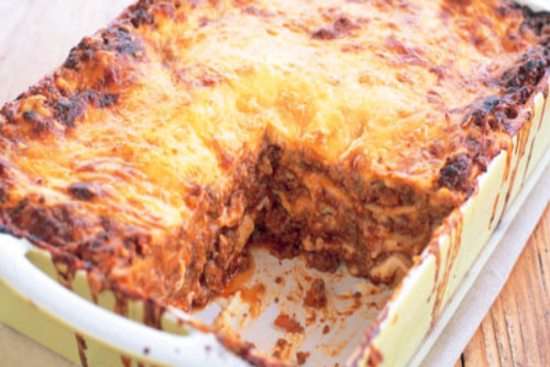
Serves: 10
Preparation time: 1 hour
Cooking time:25 minutes
5 cups meat sauce, see recipe below 1 pound lasagna noodles
2 cups mozzarella cheese
4 cups medium cream sauce (see sauces)
3 cups cooked chopped spinach
For meat sauce:
2 teaspoons vegetable oil
1 1/2 cups chopped onions
1/4 cup chopped parsley
3 garlic cloves, chopped
1 pound ground beef
1-28 ounce can plum tomatoes, chopped
1 1/2 cups beef stock
3 teaspoons tomato paste
2 teaspoons dried oregano
2 bay leaves salt and pepper
Meat sauce:
In a large heavy saucepan heat oil over moderate heat. Add onion, parsley and garlic.
Cook until onions are soft, about 5 minutes. Add beef and cook while stirring and breaking up the meat, until evenly brown.
Add tomatoes, beef stock, tomato paste, oregano and bay leaves; cook stirring over medium heat until mixture starts to simmer.
Reduce heat and simmer for one hour or until thickened to desired consistency.
Remove bay leaves. Add salt and pepper to taste.
PASTA:
Cook 1 pound of lasagna in a large pot of salted boiling water until al dente. Transfer to cold water to cool the pasta.
When cold, arrange pasta on a sheet pan.
Cover with a moist towel.
TO ASSEMBLE LASAGNA:
Spread about 1/2 cup of meat sauce over the bottom of a 13 by 9 inch deep baking dish. Arrange a layer of lasagna noodles on top. Spread with a little meat sauce, then a little cream sauce, and half of the spinach. Sprinkle with mozzarella cheese.
Repeat the same process until all ingredients have been used, finishing with cream sauce and cheese.
Bake at 400 degrees for 20 to 30 minutes, or refrigerate until needed, then bake at 375 degrees for 40 to 50 minutes.
In a large heavy saucepan heat oil over moderate heat. Add onion, parsley and garlic.
Cook until onions are soft, about 5 minutes. Add beef and cook while stirring and breaking up the meat, until evenly brown.
Add tomatoes, beef stock, tomato paste, oregano and bay leaves; cook stirring over medium heat until mixture starts to simmer.
Reduce heat and simmer for one hour or until thickened to desired consistency.
Remove bay leaves. Add salt and pepper to taste.
PASTA:
Cook 1 pound of lasagna in a large pot of salted boiling water until al dente. Transfer to cold water to cool the pasta.
When cold, arrange pasta on a sheet pan.
Cover with a moist towel.
TO ASSEMBLE LASAGNA:
Spread about 1/2 cup of meat sauce over the bottom of a 13 by 9 inch deep baking dish. Arrange a layer of lasagna noodles on top. Spread with a little meat sauce, then a little cream sauce, and half of the spinach. Sprinkle with mozzarella cheese.
Repeat the same process until all ingredients have been used, finishing with cream sauce and cheese.
Bake at 400 degrees for 20 to 30 minutes, or refrigerate until needed, then bake at 375 degrees for 40 to 50 minutes.
Main Lemon chicken breast 
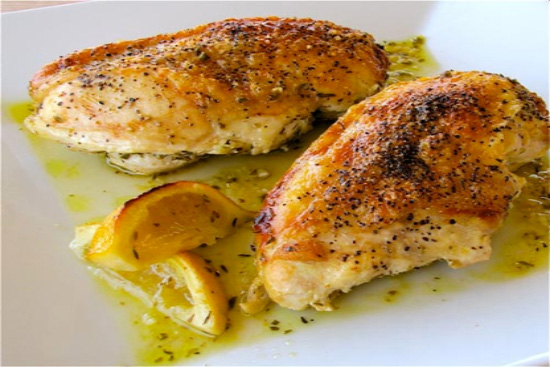
Ina's favorite dish from her book Barefoot Contessa "how easy is that".
Serves: 4
3 tablespoons minced garlic (9 cloves)
1/3 cup dry white wine
1 tablespoon grated lemon zest (2 lemons)
2 tablespoons freshly squeezed lemon juice
1 1/2 teaspoons dried oregano
1 teaspoon minced fresh thyme leaves
Kosher salt and freshly ground black pepper
4 boneless chicken breasts, skin on (6 to 8 ounces each)
1 lemon
Serves: 4
Preparation time: 20 minutes
Cooking time:40 minutes
1/4 cup good olive oil3 tablespoons minced garlic (9 cloves)
1/3 cup dry white wine
1 tablespoon grated lemon zest (2 lemons)
2 tablespoons freshly squeezed lemon juice
1 1/2 teaspoons dried oregano
1 teaspoon minced fresh thyme leaves
Kosher salt and freshly ground black pepper
4 boneless chicken breasts, skin on (6 to 8 ounces each)
1 lemon
Preheat the oven to 400 F.
Warm the olive oil in a small saucepan over medium-low heat, add the garlic, and cook for just one minute — but don't allow the garlic to turn brown. Off the heat, add the white wine, lemon zest, lemon juice, oregano, thyme and 1 teaspoon salt, and pour into a 9-by-12-inch baking dish.
Pat the chicken breasts dry and place them skin side up over the sauce. Brush the chicken breasts with olive oil and sprinkle them liberally with salt and pepper. Cut the lemon in eight wedges and tuck it among the pieces of chicken.
Bake for 30 to 40 minutes, depending on the size of the chicken breasts, until the chicken is done and the skin is lightly browned. If the chicken isn't browned enough, put it under the broiler for two minutes. Cover the pan tightly with aluminum foil and allow to rest for 10 minutes. Sprinkle with salt and serve hot with the pan juices.
Warm the olive oil in a small saucepan over medium-low heat, add the garlic, and cook for just one minute — but don't allow the garlic to turn brown. Off the heat, add the white wine, lemon zest, lemon juice, oregano, thyme and 1 teaspoon salt, and pour into a 9-by-12-inch baking dish.
Pat the chicken breasts dry and place them skin side up over the sauce. Brush the chicken breasts with olive oil and sprinkle them liberally with salt and pepper. Cut the lemon in eight wedges and tuck it among the pieces of chicken.
Bake for 30 to 40 minutes, depending on the size of the chicken breasts, until the chicken is done and the skin is lightly browned. If the chicken isn't browned enough, put it under the broiler for two minutes. Cover the pan tightly with aluminum foil and allow to rest for 10 minutes. Sprinkle with salt and serve hot with the pan juices.
Main Lemon chicken cutlets 
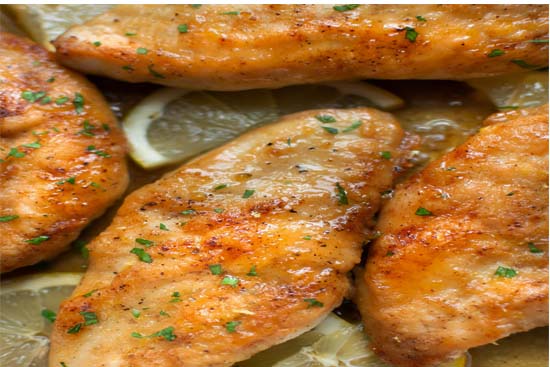
Serves: 4
Preparation time: 15 minutes
Cooking time:15 minutes
3/4 cup plain dry breadcrumbs 2 teaspoons minced fresh basil or 1 teaspoon dried
1 teaspoon minced fresh thyme or 1/2 teaspoon dried
2 teaspoons minced lemon peel
4 skinless boneless chicken breast halves
salt and white pepper to taste
2 tablespoons olive oil
2 tablespoons butter
4 lemon wedges
Mix breadcrumbs, basil and thyme and lemon peel on a large plate. Pound chicken breasts between sheets of waxed paper to 1/2-inch thickness.
Rinse chicken with cold water so that coating will adhere. Sprinkle with salt and pepper. Press both sides of chicken breasts into crumb mixture to cover.
In a heavy large skillet, Heat oil over medium-high heat. Add chicken to skillet.
Sauté over medium heat until chicken is cooked through and golden brown. Turn chicken and continue cooking about 4 minutes per side. Serve chicken with lemon wedges
Rinse chicken with cold water so that coating will adhere. Sprinkle with salt and pepper. Press both sides of chicken breasts into crumb mixture to cover.
In a heavy large skillet, Heat oil over medium-high heat. Add chicken to skillet.
Sauté over medium heat until chicken is cooked through and golden brown. Turn chicken and continue cooking about 4 minutes per side. Serve chicken with lemon wedges
Main Linguine alla carbonara 
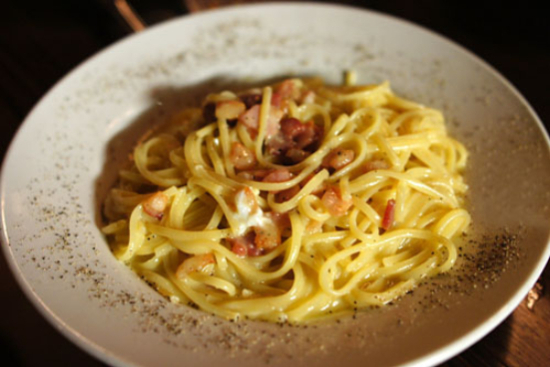
Serves: 6
Preparation time: 15 minutes
Cooking time:25 minutes
9 ounces pancetta (smoked pancetta is best) 1 1/4 to 1 1/2 pounds linguine
2 ounces butter
4 cloves garlic, minced
1 1/2 cups heavy cream, heated
salt and ground black pepper to taste
2 egg yolks
1/2 cup heavy cream
6 ounces parmesan cheese, grated
Cut the pancetta into medium dices.
Fry in a frying pan until crisp. Drain on paper towels, and set aside.
Cook the linguine al dente and drain.
Heat the butter with the garlic and pancetta in a large skillet. Add the 1 1/2 cups hot heavy cream and heat through. Season with salt and pepper to taste.
Remove from heat. Combine the egg yolks with the 1/2 cup cream and mix well. Add to the skillet.
Combine the sauce with the linguine. Toss well to cover the pasta. Add Parmesan cheese and serve at once.
Fry in a frying pan until crisp. Drain on paper towels, and set aside.
Cook the linguine al dente and drain.
Heat the butter with the garlic and pancetta in a large skillet. Add the 1 1/2 cups hot heavy cream and heat through. Season with salt and pepper to taste.
Remove from heat. Combine the egg yolks with the 1/2 cup cream and mix well. Add to the skillet.
Combine the sauce with the linguine. Toss well to cover the pasta. Add Parmesan cheese and serve at once.
Main Linguine primavera 
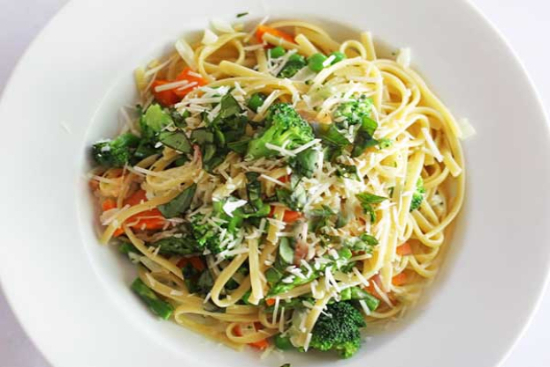
Serves: 4
Preparation time: 15 minutes
Cooking time:15 minutes
1 cup chicken or vegetable broth 12 Sun-dried tomatoes, (not in oil)
1 pound linguine
5 tablespoons olive oil
8 cloves garlic, minced
8 ounces shiitake, stemmed, sliced
1 medium zucchini, chopped
12 Broccoli rabbi florets
1/2 cup chopped fresh basil
to taste salt and pepper
1 cup freshly grated Parmesan cheese
Heat broth in a small saucepan. Remove from heat. Add tomatoes. Let stand until soft. Drain reserving broth. Slice tomatoes into thin strips.
Heat oil in a heavy large skillet over high heat. Add minced garlic; sauté until golden, about 1 minute. Add reserved broth, sun-dried tomatoes strips, mushrooms, zucchini, broccoli rabe florets and basil. Simmer until vegetables are tender, about 3 minutes. Cook linguine in a large pot of boiling salted water until tender but still firm. Drain linguine; return to pot. Add vegetables and toss to combine. Season with salt and pepper to taste.
Transfer pasta mixture to bowl; sprinkle with Parmesan cheese.
Heat oil in a heavy large skillet over high heat. Add minced garlic; sauté until golden, about 1 minute. Add reserved broth, sun-dried tomatoes strips, mushrooms, zucchini, broccoli rabe florets and basil. Simmer until vegetables are tender, about 3 minutes. Cook linguine in a large pot of boiling salted water until tender but still firm. Drain linguine; return to pot. Add vegetables and toss to combine. Season with salt and pepper to taste.
Transfer pasta mixture to bowl; sprinkle with Parmesan cheese.
Main Mediterranean farro salad 
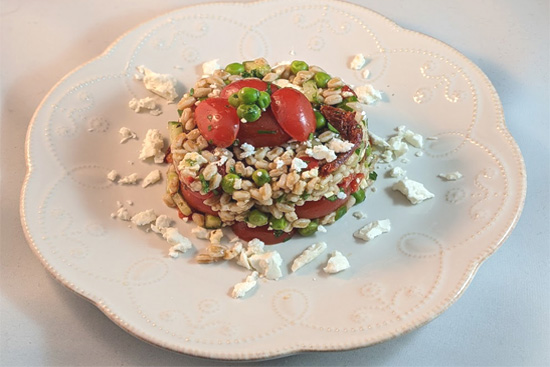
Mediterranean Farro Salad with feta, fresh tomatoes, vegetables, and a bright red wine vinaigrette.
Serves: 8
1/4 teaspoon kosher salt
1/2 cup sundried tomatoes, cut into julienne slices
1 large cucumber seeded and finely diced
3/4 cup jarred roasted red peppers drained and finely diced
1 pint cherry tomatoes halved
1 cup frozen petite peas thawed
1/2 cup finely chopped fresh parsley
1/2 cup crumbled feta cheese
For the Italian Vinaigrette Dressing:
1/4 cup extra-virgin olive oil
1/4 cup red wine vinegar
2 teaspoons Dijon mustard
1 teaspoon honey
1 teaspoon dried oregano
1/2 teaspoon kosher salt
1/4 teaspoon ground black pepper
Serves: 8
Preparation time:15 minutes
Cooking time:30 minutes
1 cup uncooked Farro, soaked in water for 1 hour1/4 teaspoon kosher salt
1/2 cup sundried tomatoes, cut into julienne slices
1 large cucumber seeded and finely diced
3/4 cup jarred roasted red peppers drained and finely diced
1 pint cherry tomatoes halved
1 cup frozen petite peas thawed
1/2 cup finely chopped fresh parsley
1/2 cup crumbled feta cheese
For the Italian Vinaigrette Dressing:
1/4 cup extra-virgin olive oil
1/4 cup red wine vinegar
2 teaspoons Dijon mustard
1 teaspoon honey
1 teaspoon dried oregano
1/2 teaspoon kosher salt
1/4 teaspoon ground black pepper
Rinse and drain farro, then cook according to package instructions. Transfer to a large mixing or serving bowl.
While the farro cooks, prepare the dressing: In a small bowl or large measuring cup, whisk together the olive oil, red wine vinegar, Dijon, honey, oregano, salt, and pepper until evenly blended. Pour half of the dressing over the warm farro and sprinkle with 1/4 teaspoon salt. Toss to coat.
Add all of the remaining ingredients to the bowl except for the feta: sundried tomatoes, cucumber, roasted red pepper, cherry tomatoes, peas, and parsley. Toss to coat. Taste and add as much of the remaining dressing as you like. Sprinkle with feta, lightly toss again, then season with salt and pepper to taste. Serve cold or at room temperature.
While the farro cooks, prepare the dressing: In a small bowl or large measuring cup, whisk together the olive oil, red wine vinegar, Dijon, honey, oregano, salt, and pepper until evenly blended. Pour half of the dressing over the warm farro and sprinkle with 1/4 teaspoon salt. Toss to coat.
Add all of the remaining ingredients to the bowl except for the feta: sundried tomatoes, cucumber, roasted red pepper, cherry tomatoes, peas, and parsley. Toss to coat. Taste and add as much of the remaining dressing as you like. Sprinkle with feta, lightly toss again, then season with salt and pepper to taste. Serve cold or at room temperature.
Main Minestrone with cabbage and spinach 
Serves: 6
Preparation time: 20 minutes
Cooking time:30 minutes
2 cups finely chopped celery 1 cup finely chopped onion
3/4 cup finely chopped leek (white and pale green parts only)
1/2 cup dry white wine
9 cups vegetable broth
4 cups diced green cabbage
2 cups diced zucchini
3/4 cup small pasta
3 cups packed, coarsely chopped fresh spinach
1/3 cup thinly sliced fresh basil
freshly grated Parmesan cheese
Combine celery, onion, leek and wine in heavy large pot over medium heat.
Simmer until vegetables are tender but not brown, stirring frequently, about 12 minutes.
Add broth and bring to boil. Add cabbage and zucchini and simmer 10 minutes. Add pasta; cover and simmer until pasta is just tender. Add spinach and cook 5 minutes.
Stir in sliced basil. Season to taste with salt and pepper. Ladle soup into bowls.
Pass Parmesan cheese separately.
Simmer until vegetables are tender but not brown, stirring frequently, about 12 minutes.
Add broth and bring to boil. Add cabbage and zucchini and simmer 10 minutes. Add pasta; cover and simmer until pasta is just tender. Add spinach and cook 5 minutes.
Stir in sliced basil. Season to taste with salt and pepper. Ladle soup into bowls.
Pass Parmesan cheese separately.
Main Mussels and spaghetti 
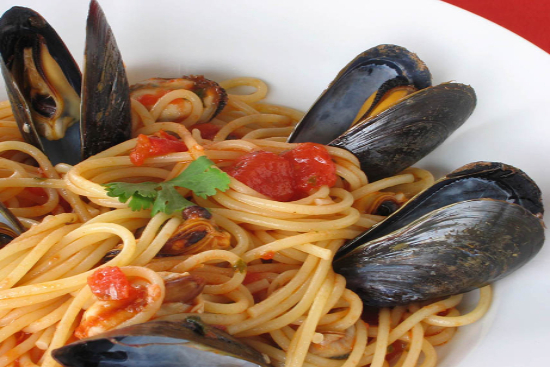
Serves: 6
Preparation time: 20 minutes
Cooking time:30 minutes
3 pounds fresh mussels 1 bay leaf
6 peppercorns
2 whole cloves
1/4 cup dry white wine
3 quarts water
1/2 teaspoon salt
1 pound spaghetti
4 tablespoons olive oil
1 tablespoon garlic, minced
1 cup stewed tomatoes
1 tablespoon fresh basil, chopped
1/4 teaspoon salt
1/8 teaspoon white pepper
Scrub mussels under cold water. Remove beards and drain. In a large saucepan or kettle add mussels, bay leaf, peppercorns, cloves, and wine. Cover and bring to a boil. Cook over high heat until mussels open, 4 to 6 minutes. Strain mussels. Remove from shells. Save broth.
Cook spaghetti in boiling water for 6 minutes. Drain. Heat oil in a large skillet. Add garlic and cook briefly, stirring, but do not brown.
Add tomatoes, broth and spaghetti. Cook, stirring often until spaghetti are done. Add mussels. Stir and heat for a moment. Add basil and season with salt and pepper to taste. Toss and serve hot.
Cook spaghetti in boiling water for 6 minutes. Drain. Heat oil in a large skillet. Add garlic and cook briefly, stirring, but do not brown.
Add tomatoes, broth and spaghetti. Cook, stirring often until spaghetti are done. Add mussels. Stir and heat for a moment. Add basil and season with salt and pepper to taste. Toss and serve hot.
Main Mussels marinara with linguine 
Serves: 6
Preparation time: 25 minutes
Cooking time:45 minutes
12 ounces linguine 4 quarts mussels
1 cup thinly sliced onion
3 cloves garlic, finely minced
1/4 cup olive oil
1 lemon, thinly sliced
1 pound Italian plum tomatoes, peeled and seeded
3 ounces tomato paste
2 teaspoons chopped fresh basil
1/8 teaspoon cayenne pepper
1/2 teaspoon ground pepper
1 teaspoon salt
1 cup dry red wine
parsley for garnish
Clean the mussels. Saute the onion and garlic in the olive oil in a large pot. Add the lemon slices when the onion is soft.
Whirl the tomatoes and tomato paste in a food processor. Add to the pot with the basil, cayenne and black pepper and salt.
Simmer over low heat, stirring occasionally, about 25 minutes. Add the wine and simmer 15 to 20 minutes more.
Cook the linguine until al dente and drain well.
Turn out into a shallow bowl. Add the mussels to the simmering sauce and cook about 6 to 8 minutes, until the shells open.
Discard any unopened shells. Pour the sauce with mussels over the pasta and mix very gently.
Sprinkle with the chopped parsley and serve.
Whirl the tomatoes and tomato paste in a food processor. Add to the pot with the basil, cayenne and black pepper and salt.
Simmer over low heat, stirring occasionally, about 25 minutes. Add the wine and simmer 15 to 20 minutes more.
Cook the linguine until al dente and drain well.
Turn out into a shallow bowl. Add the mussels to the simmering sauce and cook about 6 to 8 minutes, until the shells open.
Discard any unopened shells. Pour the sauce with mussels over the pasta and mix very gently.
Sprinkle with the chopped parsley and serve.
Main Neapolitan pizza for a home kitchen 
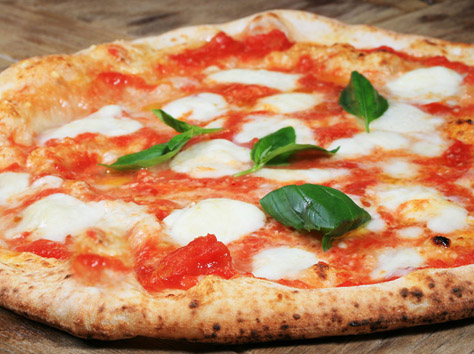
This recipe is about as close as you can get to wood-burning oven-style Neapolitan pizza without having to void the warranty of your oven. The Antimo Caputo Tipo "00" Italian bread flour called for helps improve the texture, but is not necessary. Regular bread flour (of even all-purpose flour) will work just fine.
For best results, use weight measurements, not volume.
Serves: 6
2 teaspoons salt, plus extra for assembly
1 teaspoon active dry yeast
2 teaspoons sugar
12 ounces water
1 (14-ounce) can whole peeled Italian tomatoes
12 ounces buffalo mozzarella or fresh cow's milk mozzarella
6 tablespoons extra virgin olive oil
24 basil leaves
1. Combine flour, salt, yeast, and sugar in the bowl of a stand mixer fitted with a dough hook attachment. Whisk to combine. Add water and knead on low speed just until mixture comes together and no dry flour remains. Allow to rest for 10 minutes. Knead on low speed for an additional ten minutes. The mixture should come together into a cohesive mass that barely sticks to the bottom of the bowl as it kneads. Depending on the type of flour used, you may need to add up to 1/2 cup additional flour. If dough sticks heavily to bottom of bowl, add flour 1 tablespoon at a time with mixer running until it forms a mass that just barely sticks to the bowl. Cover bowl tightly with plastic or transfer the dough to two gallon-sized zipper lock bags, seal, and refrigerate for at least 8 and up to 72 hours.
2. Transfer the dough to a floured work surface and dust the top with additional flour. Using a bench scraper, divide the dough into six even pieces, approximately six ounces each. Using floured hands, shape each piece into a neat ball by gathering the dough towards the bottom. Coat four small containers with non-stick cooking spray or olive oil (large cereal bowls work great for this) and add one dough ball to each bowl. Lightly spray top of dough ball with non-stick cooking spray. Cover tightly with plastic wrap, and allow to rise at room temperature for 2 hours (dough should roughly double in volume).
3. Meanwhile, drain tomatoes in fine meshed strainer and break them up with your fingers, squeezing excess juice out from the interior. Transfer the tomatoes to a blender with a 1/2 teaspoon of kosher salt and blend until smooth. Transfer to a bowl and set aside. Cut the mozzarella into 1/2-inch chunks and place on a plate on a triple layer of paper towels or a clean kitchen towel. Place another triple layer of paper towels or clean dish towel on top of the cheese and stack another plate on top. Allow the excess water to blot out for at least 10 minutes.
4. Transfer 1 ball of dough to a medium bowl filled with flour and flip to coat. Lift it and gently pat off the excess flour. Transfer it to a floured surface and gently stretch it into a 10-inch circle, leaving the outer 1-inch edge slightly thicker than the center. The best way to do this it to start by gently stretching with your fingertips. Pick up the slightly stretched dough and place it on the opened face of your left hand. Toss it back and forth between your opened hands, rotating it slightly with each toss until it stretches out to around 8-inches in diameter. Return it to the work surface. With your left hand flat in the center of the round, use your right hand to stretch the edge of the dough out, rotating as needed until it is an even 10-inches in diameter.
5. Have your tomato sauce, the drained cheese, pizza dough, olive oil, kosher salt, and basil leaves ready and close to the stovetop. Preheat the broiler to high and arrange the rack such that you can just barely fit a 12-inch heavy-bottomed oven-proof cast iron or stainless steel skillet on top of it. Dust skillet with flour, tap out excess, then heat the skillet over high heat and heat until lightly smoking, about three minutes. Transfer one dough round to the skillet. It should fill up the entire bottom surface. Working quickly, spread two tablespoons sauce evenly over the dough, leaving the outer 1-inch border un-sauced. Top with 1/6 of the cheese chunks. Season with kosher salt. Drizzle with 1 tablespoon olive oil, and scatter four basil leaves over the surface. Transfer skillet to broiler and broil until pizza is puffed and darkly charred in spots (this can take anywhere between 1 1/2 to 4 minutes, depending on the strength of your broiler). Return the skillet to the stovetop and cook until the bottom is darkly charred in spots, using a thin metal spatula to peek after about 1 minute (depending on the skillet you use, you may skip this step if the pizza is already charred). Transfer the pizza to a cutting board and serve immediately. Repeat steps 4 and 5 to bake remaining pizzas.
Serves: 6
Preparation time:1 hour
Cooking time:8 minutes
20 ounces (4 cups) Italian tipo 00 flour (see note), plus extra for dusting dough2 teaspoons salt, plus extra for assembly
1 teaspoon active dry yeast
2 teaspoons sugar
12 ounces water
1 (14-ounce) can whole peeled Italian tomatoes
12 ounces buffalo mozzarella or fresh cow's milk mozzarella
6 tablespoons extra virgin olive oil
24 basil leaves
1. Combine flour, salt, yeast, and sugar in the bowl of a stand mixer fitted with a dough hook attachment. Whisk to combine. Add water and knead on low speed just until mixture comes together and no dry flour remains. Allow to rest for 10 minutes. Knead on low speed for an additional ten minutes. The mixture should come together into a cohesive mass that barely sticks to the bottom of the bowl as it kneads. Depending on the type of flour used, you may need to add up to 1/2 cup additional flour. If dough sticks heavily to bottom of bowl, add flour 1 tablespoon at a time with mixer running until it forms a mass that just barely sticks to the bowl. Cover bowl tightly with plastic or transfer the dough to two gallon-sized zipper lock bags, seal, and refrigerate for at least 8 and up to 72 hours.
2. Transfer the dough to a floured work surface and dust the top with additional flour. Using a bench scraper, divide the dough into six even pieces, approximately six ounces each. Using floured hands, shape each piece into a neat ball by gathering the dough towards the bottom. Coat four small containers with non-stick cooking spray or olive oil (large cereal bowls work great for this) and add one dough ball to each bowl. Lightly spray top of dough ball with non-stick cooking spray. Cover tightly with plastic wrap, and allow to rise at room temperature for 2 hours (dough should roughly double in volume).
3. Meanwhile, drain tomatoes in fine meshed strainer and break them up with your fingers, squeezing excess juice out from the interior. Transfer the tomatoes to a blender with a 1/2 teaspoon of kosher salt and blend until smooth. Transfer to a bowl and set aside. Cut the mozzarella into 1/2-inch chunks and place on a plate on a triple layer of paper towels or a clean kitchen towel. Place another triple layer of paper towels or clean dish towel on top of the cheese and stack another plate on top. Allow the excess water to blot out for at least 10 minutes.
4. Transfer 1 ball of dough to a medium bowl filled with flour and flip to coat. Lift it and gently pat off the excess flour. Transfer it to a floured surface and gently stretch it into a 10-inch circle, leaving the outer 1-inch edge slightly thicker than the center. The best way to do this it to start by gently stretching with your fingertips. Pick up the slightly stretched dough and place it on the opened face of your left hand. Toss it back and forth between your opened hands, rotating it slightly with each toss until it stretches out to around 8-inches in diameter. Return it to the work surface. With your left hand flat in the center of the round, use your right hand to stretch the edge of the dough out, rotating as needed until it is an even 10-inches in diameter.
5. Have your tomato sauce, the drained cheese, pizza dough, olive oil, kosher salt, and basil leaves ready and close to the stovetop. Preheat the broiler to high and arrange the rack such that you can just barely fit a 12-inch heavy-bottomed oven-proof cast iron or stainless steel skillet on top of it. Dust skillet with flour, tap out excess, then heat the skillet over high heat and heat until lightly smoking, about three minutes. Transfer one dough round to the skillet. It should fill up the entire bottom surface. Working quickly, spread two tablespoons sauce evenly over the dough, leaving the outer 1-inch border un-sauced. Top with 1/6 of the cheese chunks. Season with kosher salt. Drizzle with 1 tablespoon olive oil, and scatter four basil leaves over the surface. Transfer skillet to broiler and broil until pizza is puffed and darkly charred in spots (this can take anywhere between 1 1/2 to 4 minutes, depending on the strength of your broiler). Return the skillet to the stovetop and cook until the bottom is darkly charred in spots, using a thin metal spatula to peek after about 1 minute (depending on the skillet you use, you may skip this step if the pizza is already charred). Transfer the pizza to a cutting board and serve immediately. Repeat steps 4 and 5 to bake remaining pizzas.
Main Nicoise orzo salad 
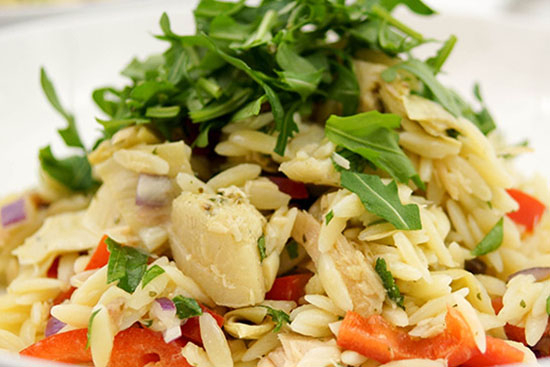
Serves: 4
Preparation time: 20 minutes
Cooking time:25 minutes
1 cup long grain orzo 1/2 pound green beans cut into 1/2-inch pieces
For dressing:
3 teaspoons red wine vinegar
1 teaspoon lemon juice
4 anchovy fillets, chopped
1 teaspoon dijon mustard
1 garlic clove, minced
1/3 cup virgin olive oil
1/4 teaspoon ground black pepper
6 ounce jar artichoke hearts, drained and chopped
7 ounce can tuna, drained, flaked
1 red bell pepper, chopped
1/2 cup chopped red onion
1 1/2 teaspoons minced fresh thyme leaves
1/3 cup kalamata or brined-cured black olives, chopped
2 cups chopped arugala, washed and spun dry
Cook orzo in salted boiling water until tender. Drain in a colander, and rinse under cold water. Drain again.
Transfer to a large bowl. Cook beans in salted boiling water until crisp-tender. Cool and drain. Add to orzo.
In a blender, combine Red wine vinegar, Lemon juice, anchovy fillets, Dijon mustard, garlic clove, olive oil, and pepper. Blend until dressing is smooth. Add dressing to orzo mixture. Blend in the remaining ingredients. Serve as a main course.
Transfer to a large bowl. Cook beans in salted boiling water until crisp-tender. Cool and drain. Add to orzo.
In a blender, combine Red wine vinegar, Lemon juice, anchovy fillets, Dijon mustard, garlic clove, olive oil, and pepper. Blend until dressing is smooth. Add dressing to orzo mixture. Blend in the remaining ingredients. Serve as a main course.
Main Onion and cheese frittata 
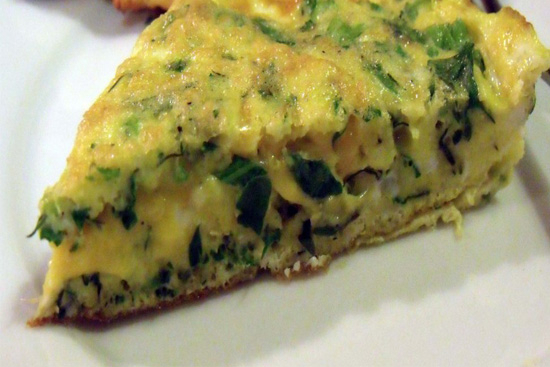
Serves: 6
Preparation time: 15 minutes
Cooking time:20 minutes
8 large eggs1/2 cup finely grated Parmesan
3 large fresh basil leaves, torn into pieces
3 large fresh sage leaves, minced
1 tsp. minced fresh rosemary
1/4 tsp. kosher salt
1/8 tsp. freshly ground black pepper
3 Tbsp. extra-virgin olive oil
1 cup thinly sliced onion
1 cup diced Fontina cheese
Preheat oven to 400°. Whisk first 7 ingredients in a medium bowl; set aside. Heat oil in a medium ovenproof nonstick skillet over medium-high heat. Add onion; sauté until soft, about 6 minutes. Reduce heat to low. Stir in egg mixture. Spoon diced cheese evenly over.
Cook until frittata begins to set, about 2 minutes. Place in oven; bake until just set, 7-9 minutes. Slide the frittata onto a platter. Cut into wedges; serve hot or at room temperature.
Cook until frittata begins to set, about 2 minutes. Place in oven; bake until just set, 7-9 minutes. Slide the frittata onto a platter. Cut into wedges; serve hot or at room temperature.
Main Orecchiette with shiitake mushroom sauce 
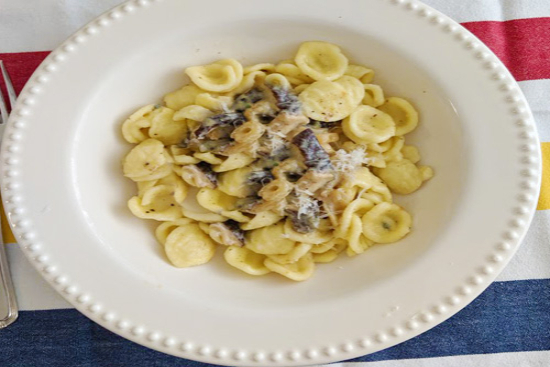
Little ears. That’s the literal translation of orecchiette. Orecchiette pasta was invented as a way to use every last bit of pasta dough.
Finely grated dried shiitake adds a big umami boost to this simple pasta.
Serves: 4
4 shallots, finely minced
4 cloves garlic, minced
salt and pepper, to season
150ml cream
400g dried orecchiette pasta
150g shiitake mushrooms
2 tbsp finely chopped chives
1/4 cup grated parmesan cheese
Dried shiitake mushrooms
Serves: 4
Preparation time: 15 minutes
Cooking time:20 minutes
4 tbsp extra virgin olive oil4 shallots, finely minced
4 cloves garlic, minced
salt and pepper, to season
150ml cream
400g dried orecchiette pasta
150g shiitake mushrooms
2 tbsp finely chopped chives
1/4 cup grated parmesan cheese
Dried shiitake mushrooms
1. Heat the olive oil in a large frying pan over a medium heat and cook the shallots and garlic until fragrant. Add the mushrooms. Season well with salt and pepper and fry, stirring occasionally, for about 10 minutes until very well browned.
2. Add the cream and simmer for 5 minutes.
3. While the mushrooms are cooking, cook the pasta according to the packet instructions until just al dente. Drain well and add to the simmering mushrooms, tossing to coat in the sauce for just a minute or two.
4. Divide the pasta among warm serving plates and, using a rasp grater, scatter the dried shiitake mushrooms on top. Finish with the chives and parmesan cheese and serve.
2. Add the cream and simmer for 5 minutes.
3. While the mushrooms are cooking, cook the pasta according to the packet instructions until just al dente. Drain well and add to the simmering mushrooms, tossing to coat in the sauce for just a minute or two.
4. Divide the pasta among warm serving plates and, using a rasp grater, scatter the dried shiitake mushrooms on top. Finish with the chives and parmesan cheese and serve.
Main Orzo pilaf with green onions 
Serves: 6
Preparation time: 10 minutes
Cooking time:20 minutes
3 1/4 cups low salt chicken broth 1 pound orzo
5 green onions, thinly sliced
3/4 cup grated Parmesan cheese
Bring broth to boil in heavy large saucepan over medium-high heat. Mix in orzo and simmer uncovered until just tender but still firm to bite and some broth still remains, stirring occasionally.
Remove from heat. Add green onions and cheese and stir to blend. Season pilaf to taste with salt and pepper.
Rewarm over low heat, if necessary, and mix in more broth by 1/4 cupfuls if pilaf is dry. Transfer to large bowl and serve.
Remove from heat. Add green onions and cheese and stir to blend. Season pilaf to taste with salt and pepper.
Rewarm over low heat, if necessary, and mix in more broth by 1/4 cupfuls if pilaf is dry. Transfer to large bowl and serve.
Main Orzo salad with lemon and herb 
Serves: 4
Preparation time: 10 minutes
Cooking time:15 minutes
1 cup orzo pasta 2 tablespoons chopped dill
2 tablespoons chopped parsley
2 tablespoons chopped green onion
1 tablespoon olive oil
1/2 teaspoon grated lemon rind
1 2 tablespoon lemon juice
salt and pepper
In large pot of boiling salted water, cook orzo until tender but firm; drain well.
Toss with dill, parsley, onions, oil, lemon rind and juice. Season with salt and pepper to taste.
Toss with dill, parsley, onions, oil, lemon rind and juice. Season with salt and pepper to taste.
Main Panzanella salad 
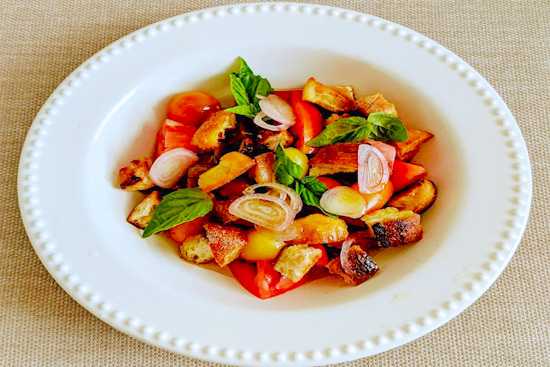
Panzanella salad, the perfect way to use up day-old bread!
People of the Mediterranean have a knack for using day-old stale bread.
Panzanella salad consists of hearty Italian bread, tomatoes, shallots and basil, tossed in a light and tangy dressing. If you like, add fresh mozzarella cheese.
Serves: 4
6 tablespoons extra-virgin olive oil, more to taste
1/2 teaspoon sea salt, more to taste
2 pounds very ripe tomatoes, preferably a mix of varieties and colors
1/4 cup red wine vinegar
2 garlic cloves minced
1/2 tsp Dijon mustard
Black pepper
1/2 cup thinly sliced red onion or shallot
1/2 cup packed fresh basil torn
Serves: 4
Preparation time:15 minutes
Cooking time:10 minutes
5 oz or ½ loaf of a rustic Italian bread or baguette, preferably stale cut into 1-inch cubes (about 3 cups)6 tablespoons extra-virgin olive oil, more to taste
1/2 teaspoon sea salt, more to taste
2 pounds very ripe tomatoes, preferably a mix of varieties and colors
1/4 cup red wine vinegar
2 garlic cloves minced
1/2 tsp Dijon mustard
Black pepper
1/2 cup thinly sliced red onion or shallot
1/2 cup packed fresh basil torn
Heat oven to 425 degrees. Spread the bread cubes on a rimmed baking sheet and toss with 2 tablespoons oil. Bake until they are golden brown at the edges, about 7 to 15 minutes. Let cool on a wire rack.
Cut tomatoes into bite-size pieces and transfer to a large bowl. Add onions, garlic, 1 tablespoon vinegar, 1/4 teaspoon salt. Toss to coat and set aside.
In a medium bowl, combine remaining 1 tablespoon vinegar, the mustard, 1/4 teaspoon salt and some black pepper to taste. While whisking constantly, slowly drizzle in the remaining 4 tablespoons olive oil until the mixture is thickened. Stir in basil.
Add bread cubes to the tomatoes and toss well. Let sit for at least 30 minutes before serving. Toss with a little more olive oil, vinegar and salt if needed just before serving.
Cut tomatoes into bite-size pieces and transfer to a large bowl. Add onions, garlic, 1 tablespoon vinegar, 1/4 teaspoon salt. Toss to coat and set aside.
In a medium bowl, combine remaining 1 tablespoon vinegar, the mustard, 1/4 teaspoon salt and some black pepper to taste. While whisking constantly, slowly drizzle in the remaining 4 tablespoons olive oil until the mixture is thickened. Stir in basil.
Add bread cubes to the tomatoes and toss well. Let sit for at least 30 minutes before serving. Toss with a little more olive oil, vinegar and salt if needed just before serving.
Main Parmesan and basil chicken salad 
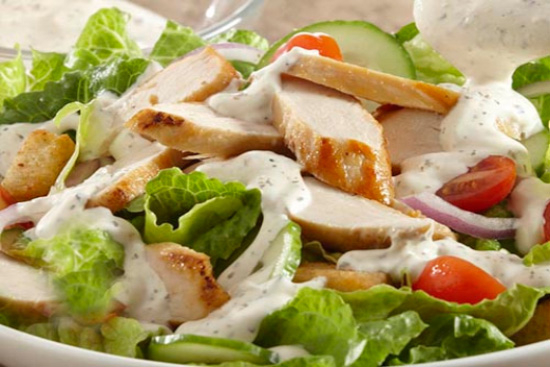
Serves: 4
Preparation time: 20 minutes
Cooking time:40 minutes
2 whole chicken breasts, on the bone, with the skin salt and freshly ground pepper to taste
1 tablespoon olive oil
1 cup mayonnaise
1 cup fresh basil, finely chopped
2 garlic cloves, finely chopped
2 tablespoons pine nuts
4 large celery ribs, peeled and coarsely chopped
2/3 cup Parmesan cheese, freshly grated
1 bunch of watercress, large stems removed
Preheat oven to 375 degrees. Season the chicken with salt and pepper. Place in a skillet with oil and roast until juices run clear, about 35 minutes. Let cool. Discard the chicken skin and remove the meat from the bones. Cut the chicken into small strips and transfer to a large bowl.
Puree the mayonnaise, basil, garlic and pine nuts. Add to the chicken with celery and cheese and toss well.
Season with salt and pepper and serve with watercress or arugula.
Puree the mayonnaise, basil, garlic and pine nuts. Add to the chicken with celery and cheese and toss well.
Season with salt and pepper and serve with watercress or arugula.
Main Parmesan polenta soufflé 
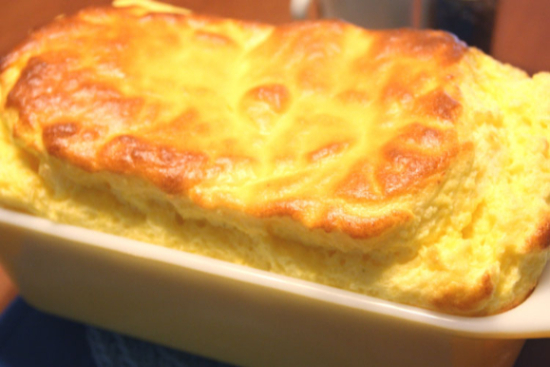
Reggiano parmesan cheese and polenta are the foundation of this fine soufflé. I Accompany this soufflé with a Marinara sauce with basil.
Serves: 6
1 teaspoon unsalted butter
2 teaspoons grated parmesan cheese (Reggiano)
1 1/2 cups water
1 teaspoon olive oil
4 teaspoons polenta
5 large egg yolks
1 1/3 cups grated parmesan cheese (Reggiano)
1/2 teaspoon salt
freshly ground white pepper to taste
5 large egg whites
1/4 teaspoon cream of tartar
Serves: 6
Preparation time: 40 minutes
Cooking time:30 minutes
You will need a 6-cup soufflé mold 1 teaspoon unsalted butter
2 teaspoons grated parmesan cheese (Reggiano)
1 1/2 cups water
1 teaspoon olive oil
4 teaspoons polenta
5 large egg yolks
1 1/3 cups grated parmesan cheese (Reggiano)
1/2 teaspoon salt
freshly ground white pepper to taste
5 large egg whites
1/4 teaspoon cream of tartar
Butter a 6 cup soufflé mold and dust it with two tablespoons of the cheese. Set aside.
In a medium pot, bring water with the olive oil to a simmer over medium heat. Add the polenta in a slow, steady stream, stirring constantly. Cook the polenta At medium-high heat, stirring for about 10 minutes, until the mixture has the consistency of a thick white sauce. Remove from heat. Beat in the egg yolks one at the time. Stir in all but a tablespoon of the cheese. Season with salt and pepper.
The soufflé can be prepared in advance up to this point.
About 40 minutes before serving, preheat the oven to 425 degrees.
Beat the egg whites with cream of tartar until they hold a firm peak, but are Still creamy. Stir one quarter of the egg whites into the cornmeal mixture. Then fold the polenta mixture into the remaining egg whites. Spoon the mixture into the prepared soufflé dish and smooth the top. Sprinkle it with the remaining cheese.
Bake for 25 to 30 minutes, until the soufflé is puffed, browned and firm. Serve At once.
In a medium pot, bring water with the olive oil to a simmer over medium heat. Add the polenta in a slow, steady stream, stirring constantly. Cook the polenta At medium-high heat, stirring for about 10 minutes, until the mixture has the consistency of a thick white sauce. Remove from heat. Beat in the egg yolks one at the time. Stir in all but a tablespoon of the cheese. Season with salt and pepper.
The soufflé can be prepared in advance up to this point.
About 40 minutes before serving, preheat the oven to 425 degrees.
Beat the egg whites with cream of tartar until they hold a firm peak, but are Still creamy. Stir one quarter of the egg whites into the cornmeal mixture. Then fold the polenta mixture into the remaining egg whites. Spoon the mixture into the prepared soufflé dish and smooth the top. Sprinkle it with the remaining cheese.
Bake for 25 to 30 minutes, until the soufflé is puffed, browned and firm. Serve At once.
Main Pasta and tuna with caper dressing 
Serves: 6
Preparation time: 15 minutes
Cooking time:20 minutes
12 ounces pasta shells 8 ounces can white tuna
1 medium red pepper, thinly sliced
8 ounces broccoli florets
1/2 cup grated parmesan
1/4 cup shredded basil
For caper dressing:
1/2 cup olive oil
3 teaspoons red wine vinegar
2 teaspoons drained capers
1 teaspoon dried oregano
2 cloves minced garlic
3/4 teaspoon salt
1/4 teaspoon ground white pepper
Cook pasta until al dente, drain, rinse under cold water until chilled, drain well.
Drop broccoli florets into boiling salted water and cook for 2 minutes. Drain and rinse under cold water to stop the cooking; drain well again. Flake the tuna.
Combine with pasta, broccoli and pepper. Blend in dressing and remaining ingredients.
Season to taste with salt and pepper.
Caper dressing :
Combine all ingredients in a mixing bowl. Stir to blend
Drop broccoli florets into boiling salted water and cook for 2 minutes. Drain and rinse under cold water to stop the cooking; drain well again. Flake the tuna.
Combine with pasta, broccoli and pepper. Blend in dressing and remaining ingredients.
Season to taste with salt and pepper.
Caper dressing :
Combine all ingredients in a mixing bowl. Stir to blend
Main Pasta e fagioli with pesto and butternut squash 
Wonderful, hearty soup.
a recipe inspired by finecooking.com
Serves: 6
2 Tbs. extra-virgin olive oil
1 cup chopped yellow onion
2-1/2 cups diced (1/2 to 3/4 inch) butternut squash
2 Tbs. chopped fresh flat-leaf parsley
1 Tbs. chopped fresh sage
2 medium cloves garlic, minced
1/2 tsp. crushed red pepper flakes
2 Tbs. tomato paste
1/2 cup dry white wine
4 cups vegetable broth
1 15-oz. can kidney beans (white or red), or Roman beans, rinsed and drained (1-3/4 cups)
1 14-oz. can crushed peeled tomatoes with juice
Freshly ground black pepper
For the pesto:
1 packed cup fresh flat-leaf parsley leaves, coarsely chopped
2 Tbsp coarsely chopped fresh sage
1 medium clove garlic, chopped
1/2 cup Parmigiano-Reggiano or Grana Padano, coarsely grated; more, finely grated, for serving
Sea salt and freshly ground black pepper
6 Tbsp extra-virgin olive oil
Serves: 6
Preparation time: 20 minutes
Cooking time:30 minutes
6 oz. orrechiette or small shells, or other small pasta2 Tbs. extra-virgin olive oil
1 cup chopped yellow onion
2-1/2 cups diced (1/2 to 3/4 inch) butternut squash
2 Tbs. chopped fresh flat-leaf parsley
1 Tbs. chopped fresh sage
2 medium cloves garlic, minced
1/2 tsp. crushed red pepper flakes
2 Tbs. tomato paste
1/2 cup dry white wine
4 cups vegetable broth
1 15-oz. can kidney beans (white or red), or Roman beans, rinsed and drained (1-3/4 cups)
1 14-oz. can crushed peeled tomatoes with juice
Freshly ground black pepper
For the pesto:
1 packed cup fresh flat-leaf parsley leaves, coarsely chopped
2 Tbsp coarsely chopped fresh sage
1 medium clove garlic, chopped
1/2 cup Parmigiano-Reggiano or Grana Padano, coarsely grated; more, finely grated, for serving
Sea salt and freshly ground black pepper
6 Tbsp extra-virgin olive oil
Make the soup
Bring a large pot of water to a boil, and cook the pasta according to package directions until not quite al dente.
Meanwhile, heat the oil in a 5- to 6-quart Dutch oven or other heavy-duty pot over medium heat until shimmering. Add the onion and 1/4 tsp. salt; cook, stirring occasionally, until starting to brown, 3 to 5 minutes. Add the squash and stir to coat with the oil. Add the parsley, sage, garlic, and pepper flakes, and cook, stirring, until fragrant, about 30 seconds.
Add the tomato paste and cook, stirring, until it is evenly distributed and looks slightly darker, 1 to 2 minutes. Add the wine and cook until almost evaporated, about 1 minute. Add the broth, beans, and tomatoes. Stir well, scraping the bottom of the pot, and simmer until the squash is barely tender, 13 to 15 minutes. Add the pasta and continue simmering until the squash and pasta are tender, 1 to 2 minutes. Remove from the heat.
Make the pesto and serve
Put the parsley, sage, garlic, and coarsely grated cheese in a food processor. Sprinkle with 1/4 tsp. salt and 1/4 tsp. pepper and drizzle with the oil. Pulse until finely chopped, adding more oil if necessary to give it consistency. Season to taste with salt and pepper, and transfer to a bowl.
Thin the soup with water if desired and add 1/4 tsp. pepper. Season to taste with more salt and pepper. Divide among soup bowls and spoon 1 to 2 Tbsp pesto on top of each serving. Pass the finely grated cheese at the table.
Bring a large pot of water to a boil, and cook the pasta according to package directions until not quite al dente.
Meanwhile, heat the oil in a 5- to 6-quart Dutch oven or other heavy-duty pot over medium heat until shimmering. Add the onion and 1/4 tsp. salt; cook, stirring occasionally, until starting to brown, 3 to 5 minutes. Add the squash and stir to coat with the oil. Add the parsley, sage, garlic, and pepper flakes, and cook, stirring, until fragrant, about 30 seconds.
Add the tomato paste and cook, stirring, until it is evenly distributed and looks slightly darker, 1 to 2 minutes. Add the wine and cook until almost evaporated, about 1 minute. Add the broth, beans, and tomatoes. Stir well, scraping the bottom of the pot, and simmer until the squash is barely tender, 13 to 15 minutes. Add the pasta and continue simmering until the squash and pasta are tender, 1 to 2 minutes. Remove from the heat.
Make the pesto and serve
Put the parsley, sage, garlic, and coarsely grated cheese in a food processor. Sprinkle with 1/4 tsp. salt and 1/4 tsp. pepper and drizzle with the oil. Pulse until finely chopped, adding more oil if necessary to give it consistency. Season to taste with salt and pepper, and transfer to a bowl.
Thin the soup with water if desired and add 1/4 tsp. pepper. Season to taste with more salt and pepper. Divide among soup bowls and spoon 1 to 2 Tbsp pesto on top of each serving. Pass the finely grated cheese at the table.
Main Pasta fagioli 
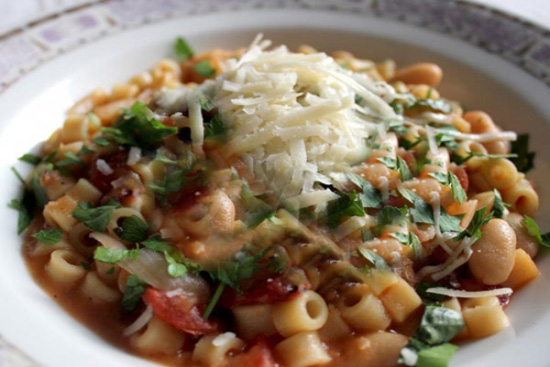
To expedite the recipe use cooked Italian white beans.
Serves: 6
1 medium diced onion
1 large carrot, diced
2 celery ribs
1 tablespoon olive oil
3 quarts chicken stock
3/4 pound small orecchiette or small macaroni
Italian parsley,chopped
optional condiments:
2 cups stemmed arugala
4 plum tomatoes
2 teaspoons extra virgin olive oil
2 teaspoons red wine vinegar
1/4 teaspoon kosher salt
French baguette, sliced
1 tablespoon olive oil
2 tablespoons grated Parmesan
Serves: 6
Preparation time: 20 minutes
Cooking time:2 hours 30 minutes
2 cups dried white bean 1 medium diced onion
1 large carrot, diced
2 celery ribs
1 tablespoon olive oil
3 quarts chicken stock
3/4 pound small orecchiette or small macaroni
Italian parsley,chopped
optional condiments:
2 cups stemmed arugala
4 plum tomatoes
2 teaspoons extra virgin olive oil
2 teaspoons red wine vinegar
1/4 teaspoon kosher salt
French baguette, sliced
1 tablespoon olive oil
2 tablespoons grated Parmesan
Soak beans overnight.
In a saucepan sauté diced onion, carrot, and diced celery ribs in 1 tablespoon olive oil until soft.
Add beans, chicken stock, and 3 quarts water. Simmer until beans are soft. 1-1/2 hours to 2 hours.
Season with salt and pepper. Add small orecchiette or small macaroni. Cook until al dente.
Before serving, add chopped Italian parsley.
Condiments :
Cut stemmed arugala into 1/4 inch wide strips, set aside in a bowl. Peel, seed, and dice plum tomatoes, set aside in a bowl.
Also pass extra virgin olive oil, red wine vinegar, and kosher salt with soup, and serve condiments with thin sliced of French baguette, brushed with olive oil and toasted, and freshly grated Parmesan cheese.
In a saucepan sauté diced onion, carrot, and diced celery ribs in 1 tablespoon olive oil until soft.
Add beans, chicken stock, and 3 quarts water. Simmer until beans are soft. 1-1/2 hours to 2 hours.
Season with salt and pepper. Add small orecchiette or small macaroni. Cook until al dente.
Before serving, add chopped Italian parsley.
Condiments :
Cut stemmed arugala into 1/4 inch wide strips, set aside in a bowl. Peel, seed, and dice plum tomatoes, set aside in a bowl.
Also pass extra virgin olive oil, red wine vinegar, and kosher salt with soup, and serve condiments with thin sliced of French baguette, brushed with olive oil and toasted, and freshly grated Parmesan cheese.
Main Pasta roll with three cheese 
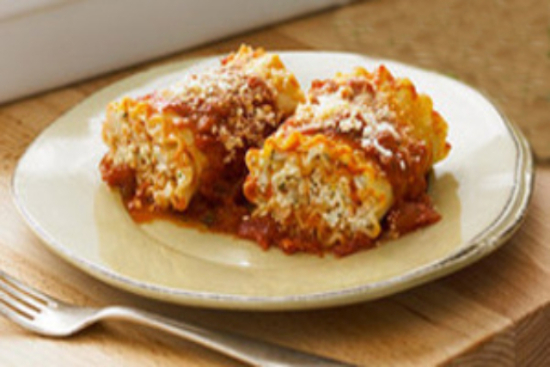
Serves: 6
Preparation time: 30 minutes
Cooking time:25 minutes
2 teaspoons butter 4 medium minced scallions
1/2 cup minced smoked ham
6 ounces soft cream cheese
1/2 cup firm ricotta cheese
1/2 cup grated parmesan
2 eggs
1/2 teaspoon black ground pepper
1-12-inch by 14-inch sheet of pasta
6 thin slices ham
1 1/2 cups marinara sauce
Melt butter in a skillet. Add scallions, and cook over low heat until soft. Combine minced ham, three cheeses, eggs, and scallion. Season with pepper.
Lay the sheet of pasta roll on a sheet pan. Spread one half of cheese mixture over surface of pasta roll.
Cover cheese with the sliced ham. Spread remaining cheese over ham. Roll up pasta, jelly roll style.
Do not roll loosely to avoid water seepage while cooking. Roll pasta in cheese cloth.
Tie each end with string. Poach in boiling water for 25 min. Drain, cool.
Remove cheese cloth. Slice into 1 inch slices. Arrange on hot plate. Serve with marinara.
Lay the sheet of pasta roll on a sheet pan. Spread one half of cheese mixture over surface of pasta roll.
Cover cheese with the sliced ham. Spread remaining cheese over ham. Roll up pasta, jelly roll style.
Do not roll loosely to avoid water seepage while cooking. Roll pasta in cheese cloth.
Tie each end with string. Poach in boiling water for 25 min. Drain, cool.
Remove cheese cloth. Slice into 1 inch slices. Arrange on hot plate. Serve with marinara.
Main Pasta salad in parmesan baskets 

Serves: 4
Preparation time: 20 minutes
Cooking time:20 minutes
4 large green apples, peeled and diced 2 tablespoons lemon juice
2 cups apple cider
1 cup parmigiano-reggiano cheese, grated
2 cups shelled walnuts, 1 cup lightly toasted 1 cup ground fine
2 ounces balsamic vinegar
2 ounces olive oil
kosher salt
black pepper
1 pound arugula, washed and trimmed
1/2 pound red seedless grapes
1/4 cup thinly sliced red onion, soaked in balsamic vinegar
1/2 pound orecciette or shells pasta, cooked, cooled and oiled
4 ounces gorgonzola cheese, crumbled
Salad:
Set aside a little more than 1/2 of apples in bowl with water and lemon juice.
Place remaining apples in small saucepan with cider.
Bring to a boil. Reduce heat and simmer until apples are tender. Remove apples from heat, strain (reserving cider) and purée.
Dressing:
Combine 4 ounces of purée with oil and vinegar. Add salt, pepper and about 2 ounces reserved cider to taste.
Drain remaing apples and toss together with walnuts, pasta, grapes, arugula, onions and dressing. Serve salad in baskets and top with gorgonzola.
Baskets:
Place a non-stick 9"sauté pan over low heat. Sprinkle bottom of pan with 1/4 cup Parmigiano to cover surface (cheese will melt), then with 1/4 cup ground walnuts.
When edges of crêpes are golden brown, peel away from pan with rubber spatula and invert slowly into 6-7" bowl to form basket.
If it tears, place back in pan with a bit more cheese to seal. Basket will crisp within seconds. Repeat to make 4 baskets.
Set aside a little more than 1/2 of apples in bowl with water and lemon juice.
Place remaining apples in small saucepan with cider.
Bring to a boil. Reduce heat and simmer until apples are tender. Remove apples from heat, strain (reserving cider) and purée.
Dressing:
Combine 4 ounces of purée with oil and vinegar. Add salt, pepper and about 2 ounces reserved cider to taste.
Drain remaing apples and toss together with walnuts, pasta, grapes, arugula, onions and dressing. Serve salad in baskets and top with gorgonzola.
Baskets:
Place a non-stick 9"sauté pan over low heat. Sprinkle bottom of pan with 1/4 cup Parmigiano to cover surface (cheese will melt), then with 1/4 cup ground walnuts.
When edges of crêpes are golden brown, peel away from pan with rubber spatula and invert slowly into 6-7" bowl to form basket.
If it tears, place back in pan with a bit more cheese to seal. Basket will crisp within seconds. Repeat to make 4 baskets.
Main Pasta with summer vegetables 
Serves: 6
Preparation time: 15 minutes
Cooking time:20 minutes
1 pound fusilli or rotini 2 tablespoons olive oil
4 cups small zucchini (quartered lengthwise and sliced)
1 clove garlic, minced
4 cups chopped tomatoes
1/4 cup white wine
1/3 cup chopped fresh basil
1/4 cup chopped fresh chives
1/4 cup chopped flat leaf parsley
2 tablespoons chopped fresh marjoram
salt and pepper to taste
freshly grated Parmesan cheese
Cook pasta in salted boiling water until tender but firm; drain and keep hot.
Meanwhile, in large skillet over medium heat, heat oil. Add zucchini and garlic; cook for 5 minutes, stirring frequently.
Add tomatoes and wine, cook, stirring frequently, for 5 minutes or until sauce thickens.
Stir in herbs; simmer for 5 minutes. Season with salt and pepper. Toss sauce with hot pasta. Serve immediately, with Parmesan cheese for sprinkling on top.
Meanwhile, in large skillet over medium heat, heat oil. Add zucchini and garlic; cook for 5 minutes, stirring frequently.
Add tomatoes and wine, cook, stirring frequently, for 5 minutes or until sauce thickens.
Stir in herbs; simmer for 5 minutes. Season with salt and pepper. Toss sauce with hot pasta. Serve immediately, with Parmesan cheese for sprinkling on top.
Main Penne in cream sauce and sausage 
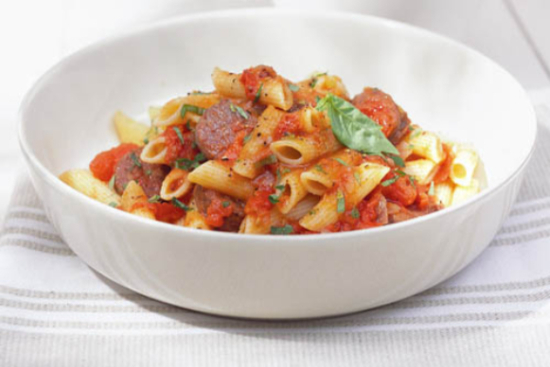
Serves: 6
Preparation time: 20 minutes
Cooking time:30 minutes
1 tablespoon butter 1 tablespoon olive oil
1 medium onion, thinly sliced
3 garlic cloves, minced
1 pound sweet Italian sausage, casings removed
1 cup dry white wine
1 14-ounce can diced peeled tomatoes with juices
1 cup whipping cream
6 tablespoons chopped Italian parsley
1 pound penne pasta
1 cup freshly grated Parmesan cheese
Melt butter with oil in heavy large skillet over medium-high heat. Add onion and garlic and sauté until golden brown and tender, about 7 minutes.
Add sausage and sauté until golden brown and cooked through, breaking up with back of spoon, about 7 minutes.
Drain any excess drippings from skillet. Add wine to skillet and boil until almost all liquid evaporates, about 5 minutes. Add tomatoes with juices and simmer 5 minutes. Add cream and simmer until sauce thickens slightly, about 5 minutes. Stir in 4 tablespoons parsley. Season to taste with salt and pepper.
Remove from heat. (Sauce can be prepared 1 day ahead. Cover and refrigerate.)
Cook pasta in large pot of boiling salted water until tender but still firm to bite.
Drain pasta; transfer to large bowl. Bring sauce to simmer. Pour sauce over pasta. Add 1/2 cup cheese and toss to coat. Sprinkle with remaining 1/2 cup cheese and 2 tablespoons parsley.
Add sausage and sauté until golden brown and cooked through, breaking up with back of spoon, about 7 minutes.
Drain any excess drippings from skillet. Add wine to skillet and boil until almost all liquid evaporates, about 5 minutes. Add tomatoes with juices and simmer 5 minutes. Add cream and simmer until sauce thickens slightly, about 5 minutes. Stir in 4 tablespoons parsley. Season to taste with salt and pepper.
Remove from heat. (Sauce can be prepared 1 day ahead. Cover and refrigerate.)
Cook pasta in large pot of boiling salted water until tender but still firm to bite.
Drain pasta; transfer to large bowl. Bring sauce to simmer. Pour sauce over pasta. Add 1/2 cup cheese and toss to coat. Sprinkle with remaining 1/2 cup cheese and 2 tablespoons parsley.
Main Pissaladière Provençale 
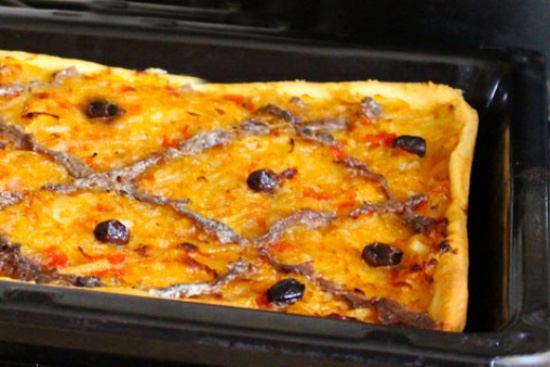
Pissaladiere Provençale, a savory pie, is a close cousin to the pizza.
Pissaladiere, which got its name from pissala, a fish paste made from anchovies, is typically served as a French hors d'oeuvre.
Serves: 8
1 package active dry yeast
3/4 cup warm water (110 degrees F.)
1/2 teaspoon sugar
1 tablespoon olive oil
1 3/4 cups flour
3/4 teaspoon salt
3 tablespoons additional flour for kneading
Onion Filling:
2 pounds (about 5) large yellow onions, peeled, and very thinly sliced to yield 8 cups
1/4 cup olive oil
1 tablespoon butter
3 garlic cloves, peeled and minced
1 teaspoon kosher salt
1/3 cup water
1 sprig fresh thyme (or 1/4 teaspoon dried)
about 2 dozen flat anchovy fillets, oil drained
3 dozen Nicoise olives, pitted and halved lengthwise
1/2 teaspoon fresh ground pepper
Serves: 8
Preparation time:30 minutes
Cooking time:50 minutes
Dough: 1 package active dry yeast
3/4 cup warm water (110 degrees F.)
1/2 teaspoon sugar
1 tablespoon olive oil
1 3/4 cups flour
3/4 teaspoon salt
3 tablespoons additional flour for kneading
Onion Filling:
2 pounds (about 5) large yellow onions, peeled, and very thinly sliced to yield 8 cups
1/4 cup olive oil
1 tablespoon butter
3 garlic cloves, peeled and minced
1 teaspoon kosher salt
1/3 cup water
1 sprig fresh thyme (or 1/4 teaspoon dried)
about 2 dozen flat anchovy fillets, oil drained
3 dozen Nicoise olives, pitted and halved lengthwise
1/2 teaspoon fresh ground pepper
Electric mixer method:
In a large mixing bowl, sprinkle yeast over water with the sugar. Let proof and soften for about 5 minutes. With paddle attachment, add oil, and stir to blend. Add 1 cup flour and stir until smooth. With dough hook attachment, add remaining 3/4 cup flour and salt and knead until silky smooth and elastic, about 5 minutes.
Food processor method:
Place flour and salt in food processor bowl; process briefly just to blend. Combine oil and yeast mixture, pour down feed tube and process just until mixture is a lumpy mass. Place the mixture on a lightly floured work surface and knead sticky dough for about 5 minutes until satiny and smooth. Knead in no more than three tablespoons additional flour.
Place dough in large bowl, cover and let rise in a warm place away from drafts until doubled in bulk, about 1 hour.
While dough is rising, prepare the filling.
Heat the oil and butter in a large skillet and over medium-low heat saute the onions, garlic and salt until soft and transparent, about 10 to 15 minutes.
Stir occasionally to prevent onions from browning or scorching. Add the water and thyme, and over high heat cook until the water evaporates. Over low heat, continue sauteing about 20 minutes longer, until onion mixture is very soft and translucent. Transfer to a sieve to drain any excess liquid. (yield at this time is 3 cups). Remove sprig of thyme. Set aside to cool.
Adjust the rack in the lower third of the oven and preheat the oven to 425 degrees. Rub 1 tablespoon olive oil over the bottom of a 10 x 15 jelly roll pan or a 12-inch pizza pan.
Punch dough down. With fingertips, press and stretch the dough to fit the pan. If the dough becomes elastic, rest a couple of minutes, then press again. Cover dough loosely with plastic wrap and let rest about 30 minutes or until puffy.
Spread onion filling evenly over risen dough. Place anchovies decoratively over top of tart. Bake for 12 minutes. Rotate pan, and bake until crust is cooked through and golden, about 12 minutes more.
Remove from oven, and using a spatula, transfer tart to a wire rack. Arrange olives decoratively on tart.
Serve warm or room temperature. Cut rectangles, squares or wedges while warm or at room temperature.
For an extra crisp crust, spread filling over dough, and rather than allow time for the dough to rise and become puffy, bake it right away.
For a more bread-like crust, let dough rise in baking pan until puffy, then spread filling on top and bake.
Note: If anchovy fillets taste too salty, rinse them in cold water and dry thoroughly with paper towels.
In a large mixing bowl, sprinkle yeast over water with the sugar. Let proof and soften for about 5 minutes. With paddle attachment, add oil, and stir to blend. Add 1 cup flour and stir until smooth. With dough hook attachment, add remaining 3/4 cup flour and salt and knead until silky smooth and elastic, about 5 minutes.
Food processor method:
Place flour and salt in food processor bowl; process briefly just to blend. Combine oil and yeast mixture, pour down feed tube and process just until mixture is a lumpy mass. Place the mixture on a lightly floured work surface and knead sticky dough for about 5 minutes until satiny and smooth. Knead in no more than three tablespoons additional flour.
Place dough in large bowl, cover and let rise in a warm place away from drafts until doubled in bulk, about 1 hour.
While dough is rising, prepare the filling.
Heat the oil and butter in a large skillet and over medium-low heat saute the onions, garlic and salt until soft and transparent, about 10 to 15 minutes.
Stir occasionally to prevent onions from browning or scorching. Add the water and thyme, and over high heat cook until the water evaporates. Over low heat, continue sauteing about 20 minutes longer, until onion mixture is very soft and translucent. Transfer to a sieve to drain any excess liquid. (yield at this time is 3 cups). Remove sprig of thyme. Set aside to cool.
Adjust the rack in the lower third of the oven and preheat the oven to 425 degrees. Rub 1 tablespoon olive oil over the bottom of a 10 x 15 jelly roll pan or a 12-inch pizza pan.
Punch dough down. With fingertips, press and stretch the dough to fit the pan. If the dough becomes elastic, rest a couple of minutes, then press again. Cover dough loosely with plastic wrap and let rest about 30 minutes or until puffy.
Spread onion filling evenly over risen dough. Place anchovies decoratively over top of tart. Bake for 12 minutes. Rotate pan, and bake until crust is cooked through and golden, about 12 minutes more.
Remove from oven, and using a spatula, transfer tart to a wire rack. Arrange olives decoratively on tart.
Serve warm or room temperature. Cut rectangles, squares or wedges while warm or at room temperature.
For an extra crisp crust, spread filling over dough, and rather than allow time for the dough to rise and become puffy, bake it right away.
For a more bread-like crust, let dough rise in baking pan until puffy, then spread filling on top and bake.
Note: If anchovy fillets taste too salty, rinse them in cold water and dry thoroughly with paper towels.
Main Pistou soup 
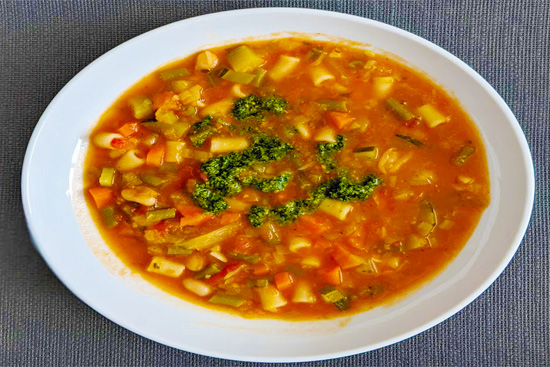
The hearty Provencal soupe au pistou, or pistou soup is a wonderful rustic mediterranean soup full of fresh flavors of the South of France.
Borlotti beans:
A variety of kidney bean, this is a large plump bean that is pinkish-brown in color with reddish-brown streaks. Borlotti beans are widely used in Italian cooking and have a sweetish flavour with a smooth creamy texture. They work well in salads, soups and casseroles. The dried variety needs to be soaked in cold water before cooking.
Serves: 12
1 onion
3 cloves of garlic
3 medium leeks
1 small fennel bulb
3 carrots
1 stick of celery
3 courgettes
2 sprigs of fresh flat-leaf parsley
2 fresh bay leaves
250 g baby green beans
1 x 400 g tin of chopped tomatoes
1 x 400 g tin of cannellini beans
1 x 400 g tin of borlotti beans
70 g small macaroni
PISTOU SAUCE
5 cloves of garlic
6 sprigs of fresh basil
60 g Parmesan cheese
3 tablespoons extra virgin olive oil
Borlotti beans:
A variety of kidney bean, this is a large plump bean that is pinkish-brown in color with reddish-brown streaks. Borlotti beans are widely used in Italian cooking and have a sweetish flavour with a smooth creamy texture. They work well in salads, soups and casseroles. The dried variety needs to be soaked in cold water before cooking.
Serves: 12
Preparation time: 40 minutes
Cooking time:50 minutes
4 tablespoons olive oil1 onion
3 cloves of garlic
3 medium leeks
1 small fennel bulb
3 carrots
1 stick of celery
3 courgettes
2 sprigs of fresh flat-leaf parsley
2 fresh bay leaves
250 g baby green beans
1 x 400 g tin of chopped tomatoes
1 x 400 g tin of cannellini beans
1 x 400 g tin of borlotti beans
70 g small macaroni
PISTOU SAUCE
5 cloves of garlic
6 sprigs of fresh basil
60 g Parmesan cheese
3 tablespoons extra virgin olive oil
Peel and finely chop the onion and garlic, then trim and slice the leek. Chip and chop the fennel, carrots, celery and courgettes, then pick and roughly chop the parsley leaves.
Heat the olive oil in a large saucepan over a medium heat and sauté the onion, garlic and leek for 5 minutes.
Add the other chopped ingredients, the bay, green beans and chopped tomatoes. Drain and add the beans. Cover with water, season and simmer until the vegetables are tender.
Add the pasta and simmer until cooked, adding water if the soup is too thick.
For the pistou sauce, peel and add the garlic to a pestle and mortar, pick in the basil leaves and add some sea salt. Pound until puréed, then finely grate in the Parmesan and muddle in the extra virgin olive oil to make a paste.
Serve the soup with a dollop of pistou.
The pistou sauce can also be made in a food processor or blender,
Heat the olive oil in a large saucepan over a medium heat and sauté the onion, garlic and leek for 5 minutes.
Add the other chopped ingredients, the bay, green beans and chopped tomatoes. Drain and add the beans. Cover with water, season and simmer until the vegetables are tender.
Add the pasta and simmer until cooked, adding water if the soup is too thick.
For the pistou sauce, peel and add the garlic to a pestle and mortar, pick in the basil leaves and add some sea salt. Pound until puréed, then finely grate in the Parmesan and muddle in the extra virgin olive oil to make a paste.
Serve the soup with a dollop of pistou.
The pistou sauce can also be made in a food processor or blender,
Main Pizza margherita 

This is the simple classic pizza If you can't find buffalo mozzarella just use a good quality cow's milk mozzarella.
Also to speed up the prep time, simply use store bought marinara sauce.
Serves: 4
1 envelope (1/4-ounce) active dry yeast
1 teaspoon sugar (5 ml)
⅓ cup lukewarm water (75 ml)
1 ⅓ cups lukewarm water (325 ml)
2 teaspoons coarse salt (10 ml)
¼ cup oilve oil (60 ml)
3 ¾ cups all-purpose flour (925 ml)
flour for kneading and rolling
olive oil for oiling the bowl (15 ml)
Sauce
3 tablespoons olive oil (45 ml)
1 cloves garlic, chopped
2 28 ounce cans whole plum tomatoes, preferably San Marzano tomatoes (1592 ml)
Coarse salt and freshly cracked black pepper, to taste
Toppings
4 balls buffalo mozzarella, sliced into 1/4-inch thick rounds (about 1 pound/454 grams)
1 small bunch fresh basil leaves, shredded (roughly 24 basil leaves)
Coarse salt and freshly cracked black pepper, to taste
pinch red chile flakes, optional
olive oil, for drizzling on the pizza
Serves: 4
Preparation time: 1 hour 30 minutes
Cooking time:12 minutes
Dough1 envelope (1/4-ounce) active dry yeast
1 teaspoon sugar (5 ml)
⅓ cup lukewarm water (75 ml)
1 ⅓ cups lukewarm water (325 ml)
2 teaspoons coarse salt (10 ml)
¼ cup oilve oil (60 ml)
3 ¾ cups all-purpose flour (925 ml)
flour for kneading and rolling
olive oil for oiling the bowl (15 ml)
Sauce
3 tablespoons olive oil (45 ml)
1 cloves garlic, chopped
2 28 ounce cans whole plum tomatoes, preferably San Marzano tomatoes (1592 ml)
Coarse salt and freshly cracked black pepper, to taste
Toppings
4 balls buffalo mozzarella, sliced into 1/4-inch thick rounds (about 1 pound/454 grams)
1 small bunch fresh basil leaves, shredded (roughly 24 basil leaves)
Coarse salt and freshly cracked black pepper, to taste
pinch red chile flakes, optional
olive oil, for drizzling on the pizza
Dough
In a small bowl, add 1/3 cup lukewarm water and 1 tsp. sugar. Add yeast and let sit until foamy, about 5 to 10 minutes.
Combine 3 ¾ all-purpose flour and salt in the bowl of a stand mixer. In a stand mixer fitted with a dough blade, add water, olive and yeast mixture and blend. Knead on low speed for about 10 to 12 minutes until the dough comes together and is smooth. Remove dough from the bowl. Turn dough onto a well-floured surface and continue knead by hand until smooth and elastic, about 2 to 5 minutes. The dough should be soft but not sticky. If dough is still too sticky, add a little more flour. Place the dough in a lightly oiled medium bowl and cover. Let rest in a warm spot until doubled, about 45 to 60 minutes.
Sauce
Drain the tomatoes in a strainer to remove excess liquid. Process the tomatoes in a food mill over a medium bowl. Discard excess liquid or keep to make a soup.
Heat olive oil in a medium saucepan on medium-low heat. Add the garlic and sauté 2 minutes or until softened. Add tomatoes and simmer for 10 minutes. Season the sauce with salt and pepper. Set sauce aside. Let cool to room temperature.
Toppings
Preheat oven to 500 degrees F.
Place a pizza stone on the bottom rack of oven when oven begins to preheat. Heat according to manufacturer’s directions.
Punch down dough. Divide dough into 4 balls. Using your hands, stretch and pull (or alternatively roll with a rolling pin) each ball of dough into 10 to 12-inch rounds depending on how thin you want your crust.
Sprinkle some flour onto a pizza paddle (if you don’t have a paddle, you can sprinkle flour on pizza pans or baking sheets). Place a round of dough onto the pizza paddle or pan. Evenly spoon over tomato sauce and basil and cheese. Season the pizzas with salt and pepper and chile flakes, if desired. Drizzle with olive oil. Transfer the pizza to the preheated pizza stone. Bake until topping is bubbly and crust is golden brown, about 8 to 10 minutes. Repeat with remaining rounds of dough.
In a small bowl, add 1/3 cup lukewarm water and 1 tsp. sugar. Add yeast and let sit until foamy, about 5 to 10 minutes.
Combine 3 ¾ all-purpose flour and salt in the bowl of a stand mixer. In a stand mixer fitted with a dough blade, add water, olive and yeast mixture and blend. Knead on low speed for about 10 to 12 minutes until the dough comes together and is smooth. Remove dough from the bowl. Turn dough onto a well-floured surface and continue knead by hand until smooth and elastic, about 2 to 5 minutes. The dough should be soft but not sticky. If dough is still too sticky, add a little more flour. Place the dough in a lightly oiled medium bowl and cover. Let rest in a warm spot until doubled, about 45 to 60 minutes.
Sauce
Drain the tomatoes in a strainer to remove excess liquid. Process the tomatoes in a food mill over a medium bowl. Discard excess liquid or keep to make a soup.
Heat olive oil in a medium saucepan on medium-low heat. Add the garlic and sauté 2 minutes or until softened. Add tomatoes and simmer for 10 minutes. Season the sauce with salt and pepper. Set sauce aside. Let cool to room temperature.
Toppings
Preheat oven to 500 degrees F.
Place a pizza stone on the bottom rack of oven when oven begins to preheat. Heat according to manufacturer’s directions.
Punch down dough. Divide dough into 4 balls. Using your hands, stretch and pull (or alternatively roll with a rolling pin) each ball of dough into 10 to 12-inch rounds depending on how thin you want your crust.
Sprinkle some flour onto a pizza paddle (if you don’t have a paddle, you can sprinkle flour on pizza pans or baking sheets). Place a round of dough onto the pizza paddle or pan. Evenly spoon over tomato sauce and basil and cheese. Season the pizzas with salt and pepper and chile flakes, if desired. Drizzle with olive oil. Transfer the pizza to the preheated pizza stone. Bake until topping is bubbly and crust is golden brown, about 8 to 10 minutes. Repeat with remaining rounds of dough.
Main Polenta a la romaine 
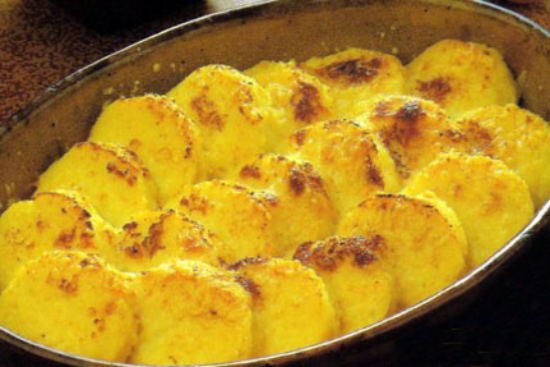
Serves: 8
Preparation time: 20 minutes
Cooking time:30 minutes
1 quart milk 3 ounces butter
1/2 teaspoon salt
1/4 teaspoon ground white pepper
1/4 teaspoon grated nutmeg
1 cup polenta
2 eggs
3 egg yolks
1/2 cup grated Swiss cheese
1 cup A recipe of Cream sauce
1/2 cup grated Parmesan
In a saucepan, combine the milk, butter, salt, pepper, nutmeg, and polenta. Cook slowly over medium heat for 8 to 10 minutes while stirring continuously.
Stir in the eggs and egg yolks. Continue cooking for a minute while stirring with a wooden spoon. Mix in the cheese.
Line an 8-inch by 14-inch pan with wax paper or parchment paper. Spread the mixture in pan evenly. Cover with parchment paper and refrigerate mixture until set.
Preheat oven to 400 degrees.
Unmold on a cutting board and cut into 3-inch squares. Arrange in a buttered baking dish. Pour cream sauce over and sprinkle with Parmesan cheese. Brown in oven. Serve hot.
* If polenta is not available, substitute 1 cup regular yellow cornmeal, and cook mixture for about 10 minutes rather than 20 minutes.
Stir in the eggs and egg yolks. Continue cooking for a minute while stirring with a wooden spoon. Mix in the cheese.
Line an 8-inch by 14-inch pan with wax paper or parchment paper. Spread the mixture in pan evenly. Cover with parchment paper and refrigerate mixture until set.
Preheat oven to 400 degrees.
Unmold on a cutting board and cut into 3-inch squares. Arrange in a buttered baking dish. Pour cream sauce over and sprinkle with Parmesan cheese. Brown in oven. Serve hot.
* If polenta is not available, substitute 1 cup regular yellow cornmeal, and cook mixture for about 10 minutes rather than 20 minutes.
Main Pork chops parmigiana 
Substitute 4 small boneless skinless chicken breasts (1 lb./450 g) for the pork chops. Prepare as directed, baking 20 min. or until chicken is done (170°F).
Serve with hot cooked pasta.
Serves: 4
4 boneless pork chops (1 lb./450 g)
1/4 cup Parmesan Grated Cheese
1 pkg. (8 oz./225 g) sliced fresh mushrooms
1 onion , chopped
1 jar (700 mL) pasta sauce
3 Tbsp. chopped fresh basil or 1 Tbsp. dried basil leaves
1 cup Parmesan grated Cheese
Serves: 4
Preparation time: 10 min
Cooking time:50 minutes
2 tsp. oil4 boneless pork chops (1 lb./450 g)
1/4 cup Parmesan Grated Cheese
1 pkg. (8 oz./225 g) sliced fresh mushrooms
1 onion , chopped
1 jar (700 mL) pasta sauce
3 Tbsp. chopped fresh basil or 1 Tbsp. dried basil leaves
1 cup Parmesan grated Cheese
Heat oven to 350ºF.
Heat oil in large nonstick skillet on medium-high heat. Add chops; cook 2 min. on each side. Transfer to 13x9-inch baking dish, reserving drippings in skillet; sprinkle chops with Parmesan.
Add vegetables to drippings in skillet; cook and stir 5 to 6 min. or until tender. Stir in pasta sauce and basil; cook on medium heat 10 min., stirring occasionally. Pour over chops.
Bake 20 min. or until chops are done (160°F). Top with shredded cheese; bake 5 min. or until melted.
Heat oil in large nonstick skillet on medium-high heat. Add chops; cook 2 min. on each side. Transfer to 13x9-inch baking dish, reserving drippings in skillet; sprinkle chops with Parmesan.
Add vegetables to drippings in skillet; cook and stir 5 to 6 min. or until tender. Stir in pasta sauce and basil; cook on medium heat 10 min., stirring occasionally. Pour over chops.
Bake 20 min. or until chops are done (160°F). Top with shredded cheese; bake 5 min. or until melted.
Main Potato gnocchi -gnocchi di patate 
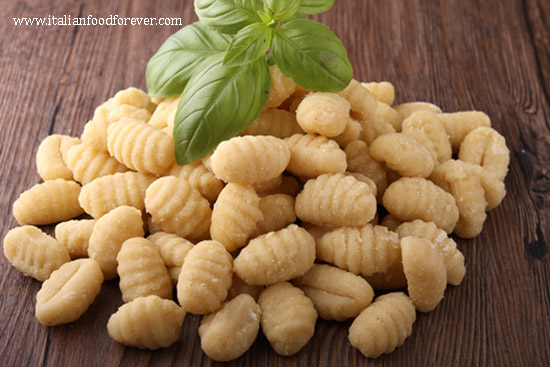
This is a basic potato gnocchi that can be topped with almost any sauce.
The trick to gnocchi is to not over knead the dough, and to use only as much flour as is needed to create a soft, workable dough. Knead your gnocchi dough only as long as it takes for the ingredients to come together into a smooth dough. The longer you knead, the more flour you will use, resulting in a heavier gnocchi. It is a good idea if you are new to gnocchi making to test your gnocchi before you prepare the whole batch. Drop a couple of gnocchi into boiling water and remove as soon as they come to the surface. If they fall apart, knead in a little more flour. If they hold up well, continue cutting the rest of your gnocchi.
Potatoes can also be baked. This method keeps the moisture level low allowing you to use less flour. In some regions of Italy, ricotta cheese replaces part or all of the potatoes in this recipe.
Serves: 4
120 - 150 grams (1 cup -1 1/3 cups) flour + a little to give the shape
1 beaten medium egg
Salt and pepper to taste
2 tablespoons salted butter
1/2 cup grated Parmesan cheese
The trick to gnocchi is to not over knead the dough, and to use only as much flour as is needed to create a soft, workable dough. Knead your gnocchi dough only as long as it takes for the ingredients to come together into a smooth dough. The longer you knead, the more flour you will use, resulting in a heavier gnocchi. It is a good idea if you are new to gnocchi making to test your gnocchi before you prepare the whole batch. Drop a couple of gnocchi into boiling water and remove as soon as they come to the surface. If they fall apart, knead in a little more flour. If they hold up well, continue cutting the rest of your gnocchi.
Potatoes can also be baked. This method keeps the moisture level low allowing you to use less flour. In some regions of Italy, ricotta cheese replaces part or all of the potatoes in this recipe.
Serves: 4
Preparation time:20 minutes
Cooking time:5 minutes
450 gr (1 pound) medium russet potatoes, unpeeled 120 - 150 grams (1 cup -1 1/3 cups) flour + a little to give the shape
1 beaten medium egg
Salt and pepper to taste
2 tablespoons salted butter
1/2 cup grated Parmesan cheese
Wash and scrub the potatoes.
Place the potatoes in a medium pot and cover them with cold water and bring it to a boil.
Reduce the heat to a simmer and cook until the potatoes are tender when pierced, but are still firm. Drain.
When the potatoes are cool enough to handle, peel them. Using a ricer, squeeze the potato flesh into a mound on a large tray or baking sheet.
Form a well in the center of the potatoes and add the egg, salt and pepper.
Mix to combine. Sift 2/3 of the flour. Mix until you have a sticky ball. Add more flour if the dough is too wet to knead.
Knead the dough until it’s smooth and all ingredients are well incorporated.
Line a baking sheet with parchment paper, and lightly dust with flour; set aside. Divide dough evenly into 4 pieces. Roll 1 dough piece into a 3/4-inch-thick rope.
Cut into 1-inch pieces. Take each piece and roll it off on a Gnocchi Paddle or against tines of a fork to make ridges; transfer to prepared baking sheet. Repeat process with remaining 3 dough pieces.
COOKING GNOCCHI
Loosened gnocchi from the surface, slide them directly into a large pot of salted boiling water, avoid picking them up with your hands. Gnocchi are ready when they rise to the surface. Drain.
Melt the butter in a skillet and add gnocchi. Gently mix add a little pasta water; cook for 30 seconds, gently tossing. Serve immediately topped with fresh grated parmesan cheese.
Toppings for gnocchi
You can accompany them in the way you prefer! from the white ragù, to the béchamel to the Genoese pesto and also simply butter and cheese, or a good fresh tomato sauce.
Place the potatoes in a medium pot and cover them with cold water and bring it to a boil.
Reduce the heat to a simmer and cook until the potatoes are tender when pierced, but are still firm. Drain.
When the potatoes are cool enough to handle, peel them. Using a ricer, squeeze the potato flesh into a mound on a large tray or baking sheet.
Form a well in the center of the potatoes and add the egg, salt and pepper.
Mix to combine. Sift 2/3 of the flour. Mix until you have a sticky ball. Add more flour if the dough is too wet to knead.
Knead the dough until it’s smooth and all ingredients are well incorporated.
Line a baking sheet with parchment paper, and lightly dust with flour; set aside. Divide dough evenly into 4 pieces. Roll 1 dough piece into a 3/4-inch-thick rope.
Cut into 1-inch pieces. Take each piece and roll it off on a Gnocchi Paddle or against tines of a fork to make ridges; transfer to prepared baking sheet. Repeat process with remaining 3 dough pieces.
COOKING GNOCCHI
Loosened gnocchi from the surface, slide them directly into a large pot of salted boiling water, avoid picking them up with your hands. Gnocchi are ready when they rise to the surface. Drain.
Melt the butter in a skillet and add gnocchi. Gently mix add a little pasta water; cook for 30 seconds, gently tossing. Serve immediately topped with fresh grated parmesan cheese.
Toppings for gnocchi
You can accompany them in the way you prefer! from the white ragù, to the béchamel to the Genoese pesto and also simply butter and cheese, or a good fresh tomato sauce.
Main Potato gnocchi with lobster 
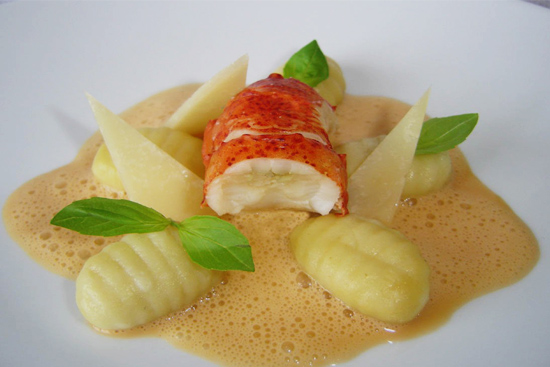
Serves: 4
Preparation time: 20 minutes
Cooking time:20 minutes
For gnocchi: 2 russet potatoes
3 egg yolks
1/2 cup water
1 teaspoon salt
ground white pepper to taste
1 1/2 cups flour
4 1-1/2 pounds lobsters, steamed for 5 minutes
1 teaspoon olive oil
For sauce:
1/2 cup butter
1 cup toasted walnuts, finely chopped
rind of one lemon, julienned
to taste salt and pepper
1 tablespoon fresh lemon juice
1/4 cup grated Parmesan cheese
2 teaspoons chopped fresh Italian parsley
For the gnocchi:
Peel potatoes, cut into 3/4-inch chunks, boil until tender, drain and passed through a ricer. Place the potatoes on a work surface dusted with a little flour. Add the egg yolks, water and salt and pepper to taste and mix lightly by hand. Add all but 3 tablespoons of the flour a little at a time, kneading gently just until incorporated. The dough should be soft but not elastic.
On a work surface, form the mass into a log. Divide the log into smaller portions and using your hands, roll out into 1/2-inch-long pieces. Dust them well with flour. Hold a flour-dusted fork, concave side up, in one hand. With the other hand, push a piece of dough into the tines, making an indentation with your thumb. Then roll the dough off the tines, making a shape like a tiny bowl with ridges on the bottom. Flour the fork and repeat with rest of dough.
Remove lobster claws. Crack claws, and remove the meat. Cut lobsters in halves, rub with oil and grill on a hot grill for 8 minutes. Pull the meat from the shells and set aside.
Cook gnocchi in boiling water for 4 to 5 minutes. Drain.
For the sauce:
melt butter in a large skillet. Stir in walnuts and lemon strips and cook 5 minutes. Stir in the lobster meat and gnocchi and cook 2 minutes. Season with salt and pepper. Add lemon juice. Remove from heat and stir in the parmesan.
Divide among 4 plates. Sprinkle with parsley. Serve.
Peel potatoes, cut into 3/4-inch chunks, boil until tender, drain and passed through a ricer. Place the potatoes on a work surface dusted with a little flour. Add the egg yolks, water and salt and pepper to taste and mix lightly by hand. Add all but 3 tablespoons of the flour a little at a time, kneading gently just until incorporated. The dough should be soft but not elastic.
On a work surface, form the mass into a log. Divide the log into smaller portions and using your hands, roll out into 1/2-inch-long pieces. Dust them well with flour. Hold a flour-dusted fork, concave side up, in one hand. With the other hand, push a piece of dough into the tines, making an indentation with your thumb. Then roll the dough off the tines, making a shape like a tiny bowl with ridges on the bottom. Flour the fork and repeat with rest of dough.
Remove lobster claws. Crack claws, and remove the meat. Cut lobsters in halves, rub with oil and grill on a hot grill for 8 minutes. Pull the meat from the shells and set aside.
Cook gnocchi in boiling water for 4 to 5 minutes. Drain.
For the sauce:
melt butter in a large skillet. Stir in walnuts and lemon strips and cook 5 minutes. Stir in the lobster meat and gnocchi and cook 2 minutes. Season with salt and pepper. Add lemon juice. Remove from heat and stir in the parmesan.
Divide among 4 plates. Sprinkle with parsley. Serve.
Main Rack of lamb with mushroom crust 
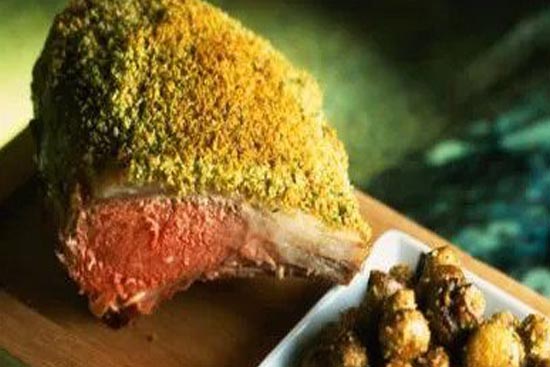
Serves: 4
Preparation time: 20 minutes
Cooking time:30 minutes
2 ounces dried black trumpet or other dried mushrooms 1 egg
salt and black pepper to taste
flour for dredging
2 racks of lamb, boned and trimmed
4 medium leeks, trimmed of hard green parts, split in half, well washed and roughly chopped
1 tablespoon butter
4 tablespoons extra virgin olive oil
4 ounces fresh shiitake, trimmed and cut into chunks
2 cloves garlic, lightly smashed
2 sprigs thyme
In a coffee grinder or spice grinder, grind dried mushrooms to the consistency of coffee. Set aside.
Beat egg in a bowl, with salt and pepper. Dip lamb in flour, shaking off excess. Dip it into egg, and then into mushrooms.
Pat mushrooms to adhere; coat lamb heavily. Refrigerate for about 1 hour or up to 4 hours.
Cook leeks in salted boiling water. Drain, and puree with butter. Season with salt and pepper. Reserve. In a medium skillet, heat half of the oil. Saute mushrooms, garlic and thyme until mushrooms are tender.
Preheat oven to 500 degrees. Place remaining oil in an oven-proof skillet. Heat to medium-high. Add lamb.
Cook for 2 minutes on one side. Turn and place skillet in the oven for 5 to 6 minutes for rare, medium-rare, (125 degrees) or longer for medium. Let lamb rest for 5 minutes then cut into 3/4-inch-thick slices.
Place a dollop of leek purée on each plate; top with portions of mushrooms. Place lamb on top.
Beat egg in a bowl, with salt and pepper. Dip lamb in flour, shaking off excess. Dip it into egg, and then into mushrooms.
Pat mushrooms to adhere; coat lamb heavily. Refrigerate for about 1 hour or up to 4 hours.
Cook leeks in salted boiling water. Drain, and puree with butter. Season with salt and pepper. Reserve. In a medium skillet, heat half of the oil. Saute mushrooms, garlic and thyme until mushrooms are tender.
Preheat oven to 500 degrees. Place remaining oil in an oven-proof skillet. Heat to medium-high. Add lamb.
Cook for 2 minutes on one side. Turn and place skillet in the oven for 5 to 6 minutes for rare, medium-rare, (125 degrees) or longer for medium. Let lamb rest for 5 minutes then cut into 3/4-inch-thick slices.
Place a dollop of leek purée on each plate; top with portions of mushrooms. Place lamb on top.
Main Risotto with mushrooms asparagus and spring peas 

The use of the oven is much more preferable to stirring and the recipe turns out into a creamy texture.
Serves: 6
1 small yellow onion, chopped
2 cloves garlic, pressed or minced
5 cups vegetable broth
1 1/2 cup arborio
rice
8 oz pound sliced Cremini (baby portobello) mushrooms, debris rinsed from mushrooms and drained
1 small bunch of fresh asparagus spears (about 1 pound)
1 cup fresh English peas
1 cup freshly grated Parmesan cheese
1/2 cup dry white wine
2 tablespoons unsalted butter, diced
1/2 cup light cream
1 tablespoon tamari
1 teaspoon sea salt, more to taste
Freshly ground black pepper, to taste
3 tablespoons fresh flat leaf parsley, chopped
Serves: 6
Preparation time:25 minutes
Cooking time:1 hour
3 tablespoon olive oil, divided1 small yellow onion, chopped
2 cloves garlic, pressed or minced
5 cups vegetable broth
1 1/2 cup arborio
rice
8 oz pound sliced Cremini (baby portobello) mushrooms, debris rinsed from mushrooms and drained
1 small bunch of fresh asparagus spears (about 1 pound)
1 cup fresh English peas
1 cup freshly grated Parmesan cheese
1/2 cup dry white wine
2 tablespoons unsalted butter, diced
1/2 cup light cream
1 tablespoon tamari
1 teaspoon sea salt, more to taste
Freshly ground black pepper, to taste
3 tablespoons fresh flat leaf parsley, chopped
Preheat oven to 375 degrees.
Heat 2 tablespoons olive oil in a medium Dutch oven over medium heat until shimmering. Add onion. Cook, stirring occasionally, for ten minutes, then add the minced garlic. Cook for another 2 to 4 minutes, until the onions are well browned. Deglaze with the wine and continue cooking for 2 more minutes.
Add 4 cups broth and stir in the rice. Cover the pot and bake until rice is tender and cooked through, about 35 to 40 minutes.
Prepare the mushrooms. Heat 2 tablespoons olive oil in a large skillet. Add the cleaned, sliced mushrooms to the pot with a dash of salt. Cook, stirring occasionally, until the mushrooms are darker in color, fragrant and have soaked up most of their own juices, about 10 minutes.
Prepare the asparagus by snapping off the tough ends and discarding them, then slicing the spears into 1-inch long pieces. Cook the asparagus in boiling water for 5 minutes. Add the peas and cook 2 to 3 more minutes. Drain the asparagus and peas in a colander.
Remove the pot from the oven. Pour in the remaining hot broth, cream, asparagus, peas, Parmesan, butter, tamari, salt, and a generous amount of pepper. Stir vigorously for 2 to 3 minutes, until the rice is thick and creamy. Stir in the mushroom mixture and any remaining juices. Season to taste with salt and pepper, divide into bowls and top with a generous sprinkling ofparsley.
Heat 2 tablespoons olive oil in a medium Dutch oven over medium heat until shimmering. Add onion. Cook, stirring occasionally, for ten minutes, then add the minced garlic. Cook for another 2 to 4 minutes, until the onions are well browned. Deglaze with the wine and continue cooking for 2 more minutes.
Add 4 cups broth and stir in the rice. Cover the pot and bake until rice is tender and cooked through, about 35 to 40 minutes.
Prepare the mushrooms. Heat 2 tablespoons olive oil in a large skillet. Add the cleaned, sliced mushrooms to the pot with a dash of salt. Cook, stirring occasionally, until the mushrooms are darker in color, fragrant and have soaked up most of their own juices, about 10 minutes.
Prepare the asparagus by snapping off the tough ends and discarding them, then slicing the spears into 1-inch long pieces. Cook the asparagus in boiling water for 5 minutes. Add the peas and cook 2 to 3 more minutes. Drain the asparagus and peas in a colander.
Remove the pot from the oven. Pour in the remaining hot broth, cream, asparagus, peas, Parmesan, butter, tamari, salt, and a generous amount of pepper. Stir vigorously for 2 to 3 minutes, until the rice is thick and creamy. Stir in the mushroom mixture and any remaining juices. Season to taste with salt and pepper, divide into bowls and top with a generous sprinkling ofparsley.
Main Roast tomato tart 
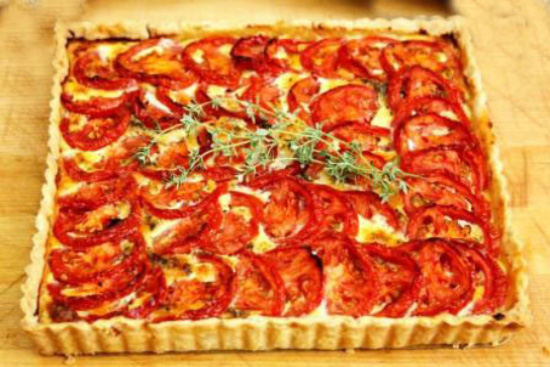
Serves: 8
Preparation time: 30 minutes
Cooking time:45 minutes
1 sheet (from 1 pound (450 g pkg) frozen butter puff pastry, thawed8 red or striped heirloom plum tomatoes, about 1 ¼ pounds
1 cup yellow teardrop or cherry tomatoes halved lengthwise
2 tbsp extra virgin olive oil
1 clove garlic, minced
½ tsp salt
¼ tsp pepper
1 egg beaten
1 cup shredded Gruyere cheese
2 tsp fresh thyme or oregano
Line 2 rimmed baking sheets with parchment paper; set aside.
On lightly floured surface, roll out pastry to 10-inch square; transfer to prepared pan. Using fork, prick pastry all over; refrigerate for 30 minutes.
Meanwhile, cut red tomatoes crosswise into ½ -inch thick slices. In bowl, toss together red and yellow tomatoes, oil, garlic, salt and pepper; spread on remaining prepared pan. Roast in 400F oven until slightly charred and shriveled, about 30 minutes. Let cool on pan.
Bake pastry in center of 400 degrees F. oven until light golden and puffed, 12 to 15 minutes. Let cool slightly. Brush pastry all over with some of the egg; sprinkle with cheese, leaving a 1-inch border. Arrange red tomatoes in overlapping rows on cheese. Scatter yellow tomatoes over top; sprinkle with thyme. Return to oven and bake until golden and puffed, 12 to 15 minutes. Let cool for 5 minutes; cut into squares. Serve warm or at room temperature.
Adapted from Canadian Living August 2007
On lightly floured surface, roll out pastry to 10-inch square; transfer to prepared pan. Using fork, prick pastry all over; refrigerate for 30 minutes.
Meanwhile, cut red tomatoes crosswise into ½ -inch thick slices. In bowl, toss together red and yellow tomatoes, oil, garlic, salt and pepper; spread on remaining prepared pan. Roast in 400F oven until slightly charred and shriveled, about 30 minutes. Let cool on pan.
Bake pastry in center of 400 degrees F. oven until light golden and puffed, 12 to 15 minutes. Let cool slightly. Brush pastry all over with some of the egg; sprinkle with cheese, leaving a 1-inch border. Arrange red tomatoes in overlapping rows on cheese. Scatter yellow tomatoes over top; sprinkle with thyme. Return to oven and bake until golden and puffed, 12 to 15 minutes. Let cool for 5 minutes; cut into squares. Serve warm or at room temperature.
Adapted from Canadian Living August 2007
Main Roasted salmon with white beans tomato and spinach 
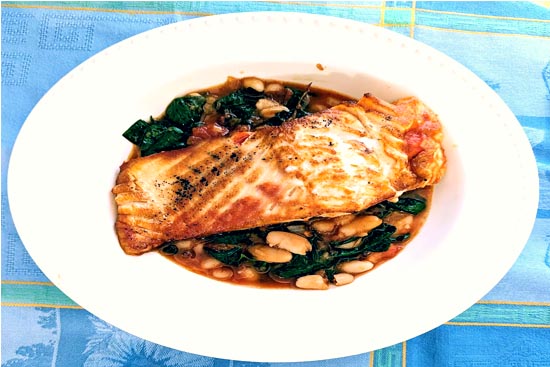
Serves: 2
Preparation time:10 minutes
Cooking time:15 minutes
1 tablespoon olive oil2 6-ounces salmon fillets
1 shallot finely chopped
3 sprigs fresh thyme
1/2 cup white wine
14 ounce can crushed or diced tomatoes
15 ounce can white cannellini beans drained
Salt and freshly ground black pepper
3 ounces fresh spinach
Preheat the oven to 400 F.
Heat the olive oil on high and add the salmon fillets for 2 minutes on each side. Remove the salmon to a plate and set aside.
In the same skillet, add the shallots and thyme sprigs and cook briefly. Add the white wine and tomatoes and simmer 5 minutes. Place the salmon fillets in the pan on top of the tomato sauce and transfer the pan to the oven. Bake for 6 minutes.
Remove the pan from the oven and transfer the salmon fillets to a plate. Add the white beans to the tomato sauce and heat through. Season to taste with salt and freshly ground black pepper and just before serving, stir the spinach into the mixture to wilt.Discard the thyme springs.
To plate, spoon the tomatoes, beans and spinach to a plate or shallow bowl and top with the salmon.
Heat the olive oil on high and add the salmon fillets for 2 minutes on each side. Remove the salmon to a plate and set aside.
In the same skillet, add the shallots and thyme sprigs and cook briefly. Add the white wine and tomatoes and simmer 5 minutes. Place the salmon fillets in the pan on top of the tomato sauce and transfer the pan to the oven. Bake for 6 minutes.
Remove the pan from the oven and transfer the salmon fillets to a plate. Add the white beans to the tomato sauce and heat through. Season to taste with salt and freshly ground black pepper and just before serving, stir the spinach into the mixture to wilt.Discard the thyme springs.
To plate, spoon the tomatoes, beans and spinach to a plate or shallow bowl and top with the salmon.
Main Roasted tomato caprese salad 

Serves: 6
Preparation time:10 minutes
Cooking time:1 hour
1 1/2 pounds cherry tomatoes1 1/2 tablespoons olive oil
1 teaspoon maple syrup
1 1/2 teaspoons balsamic vinegar
1/4 teaspoon sugar
Kosher salt and freshly ground black pepper
1 pound small fresh mozzarella balls (bocconcini), halved
1/4 cup basil leaves, finely sliced
1 teaspoon grated zest from 1 lemon
Heat oven to 375F. Add cherry tomatoes, olive oil, maple syrup, balsamic vinegar, and sugar to 9 by 13 inch baking dish. Toss to combine. Roast until just starting to char, about 40 minutes, tossing occasionally to cook evenly.
Remove from oven and cool 5 to 10 minutes. Transfer tomatoes along with any any accumulated juices to large bowl. Add mozzarella and basil. Gently toss to combine. Add lemon zest then season with salt and pepper. Toss again and serve.
Remove from oven and cool 5 to 10 minutes. Transfer tomatoes along with any any accumulated juices to large bowl. Add mozzarella and basil. Gently toss to combine. Add lemon zest then season with salt and pepper. Toss again and serve.
Main Rollatines of chicken 
Serves: 6
Preparation time: 20 minutes
Cooking time:30 minutes
3/4 pound fresh spinach 1/4 pound mushrooms
3 tablespoons butter
1 cup chopped onions
2 teaspoons chopped garlic
salt and black pepper to taste
3 boneless and skinless chicken breasts
1/2 cup minced carrots
1/2 cup minced celery
1/2 cup white wine
1/2 cup chicken stock
1/2 cup chopped tomatoes, peeled and seedless
1 bay leaf
1/2 teaspoon thyme
Clean spinach. Slice and chop the mushrooms coarsely.
Melt 1/2 of the butter in a skillet. Add 1/2 of the onion, 1/2 garlic, 1/2 mushrooms. Cook for 2 minutes. Add spinach, 1/2 of the salt and pepper. Cook over high heat for 5 minutes to remove all moisture. Set aside to cool.
Split chicken breasts in halves lengthwise. Pound lightly to flatten. Spoon an equal amount of filling down the center of each chicken breast. Fold to enclose filling. Secure with string or toothpicks.
Brown chickens in remaining butter. Add remaining ingredients to skillet and simmer for 15 minutes.
Remove the chicken. Discard toothpicks. Reduce sauce to thicken. Serve over chicken.
Melt 1/2 of the butter in a skillet. Add 1/2 of the onion, 1/2 garlic, 1/2 mushrooms. Cook for 2 minutes. Add spinach, 1/2 of the salt and pepper. Cook over high heat for 5 minutes to remove all moisture. Set aside to cool.
Split chicken breasts in halves lengthwise. Pound lightly to flatten. Spoon an equal amount of filling down the center of each chicken breast. Fold to enclose filling. Secure with string or toothpicks.
Brown chickens in remaining butter. Add remaining ingredients to skillet and simmer for 15 minutes.
Remove the chicken. Discard toothpicks. Reduce sauce to thicken. Serve over chicken.
Main Rosemary chicken salad 
Serves: 4
Preparation time: 15 minutes
Cooking time:20 minutes
1 tablespoon olive oil 1 1/4 pounds skinless, boneless chicken breasts halves
salt and pepper to taste
1/4 cup dry white wine
3 scallions, thinly sliced
1 celery rib, cut into 1/4-inch dice
1/2 red pepper, cut into 1/4-inch dice
1/2 cup mayonnaise
2 tablespoons lemon juice
1 teaspoon olive oil
1 garlic clove, minced
1 teaspoon rosemary, finely chopped
1/4 teaspoon Tabasco
Heat 1 tablespoon of the oil. Season the chicken with salt and pepper. Cook until browned. Add the wine.
Cover and simmer until the chicken is cooked through. Drain and let cool.
Cut the chicken into 1/2-inch cubes and transfer to large bowl. Stir in the scallions, celery and red pepper.
Combine mayonnaise, lemon juice, remaining 1 teaspoon oil, the garlic, rosemary and Tabasco. Combine dressing and chicken mixture and toss to coat.
Season with salt and pepper. Cover and refrigerate 15 minutes to 4 hours.
This salad may be served as a sandwich on thickly sliced white bread.
Cover and simmer until the chicken is cooked through. Drain and let cool.
Cut the chicken into 1/2-inch cubes and transfer to large bowl. Stir in the scallions, celery and red pepper.
Combine mayonnaise, lemon juice, remaining 1 teaspoon oil, the garlic, rosemary and Tabasco. Combine dressing and chicken mixture and toss to coat.
Season with salt and pepper. Cover and refrigerate 15 minutes to 4 hours.
This salad may be served as a sandwich on thickly sliced white bread.
Main Rosemary-roasted chicken with potatoes and fennel 
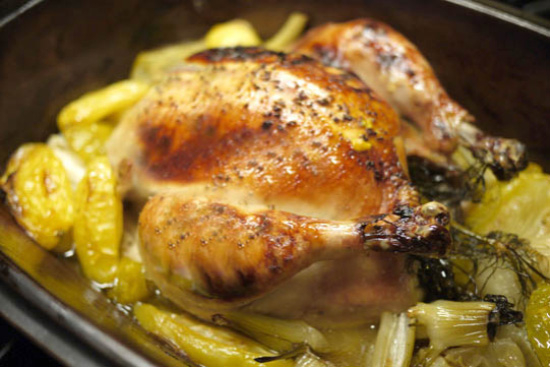
Serves: 8
Preparation time: 30 minutes
Cooking time:1 hour 30 minutes
2 medium fennel bulbs 2 pounds small red potatoes, scrubbed and cut into 1-inch pieces
2 chickens, 3 pounds, (1.5 kg) each
6 sprigs fresh rosemary
1 teaspoon olive oil
1 tablespoon chopped fresh rosemary leaves
to taste salt and pepper
fresh rosemary for garnish
In large roasting pan, combine fennel and potatoes. Rinse and dry cavities of chickens; remove any excess fat from cavities. Place 3 sprigs of rosemary inside each chicken.
Tie legs of each chicken together over cavity; tuck wing tips under backs.
Place chickens, breast side up, on top of vegetables. Brush skin of each chicken with olive oil. Sprinkle evenly with chopped rosemary, salt and pepper. Roast in 450 degree F. oven for 15 minutes.
Reduce heat to 350 degrees; roast 1-3/4 hours or until drumsticks move easily in sockets and juices run clear when thickest part of thighs is pierced with a skewer.
Transfer chickens to board. Cover with foil; let stand 5 to 10 minutes. With slotted spoon, spoon vegetables onto heated serving platter. Place chickens on top of vegetables; garnish with rosemary.
Tie legs of each chicken together over cavity; tuck wing tips under backs.
Place chickens, breast side up, on top of vegetables. Brush skin of each chicken with olive oil. Sprinkle evenly with chopped rosemary, salt and pepper. Roast in 450 degree F. oven for 15 minutes.
Reduce heat to 350 degrees; roast 1-3/4 hours or until drumsticks move easily in sockets and juices run clear when thickest part of thighs is pierced with a skewer.
Transfer chickens to board. Cover with foil; let stand 5 to 10 minutes. With slotted spoon, spoon vegetables onto heated serving platter. Place chickens on top of vegetables; garnish with rosemary.
Main Rotolo di spinaci - spinach and ricotta lasagne roll-ups 
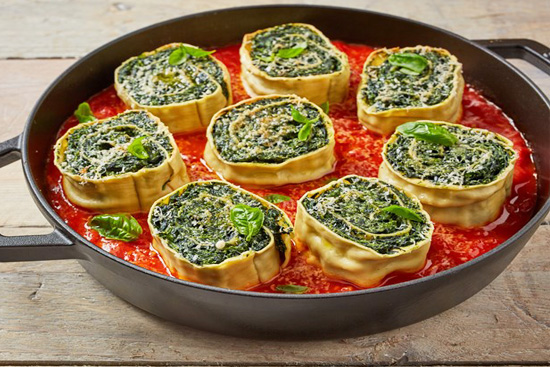
Pasta sheets are covered with a spinach and ricotta filling, rolled up in a clean tea towel and gently boiled then baked in tomato sauce.
The pasta sheets and tomato sauce can be purchased already prepared.
You can vary the fillings by using mushrooms or eggplant.
Serves: 6
1 medium onion, diced
2 garlic cloves, crushed
1 qt Marinara sauce
1 tbsp balsamic vinegar
400g (12 cups) spinach
375g (13oz) ricotta
1 whole nutmeg, to grate
6 fresh lasagne sheets
28g (1 oz) pack fresh basil, leaves picked and chopped
Serves: 6
Preparation time:15 minutes
Cooking time:50 minutes
1 tbsp olive oil1 medium onion, diced
2 garlic cloves, crushed
1 qt Marinara sauce
1 tbsp balsamic vinegar
400g (12 cups) spinach
375g (13oz) ricotta
1 whole nutmeg, to grate
6 fresh lasagne sheets
28g (1 oz) pack fresh basil, leaves picked and chopped
Heat the oil in a large pan. Add the onion and garlic and cook for 5 minutes until softened.
Add the marinara and balsamic vinegar and simmer for 20 minutes, until thickened.
2 Meanwhile, heat a large pan over a medium heat. Wash the spinach, then add to the pan and wilt. Place in a sieve over a bowl to get rid of excess water then, once cooled, pat dry with paper towel and roughly chop. Add to the ricotta with a pinch of freshly-grated nutmeg and season to taste.
3 Place a generous teaspoon of the ricotta mixture on a slice of lasagne sheet and spread evenly.
Roll up the rotolo, using the tea towel to help. Start off with your hands to get a nice tight roll, then lift up the towel from the bottom and roll the pasta all the way up into a tight log
Wrap the log up tightly in the tea towel and use string to tie each end. Cook the rotolo in a large pan of salted boiling water for 15 minutes.
Carefully remove the tea towel then slice the rotolo into 6–8 even slices.
Once the tomato sauce has thickened to a good consistency, stir through most of the basil, reserving some to garnish. Pour he sauce into the base of a roughly 21 x 21 cm (9-inch square) baking dish and place the lasagne roll-ups in the dish, so they are stood up. Bake for 25-30 minutes, until lightly golden. Garnish with the remaining basil and serve.
Add the marinara and balsamic vinegar and simmer for 20 minutes, until thickened.
2 Meanwhile, heat a large pan over a medium heat. Wash the spinach, then add to the pan and wilt. Place in a sieve over a bowl to get rid of excess water then, once cooled, pat dry with paper towel and roughly chop. Add to the ricotta with a pinch of freshly-grated nutmeg and season to taste.
3 Place a generous teaspoon of the ricotta mixture on a slice of lasagne sheet and spread evenly.
Roll up the rotolo, using the tea towel to help. Start off with your hands to get a nice tight roll, then lift up the towel from the bottom and roll the pasta all the way up into a tight log
Wrap the log up tightly in the tea towel and use string to tie each end. Cook the rotolo in a large pan of salted boiling water for 15 minutes.
Carefully remove the tea towel then slice the rotolo into 6–8 even slices.
Once the tomato sauce has thickened to a good consistency, stir through most of the basil, reserving some to garnish. Pour he sauce into the base of a roughly 21 x 21 cm (9-inch square) baking dish and place the lasagne roll-ups in the dish, so they are stood up. Bake for 25-30 minutes, until lightly golden. Garnish with the remaining basil and serve.
Main San remo pasta salad 
Serves: 6
Preparation time: 15 minutes
Cooking time:12 minutes
12 ounces fusilli 1/2 cup sun dried tomatoes in olive oil
1/2 cup chopped fresh basil
1/2 cup grated parmesan cheese
1/2 cup black olives
1/3 cup olive oil
1/3 cup salad oil
2 teaspoons wine vinegar
1/2 teaspoon salt
1/2 teaspoon ground black pepper
Cook pasta in salted boiling water until al dente.
Drain and rinse in cold water. Drain well in a colander.
Add all remaining ingredients and toss lightly. Adjust seasoning to taste.
Serve at room temperature or lightly chilled.
Drain and rinse in cold water. Drain well in a colander.
Add all remaining ingredients and toss lightly. Adjust seasoning to taste.
Serve at room temperature or lightly chilled.
Main Sardines with confit thyme tomatoes 

Serves: 4
Preparation time:10 minutes
Cooking time:12 minutes
200g cherry tomatoesOlive oil
8 garlic cloves, peeled and roughly chopped
A few sprigs of thyme, finely chopped
1 teaspoon balsamic vinegar
2 tins of sardines in olive oil (120g each), drained
Sea salt and freshly ground black pepper
Cut the cherry tomatoes in half and remove the seeds.
Heat the olive oil in a large frying pan and place the tomatoes, cut-side down, into the pan. Add the garlic and a little thyme. Turn down the heat and leave the tomatoes to slowly absorb the flavours.
Once the skins are shrivelled and the cut side has colored slightly, remove the pan from the heat and leave the tomatoes to cool.
Gently remove the skins from the tomatoes. This should be easy if the tomatoes are completely cooked. Crush the tomatoes with the garlic and olive oil. Season with the vinegar, salt and pepper.
Spoon the tomatoes on to plates, top with sardines and sprinkle with a little more thyme, if you like.
Heat the olive oil in a large frying pan and place the tomatoes, cut-side down, into the pan. Add the garlic and a little thyme. Turn down the heat and leave the tomatoes to slowly absorb the flavours.
Once the skins are shrivelled and the cut side has colored slightly, remove the pan from the heat and leave the tomatoes to cool.
Gently remove the skins from the tomatoes. This should be easy if the tomatoes are completely cooked. Crush the tomatoes with the garlic and olive oil. Season with the vinegar, salt and pepper.
Spoon the tomatoes on to plates, top with sardines and sprinkle with a little more thyme, if you like.
Main Scallopine of cod piccata 

To get pithless lemon sections, you need to use a technique that removes the peel and white pith, then cut between the membranes to release the fruit segments. First, cut off the top and bottom of the lemon and then slice off the peel and pith, following the curve of the fruit. Next, slice down along the sides of each segment, cutting between the membranes, to separate and release the fruit.
Serves: 4
1/2 teaspoon salt
1/4 teaspoon pepper
1 1/2 pounds center-cut cod fish fillets, boned
1 tablespoon unsalted butter
1 tablespoon extra virgin olive oil
Piccata sauce:
1 tablespoon unsalted butter
1 shallot (finely diced)
1 teaspoon minced garlic
1 cup white wine
2 tablespoon pithless diced lemon sections (see comment)
1/4 cup fresh squeezed lemon juice
1/4 cup capers (drained)
1 tablespoon chopped fresh parsley
Serves: 4
Preparation time:15 minutes
Cooking time:10 minutes
1/2 cup flour1/2 teaspoon salt
1/4 teaspoon pepper
1 1/2 pounds center-cut cod fish fillets, boned
1 tablespoon unsalted butter
1 tablespoon extra virgin olive oil
Piccata sauce:
1 tablespoon unsalted butter
1 shallot (finely diced)
1 teaspoon minced garlic
1 cup white wine
2 tablespoon pithless diced lemon sections (see comment)
1/4 cup fresh squeezed lemon juice
1/4 cup capers (drained)
1 tablespoon chopped fresh parsley
Slice the center-cut cod into thin scallopines
Mix together the flour, salt and pepper on a plate. Dredge the cod in the flour
mixture and place on a plate.
2. Heat the butter and olive oil in a large skillet over medium-high. Once the butter-oil mixture
is hot, add the cod. Cook until golden brown, about 2-3 minutes, then flip and cook an additional 2 minutes or until the fish is opaque throughout and easily flakes with a fork.
Remove to a clean plate.
Reduce the heat to medium and add the remaining butter to the pan. Once melted, add the
shallots and garlic and cook until softened, about 2 minutes
Slowly pour in the wine, raise the heat, and bring to a boil. Reduce by half, scraping up any
browned bits. Add the diced lemon sections, lemon juice and capers and stir.
Place the cod back into the pan to warm through.
Serve the cod topped with spoonfuls of the piccata sauce and garnished with fresh parsley.
Mix together the flour, salt and pepper on a plate. Dredge the cod in the flour
mixture and place on a plate.
2. Heat the butter and olive oil in a large skillet over medium-high. Once the butter-oil mixture
is hot, add the cod. Cook until golden brown, about 2-3 minutes, then flip and cook an additional 2 minutes or until the fish is opaque throughout and easily flakes with a fork.
Remove to a clean plate.
Reduce the heat to medium and add the remaining butter to the pan. Once melted, add the
shallots and garlic and cook until softened, about 2 minutes
Slowly pour in the wine, raise the heat, and bring to a boil. Reduce by half, scraping up any
browned bits. Add the diced lemon sections, lemon juice and capers and stir.
Place the cod back into the pan to warm through.
Serve the cod topped with spoonfuls of the piccata sauce and garnished with fresh parsley.
Main Shrimp scampi 
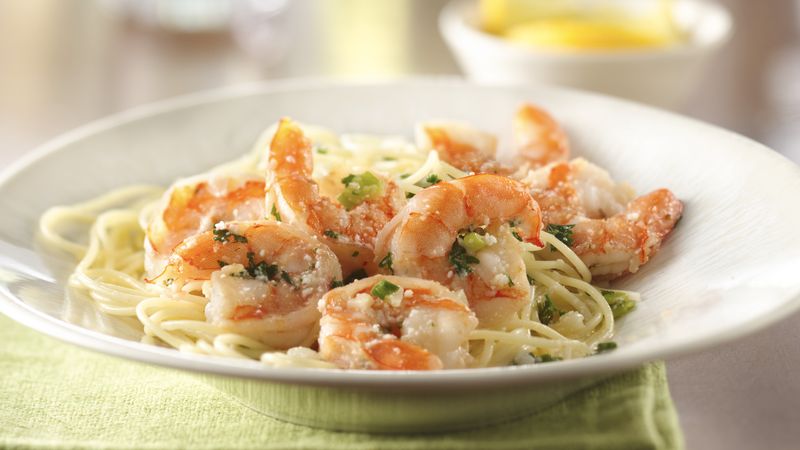
May be served with angel hair pasta
Serves: 6
4 cloves garlic, minced
1 medium shallot, diced
¼ teaspoon crushed red pepper flakes
1 ½ pounds medium shrimp, peeled and deveined
Kosher salt and freshly ground black pepper, to taste
2 tablespoons chopped fresh parsley leaves
1 tablespoon freshly squeezed lemon juice
2 teaspoons lemon zest
Serves: 6
Preparation time:5 minutes
Cooking time:10 minutes
½ cup unsalted butter, cubed4 cloves garlic, minced
1 medium shallot, diced
¼ teaspoon crushed red pepper flakes
1 ½ pounds medium shrimp, peeled and deveined
Kosher salt and freshly ground black pepper, to taste
2 tablespoons chopped fresh parsley leaves
1 tablespoon freshly squeezed lemon juice
2 teaspoons lemon zest
Melt butter in a large skillet over medium heat. Add garlic, shallot and red pepper flakes, and cook, stirring frequently about 2 minutes.
Add shrimp; season with salt and pepper, to taste. Cook, stirring occasionally, until pink and cooked through, about 3-4 minutes.
Stir in parsley, lemon juice and lemon zest.
Serve immediately.
Add shrimp; season with salt and pepper, to taste. Cook, stirring occasionally, until pink and cooked through, about 3-4 minutes.
Stir in parsley, lemon juice and lemon zest.
Serve immediately.
Main Shrimp-tortellini pesto 
Serves: 6
Preparation time: 20 minutes
Cooking time:15 minutes
For the pesto:1 cup stemmed basil
1/4 cup grated Romano cheese
1/4 cup pine nuts
2 teaspoons fresh parsley
3 teaspoons olive oil
1 clove minced garlic
2 teaspoons melted butter
1 pound cleaned shrimp
1 clove minced garlic
1 large tomato, diced
salt and pepper to taste
1 pound tortellini
Pesto:
Combine first six ingredients. Puree in a blender. Transfer to a bowl.
In a 12 inch sauté pan, over high heat, quickly sauté shrimp with butter, garlic and tomato. Season with salt and pepper. Toss and stir constantly.
Cook tortellini in salted boiling water. Drain, and add immediately to pesto mixture.
Toss thoroughly. Spoon on plates, and top with shrimp and tomato. Serve hot.
Combine first six ingredients. Puree in a blender. Transfer to a bowl.
In a 12 inch sauté pan, over high heat, quickly sauté shrimp with butter, garlic and tomato. Season with salt and pepper. Toss and stir constantly.
Cook tortellini in salted boiling water. Drain, and add immediately to pesto mixture.
Toss thoroughly. Spoon on plates, and top with shrimp and tomato. Serve hot.
Main Silk handkerchiefs with pesto 
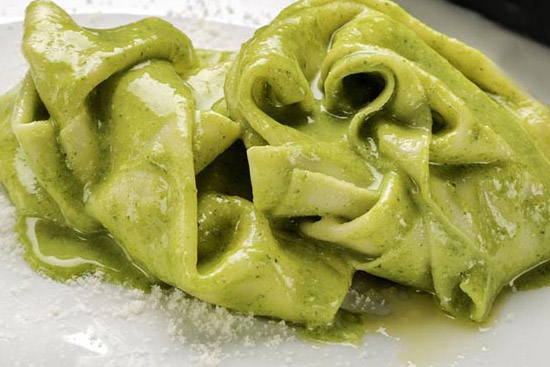
Serves: 6
Preparation time: 20 minutes
Cooking time:4 minutes
For pasta: 3 1/2 cups flour
1/2 teaspoon salt
5 eggs
2 teaspoons olive oil
1 recipe of pesto dressing
Make a well with flour and salt on a work surface. In the center, add eggs. one at a time, working into flour with your hands. Continue kneading until dough is smooth and elastic, about 10 minutes.
Divide dough into 4 balls.
Put the dough through a pasta machine several times, gradually setting the thickness from the widest to the thinnest.
Cut sheets into 4 inch square.
Cook pasta in salted boiling water for 3 to 4 minutes.
Drain and serve with pesto.
Divide dough into 4 balls.
Put the dough through a pasta machine several times, gradually setting the thickness from the widest to the thinnest.
Cut sheets into 4 inch square.
Cook pasta in salted boiling water for 3 to 4 minutes.
Drain and serve with pesto.
Main Smoky cheddar and tomato cornbread 

This rich, moist cornbread is the perfect side for BBQ ribs or brisket and slaw. You can use one
large tomato or use a variety of heirlooms, a slice or two from each. Their size doesn’t matter
as much as the combined weight.
Serves: 4
1 1/2 cups (375 mL) all-purpose flour
1 1/2 tsp (7 mL) salt
1/2 tsp (2 mL) coarsely ground black pepper
1 tsp (5 mL) smoked paprika
2 tsp (10 mL) baking powder
1/2 tsp (2 mL) baking soda
2 tsp (10 mL) sugar
5 green onions
5 oz (140 g) coarsely grated smoked cheddar
2 eggs
1 cup (250 mL) sour cream or crème fraîche
3/4 cup (175 mL) milk or water
12 tbsp (180 mL, 1 1/2 sticks) unsalted butter, melted
1 1/4 lbs (565 g) heirloom tomatoes, sliced a scant 1/2-inch (1-cm) thick
Flaky sea salt to serve
Serves: 4
Preparation time:20 minutes
Cooking time:45 minutes
1 1/2 cups (375 mL) medium-grind cornmeal1 1/2 cups (375 mL) all-purpose flour
1 1/2 tsp (7 mL) salt
1/2 tsp (2 mL) coarsely ground black pepper
1 tsp (5 mL) smoked paprika
2 tsp (10 mL) baking powder
1/2 tsp (2 mL) baking soda
2 tsp (10 mL) sugar
5 green onions
5 oz (140 g) coarsely grated smoked cheddar
2 eggs
1 cup (250 mL) sour cream or crème fraîche
3/4 cup (175 mL) milk or water
12 tbsp (180 mL, 1 1/2 sticks) unsalted butter, melted
1 1/4 lbs (565 g) heirloom tomatoes, sliced a scant 1/2-inch (1-cm) thick
Flaky sea salt to serve
1. Preheat oven to 400°F (204°C). Butter a 10-inch (25-cm) cast-iron skillet.
2. In a large bowl, whisk together cornmeal,flour, salt, pepper, paprika, baking powder, baking soda and sugar. Thinly slice white and light green parts of green onion. Add to dry ingredients along with cheddar and stir to combine.
Reserve green onion tails.
3. In a second bowl, whisk together eggs,sour cream, milk and butter.
4. Pour over dry ingredients and stir until just combined. Scrape into prepared skillet and level. Top with overlapping slices of tomato leaving a 1-inch (2.5-cm) border all around.
5. Bake on centre rack for 45 to 50 minutes or until a toothpick inserted in centre comes out
clean. Let stand 20 minutes.
6. Sprinkle top of cornbread with flaky salt and reserved green onion tails, thinly sliced.
Cut into squares to serve.
2. In a large bowl, whisk together cornmeal,flour, salt, pepper, paprika, baking powder, baking soda and sugar. Thinly slice white and light green parts of green onion. Add to dry ingredients along with cheddar and stir to combine.
Reserve green onion tails.
3. In a second bowl, whisk together eggs,sour cream, milk and butter.
4. Pour over dry ingredients and stir until just combined. Scrape into prepared skillet and level. Top with overlapping slices of tomato leaving a 1-inch (2.5-cm) border all around.
5. Bake on centre rack for 45 to 50 minutes or until a toothpick inserted in centre comes out
clean. Let stand 20 minutes.
6. Sprinkle top of cornbread with flaky salt and reserved green onion tails, thinly sliced.
Cut into squares to serve.
Main Soft potato ravioli with truffle pan sauce 
Serves: 6
Preparation time: 40 minutes
Cooking time:20 minutes
4 cups rich chicken stock 1 cup mirepoix (finely diced carrots, onion and celery)
3 cloves garlic peeled
1/3 cup truffle butter
2 pounds russet potatoes
2 teaspoons chopped onion
3 ounces fresh soft goat cheese
2 teaspoons chopped parsley
salt and ground white pepper
2 teaspoons flour
2 large eggs
4 12-by-8-inch fresh pasta
1 medium black truffle
2 teaspoons minced fresh chive
Combine stock, mirepoix, and 1 clove of garlic in a medium saucepan over medium-high heat. Bring to a boil. Lower heat and simmer for about 20 minutes, or until reduced by half. Strain through a fine sieve, discarding solids. Stir in truffle butter. Reserve and keep hot in a small pan.
Peel and dice potatoes. Place in a medium saucepan with cold water to cover over medium heat. Add the remaining 2 garlic cloves, the onion and salt to taste and bring to a boil. Lower heat and simmer until potatoes are soft. Drain well.
Put potatoes through a ricer. Add goat cheese, parsley, salt and pepper to taste and beat to combine. Cover and set aside.
Lightly flour a baking sheet and set side. Whisk eggs in a bowl. Set aside.
Working with one pasta sheet at a time, cut out 50 circles with a 2-inch round cookie cutter.
Cover pasta disks to keep them soft. Place 10 discs on a clean flat surface.
Brush with egg wash. Place a heaping tablespoon in the center of each disc. Cover with another pasta disc. Push the edges to seal the pasta around the filling.
Crimp edges to from a tight seal. Place on a baking sheet and let dry. Continue making raviolis as above until you have 25. Slice the truffle into paper thin slices.
Cook raviolis in salted boiling water for 4 minutes in two batches. Remove from water with slotted spoon or wire strainer.
Place 4 raviolis in each of 6 warm soup plates. Place truffle slices over raviolis. Add chives to reserved hot sauce. Spoon equal amount of sauce over each plate.
Peel and dice potatoes. Place in a medium saucepan with cold water to cover over medium heat. Add the remaining 2 garlic cloves, the onion and salt to taste and bring to a boil. Lower heat and simmer until potatoes are soft. Drain well.
Put potatoes through a ricer. Add goat cheese, parsley, salt and pepper to taste and beat to combine. Cover and set aside.
Lightly flour a baking sheet and set side. Whisk eggs in a bowl. Set aside.
Working with one pasta sheet at a time, cut out 50 circles with a 2-inch round cookie cutter.
Cover pasta disks to keep them soft. Place 10 discs on a clean flat surface.
Brush with egg wash. Place a heaping tablespoon in the center of each disc. Cover with another pasta disc. Push the edges to seal the pasta around the filling.
Crimp edges to from a tight seal. Place on a baking sheet and let dry. Continue making raviolis as above until you have 25. Slice the truffle into paper thin slices.
Cook raviolis in salted boiling water for 4 minutes in two batches. Remove from water with slotted spoon or wire strainer.
Place 4 raviolis in each of 6 warm soup plates. Place truffle slices over raviolis. Add chives to reserved hot sauce. Spoon equal amount of sauce over each plate.
Main Soufflé renversé 
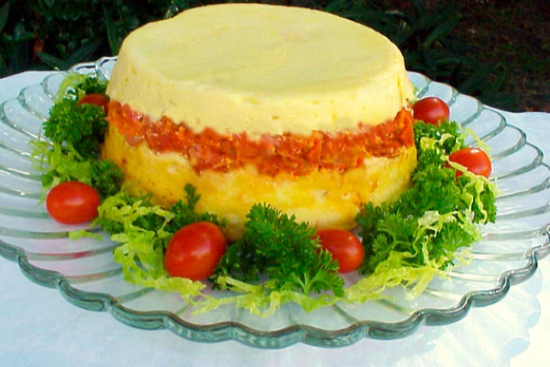
Serves: 6
Preparation time: 30 minutes
Cooking time:45 minutes
1 tablespoon butter, soft 1 tablespoon flour
4 tablespoons (1/2 stick) butter
1/2 cup flour
2 cups milk
1/2 teaspoon salt
1/4 teaspoon ground white pepper
1/4 teaspoon freshly ground nutmeg
6 eggs
1 cup (4 ounces by weight) grated Swiss cheese
1/4 teaspoon cream of tartar
For stewed tomatoes:
1 tablespoon olive oil
2 tablespoons chopped shallots
1 cup diced tomatoes, peeled and seeded
Preheat the oven to 350 degrees . Brush the interior of a 6-cup soufflé mold with the softened butter. Dust the bottom and sides with flour. Set aside.
In a heavy saucepan melt the butter. Stir in the flour with a wooden spoon and cook over low heat for 3 minutes. Add the milk. Cook over medium-high heat while whisking until sauce becomes thick and bubbly. Transfer the sauce to a large mixing bowl. Season with salt and pepper and nutmeg.
Separate the eggs. Mix egg yolks and cheeses in the thick cream sauce. (can be prepared 2 hours in advance up to this point.)
Stewed tomatoes:
In a medium saucepan, heat oil and shallots. Stir over medium heat for 5 minutes, Do not brown. Add tomatoes, and simmer until sauce is thick .
In an electric mixing bowl, whip the egg whites with cream of tartar until the whites are firm and fluffy. Using a rubber spatula, gently fold the whites into the cheese mixture. Pour one half of the mixture into mold. Spoon stewed tomatoes over soufflé and add remaining soufflé mixture. The mold will be full. Bake for 45 minutes. Take the soufflé out of the oven and allow to settle for 20 minutes on a large plate. Invert the soufflé over a serving platter.
In a heavy saucepan melt the butter. Stir in the flour with a wooden spoon and cook over low heat for 3 minutes. Add the milk. Cook over medium-high heat while whisking until sauce becomes thick and bubbly. Transfer the sauce to a large mixing bowl. Season with salt and pepper and nutmeg.
Separate the eggs. Mix egg yolks and cheeses in the thick cream sauce. (can be prepared 2 hours in advance up to this point.)
Stewed tomatoes:
In a medium saucepan, heat oil and shallots. Stir over medium heat for 5 minutes, Do not brown. Add tomatoes, and simmer until sauce is thick .
In an electric mixing bowl, whip the egg whites with cream of tartar until the whites are firm and fluffy. Using a rubber spatula, gently fold the whites into the cheese mixture. Pour one half of the mixture into mold. Spoon stewed tomatoes over soufflé and add remaining soufflé mixture. The mold will be full. Bake for 45 minutes. Take the soufflé out of the oven and allow to settle for 20 minutes on a large plate. Invert the soufflé over a serving platter.
Main Spaghetti bake 

Serves: 8
Preparation time: 20 minutes
Cooking time:1 hour 15 minutes
8 ounces spaghetti 1/4 cup grated Parmesan cheese
Tomato beef sauce:
1 teaspoon olive oil
1 onion, chopped
3 cloves garlic, minced
1 teaspoon each dried oregano and basil
1/2 teaspoon dried thyme
1 pound lean ground beef
2 cups sliced mushrooms
2 each carrots and zucchini, grated
1 sweet red pepper, diced
1 28-ounce can tomatoes, chopped
1/3 cup tomato paste
salt and pepper to taste
1/4 cup grated parmesan
1 teaspoon balsamic vinegar
Cheese sauce:
2 teaspoon butter
2 teaspoons flour
1 1/2 cups milk
1/2 cup ricotta cheese
1 egg, lightly beaten
salt to taste
Preheat oven to 350 degrees
Tomato beef sauce:
In Dutch oven, heat oil. Cook onion, garlic, oregano, basil, and thyme, for about 4 min. Add beef. Cook breaking up with spoon until no longer pink. Add mushrooms, carrots, zucchini, and pepper. Cook stirring often until liquid is evaporated. Remove from heat. Stir in cheese and vinegar.
Cheese sauce:
In saucepan, melt butter. Whisk in flour, stirring for 1 minute. Add milk; whisk until sauce boils and thickens. Transfer to bowl; let cool 10 minutes. Blend in ricotta, egg and cheese.
Cook spaghetti for 5 minutes or until almost tender but still firm. Drain and toss with beef sauce.
Spread in a baking dish (13x9-inch). Spoon cheese sauce over. Sprinkle with Parmesan cheese. Bake for 40 minutes.
Tomato beef sauce:
In Dutch oven, heat oil. Cook onion, garlic, oregano, basil, and thyme, for about 4 min. Add beef. Cook breaking up with spoon until no longer pink. Add mushrooms, carrots, zucchini, and pepper. Cook stirring often until liquid is evaporated. Remove from heat. Stir in cheese and vinegar.
Cheese sauce:
In saucepan, melt butter. Whisk in flour, stirring for 1 minute. Add milk; whisk until sauce boils and thickens. Transfer to bowl; let cool 10 minutes. Blend in ricotta, egg and cheese.
Cook spaghetti for 5 minutes or until almost tender but still firm. Drain and toss with beef sauce.
Spread in a baking dish (13x9-inch). Spoon cheese sauce over. Sprinkle with Parmesan cheese. Bake for 40 minutes.
Main Spaghetti meat sauce 

This sauce freezes well. Allow it to cool, then transfer into freezer-proof containers and freeze up to 1 month. Defrost and reheat as desired.
Serves: 6
1 medium yellow onion, finely chopped
6 cloves garlic, sliced
1/2 tsp. dried basil (optional)
1/2 tsp. dried oregano
3 tsp. kosher salt, divided
1 tsp. freshly ground black pepper, divided
1 lb. (85% lean) ground beef
2 (28-oz.) cans whole peeled tomatoes
1 Parmesan rind
1/4 cup chopped fresh basil
1 Tbsp. unsalted butter
Serves: 6
Preparation time:10 minutes
Cooking time:40 minutes
3 Tbsp. extra-virgin olive oil, divided 1 medium yellow onion, finely chopped
6 cloves garlic, sliced
1/2 tsp. dried basil (optional)
1/2 tsp. dried oregano
3 tsp. kosher salt, divided
1 tsp. freshly ground black pepper, divided
1 lb. (85% lean) ground beef
2 (28-oz.) cans whole peeled tomatoes
1 Parmesan rind
1/4 cup chopped fresh basil
1 Tbsp. unsalted butter
In a medium saucepan over medium heat, heat 2 tablespoons oil. Add onion, garlic, dried basil (if using), oregano, 1 teaspoon salt, and 1/2 teaspoon pepper and cook, stirring occasionally, until onion is translucent and light golden brown, about 7 minutes.
Increase heat to medium-high. Add beef and break up into small pieces with a wooden spoon. Cook, stirring occasionally and reducing heat if needed, until beef begins to brown, about 8 minutes; season with 1 teaspoon salt and remaining 1/2 teaspoon pepper.
In a medium bowl, crush tomatoes and their juices with your hands until small pieces form. Add tomatoes and Parmesan rind to saucepan and cook over medium heat, stirring occasionally, until sauce reduces by about one-quarter and raw tomato flavor has cooked out, 25 to 30 minutes. Remove from heat; discard Parmesan rind.
Add fresh basil, butter, and remaining 1 tablespoon oil and 1 teaspoon salt; toss to combine until sauce is glossy and butter is melted.
Note:
Don't mistake it for these popular tomato sauces:
— Bolognese sauce isn’t spaghetti sauce, and spaghetti sauce isn’t Bolognese. Bolognese is basically a glorified ragú—a long-simmered sauce that includes carrots and celery, red wine, beef stock, and milk.
— Marinara sauce is a little less involved, featuring crushed tomatoes, onion, garlic, olive oil, and basil. Cooked for under an hour, it’s less concentrated than sauces that have been stewing on the stove all afternoon.
— Pomodoro sauce is a quick-cooking fresh tomato sauce. Chopped fresh (not canned) tomatoes are briefly simmered with olive oil, garlic, and basil to preserve their bright flavor.
Increase heat to medium-high. Add beef and break up into small pieces with a wooden spoon. Cook, stirring occasionally and reducing heat if needed, until beef begins to brown, about 8 minutes; season with 1 teaspoon salt and remaining 1/2 teaspoon pepper.
In a medium bowl, crush tomatoes and their juices with your hands until small pieces form. Add tomatoes and Parmesan rind to saucepan and cook over medium heat, stirring occasionally, until sauce reduces by about one-quarter and raw tomato flavor has cooked out, 25 to 30 minutes. Remove from heat; discard Parmesan rind.
Add fresh basil, butter, and remaining 1 tablespoon oil and 1 teaspoon salt; toss to combine until sauce is glossy and butter is melted.
Note:
Don't mistake it for these popular tomato sauces:
— Bolognese sauce isn’t spaghetti sauce, and spaghetti sauce isn’t Bolognese. Bolognese is basically a glorified ragú—a long-simmered sauce that includes carrots and celery, red wine, beef stock, and milk.
— Marinara sauce is a little less involved, featuring crushed tomatoes, onion, garlic, olive oil, and basil. Cooked for under an hour, it’s less concentrated than sauces that have been stewing on the stove all afternoon.
— Pomodoro sauce is a quick-cooking fresh tomato sauce. Chopped fresh (not canned) tomatoes are briefly simmered with olive oil, garlic, and basil to preserve their bright flavor.
Main Spaghetti squash pesto with tomatoes 
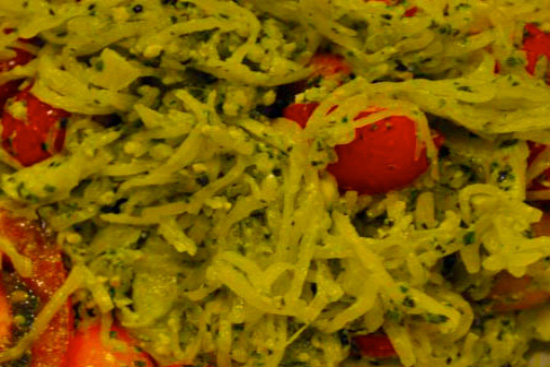
Squash can be prepared in advance.
Serves: 4
20 large basil leaves
2 cloves of garlic
1/4 cup olive oil
4 tbsp Parmigiano-Reggiano
salt and fresh pepper
8 cherry tomatoes, diced
Serves: 4
Preparation time: 20 minutes
Cooking time:20 minutes
1 small spaghetti squash20 large basil leaves
2 cloves of garlic
1/4 cup olive oil
4 tbsp Parmigiano-Reggiano
salt and fresh pepper
8 cherry tomatoes, diced
Cut squash in half lengthwise, scoop out seeds and fibers. Place in a microwave safe dish and cover. Microwave 8-9 minutes. Can also be baked at 350 degrees for one hour. When done, scoop out flesh with a fork into a large bowl.
In an electric blender combine basil, garlic, olive oil, Parmesan cheese, salt a pepper and puree until smooth.
Combine pesto with 4 cups spaghetti squash (save any remaining squash for another recipe). Add tomatoes and season with additional salt and pepper. Serve.
In an electric blender combine basil, garlic, olive oil, Parmesan cheese, salt a pepper and puree until smooth.
Combine pesto with 4 cups spaghetti squash (save any remaining squash for another recipe). Add tomatoes and season with additional salt and pepper. Serve.
Main Spaghetti with creamy garlic and leeks 
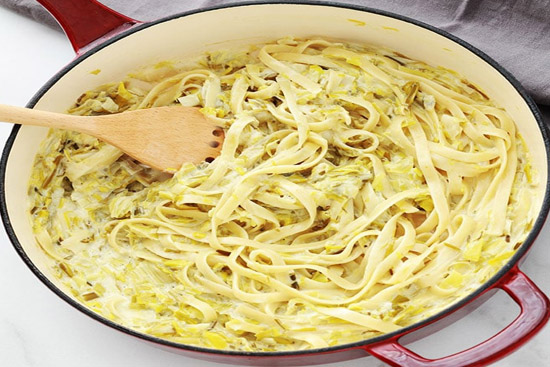
Creamy and garlicy; the leeks add a mellow onion flavor.
Serves: 4
1 Tbs. extra-virgin olive oil
6 medium leeks (light-green and white parts only), halved and sliced crosswise into 1/2-inch pieces (10 cups)
10 medium cloves garlic, halved
Kosher salt and freshly ground black pepper
1/2 cup dry white wine
1 cup lower-salt chicken broth
12 oz. dried spaghetti
1/2 cup heavy cream
1/2 oz. grated Pecorino Romano (1/3 cup)
1/4 cup chopped fresh flat-leaf parsley
Serves: 4
Preparation time: 20 minutes
Cooking time:1 hour
2 Tbs. unsalted butter1 Tbs. extra-virgin olive oil
6 medium leeks (light-green and white parts only), halved and sliced crosswise into 1/2-inch pieces (10 cups)
10 medium cloves garlic, halved
Kosher salt and freshly ground black pepper
1/2 cup dry white wine
1 cup lower-salt chicken broth
12 oz. dried spaghetti
1/2 cup heavy cream
1/2 oz. grated Pecorino Romano (1/3 cup)
1/4 cup chopped fresh flat-leaf parsley
Heat the butter and oil in a 12-inch skillet over medium-high heat until the butter has melted.
Add the leeks, garlic, 1/2 tsp. salt, and 1/4 tsp. pepper and cook, stirring often, until the leeks begin to brown, 3 to 5 minutes.
Add the wine and simmer until reduced by half, about 1 minute. Add the chicken broth and bring to a simmer.
Reduce the heat to low and press a 12-inch round piece of parchment over the leek mixture to cover completely.
Cover the skillet and cook, stirring occasionally, until the leeks are very soft but not falling apart and the garlic is very soft, about 40 minutes.
Meanwhile, bring a large pot of salted water to a boil and cook the spaghetti according to package directions until al dente. Drain, reserving 1/2 cup of the pasta cooking water.
Uncover the skillet and remove the parchment.
Add the cream and cook, stirring occasionally, until the sauce thickens slightly, about 3 minutes.
Add the cooked pasta and toss. Off the heat, stir in the cheese and parsley. Season to taste with salt and pepper, and serve.
Add the leeks, garlic, 1/2 tsp. salt, and 1/4 tsp. pepper and cook, stirring often, until the leeks begin to brown, 3 to 5 minutes.
Add the wine and simmer until reduced by half, about 1 minute. Add the chicken broth and bring to a simmer.
Reduce the heat to low and press a 12-inch round piece of parchment over the leek mixture to cover completely.
Cover the skillet and cook, stirring occasionally, until the leeks are very soft but not falling apart and the garlic is very soft, about 40 minutes.
Meanwhile, bring a large pot of salted water to a boil and cook the spaghetti according to package directions until al dente. Drain, reserving 1/2 cup of the pasta cooking water.
Uncover the skillet and remove the parchment.
Add the cream and cook, stirring occasionally, until the sauce thickens slightly, about 3 minutes.
Add the cooked pasta and toss. Off the heat, stir in the cheese and parsley. Season to taste with salt and pepper, and serve.
Main Spinach and pasta salad 
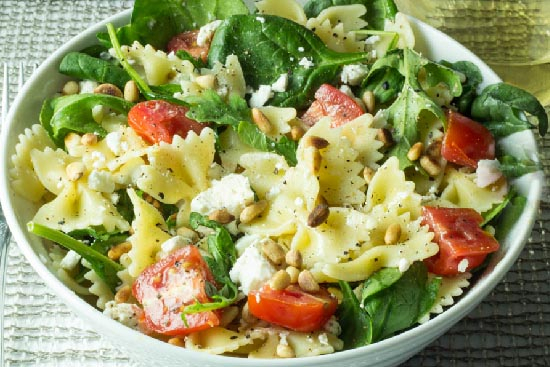
Serves: 6
Preparation time: 20 minutes
Cooking time:10 minutes
6 cups Farfalle pasta 3/4 cup sliced red pepper
4 green onions, sliced
2/3 cup crumbled feta cheese
2/3 cup shredded fresh basil
2 cups lightly packed fresh spinach
8 cherry tomatoes, quartered
Dressing:
1/3 cup olive oil
3 tablespoons white wine vinegar
1 teaspoon Dijon mustard
1/2 teaspoon salt
1/4 teaspoon pepper
1 large clove garlic, minced
Cook pasta until firm but tender. Drain and rinse under cold water; drain again very well.
Whisk together oil, vinegar, mustard, salt, pepper and garlic. Add pasta, red pepper, onions, feta cheese and half of the shredded basil; toss gently. Stack spinach leaves and roll up tightly; cut crosswise into thin strips.
Add to salad along with tomatoes and remaining basil; toss gently.
Whisk together oil, vinegar, mustard, salt, pepper and garlic. Add pasta, red pepper, onions, feta cheese and half of the shredded basil; toss gently. Stack spinach leaves and roll up tightly; cut crosswise into thin strips.
Add to salad along with tomatoes and remaining basil; toss gently.
Main Spring green risotto 

Recipe adaptation and courtesy of Courtesy Ina Garten from her new cookbook Back to Basics.
Serves: 6
1-1/2 tablespoons unsalted butter
3 cups chopped leeks, white and light green parts (2 leeks)
1 cup chopped fennel
1-1/2 cups Arborio rice
2/3 cup dry white wine
4 to 5 cups simmering chicken stock
1 pound thin asparagus
5 ounces frozen peas, defrosted, or 1 1/2 cups shelled fresh peas
5 ounces fava beans
1 tablespoon freshly grated lemon zest (2 lemons)
Kosher salt and freshly ground black pepper
2 tablespoons freshly squeezed lemon juice
1/3 cup mascarpone cheese, preferably Italian
1/2 cup freshly grated Parmesan cheese, plus extra for serving
3 tablespoons minced fresh chives, plus extra for serving
Serves: 6
Preparation time: 20 minutes
Cooking time:40 minutes
1- 1/2 tablespoons good olive oil1-1/2 tablespoons unsalted butter
3 cups chopped leeks, white and light green parts (2 leeks)
1 cup chopped fennel
1-1/2 cups Arborio rice
2/3 cup dry white wine
4 to 5 cups simmering chicken stock
1 pound thin asparagus
5 ounces frozen peas, defrosted, or 1 1/2 cups shelled fresh peas
5 ounces fava beans
1 tablespoon freshly grated lemon zest (2 lemons)
Kosher salt and freshly ground black pepper
2 tablespoons freshly squeezed lemon juice
1/3 cup mascarpone cheese, preferably Italian
1/2 cup freshly grated Parmesan cheese, plus extra for serving
3 tablespoons minced fresh chives, plus extra for serving
Heat the olive oil and butter in a medium saucepan over medium heat. Add the leeks and fennel and saute for 5 to 7 minutes, until tender. Add the rice and stir for a minute to coat with the vegetables, oil, and butter. Add the white wine and simmer over low heat, stirring constantly, until most of the wine has been absorbed. Add the chicken stock, 2 ladles at a time, stirring almost constantly and waiting for the stock to be absorbed before adding more. This process should take 25 to 30 minutes.
Meanwhile, cut the asparagus diagonally in 1 1/2-inch lengths and discard the tough ends. Blanch in boiling salted water for 4 to 5 minutes, until al dente. Drain and cool immediately in ice water. (If using fresh peas and fresh fava beans, blanch them in boiling water for a few minutes until the starchiness is gone.)
When the risotto has been cooking for 15 minutes, drain the asparagus and add it to the risotto with the peas, lemon zest, 2 teaspoons salt, and 1 teaspoon pepper. continue cooking and adding stock, stirring almost constantly, until the rice is tender but still firm.
Whisk the lemon juice and mascarpone together in a small bowl. When the risotto is done, turn off the heat and stir in the mascarpone mixture plus the Parmesan cheese and chives. set aside off the heat for a few minutes, sprinkle with salt and pepper, and serve hot with a sprinkling of chives and more Parmesan cheese.
Meanwhile, cut the asparagus diagonally in 1 1/2-inch lengths and discard the tough ends. Blanch in boiling salted water for 4 to 5 minutes, until al dente. Drain and cool immediately in ice water. (If using fresh peas and fresh fava beans, blanch them in boiling water for a few minutes until the starchiness is gone.)
When the risotto has been cooking for 15 minutes, drain the asparagus and add it to the risotto with the peas, lemon zest, 2 teaspoons salt, and 1 teaspoon pepper. continue cooking and adding stock, stirring almost constantly, until the rice is tender but still firm.
Whisk the lemon juice and mascarpone together in a small bowl. When the risotto is done, turn off the heat and stir in the mascarpone mixture plus the Parmesan cheese and chives. set aside off the heat for a few minutes, sprinkle with salt and pepper, and serve hot with a sprinkling of chives and more Parmesan cheese.
Main Striped bass italienne 
Serves: 6
Preparation time: 25 minutes
Cooking time:25 minutes
2 pounds striped bass fillet 1/2 teaspoon salt
1/4 teaspoon white pepper
2 ounces flour
12 small clams
12 cleaned mussels
1 pound chopped tomatoes
2 cloves minced garlic
1 tablespoon parsley
1 tablespoon basil
3/4 cup clam juice
Cut the fillets into equal portions. Season with salt and pepper. Dredge in flour. Deep fry at 360 F (185 C) for 5 minutes, or until half cooked. Drain well.
Arrange fish on a baking dish. Surround with cherrystone clams and mussels.
Spoon the chopped seeded tomatoes and garlic over fish. Sprinkle with herbs and pour clam juice over.
Bake at 350 F (180 C) for 10 to 15 minutes, or until shellfish open. Arrange fish and shellfish on a serving platter.
Pour cooking liquid over. Serve hot.
Arrange fish on a baking dish. Surround with cherrystone clams and mussels.
Spoon the chopped seeded tomatoes and garlic over fish. Sprinkle with herbs and pour clam juice over.
Bake at 350 F (180 C) for 10 to 15 minutes, or until shellfish open. Arrange fish and shellfish on a serving platter.
Pour cooking liquid over. Serve hot.
Main Stuffed chicken breasts 
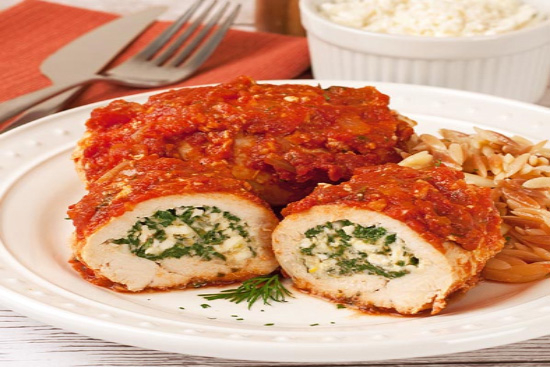
Serves: 4
Preparation time: 15 minutes
Cooking time:1 hour
2 whole chicken breasts 2 teaspoons olive oil
1 teaspoon fresh thyme
1/4 teaspoon salt
1 medium chopped onion
1 teaspoon oil
1 teaspoon butter
1 pound chopped spinach
1/2 cup ricotta cheese
1/2 cup grated Parmesan
2 chopped basil leaves
1 cup yogurt
1 teaspoon wine vinegar
1 medium chopped tomato
4 large chopped basil
For the stuffing:
Sauté onion in oil and butter over low heat. Add spinach and cook for about 10 minutes. Transfer to a bowl and add the ricotta, Parmesan and basil leaves.
Loosen the skin of each breast by slipping the finger between the flesh and the skin. Divide the stuffing among the breasts and neatly fill the pockets. Place the breasts skin side up in a baking dish. Sprinkle with olive oil and rub with thyme and salt.
Bake for 45 minutes at 375 degrees or until skin is brown. Cool chicken then cut in half.
Serve with the yogurt sauce. To make the sauce: Combine the yogurt, vinegar, tomato and basil. Season to taste with salt and pepper.
Sauté onion in oil and butter over low heat. Add spinach and cook for about 10 minutes. Transfer to a bowl and add the ricotta, Parmesan and basil leaves.
Loosen the skin of each breast by slipping the finger between the flesh and the skin. Divide the stuffing among the breasts and neatly fill the pockets. Place the breasts skin side up in a baking dish. Sprinkle with olive oil and rub with thyme and salt.
Bake for 45 minutes at 375 degrees or until skin is brown. Cool chicken then cut in half.
Serve with the yogurt sauce. To make the sauce: Combine the yogurt, vinegar, tomato and basil. Season to taste with salt and pepper.
Main Stuffed pork chops with polenta and tomatoes 
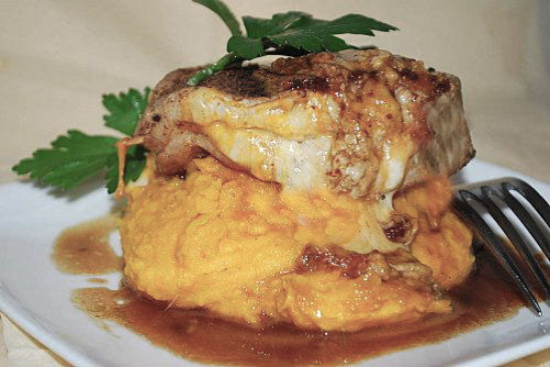
Serves: 4
Preparation time: 10 minutes
Cooking time:20 minutes
1 cup quick-cooking polentaFour 1-inch thick bone-in pork chops (about 2 1/2 pounds total)
Four 1/4-inch thick slices smoked mozzarella (about 3 1/2 ounces)
4 teaspoons anchovy paste, divided or 4 teaspoons finely chopped capers
1/4 cup plus 1 tablespoon extra-virgin olive oil, divided
2 teaspoons kosher salt, divided
1 1/2 teaspoons freshly ground black pepper, divided
4 garlic cloves, minced
2 pints grape tomatoes cut in half (about 3 1/2 cups)
1/2 cup vegetable broth
3 tablespoons unsalted butter, divided
1/2 cup milk
Chopped flat-leaf parsley, for sprinkling
Preheat broiler on high and set oven rack 4 inches from heat. Line broiler pan or rimmed baking sheet with foil.
In a medium saucepan, prepare polenta according to package directions. While polenta is cooking, prepare the pork chops.
Place chops flat on cutting board and, using a sharp paring knife, make a horizontal slit 3 to 4 inches deep and 3 to 4 inches long
in the side of each chop.
Spread each mozzarella slice with 1 teaspoon anchovy paste. Stuff a piece of mozzarella inside each chop, press the pork closed, and secure with a toothpick.
Rub the chops with 1 tablespoon oil, season with 1/2 teaspoon salt and 1/2 teaspoon pepper, and place on the foil-lined pan.
Broil until cooked through, about 5 minutes per side.
Meanwhile, in a large skillet over medium-high heat, warm remaining 1/4 cup oil. Add garlic, tomatoes, and broth.
Cover and cook until tomatoes softened and just beginning to burst, 5 to 6 minutes.
Stir in 1 tablespoon butter, 1/2 teaspoon salt, and 1/4 teaspoon pepper. Taste and adjust seasoning.
When the polenta is cooked, whisk in enough milk to thin the polenta to your desired consistency. Taste and adjust seasoning.
Serve pork chops over polenta, topped with tomato pan sauce and parsley.
In a medium saucepan, prepare polenta according to package directions. While polenta is cooking, prepare the pork chops.
Place chops flat on cutting board and, using a sharp paring knife, make a horizontal slit 3 to 4 inches deep and 3 to 4 inches long
in the side of each chop.
Spread each mozzarella slice with 1 teaspoon anchovy paste. Stuff a piece of mozzarella inside each chop, press the pork closed, and secure with a toothpick.
Rub the chops with 1 tablespoon oil, season with 1/2 teaspoon salt and 1/2 teaspoon pepper, and place on the foil-lined pan.
Broil until cooked through, about 5 minutes per side.
Meanwhile, in a large skillet over medium-high heat, warm remaining 1/4 cup oil. Add garlic, tomatoes, and broth.
Cover and cook until tomatoes softened and just beginning to burst, 5 to 6 minutes.
Stir in 1 tablespoon butter, 1/2 teaspoon salt, and 1/4 teaspoon pepper. Taste and adjust seasoning.
When the polenta is cooked, whisk in enough milk to thin the polenta to your desired consistency. Taste and adjust seasoning.
Serve pork chops over polenta, topped with tomato pan sauce and parsley.
Main Summer pasta vegetable salad 
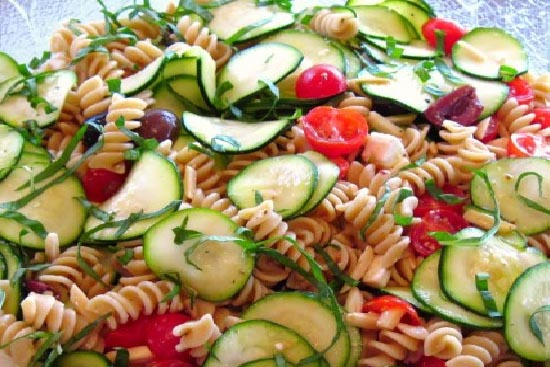
Serves: 6
Preparation time: 15 minutes
Cooking time:15 minutes
1 package (450g) fusilli or rotini 2 tablespoons olive oil
4 cups small zucchini (quartered lengthwise and sliced)
1 clove garlic, minced
4 cups chopped tomatoes
1/4 cup white wine
1/3 cup chopped fresh basil
1/4 cup chopped fresh chives
1/4 cup chopped flat leaf parsley
2 tablespoons chopped fresh marjoram
salt and pepper to taste
freshly grated Parmesan cheese
Cook pasta until tender but firm; drain and keep hot. Meanwhile, in large skillet over medium heat, heat oil.
Add zucchini and garlic; cook for 5 minutes, stirring frequently. Add tomatoes and wine, cook, stirring frequently, for 5 minutes or until sauce thickens.
Stir in herbs; cook 2 minutes. Season with salt and pepper. Toss sauce with hot pasta.
Serve immediately, with parmesan cheese for sprinkling on top.
Add zucchini and garlic; cook for 5 minutes, stirring frequently. Add tomatoes and wine, cook, stirring frequently, for 5 minutes or until sauce thickens.
Stir in herbs; cook 2 minutes. Season with salt and pepper. Toss sauce with hot pasta.
Serve immediately, with parmesan cheese for sprinkling on top.
Main Summer squash skins with garlic bread crumbs 
Serves: 4
Preparation time: 20 minutes
Cooking time:20 minutes
Olive oil cooking spray 4 cloves garlic, chopped
1/4 cup fresh bread crumbs
3 1/2 pounds zucchini or combination of zucchini and yellow crookneck squash, each no longer than 6 inches
1 tablespoon butter
1 tablespoon extra-virgin olive oil
Kosher salt and freshly ground black pepper to taste
3 tablespoons chopped fresh parsley
1. Preheat oven to 400°F. Spray a small baking sheet with olive oil cooking spray. Combine garlic and bread crumbs and spread evenly on the baking sheet. Spray again with olive oil cooking spray and bake 10 to 15 minutes or until nicely browned. Stir a few times to toast evenly.
2. Meanwhile, trim ends of the squash. Holding each squash upright (vertically,) slice off the skin into long, narrow slices all around. (You should have about 1 1/4 pounds.) Cut slices into long strips, about 1/4 inch wide. Use the inside pulp for Zucchini Pancakes.
3. Put butter and oil in a large skillet or wok over medium high heat. Add squash strips, raise heat to high, and toss. Cook, tossing occasionally, until squash are just beginning to soften but are still slightly crunchy, about 5 minutes.
4. Add garlic bread crumbs, and parsley, toss, and serve.
2. Meanwhile, trim ends of the squash. Holding each squash upright (vertically,) slice off the skin into long, narrow slices all around. (You should have about 1 1/4 pounds.) Cut slices into long strips, about 1/4 inch wide. Use the inside pulp for Zucchini Pancakes.
3. Put butter and oil in a large skillet or wok over medium high heat. Add squash strips, raise heat to high, and toss. Cook, tossing occasionally, until squash are just beginning to soften but are still slightly crunchy, about 5 minutes.
4. Add garlic bread crumbs, and parsley, toss, and serve.
Main Summer tomato salad 
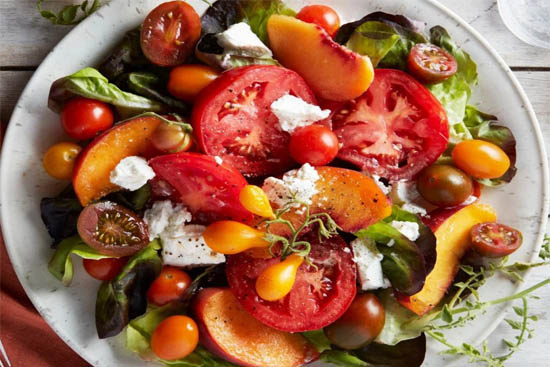
This vinaigrette is perfect for your tomato salads
Summer is undoubtedly salad season! And the secret to a successful salad is the VINAIGRETTE.
Serves: 4
2 Pineapple Tomatoes
1 Beefsteak Tomato
1 Black Crimean Tomato
1 small white Onion
For the vinaigrette:
2 tbsp. toasted sesame oil
2 tbsp. rice vinegar
1 tbsp soy sauce
2 tsp. Dijon Mustard
Coriander (optional)
Sesame seeds (optional)
Serves: 4
Preparation time:15 minutes
2 Green Zebra Tomatoes2 Pineapple Tomatoes
1 Beefsteak Tomato
1 Black Crimean Tomato
1 small white Onion
For the vinaigrette:
2 tbsp. toasted sesame oil
2 tbsp. rice vinegar
1 tbsp soy sauce
2 tsp. Dijon Mustard
Coriander (optional)
Sesame seeds (optional)
Peel and finely chop the onions.
Wash and slice the tomatoes and set aside on a plate.
Add the sesame oil, soy sauce, rice vinegar, and mustard to a salad bowl and mix.
Pour the mixture over the tomatoes.
Add a few cilantro leaves and sesame seeds.
Wash and slice the tomatoes and set aside on a plate.
Add the sesame oil, soy sauce, rice vinegar, and mustard to a salad bowl and mix.
Pour the mixture over the tomatoes.
Add a few cilantro leaves and sesame seeds.
Main The pasta salad 
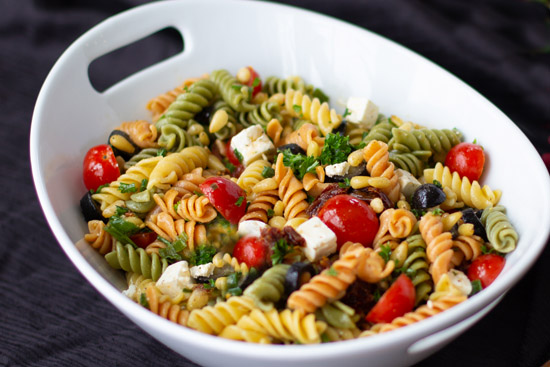
Fusilli, Rotini, Gemelli.
These spiral-shaped pastas are fairly similar to each other and give dishes such as pasta salad an interesting texture. Rotini is similar to fusilli, just slightly smaller and more tightly wound. Gemelli is double-twisted like a helix.
Serves: 5
Good olive oil
1 pound ripe tomatoes, medium-diced
3/4 cup good black olives, such as kalamata, pitted and diced
4 oz good feta cheese, medium-diced
6 sun-dried tomatoes in oil, drained and chopped
For the dressing:
1/2 cup sun-dried tomatoes in oil, drained and diced
3 tablespoons red wine vinegar
6 tablespoons good olive oil
1 garlic clove, diced
1 tbsp capers, drained
1/4 teaspoon freshly ground black pepper
1/3 cup freshly grated Parmesan
3/4 cup parsley, chopped
Serves: 5
Preparation time:20 minutes
Cooking time:20 minutes
1/2 pound Fusilli, Rotini, Gemelli pasta Good olive oil
1 pound ripe tomatoes, medium-diced
3/4 cup good black olives, such as kalamata, pitted and diced
4 oz good feta cheese, medium-diced
6 sun-dried tomatoes in oil, drained and chopped
For the dressing:
1/2 cup sun-dried tomatoes in oil, drained and diced
3 tablespoons red wine vinegar
6 tablespoons good olive oil
1 garlic clove, diced
1 tbsp capers, drained
1/4 teaspoon freshly ground black pepper
1/3 cup freshly grated Parmesan
3/4 cup parsley, chopped
Cook the pasta in a large pot of boiling water. Boil for 12 minutes, or according to the directions on the package. Drain well and allow to cool. Place the pasta in a large bowl and add the tomatoes, olives, feta and chopped sun-dried tomatoes.
The dressing:
combine the sun-dried tomatoes, vinegar, olive oil, garlic, capers in a food processor until almost smooth.
Pour the dressing over the pasta, sprinkle with the Parmesan and parsley, and toss well.
The dressing:
combine the sun-dried tomatoes, vinegar, olive oil, garlic, capers in a food processor until almost smooth.
Pour the dressing over the pasta, sprinkle with the Parmesan and parsley, and toss well.
Main Tomato and Seafood Penne 
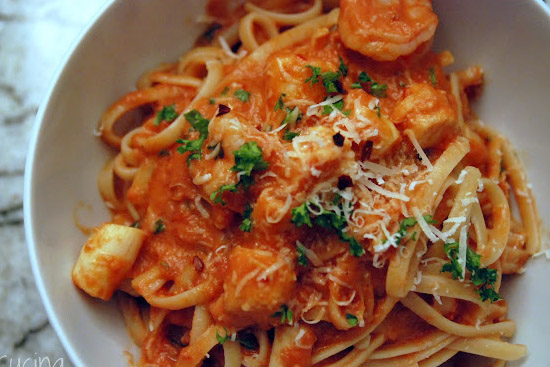
Serves: 4
Preparation time: 40 minutes
Cooking time:15 minutes
7 oz (225 g) whole wheat penne or linguine2 tsp olive oil
3 shallots, chopped
2 leeks, (white and light green parts only halved lengthwise and thinly sliced crosswise
3 cloves garlic, minced
2 cups (500 mL) no-salt-added canned diced tomatoes
1 tsp dried oregano
Pinch each hot pepper flakes, salt and pepper
6 oz (170 g) frozen scallops, (about 10) thawed and halved
6 oz (170 g) frozen jumbo shrimp, (about 8) thawed, peeled, deveined and cut in half lengthwise
6 cups (1.5 L) packed baby spinach
1/3 cup (75 mL) grated parmesan cheese
1/4 cup (60 mL) chopped fresh basil
In large pot of boiling water, cook penne according to package directions. Drain, reserving 1/4 cup of the cooking liquid.
Meanwhile, in large nonstick skillet, heat oil over medium heat; cook shallots, leeks and garlic, stirring occasionally, until softened, about 5 minutes. Stir in tomatoes, oregano, hot pepper flakes, salt and pepper; simmer for 5 minutes.
Add scallops and shrimp; cook, stirring occasionally, until shrimp are pink and scallops are opaque, about 3 minutes.
Stir in pasta and spinach; cook until spinach is wilted, about 2 minutes. Stir in enough of the reserved cooking liquid to coat; transfer to serving platter. Sprinkle with Parmesan cheese and basil.
Meanwhile, in large nonstick skillet, heat oil over medium heat; cook shallots, leeks and garlic, stirring occasionally, until softened, about 5 minutes. Stir in tomatoes, oregano, hot pepper flakes, salt and pepper; simmer for 5 minutes.
Add scallops and shrimp; cook, stirring occasionally, until shrimp are pink and scallops are opaque, about 3 minutes.
Stir in pasta and spinach; cook until spinach is wilted, about 2 minutes. Stir in enough of the reserved cooking liquid to coat; transfer to serving platter. Sprinkle with Parmesan cheese and basil.
Main Tomato pie with polenta crust 
Serves: 4
Preparation time: 30 minutes
Cooking time:45 minutes
For filling: olive oil
3 tomatoes
1 small zucchini
1 red onion, thickly sliced
1/4 teaspoon each salt and pepper
For crust:
olive oil
1/2 cup cornmeal
3/4 cup water
1/2 cup milk
1 egg white
1/2 cup grated Parmesan cheese
1/4 cup flour
1 teaspoon baking powder
1/4 teaspoon salt
1/4 cup chopped fresh parsley
1/4 teaspoon chopped fresh thyme
1/4 cup Emmenthal cheese
Preheat broiler to high. Line a baking sheet with foil; brush with oil. Cut tomatoes into 1/2-inch slices; scoop out and discard seeds and juice. Cut zucchini into 1/4-inch diagonal slices.
Arrange tomatoes, zucchini and onion in single layer on baking sheet; brush vegetables with oil and sprinkle with salt and pepper. Broil until surface of tomatoes appears dry and zucchini and onions are browned. Set aside.
Lightly oil a 9-in pie plate or cake pan; sprinkle base and sides with a little cornmeal, tilting pan to coat entire surface evenly.
Tap pan to remove excess; set aside. In medium saucepan combine 1/2 cup cornmeal and the water; bring to boil over medium-high heat.
Reduce heat to low; cook, stirring constantly, 3 minutes or until mixture thickens and pulls away from sides of pan.
Whisk in milk until mixture is smooth. Set aside 5 minutes to cool slightly. Whisk in egg white; stir in Parmesan cheese.
In small bowl, combine flour, baking powder and salt; stir into cornmeal mixture until well combined.
Spread cornmeal mixture over base and up sides of prepared pan to form 1/2-in thick layer. Sprinkle with half of parsley and thyme. Using a slotted metal spatula, lift vegetables from baking sheet, draining off juices.
Cover cornmeal mixture with half of tomatoes, half of onion, the remaining thyme and all but 1 tablespoon of the parsley.
Arrange remaining tomatoes, the zucchini and onion decoratively on top. Bake in a 375 degree oven for 35 minutes or until crust is puffed and golden. Sprinkle evenly Emmenthal and reserved parsley. Let stand 15 minutes before cutting into wedges.
Arrange tomatoes, zucchini and onion in single layer on baking sheet; brush vegetables with oil and sprinkle with salt and pepper. Broil until surface of tomatoes appears dry and zucchini and onions are browned. Set aside.
Lightly oil a 9-in pie plate or cake pan; sprinkle base and sides with a little cornmeal, tilting pan to coat entire surface evenly.
Tap pan to remove excess; set aside. In medium saucepan combine 1/2 cup cornmeal and the water; bring to boil over medium-high heat.
Reduce heat to low; cook, stirring constantly, 3 minutes or until mixture thickens and pulls away from sides of pan.
Whisk in milk until mixture is smooth. Set aside 5 minutes to cool slightly. Whisk in egg white; stir in Parmesan cheese.
In small bowl, combine flour, baking powder and salt; stir into cornmeal mixture until well combined.
Spread cornmeal mixture over base and up sides of prepared pan to form 1/2-in thick layer. Sprinkle with half of parsley and thyme. Using a slotted metal spatula, lift vegetables from baking sheet, draining off juices.
Cover cornmeal mixture with half of tomatoes, half of onion, the remaining thyme and all but 1 tablespoon of the parsley.
Arrange remaining tomatoes, the zucchini and onion decoratively on top. Bake in a 375 degree oven for 35 minutes or until crust is puffed and golden. Sprinkle evenly Emmenthal and reserved parsley. Let stand 15 minutes before cutting into wedges.
Main Tomato-basil tortellini 
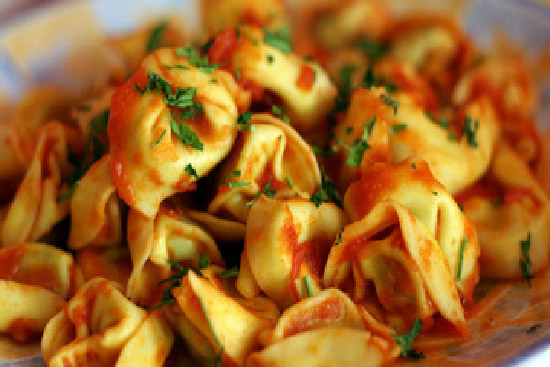
Serves: 6
Preparation time: 25 minutes
Cooking time:40 minutes
2 medium chopped onions 2 cloves minced garlic
2 stalks chopped celery
2 medium chopped carrots
2 teaspoons vegetable oil
28 ounces canned tomatoes
1 teaspoon tomato paste
1/4 cup chopped parsley
2 teaspoons chopped basil
1 1/2 pounds tortellini
1 cup heavy cream
1 sweet red pepper
Heat oil in a saucepan and sauté the first ingredients until carrots are tender.
Chop tomatoes in food processor. Stir tomatoes, tomato paste, parsley and basil in pan. Simmer uncovered over low heat for 15 to 20 minutes while stirring frequently.
Cook tortellini in boiling water for 8 to 10 minutes. Drain. Stir cream and chopped red pepper into tomato sauce. Continue cooking until sauce is reduced and thickened then place the pasta in a large shallow serving dish.
Pour the sauce over pasta. Toss gently and serve hot.
Chop tomatoes in food processor. Stir tomatoes, tomato paste, parsley and basil in pan. Simmer uncovered over low heat for 15 to 20 minutes while stirring frequently.
Cook tortellini in boiling water for 8 to 10 minutes. Drain. Stir cream and chopped red pepper into tomato sauce. Continue cooking until sauce is reduced and thickened then place the pasta in a large shallow serving dish.
Pour the sauce over pasta. Toss gently and serve hot.
Main Tomatoes stuffed with goat cheese 

Serves: 4
Preparation time: 20 minutes
Cooking time:15 minutes
4 medium tomatoes, firm 10 ounces fresh goat cheese
fresh ground pepper, to taste
1 large egg
1 egg yolk
1 tablespoon fresh basil, chopped
3 tablespoons bread crumbs
1/4 cup Parmesan cheese, grated
Preheat oven at 400 degrees.
Slice stem end off tomatoes. Scoop out seeds and some meat. Place tomatoes upside down on paper towels to drain liquid.
Soften goat cheese. Season with pepper. Add eggs and basil. Mix well. In another bowl, combine bread crumbs and cheese.
Fill tomatoes with goat cheese mix.
Sprinkle Parmesan mixture on top. Bake on oiled cookie sheet for 10 minutes. Broil to brown.
Slice stem end off tomatoes. Scoop out seeds and some meat. Place tomatoes upside down on paper towels to drain liquid.
Soften goat cheese. Season with pepper. Add eggs and basil. Mix well. In another bowl, combine bread crumbs and cheese.
Fill tomatoes with goat cheese mix.
Sprinkle Parmesan mixture on top. Bake on oiled cookie sheet for 10 minutes. Broil to brown.
Main Tortellini tomato soup 

Serves: 4
Preparation time:15 minutes
Cooking time:20 minutes
2 tablespoons unsalted butter1 medium yellow onion, diced
2 cloves garlic, minced
1/2 teaspoon kosher salt
1/4 teaspoon freshly ground black pepper
1 tablespoon balsamic vinegar
4 cups (32 ounces) low-sodium vegetable or chicken broth
1 (28-ounce) can crushed tomatoes
1/2 cup heavy cream
2 bay leaves
1 (14-ounce) package fresh or frozen cheese tortellini
1/2 cup fresh basil leaves, thinly sliced, plus more for garnish
Grated or shredded Parmesan cheese, for garnish (optional)
Melt the butter in a Dutch oven over medium heat. Add the onion, garlic, salt, and pepper and cook, stirring occasionally, until tender, about 6 minutes.
Stir in the vinegar. Add the crushed tomatoes, broth, cream, and bay leaves, and bring to a boil. Reduce the heat to a simmer and simmer for 5 minutes. Add the tortellini and simmer until cooked through, 5 to 6 minutes more (check at 3 minutes for fresh tortellini).
Remove from the heat, remove and discard the bay leaves, and stir in the basil. Ladle into bowls and top with Parmesan cheese and more basil, if desired.
Stir in the vinegar. Add the crushed tomatoes, broth, cream, and bay leaves, and bring to a boil. Reduce the heat to a simmer and simmer for 5 minutes. Add the tortellini and simmer until cooked through, 5 to 6 minutes more (check at 3 minutes for fresh tortellini).
Remove from the heat, remove and discard the bay leaves, and stir in the basil. Ladle into bowls and top with Parmesan cheese and more basil, if desired.
Main Tri-color salad 
Serves: 4
Preparation time: 20 minutes
2 large Belgian Endives 1 small head of red-leaf lettuce
1 small head of green-leaf lettuce
1 small bunch of watercress
Dressing:
2 tablespoons balsamic vinegar
1/2 teaspoon salt or to taste
1/4 teaspoon pepper or to taste
1/3 cup olive oil
3 tablespoons orange juice
1 tablespoon mustard
juice of one large garlic clove
Combine the dressing ingredients and pour them over the bowl of cleaned salad ingredients.
Toss salad and serve.
Depending on your taste and preference, several other recipes are possible.
Combine Belgian Endive with raddichio, red leaf lettuce, or red beets for the red ingredients and with arrugula, romaine lettuce, mache, or Boston lettuce for the green ingredients.
Toss salad and serve.
Depending on your taste and preference, several other recipes are possible.
Combine Belgian Endive with raddichio, red leaf lettuce, or red beets for the red ingredients and with arrugula, romaine lettuce, mache, or Boston lettuce for the green ingredients.
Main Tuscan ribollita soup 
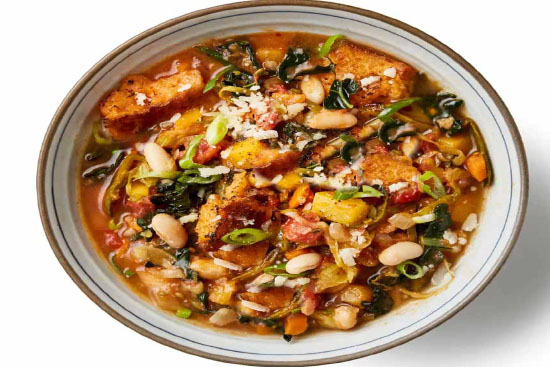
Ribollita is the name of the famous Tuscan soup, a traditional Italian recipe from the cities of Florence, Arezzo and Pisa.
"Ribollita" means "reboiled", that is, you cook it once, then let it rest for a couple of hours, then cook it again by reboiling it.
Serves: 6
300 g (10 oz) of stale bread. In Italy, we use Tuscan ciabatta bread, which is traditionally salt-free.
400 g (14 oz) of cavolo nero (Dino Kale)
250 g (9 oz) of savoy cabbage or green cabbage
250 g (10 oz) of Swiss chard
250 g (~10 oz) of potatoes (1 medium potato or 2 small potatoes)
180 g (6,4 0z) of peeled tomatoes
1 large onion
2 carrots
1 celery stalk
2 sprigs of fresh rosemary
2 springs of fresh thyme
about 2 liters (8 ½ cups) of vegetable broth or hot bean cooking water (the kind you get when using dried cannellini beans)
70 g (5 tablespoons) of extra-virgin olive oil
Fine salt to taste
Ground black pepper to taste
1 - DRIED BEANS - This recipe calls for dried cannellini beans. If you are using this ingredient, soak the dried cannellini beans in plenty of cold water the night before.
Once the beans are tender, drain and cook in at least 3 liters (12 ¾ cups) of water - scented with a sprig of rosemary - over medium-low heat for at least 1 hour.
Then drain the beans, saving the cooking water. Keep half the beans whole and puree the other half with an immersion blender. Set aside.
CANNED BEANS - If using canned beans, remove the liquid and rinse under cold water. Blend half of them and set aside.
2 - On a cutting board, chop the onion, carrot and celery into small pieces.
Then peel the potato and cut it into fairly large pieces.
3 - Wash and slice the cabbage, chard and kale.
Place the peeled tomatoes in a bowl with their juice and mash with a fork. Set aside.
4 - In a large saucepan, saute the carrot, onion, and celery with 4 tablespoons of EVO oil over medium heat for about 1 minute.
Then add the potatoes and a sprig of thyme and rosemary. Cook over medium heat, stirring, for about 3 minutes.
Finally, add the tomatoes.
5 - Stir and cook over medium heat for about two minutes. Then add the cabbage, chard, and kale.
At this point, add 2 liters (8 ½ cups) of bean cooking water (or vegetable broth if using canned beans).
6 - Cover and cook on a low heat for about 2 hours. If the ribollita soup gets too dry, add a ladle of hot water or hot vegetable broth.
After about 2 hours, the soup will be cooked and the vegetables will be soft. At this point, add the cream of beans and stir.
7 - Cook for another 10 minutes, stirring occasionally. Now add the whole beans that have been kept aside.
After another 10 minutes or so, season with salt and pepper, stir and remove from heat.
The ribollita soup is almost ready.
8 - Cut the stale bread into large slices or pieces.
Now take a pot or high-sided casserole that is larger than the one that holds the vegetable soup.
Place the stale bread slices on the bottom and add a few ladles of soup.
9 - Repeat adding a layer of bread and a layer of soup until the pot is full.
Allow to cool at room temperature, then cover with plastic wrap and keep in the fridge for at least 2 hours.
PLEASE NOTE: This time in the refrigerator is necessary to allow the bread to absorb all the liquid from the soup and to give the ribollita its typical thick consistency.
At the end of this time, take the pot. The bread will have absorbed the soup and will be completely melted. The soup will be semi-solid.
Return to the heat and bring to a boil. Serve hot.
"Ribollita" means "reboiled", that is, you cook it once, then let it rest for a couple of hours, then cook it again by reboiling it.
Serves: 6
Preparation time:40 minutes
Cooking time:2 hours
400 g (14 oz) of dried cannellini beans or 800 g (1 ¾ pounds) of canned cannellini beans. 300 g (10 oz) of stale bread. In Italy, we use Tuscan ciabatta bread, which is traditionally salt-free.
400 g (14 oz) of cavolo nero (Dino Kale)
250 g (9 oz) of savoy cabbage or green cabbage
250 g (10 oz) of Swiss chard
250 g (~10 oz) of potatoes (1 medium potato or 2 small potatoes)
180 g (6,4 0z) of peeled tomatoes
1 large onion
2 carrots
1 celery stalk
2 sprigs of fresh rosemary
2 springs of fresh thyme
about 2 liters (8 ½ cups) of vegetable broth or hot bean cooking water (the kind you get when using dried cannellini beans)
70 g (5 tablespoons) of extra-virgin olive oil
Fine salt to taste
Ground black pepper to taste
1 - DRIED BEANS - This recipe calls for dried cannellini beans. If you are using this ingredient, soak the dried cannellini beans in plenty of cold water the night before.
Once the beans are tender, drain and cook in at least 3 liters (12 ¾ cups) of water - scented with a sprig of rosemary - over medium-low heat for at least 1 hour.
Then drain the beans, saving the cooking water. Keep half the beans whole and puree the other half with an immersion blender. Set aside.
CANNED BEANS - If using canned beans, remove the liquid and rinse under cold water. Blend half of them and set aside.
2 - On a cutting board, chop the onion, carrot and celery into small pieces.
Then peel the potato and cut it into fairly large pieces.
3 - Wash and slice the cabbage, chard and kale.
Place the peeled tomatoes in a bowl with their juice and mash with a fork. Set aside.
4 - In a large saucepan, saute the carrot, onion, and celery with 4 tablespoons of EVO oil over medium heat for about 1 minute.
Then add the potatoes and a sprig of thyme and rosemary. Cook over medium heat, stirring, for about 3 minutes.
Finally, add the tomatoes.
5 - Stir and cook over medium heat for about two minutes. Then add the cabbage, chard, and kale.
At this point, add 2 liters (8 ½ cups) of bean cooking water (or vegetable broth if using canned beans).
6 - Cover and cook on a low heat for about 2 hours. If the ribollita soup gets too dry, add a ladle of hot water or hot vegetable broth.
After about 2 hours, the soup will be cooked and the vegetables will be soft. At this point, add the cream of beans and stir.
7 - Cook for another 10 minutes, stirring occasionally. Now add the whole beans that have been kept aside.
After another 10 minutes or so, season with salt and pepper, stir and remove from heat.
The ribollita soup is almost ready.
8 - Cut the stale bread into large slices or pieces.
Now take a pot or high-sided casserole that is larger than the one that holds the vegetable soup.
Place the stale bread slices on the bottom and add a few ladles of soup.
9 - Repeat adding a layer of bread and a layer of soup until the pot is full.
Allow to cool at room temperature, then cover with plastic wrap and keep in the fridge for at least 2 hours.
PLEASE NOTE: This time in the refrigerator is necessary to allow the bread to absorb all the liquid from the soup and to give the ribollita its typical thick consistency.
At the end of this time, take the pot. The bread will have absorbed the soup and will be completely melted. The soup will be semi-solid.
Return to the heat and bring to a boil. Serve hot.
Main Tuscan soup 
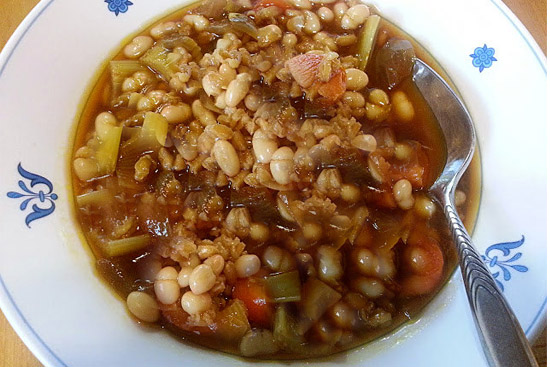
The semipearled farro variety — or semiperlato in Italy, where farro has been cultivated for centuries — in which some of the bran has been removed, and takes the least time to cook but has no bran at all.
whole farro requires overnight soaking.
Serves: 6
2 tablespoons olive oil, plus more for drizzling, if desired
1 small yellow onion, chopped
1 medium-size carrot, chopped
1 celery rib, chopped
2 garlic cloves, minced
1/2 teaspoon salt
Freshly ground pepper
1 bay leaf
1/4 teaspoon dried oregano
5 cups vegetable stock
1 1/2 cups or one 15-ounce can cannellini or other white beans, drained and rinsed
Serves: 6
Preparation time:15 minutes
Cooking time:30 minutes
3/4 cup spelt or semipearled farro *2 tablespoons olive oil, plus more for drizzling, if desired
1 small yellow onion, chopped
1 medium-size carrot, chopped
1 celery rib, chopped
2 garlic cloves, minced
1/2 teaspoon salt
Freshly ground pepper
1 bay leaf
1/4 teaspoon dried oregano
5 cups vegetable stock
1 1/2 cups or one 15-ounce can cannellini or other white beans, drained and rinsed
Heat the olive oil in a large pot over medium heat. Add the onion, carrot, celery, garlic, salt and pepper. Sautee over medium heat until the vegetables soften, about 5 minutes. Add the bay leaf and oregano. Add the stock and bring to a boil.
Add the spelt or farro and bring back to a boil, then reduce the heat to low. Cover and simmer the soup for 20 to 30 minutes or until the farro is almost tender (you don't want the grains completely cooked since the soup will cook for additional time and the vegetables are cooked). Add more water if the soup becomes too thick.
Add the beans and season with additional salt and pepper to taste. Simmer for 10 to 15 minutes to allow the flavors to blend.
Serve hot, drizzled with a little olive oil, if desired.
Add the spelt or farro and bring back to a boil, then reduce the heat to low. Cover and simmer the soup for 20 to 30 minutes or until the farro is almost tender (you don't want the grains completely cooked since the soup will cook for additional time and the vegetables are cooked). Add more water if the soup becomes too thick.
Add the beans and season with additional salt and pepper to taste. Simmer for 10 to 15 minutes to allow the flavors to blend.
Serve hot, drizzled with a little olive oil, if desired.
Main Vegetable lasagna 
Serves: 8
Preparation time: 20 minutes
Cooking time:50 minutes
15 lasagne noodles 1/4 cup olive oil
2 cloves garlic, minced
1 onion, chopped
1 red pepper, chopped
2 cups sliced fresh mushrooms
1/4 cup flour
2 1/2 cups milk
10 ounces package chopped spinach, well drained
1 cup Parmesan cheese
1 teaspoon basil, chopped
2 eggs, beaten
salt and pepper to taste
6 ounces sliced mozzarella cheese
Cook lasagna according to package directions.
Meanwhile, in a saucepan, heat oil over medium heat. Add garlic, onion, red pepper and mushrooms and cook for 10 minutes, stirring occasionally. Add flour; cook and stir for 1 minute. Gradually add milk, stirring until bubbly and thickened. Add spinach, Parmesan cheese and basil. Stir half of mixture into eggs, then pour back into saucepan. Cook over low heat until sauce simmers, stirring occasionally. Season to taste with salt and pepper.
In a 13-inch by 9-inch greased baking dish, layer of lasagne (about 5 overlapping noodles) and of sauce. Repeat layers twice.
Top with mozzarella cheese and bake at 375 degrees for 30 minutes. Let stand for 10 minutes.
Meanwhile, in a saucepan, heat oil over medium heat. Add garlic, onion, red pepper and mushrooms and cook for 10 minutes, stirring occasionally. Add flour; cook and stir for 1 minute. Gradually add milk, stirring until bubbly and thickened. Add spinach, Parmesan cheese and basil. Stir half of mixture into eggs, then pour back into saucepan. Cook over low heat until sauce simmers, stirring occasionally. Season to taste with salt and pepper.
In a 13-inch by 9-inch greased baking dish, layer of lasagne (about 5 overlapping noodles) and of sauce. Repeat layers twice.
Top with mozzarella cheese and bake at 375 degrees for 30 minutes. Let stand for 10 minutes.
Main Vegetarian minestrone 
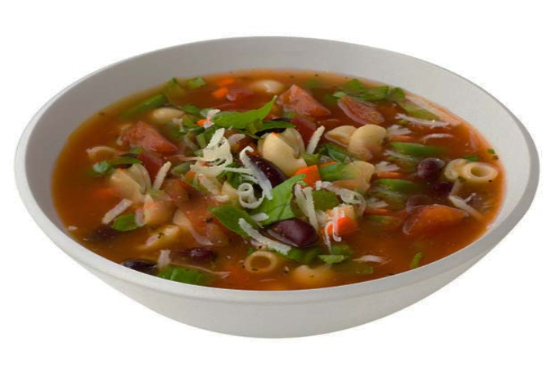
Serves: 4
Preparation time: 20 minutes
Cooking time:40 minutes
2 teaspoons olive oil 3/4 cup chopped onion
3 cups water
2 cups diced zucchini
1 cup diced carrot
1 cup drained canned cannellini beans
3/4 cup diced celery
1/2 teaspoon dried basil
1/4 teaspoon salt
1/4 teaspoon dried oregano
1/8 teaspoon coarsely ground pepper
1-14 ounce can diced tomatoes undrained
1 garlic clove, minced
1/4 cup uncooked macaroni
4 teaspoons grated Parmesan cheese
Heat oil in a large saucepan over medium-high heat. Add onions; sauté until lightly browned.
Add water and next 10 ingredients. Cover, reduce heat and cook 25 minutes.
Add pasta; cover and cook an additional 10 minutes. Ladle into bowls, and sprinkle with cheese.
Add water and next 10 ingredients. Cover, reduce heat and cook 25 minutes.
Add pasta; cover and cook an additional 10 minutes. Ladle into bowls, and sprinkle with cheese.
Dessert Almond sherry ice cream with honeyed figs 
Serves: 6
Preparation time: 30 minutes
Cooking time:40 minutes
For ice cream: 3 cups half and half
4-inch strip fresh lemon zest
4-inch strip fresh orange zest
1/2 cinnamon stick
8 large egg yolks
1/2 cup sugar
1/4 cup Amontillado Sherry*
For figs:
12 soft (moist) dried Calimyrna figs
1 cup Amontillado Sherry
1 cup fresh orange juice
6 tablespoons honey
candied orange zest
Make ice cream:
Bring half and half with lemon and orange zests and cinnamon stick just to a boil over moderate heat. Cover and let stand off heat 25 minutes, then reheat to a simmer. Discard zests and cinnamon stick.
Whisk together yolks, sugar and Sherry in a large bowl until smooth. Gradually whisk in hot milk mixture.
Transfer custard to cleaned saucepan and cook over moderately low heat, stirring constantly, until thickened enough to coat back of a wooden spoon. Pour custard through a fine sieve into a bowl and cover surface with wax paper to prevent a skin from forming.
Chill until thoroughly cold, about 3 hours. Freeze in an ice cream maker. Transfer to an airtight container and freeze until firm.
Make figs:
Bring figs, Sherry, juice and honey, cover to a boil in a small saucepan. Simmer, covered, just until figs are tender, about 40 minutes, then uncover and simmer until liquid is reduced to about 1 cup. Cool figs in syrup.
Serve ice cream with honeyed figs and syrup and a few candied orange zest sprinkled over.
*Note: Amontillado is a mellow almond flavor sherry.
Bring half and half with lemon and orange zests and cinnamon stick just to a boil over moderate heat. Cover and let stand off heat 25 minutes, then reheat to a simmer. Discard zests and cinnamon stick.
Whisk together yolks, sugar and Sherry in a large bowl until smooth. Gradually whisk in hot milk mixture.
Transfer custard to cleaned saucepan and cook over moderately low heat, stirring constantly, until thickened enough to coat back of a wooden spoon. Pour custard through a fine sieve into a bowl and cover surface with wax paper to prevent a skin from forming.
Chill until thoroughly cold, about 3 hours. Freeze in an ice cream maker. Transfer to an airtight container and freeze until firm.
Make figs:
Bring figs, Sherry, juice and honey, cover to a boil in a small saucepan. Simmer, covered, just until figs are tender, about 40 minutes, then uncover and simmer until liquid is reduced to about 1 cup. Cool figs in syrup.
Serve ice cream with honeyed figs and syrup and a few candied orange zest sprinkled over.
*Note: Amontillado is a mellow almond flavor sherry.
Dessert Apricot tart 
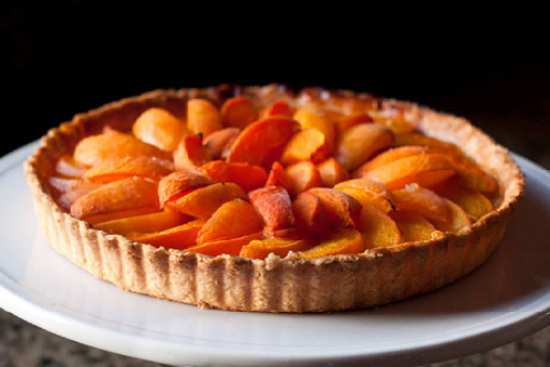
For best results, use tart pans that have removable bottoms
Serves: 8
1 recipe never fail pie crust
8 firm but ripe apricots(about 1 1/2 pounds), pitted and cut into sixths
1/4 cup plus 1 tablespoon sugar, plus more for sprinkling
1 1/2 tablespoons cornstarch
Pinch of salt
1 teaspoon freshly squeezed lemon juice
Zest of 1/2 lemon
1 tablespoon heavy cream
Serves: 8
Preparation time: 30 minutes
Cooking time:35 minutes
All-purpose flour, for dusting 1 recipe never fail pie crust
8 firm but ripe apricots(about 1 1/2 pounds), pitted and cut into sixths
1/4 cup plus 1 tablespoon sugar, plus more for sprinkling
1 1/2 tablespoons cornstarch
Pinch of salt
1 teaspoon freshly squeezed lemon juice
Zest of 1/2 lemon
1 tablespoon heavy cream
Preheat oven to 425 degrees.
Roll dough out into one 12-inch circle, and drape over tart pan that has removable bottoms.
In a medium bowl, toss apricots together with sugar, cornstarch, salt, lemon juice, zest and cream. Spoon apricot mixture in tart pans. Spread out evenly. sprinkle with sugar.
Place tart on a baking sheet and bake for 15 minutes; lower oven temperature to 375°.
Continue to bake until tart is evenly browned and apricots are bubbling, about 25 minutes more. Transfer tart from baking sheet to a cooling rack, and cool completely. Serve warm or at room temperature.
Roll dough out into one 12-inch circle, and drape over tart pan that has removable bottoms.
In a medium bowl, toss apricots together with sugar, cornstarch, salt, lemon juice, zest and cream. Spoon apricot mixture in tart pans. Spread out evenly. sprinkle with sugar.
Place tart on a baking sheet and bake for 15 minutes; lower oven temperature to 375°.
Continue to bake until tart is evenly browned and apricots are bubbling, about 25 minutes more. Transfer tart from baking sheet to a cooling rack, and cool completely. Serve warm or at room temperature.
Dessert Baked alaska snow balls 
Serves: 6
Preparation time: 20 minutes
Cooking time:12 minutes
1 recipe Fudge sauce1 recipe chocolate sauce
1 recipe Meringue
1 pint coffee or maple walnut ice cream
scoop 6 1/3-cup balls of ice cream onto a plate lined with film wrap and freeze.
For the wafer crumb crust:
1 1/4 cups finely ground chocolate wafers
1 teaspoon confectioners' sugar
5 teaspoons unsalted butter, melted
Preheat oven to 350 degrees.
Process the wafers and sugar to a powder. Transfer to a bowl. Stir in the melted butter.
Spoon 3 tablespoons of the crumb into the center of 6 3-inch fluted round tartlet pans. Press the crumbs firmly and evenly on the bottom and up the sides of the pans. The crusts should be about 1/4 inch thick.
Place the crusts on a baking sheet and bake for 10 minutes. Transfer to a rack and cool. (can be made a day ahead.)
To assemble:
Preheat oven to 500 degrees. Slip the tartlet shells out of their pans and place on a baking sheet lined with parchment paper. Place an ice cream ball in the center of each tartlet. Freeze.
To serve, spoon 2 to 3 tablespoons fudge sauce onto each of 6 warm dessert plates. Drizzle with chocolate sauce.
Prepare the meringue. Spoon meringue in a pastry bag fitted with a large #5 star tube, pipe and completely cover the ice cream with meringue.
Bake for one minute to brown meringue. Watch carefully.
For the wafer crumb crust:
1 1/4 cups finely ground chocolate wafers
1 teaspoon confectioners' sugar
5 teaspoons unsalted butter, melted
Preheat oven to 350 degrees.
Process the wafers and sugar to a powder. Transfer to a bowl. Stir in the melted butter.
Spoon 3 tablespoons of the crumb into the center of 6 3-inch fluted round tartlet pans. Press the crumbs firmly and evenly on the bottom and up the sides of the pans. The crusts should be about 1/4 inch thick.
Place the crusts on a baking sheet and bake for 10 minutes. Transfer to a rack and cool. (can be made a day ahead.)
To assemble:
Preheat oven to 500 degrees. Slip the tartlet shells out of their pans and place on a baking sheet lined with parchment paper. Place an ice cream ball in the center of each tartlet. Freeze.
To serve, spoon 2 to 3 tablespoons fudge sauce onto each of 6 warm dessert plates. Drizzle with chocolate sauce.
Prepare the meringue. Spoon meringue in a pastry bag fitted with a large #5 star tube, pipe and completely cover the ice cream with meringue.
Bake for one minute to brown meringue. Watch carefully.
Dessert Bavarois turinoise 
Serves: 10
Preparation time: 35 minutes
Cooking time:8 minutes
1 envelope unflavored gelatin 2 tablespoons cold water
1 cup sugar
4 egg yolks
1 cup scalded milk
1 teaspoon vanilla
1 cup chestnut puree
1 ounce melted semi-sweet chocolate
1 1/2 cups heavy cream
3 tablespoons dark rum or brandy
Dissolve gelatin in cold water. In an electric mixer, cream sugar and egg yolks. Slowly pour and whisk the boiling milk over egg mixture. Pour in saucepan. Stir with a wooden spoon over low heat until the mixture coats the back of the spoon, about 5 to 8 minutes. Do not allow to boil. Stir in the gelatin. Strain into a bowl. Cool mixture.
Mix in the vanilla, chestnut puree, and melted chocolate.Whip the heavy cream to a medium peak. Fold in the cool custard. Mix in the rum or brandy. Pour in a decorative mold. Refrigerate for 2 hours. Unmold and decorate with whipped cream flavored with rum and glazed chestnuts.
Mix in the vanilla, chestnut puree, and melted chocolate.Whip the heavy cream to a medium peak. Fold in the cool custard. Mix in the rum or brandy. Pour in a decorative mold. Refrigerate for 2 hours. Unmold and decorate with whipped cream flavored with rum and glazed chestnuts.
Dessert Bomba italian doughnuts 
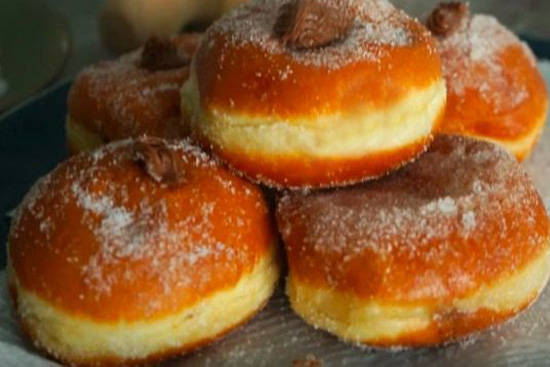
Soft and light Italian bomba, bomb Doughnuts rolled in sugar and filled with Nutella. These doughnuts are delicious.
Serves: 20
1/4 cup sugar
2 1/2 t instant yeast
1 vanilla bean
zest of one orange
pinch of salt
1 cup of milk, heated to 110 degrees
3 whole eggs
3 1/2 tablespoons butter, room temperature
peanut oil or canola oil for frying
Nutella
Serves: 20
Preparation time:2 hours
Cooking time:12 minutes
4 cups double zero “OO” flour (or all purpose)1/4 cup sugar
2 1/2 t instant yeast
1 vanilla bean
zest of one orange
pinch of salt
1 cup of milk, heated to 110 degrees
3 whole eggs
3 1/2 tablespoons butter, room temperature
peanut oil or canola oil for frying
Nutella
Place the flour, sugar, instant yeast and zest into a large mixing bowl. Slice the vanilla bean in half lengthwise and scrape to remove the seeds, add the seeds to the flour mixture.
Make a well in the flours and add the warm milk. With a wooden spoon mix the ingredients together. Alternatively, you can use your kitchen aide mixer with the dough hook attachment to prepare your dough.
Add the eggs all at once and mix until a soft ball forms.
Add the butter in small pieces a little at a time.
Transfer the dough to a floured surface and knead for 10-15 minutes. The dough should be a little soft but not sticky.
Place the dough in a well oiled mixing bowl, covered with plastic wrap and in a warm window until doubled in size, about 1 1/2 to 2 hours.
Punch the dough down lightly and roll out on a lightly floured surface until a 1/2 inch thick. Cut the dough with a 3 inch cookie cutter and place on a cookie sheet
Take the leftover dough and roll into a ball. Place the dough back into the oiled bowl to rise for another 1/2 hour or so. Roll the dough out and repeat the process.
When all the dough has been used let the rounds raise again covered and in a warm place until doubled in size.
Fill a large pot with enough oil until it is 3-4 inches deep. Heat the oil to 340 degrees. Fry the doughnuts until golden brown.
You may use a pastry bag with metal tip to fill the doughnuts with Nutella or just serve Nutella alongside the warm doughnuts and start dipping.
Make a well in the flours and add the warm milk. With a wooden spoon mix the ingredients together. Alternatively, you can use your kitchen aide mixer with the dough hook attachment to prepare your dough.
Add the eggs all at once and mix until a soft ball forms.
Add the butter in small pieces a little at a time.
Transfer the dough to a floured surface and knead for 10-15 minutes. The dough should be a little soft but not sticky.
Place the dough in a well oiled mixing bowl, covered with plastic wrap and in a warm window until doubled in size, about 1 1/2 to 2 hours.
Punch the dough down lightly and roll out on a lightly floured surface until a 1/2 inch thick. Cut the dough with a 3 inch cookie cutter and place on a cookie sheet
Take the leftover dough and roll into a ball. Place the dough back into the oiled bowl to rise for another 1/2 hour or so. Roll the dough out and repeat the process.
When all the dough has been used let the rounds raise again covered and in a warm place until doubled in size.
Fill a large pot with enough oil until it is 3-4 inches deep. Heat the oil to 340 degrees. Fry the doughnuts until golden brown.
You may use a pastry bag with metal tip to fill the doughnuts with Nutella or just serve Nutella alongside the warm doughnuts and start dipping.
Dessert Candied grapefruit peel 
Serves: 8
Preparation time: 25 minutes
Cooking time:15 minutes
1 large grapefruit 3/4 cup sugar
1/2 cup water and peel
Remove the yellow part of the peel of one grapefruit with a vegetable peeler. Cut into 1/16-inch -wide strips.
In a small saucepan, combine sugar and water and grapefruit strips. Bring mixture to a boil; reduce heat, cover and simmer for 15 minutes.
Drain the grapefruit peel and spread it on wax paper. Cool 10 minutes, sprinkle with 3 tablespoons granulated sugar, toss to coat completely. Let peel dry overnight.
In a small saucepan, combine sugar and water and grapefruit strips. Bring mixture to a boil; reduce heat, cover and simmer for 15 minutes.
Drain the grapefruit peel and spread it on wax paper. Cool 10 minutes, sprinkle with 3 tablespoons granulated sugar, toss to coat completely. Let peel dry overnight.
Dessert Caramelized figs with fudge sauce 
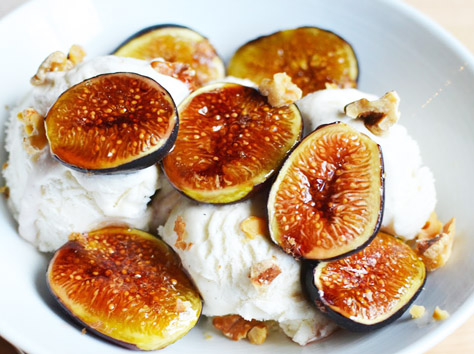
Serves: 6
Preparation time:10 minutes
Cooking time:12 minutes
1 ½ Tbsp unsalted butter,½ cup sugar
¼ tsp coarse salt
12 fesh figs, halved lengthwise)
Fudge sauce (recipe below)
Vanilla ice cream
In a medium shallow bowl, stir together sugar and salt. Press the cut side of each fig into the sugar mixture to coat.
Heat a large skillet over medium heat and add butter to melt. Add sugar-covered figs, cut side down, and cook until sugar and juices caramelize, about 3-4 minutes. As figs caramelize, turn them over.
Remove from heat and add lemon juice, gently swirling to combine.
Transfer to a serving dish. Serve with the fudge sauce and vanilla ice cream.
For the fudge sauce:
1 cup brown sugar
1/4 cup butter
1/2 teaspoon vanilla extract
1/4 cup light cream (half and half)
3/4 cup heavy cream
Preparation:
In a medium pot, combine the brown sugar, butter, vanilla, and cream. Bring to boil on high heat for 2 minutes.
Add the heavy cream. Bring to boil, simmer for 8 minutes. Keeps well refrigerated for a week.
Heat a large skillet over medium heat and add butter to melt. Add sugar-covered figs, cut side down, and cook until sugar and juices caramelize, about 3-4 minutes. As figs caramelize, turn them over.
Remove from heat and add lemon juice, gently swirling to combine.
Transfer to a serving dish. Serve with the fudge sauce and vanilla ice cream.
For the fudge sauce:
1 cup brown sugar
1/4 cup butter
1/2 teaspoon vanilla extract
1/4 cup light cream (half and half)
3/4 cup heavy cream
Preparation:
In a medium pot, combine the brown sugar, butter, vanilla, and cream. Bring to boil on high heat for 2 minutes.
Add the heavy cream. Bring to boil, simmer for 8 minutes. Keeps well refrigerated for a week.
Dessert Chocolate hazelnut cheesecake 
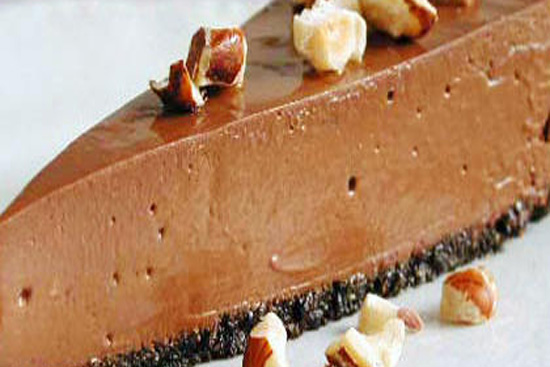
Serves: 8
Preparation time:15 minutes
4 oz (200g) honey nut cornflakes14 oz (400g) jars chocolate hazelnut spread
7 oz (200g)cream cheese,softened
1 tbsp roasted and chopped Hazelnut
Put the cornflakes and half a of the chocolate hazelnut spread in a bowl and beat to combine. Press the mix into the base of a 4-inch (10 cm) springform tin.
In a separate bowl, beat the cream cheese until smooth, then fold in the remaining chocolate hazelnut spread. Smooth onto the cornflake base, wrap tightly in cling film and freeze overnight.
Remove from the freezer 30 mins before serving, or until you can cut it easily with a sharp knife. Serve in slices with hazelnuts sprinkled over. Will keep in the freezer for up to 1 month.
Dessert Chocolate raspberry ice cream 
Serves: 6
Preparation time: 1 hour
Cooking time:10 minutes
4 ounces unsweetened chocolate 1 cup milk
2 eggs
1 cup sugar
1 teaspoon vanilla
1 cup cream
1/2 pint raspberries
1/4 cup sugar
In a heavy saucepan, combine chocolate and milk. Heat over very low heat and stir until chocolate is fully dissolved into the milk. Remove from heat and cool.
Beat eggs and sugar until fluffy. Add cream and vanilla and beat more. Add chocolate mixture, beat thoroughly, and chill until cold.
Mash the raspberries with the sugar, cover, and refrigerate. When chocolate mixture is cold, freeze it in your ice cream maker.
When the ice cream is thick and smooth, add the raspberry mixture. Continue churning until ice cream is set and creamy. Finish freezing and enjoy
Beat eggs and sugar until fluffy. Add cream and vanilla and beat more. Add chocolate mixture, beat thoroughly, and chill until cold.
Mash the raspberries with the sugar, cover, and refrigerate. When chocolate mixture is cold, freeze it in your ice cream maker.
When the ice cream is thick and smooth, add the raspberry mixture. Continue churning until ice cream is set and creamy. Finish freezing and enjoy
Dessert Chocolate-mocha soufflé 
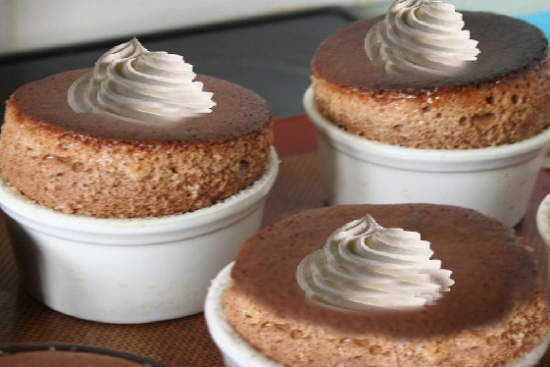
Serves: 4
Preparation time: 30 minutes
Cooking time:40 minutes
1 teaspoon butter, softened 1 teaspoon sugar
1 teaspoon instant espresso
1 teaspoon hot water
6 ounces semi sweet chocolate
1/4 cup heavy cream
3 egg yolks
1 tablespoon flour
6 egg whites
1 pinch cream of tartar
2 teaspoons sugar
Preheat oven to 325 degrees.
Butter a 5-cup soufflé mold. Coat inside with teaspoon sugar. Combine espresso with hot water, stir until dissolved.
Melt chocolate on top of double boiler. In a mixing bowl, combine melted chocolate with cream and coffee.
Beat egg yolks and flour. Stir into the chocolate mixture.
Beat egg whites with cream of tartar to a soft peak. Sprinkle in sugar, and beat until stiff peak. Stir a 1/4 of the whites into chocolate mixture, then fold chocolate mixture into remaining egg whites, a little at a time. Pour this into the prepared mold.
Bake for 35 45 minutes. Serve hot with lightly whipped cream.
Butter a 5-cup soufflé mold. Coat inside with teaspoon sugar. Combine espresso with hot water, stir until dissolved.
Melt chocolate on top of double boiler. In a mixing bowl, combine melted chocolate with cream and coffee.
Beat egg yolks and flour. Stir into the chocolate mixture.
Beat egg whites with cream of tartar to a soft peak. Sprinkle in sugar, and beat until stiff peak. Stir a 1/4 of the whites into chocolate mixture, then fold chocolate mixture into remaining egg whites, a little at a time. Pour this into the prepared mold.
Bake for 35 45 minutes. Serve hot with lightly whipped cream.
Dessert Chocolate-orange sorbet 
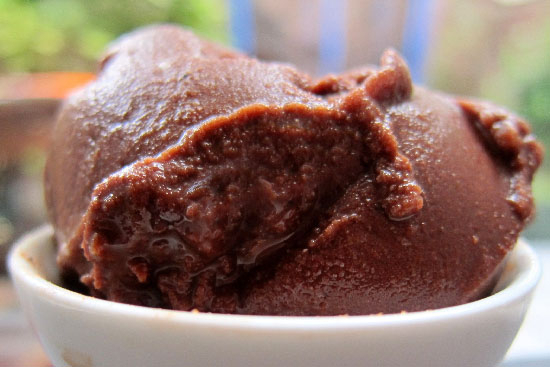
Serves: 6
Preparation time: 2 hours
Cooking time:5 minutes
1/4 cup sugar 3/4 cup unsweetened cocoa
1 1/2 cups water
2 ounces bittersweet chocolate, chopped
2/3 cup fresh orange juice
2 tablespoons light corn syrup
2 teaspoons grated orange zest
Combine sugar and cocoa. Whisk in water. Bring to boil in a saucepan, whisking constantly for 3 to 4 minutes.
Reduce heat, and add remaining ingredients. Stir to melt chocolate. Refrigerate 1 hour or more.
Make sorbet in an ice cream maker.
Reduce heat, and add remaining ingredients. Stir to melt chocolate. Refrigerate 1 hour or more.
Make sorbet in an ice cream maker.
Dessert Cocoa sponge cake 
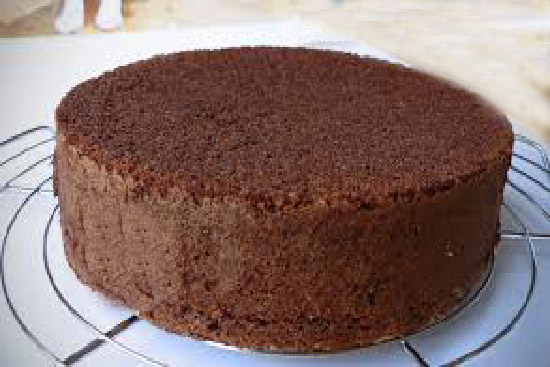
Serves: 8
Preparation time: 20 minutes
Cooking time:18 minutes
1 teaspoon sweet butter 1 teaspoon all purpose flour
4 egg whites
1/4 teaspoon cream of tartar
1/2 cup sugar
4 egg yolks
1/2 cup all purpose flour sifted together with 1/4 cup cocoa powder
Preheat oven to 350 degrees.
Brush an 8-inch springform cake mold with the butter and dust with flour.
With an electric mixer, whip the egg whites with the cream of tartar, slowly adding the sugar, and continue to whip until stiff.
With a spatula, fold in the egg yolks, then gradually incorporate the sifted cocoa/flour mixture.
Pour the batter into the cake mold and bake for 15 to 18 minutes. Remove from heat when done and unmold on a pastry rack to cool.
Brush an 8-inch springform cake mold with the butter and dust with flour.
With an electric mixer, whip the egg whites with the cream of tartar, slowly adding the sugar, and continue to whip until stiff.
With a spatula, fold in the egg yolks, then gradually incorporate the sifted cocoa/flour mixture.
Pour the batter into the cake mold and bake for 15 to 18 minutes. Remove from heat when done and unmold on a pastry rack to cool.
Dessert Coconut-almond bars 
Serves: 24
Preparation time: 20 minutes
Cooking time:20 minutes
4 egg whites 1 1/2 cups sugar
1 teaspoon water
1 teaspoon almond extract
2 teaspoons vanilla
1 cup all-purpose flour
3 cups shredded coconut
48 whole almonds
1/2 cup semi-sweet chocolate chips
3 teaspoons unsalted butter
Preheat oven to 350 degrees.
Grease 15 x 10 x 1-inch jelly roll pan. In large bowl, beat egg whites until soft peaks form.
Gradually add sugar; beat until stiff peaks form, about 7 minutes. Add water, almond extract and vanilla; blend well. Lightly spoon flour into measuring cup; level off.
Stir in flour and coconut; mix well. Spread in greased pan. Arrange almonds over top of bars in 8 rows of 6 each.
Bake at 350 degrees for 15 to 20 minutes or until lightly browned and top springs back when lightly touched in center.
Cover pan with foil until cool.
In small saucepan, melt chocolate chips and butter over low heat, stirring occasionally; drizzle over cooled bars.
Grease 15 x 10 x 1-inch jelly roll pan. In large bowl, beat egg whites until soft peaks form.
Gradually add sugar; beat until stiff peaks form, about 7 minutes. Add water, almond extract and vanilla; blend well. Lightly spoon flour into measuring cup; level off.
Stir in flour and coconut; mix well. Spread in greased pan. Arrange almonds over top of bars in 8 rows of 6 each.
Bake at 350 degrees for 15 to 20 minutes or until lightly browned and top springs back when lightly touched in center.
Cover pan with foil until cool.
In small saucepan, melt chocolate chips and butter over low heat, stirring occasionally; drizzle over cooled bars.
Dessert Coffee custards 
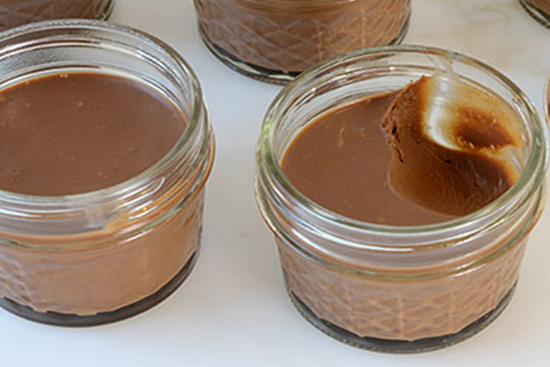
Serves: 6
Preparation time: 20 minutes
Cooking time:30 minutes
FOR CARAMEL: 1/4 cup sugar
2 teaspoons water
FOR CUSTARDS:
2 cups warm milk
1/4 cup sugar
1 ounce semi-sweet chocolate
2 teaspoons instant coffee
1 teaspoon vanilla
5 egg yolks
For Caramel:
In a small saucepan, combine sugar and water. Boil until it turns into a golden caramel. Dip saucepan in water to stop the cooking of the sugar.
For custards:
In a large saucepan, combine milk, sugar, chocolate, coffee, and vanilla. Mix in the warm caramel. Bring to a boil. Beat the egg yolks in a bowl, and gradually whisk in the milk mixture. Strain, and pour into individual ramequin dishes. Bake in waterbath at 325 degrees for 30 minutes or until custards are firm.
In a small saucepan, combine sugar and water. Boil until it turns into a golden caramel. Dip saucepan in water to stop the cooking of the sugar.
For custards:
In a large saucepan, combine milk, sugar, chocolate, coffee, and vanilla. Mix in the warm caramel. Bring to a boil. Beat the egg yolks in a bowl, and gradually whisk in the milk mixture. Strain, and pour into individual ramequin dishes. Bake in waterbath at 325 degrees for 30 minutes or until custards are firm.
Dessert Fruit sorbet 

Serves: 8
Preparation time: 1 hour
Cooking time:10 minutes
2 cups water 10 ounces sugar
1 ounce lemon juice
2 cups fruit pulp and juice (apricot, kumquat, lemon, orange, peaches, pears, pineapple, raspberry, strawberries, tangerine)
In a medium saucepan, combine the water and sugar. Bring to a boil. Add lemon juice and fruit pulp.
Refrigerate until cold. Churn in an ice-cream machine.
Refrigerate until cold. Churn in an ice-cream machine.
Dessert Lemon cream tart 
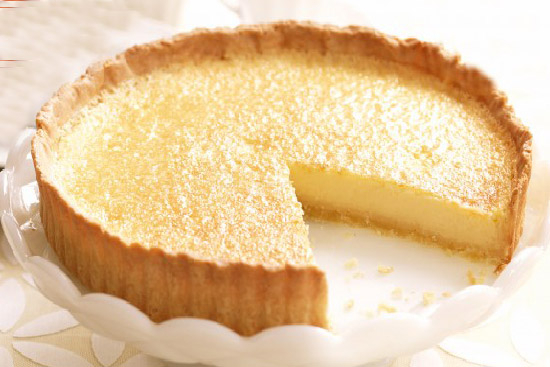
Serves: 10
Preparation time: 20 minutes
Cooking time:50 minutes
8 ounces soft cream cheese 1/3 cup sugar
1 teaspoon lemon juice
1 egg
1/4 cup sugar
2 teaspoons flour
3/4 cup light corn syrup
1/3 cup lemon juice
2 teaspoons melted margarine
1 teaspoon grated lemon peel
2 eggs, beaten
1 10-inch pie crust
Preheat oven at 375 degrees.
Line the pie crust in a 10-inch tart pan with removable bottom. Press in bottom and sides of pan.
Combine cream cheese and sugar. Add lemon juice and egg. Beat until smooth. Spread over crust.
Combine sugar, flour, corn syrup, lemon juice, margarine, and lemon peel. Mix well. Add beaten eggs.
Carefully pour over cream cheese mixture. Bake 40 50 minutes or until crust is golden brown. Cool completely.
Remove from pan and refrigerate.
Line the pie crust in a 10-inch tart pan with removable bottom. Press in bottom and sides of pan.
Combine cream cheese and sugar. Add lemon juice and egg. Beat until smooth. Spread over crust.
Combine sugar, flour, corn syrup, lemon juice, margarine, and lemon peel. Mix well. Add beaten eggs.
Carefully pour over cream cheese mixture. Bake 40 50 minutes or until crust is golden brown. Cool completely.
Remove from pan and refrigerate.
Dessert Lemon custard 
This is a light version.
Serves: 8
4 eggs, beaten
2 tablespoons cornstarch
grated rind of 2 lemons
½ cup lemon juice
3 cups 2% milk
1 teaspoon lemon extract
whipped cream (optional)
Serves: 8
Preparation time: 15 minutes
Cooking time:7 minutes
1/2 cup sugar 4 eggs, beaten
2 tablespoons cornstarch
grated rind of 2 lemons
½ cup lemon juice
3 cups 2% milk
1 teaspoon lemon extract
whipped cream (optional)
In medium bowl, whisk sugar and eggs. Mix in cornstarch and lemon juice. Set aside.
In large saucepan, heat milk over medium heat until tiny bubbles appear around edges of pan.
Stir into egg mixture. Strain through a fine strainer and add lemon rind. Return mixture to clean saucepan.
Cook over medium heat while whisking 5 to 7 minutes or until thickened.
Divide lemon custard evenly among eight 1/2-cup ramekins or custard cups.
Allow to cool slightly. Cover each custard with plastic wrap. Chill until ready to serve.
As an option, garnish with whipped cream before serving.
In large saucepan, heat milk over medium heat until tiny bubbles appear around edges of pan.
Stir into egg mixture. Strain through a fine strainer and add lemon rind. Return mixture to clean saucepan.
Cook over medium heat while whisking 5 to 7 minutes or until thickened.
Divide lemon custard evenly among eight 1/2-cup ramekins or custard cups.
Allow to cool slightly. Cover each custard with plastic wrap. Chill until ready to serve.
As an option, garnish with whipped cream before serving.
Dessert Lemon krumkake 
Serves: 6
Preparation time: 10 minutes
Cooking time:20 minutes
3 eggs 1/2 cup sugar
1/2 cup melted butter
1/2 cup flour
1 teaspoon lemon extract
Beat eggs and sugar until light and creamy. Stir in the remaining ingredients until smooth.
Cook on pizzelli machine to form wafers, or while wafer is hot, shape into cup over a glass or similar container.
Cook on pizzelli machine to form wafers, or while wafer is hot, shape into cup over a glass or similar container.
Dessert Lemon meringue pie tart 

A towering lemon meringue pie to wow guests at the table.
Serves: 6
3 oz (90 g) unsalted butter
2 tbsp (20 g) ground almonds (almond meal)
1/2 cup (50 g) icing (confectioners’) sugar
2 large eggs
5 oz (150 g) plain (all-purpose) flour
1/2 tsp salt
For the lemon custard
1 leaf (sheet) gelatine
3 unwaxed lemons
3 eggs
70 g caster (superfine) sugar
4 oz (120 g) unsalted butter
For the Italian meringue
230 g caster (superfine) sugar
2 tbsp water
1 lemon, juice only
4 egg whites
Serves: 6
Preparation time:20 minutes
Cooking time:30 minutes
For the pastry3 oz (90 g) unsalted butter
2 tbsp (20 g) ground almonds (almond meal)
1/2 cup (50 g) icing (confectioners’) sugar
2 large eggs
5 oz (150 g) plain (all-purpose) flour
1/2 tsp salt
For the lemon custard
1 leaf (sheet) gelatine
3 unwaxed lemons
3 eggs
70 g caster (superfine) sugar
4 oz (120 g) unsalted butter
For the Italian meringue
230 g caster (superfine) sugar
2 tbsp water
1 lemon, juice only
4 egg whites
First make the pastry. In a bowl, soften the butter with a spatula. In a mixer with a paddle (flat beater) attachment, beat the softened butter, ground almonds (almond meal) and icing (confectioners’) sugar until smooth.
Then add the eggs, one at a time, while beating. Incorporate the flour and salt. Mix the pastry dough until crumbly.
Form the dough into a ball, wrap in clingfilm (plastic wrap) and rest overnight in the refrigerator.
Make the lemon custard. Soften the gelatine in a bowl of cold water for 5 minutes. Zest two of the lemons and squeeze all three. In a bowl, beat the eggs with a fork.
Combine the lemon juice, sugar and butter in a pan and bring to the boil. Gradually add the eggs, incorporating with a whisk. Cook over a low heat until the mixture comes to a gentle boil.
Pour the mixture into a bowl. Squeeze the gelatine and incorporate. Add the lemon zest. Use an immersion blender to mix well. Put into an airtight container and rest overnight in the refrigerator.
Preheat the oven to 175°C/350°F/gas mark 4.
Roll out the pastry dough into a 6-mm/1/4-inch-thick disc. Grease a tart pan with butter and line with the pastry. Bake in the preheated oven for 15 minutes.
Make the Italian meringue. Dissolve the sugar into 2 tablespoons of water and the lemon juice in a pan over a low heat.
Bring to the boil and cook until the mixture reads 120°C/250°F on a cooking thermometer. If you don’t have a cooking thermometer, put a little of the syrup in a spoon and let one drop fall into a glass of cold water. If it forms a small, soft ball, the syrup is ready.
In a grease-free bowl, whisk the egg whites to stiff peaks. Pour the syrup in a thin stream into the meringue while whisking until the mixture cools.
Fill the pastry case (shell) with the lemon custard. Use a plastic spatula to cover the tart with meringue, creating a dome in the centre. Caramelise with a chef's blowtorch.
Chill in the refrigerator for 1 hour before serving.
Then add the eggs, one at a time, while beating. Incorporate the flour and salt. Mix the pastry dough until crumbly.
Form the dough into a ball, wrap in clingfilm (plastic wrap) and rest overnight in the refrigerator.
Make the lemon custard. Soften the gelatine in a bowl of cold water for 5 minutes. Zest two of the lemons and squeeze all three. In a bowl, beat the eggs with a fork.
Combine the lemon juice, sugar and butter in a pan and bring to the boil. Gradually add the eggs, incorporating with a whisk. Cook over a low heat until the mixture comes to a gentle boil.
Pour the mixture into a bowl. Squeeze the gelatine and incorporate. Add the lemon zest. Use an immersion blender to mix well. Put into an airtight container and rest overnight in the refrigerator.
Preheat the oven to 175°C/350°F/gas mark 4.
Roll out the pastry dough into a 6-mm/1/4-inch-thick disc. Grease a tart pan with butter and line with the pastry. Bake in the preheated oven for 15 minutes.
Make the Italian meringue. Dissolve the sugar into 2 tablespoons of water and the lemon juice in a pan over a low heat.
Bring to the boil and cook until the mixture reads 120°C/250°F on a cooking thermometer. If you don’t have a cooking thermometer, put a little of the syrup in a spoon and let one drop fall into a glass of cold water. If it forms a small, soft ball, the syrup is ready.
In a grease-free bowl, whisk the egg whites to stiff peaks. Pour the syrup in a thin stream into the meringue while whisking until the mixture cools.
Fill the pastry case (shell) with the lemon custard. Use a plastic spatula to cover the tart with meringue, creating a dome in the centre. Caramelise with a chef's blowtorch.
Chill in the refrigerator for 1 hour before serving.
Dessert Lemon mousse 
Serves: 8
Preparation time: 20 minutes
1 envelop unflavored gelatin 1 tablespoon cold water
1 teaspoon grated lemon rind
1 cup lemon or lime juice, freshly squeezed, and strained
1/3 cup sugar
1 cup heavy cream or 1 1/2 cups Cool Whip
1 tablespoon sugar
Soften gelatin in water. Set aside for 5 minutes. Heat over low heat to dissolve. In a mixing bowl, combine the lime rind, juice and sugar. Stir until sugar is dissolved. Add gelatin. Cool mixture but do not set. Beat the cream with the sugar until stiff. Fold into the lime mixture. Spoon into crystal glasses or molds.
Dessert Lemon pudding cake 
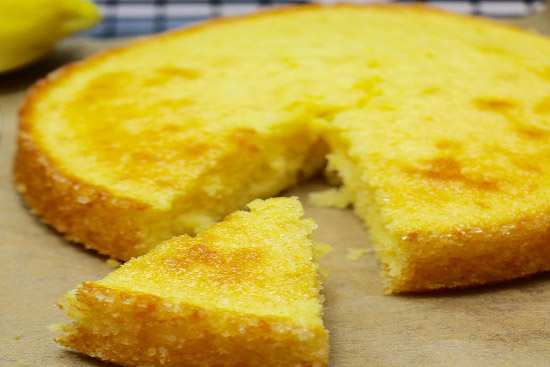
Serves: 6
Preparation time: 30 minutes
Cooking time:50 minutes
2 large lemons 1/4 cup all-purpose flour
1/4 teaspoon salt
3/4 cup plus 2 tablespoons sugar
3 large eggs, separated
1 1/3 cups whole milk
Preheat oven to 350 degrees F.
Finely grate 1 tablespoon zest from lemons, then squeeze 1/4 cup plus 2 tablespoons juice.
Whisk together flour, salt, and 1/2 cup plus 2 tablespoons sugar in a large bowl.
Whisk together yolks, milk, zest, and juice in a small bowl and add to flour mixture, whisking until just combined. Beat whites in another large bowl with an electric mixer until they hold soft peaks. Beat in remaining 1/4 cup sugar, a little at a time, and continue to beat until whites hold stiff, glossy peaks.
Whisk about one fourth of whites into batter to lighten, then fold in remaining whites gently but thoroughly (batter will be thin).
Pour into a buttered 1 1/2-quart ceramic gratin or other shallow baking dish and bake in a hot water bath until puffed and golden, 45 to 50 minutes.
Transfer to a rack. Serve warm or at room temperature.
Finely grate 1 tablespoon zest from lemons, then squeeze 1/4 cup plus 2 tablespoons juice.
Whisk together flour, salt, and 1/2 cup plus 2 tablespoons sugar in a large bowl.
Whisk together yolks, milk, zest, and juice in a small bowl and add to flour mixture, whisking until just combined. Beat whites in another large bowl with an electric mixer until they hold soft peaks. Beat in remaining 1/4 cup sugar, a little at a time, and continue to beat until whites hold stiff, glossy peaks.
Whisk about one fourth of whites into batter to lighten, then fold in remaining whites gently but thoroughly (batter will be thin).
Pour into a buttered 1 1/2-quart ceramic gratin or other shallow baking dish and bake in a hot water bath until puffed and golden, 45 to 50 minutes.
Transfer to a rack. Serve warm or at room temperature.
Dessert Lemon sorbet in lemon shells 
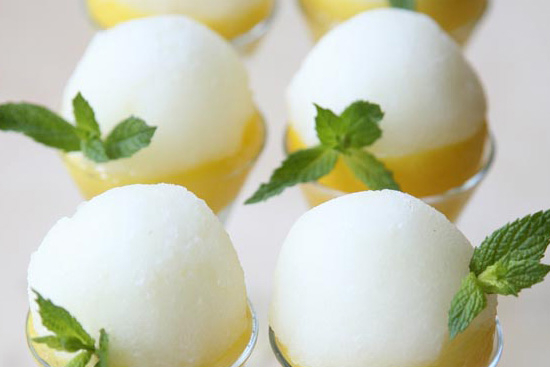
Serves: 8
Preparation time: 1 hour
Cooking time:5 minutes
LEMON CUPS: 8 large uniform lemons
LEMON SORBET:
1/3 cup lemon zest
1 cup strained fresh lemon juice - from lemons used for cups
1 1/2 cups sugar
1 1/2 cups water
In a medium saucepan over medium heat, combine sugar and water until sugar dissolves. Add lemon zest. Stir until mixture comes to a boil; boil 2 minute. Remove from heat, cool, and strain.
Ice Cream Maker - Transfer mixture to ice cream maker, process according to manufacturer's instructions.
Freezer Method - Pour into container, cover, and place mixture in the freezer. When it is semi-solid, mash it up with a fork and refreeze again. When frozen, place in a food processor or blender and process until smooth. Cover and refreeze until serving time. NOTE:
Can be prepared 2 to 3 days in advance. Cover and keep frozen.
Cut off the top 1/3 of the lemon (not the stem end) and reserve for the 'cap'.
Hollow out each lemon by using a grapefruit knife just inside the rind and circling the flesh (being careful not to puncture the lemon). Remove juice and flesh and put it in your juicer.
Make a slight shallow cut on the bottom of each lemon shells (being careful not to cut through to the inside of the lemon). This will make them sit straight and not fall over when placed on a plate.
Freeze the shells at least one hour or overnight. Then fill with sorbet and freeze again. this sorbet can be made ahead and will keep several days in the freezer. The frozen shell will prevent the sorbet from melting too quickly when you serve it.
LEMON SORBET:
In a medium saucepan over medium heat, combine sugar and water until sugar dissolves. Add lemon zest. Stir until mixture comes to a boil; boil 2 minute. Remove from heat, cool, and strain.
Ice Cream Maker - Transfer mixture to ice cream maker, process according to manufacturer's instructions.
Freezer Method - Pour into container, cover, and place mixture in the freezer. When it is semi-solid, mash it up with a fork and refreeze again. When frozen, place in a food processor or blender and process until smooth. Cover and refreeze until serving time. NOTE:
Can be prepared 2 to 3 days in advance. Cover and keep frozen.
Hollow out each lemon by using a grapefruit knife just inside the rind and circling the flesh (being careful not to puncture the lemon). Remove juice and flesh and put it in your juicer.
Make a slight shallow cut on the bottom of each lemon shells (being careful not to cut through to the inside of the lemon). This will make them sit straight and not fall over when placed on a plate.
Freeze the shells at least one hour or overnight. Then fill with sorbet and freeze again. this sorbet can be made ahead and will keep several days in the freezer. The frozen shell will prevent the sorbet from melting too quickly when you serve it.
LEMON SORBET:
In a medium saucepan over medium heat, combine sugar and water until sugar dissolves. Add lemon zest. Stir until mixture comes to a boil; boil 2 minute. Remove from heat, cool, and strain.
Ice Cream Maker - Transfer mixture to ice cream maker, process according to manufacturer's instructions.
Freezer Method - Pour into container, cover, and place mixture in the freezer. When it is semi-solid, mash it up with a fork and refreeze again. When frozen, place in a food processor or blender and process until smooth. Cover and refreeze until serving time. NOTE:
Can be prepared 2 to 3 days in advance. Cover and keep frozen.
Dessert Lemon tart #2 
Same recipe can be used with lime juice, orange juice, or a combination of lemon and rum. For lemon tartlets, unfold paper cups flat. Line with thin pie crust. Bake in muffin tins.
Serves: 8
never fail pie crust
1 tablespoon unflavored gelatin
1/4 cup water
1 cup sugar
1 teaspoon grated lemon rind
3/4 cup lemon juice
3 large egg yolks
3 egg whites
1/4 teaspoon cream of tartar
Serves: 8
Preparation time: 30 minutes
Cooking time:20 minutes
1 recipenever fail pie crust
1 tablespoon unflavored gelatin
1/4 cup water
1 cup sugar
1 teaspoon grated lemon rind
3/4 cup lemon juice
3 large egg yolks
3 egg whites
1/4 teaspoon cream of tartar
Pie crust:
Preheat oven to 375 degrees. Roll the dough into a round 1/8 inch thick on a floured surface, drape it over a rolling pin, and fit it into a 9-inch pie pan. Press the dough firmly into the pan and cut off any excess with the floured rolling pin. Freeze any leftover dough for future use. Cover pie shell with foil and dry beans or rice, and bake for 10 minutes. Remove inside of pie shell and foil, and continue baking at 350 degrees until golden brown.
Filling:
In a small bowl, dissolve gelatin in cold water In a medium saucepan, boil sugar to 240 degrees. Whisk yolks in an electric mixer. Pour hot sugar over and beat until light, creamy and cool. Add lemon juice, gelatin and lemon rind. Cool until mixture is about to set. Beat whites with cream of tartar. Fold in egg-yolk-gelatin mixture. Pour in shell. Chill until set. Sprinkle with grated lemon rind
Preheat oven to 375 degrees. Roll the dough into a round 1/8 inch thick on a floured surface, drape it over a rolling pin, and fit it into a 9-inch pie pan. Press the dough firmly into the pan and cut off any excess with the floured rolling pin. Freeze any leftover dough for future use. Cover pie shell with foil and dry beans or rice, and bake for 10 minutes. Remove inside of pie shell and foil, and continue baking at 350 degrees until golden brown.
Filling:
In a small bowl, dissolve gelatin in cold water In a medium saucepan, boil sugar to 240 degrees. Whisk yolks in an electric mixer. Pour hot sugar over and beat until light, creamy and cool. Add lemon juice, gelatin and lemon rind. Cool until mixture is about to set. Beat whites with cream of tartar. Fold in egg-yolk-gelatin mixture. Pour in shell. Chill until set. Sprinkle with grated lemon rind
Dessert Lime curd and almond tart 
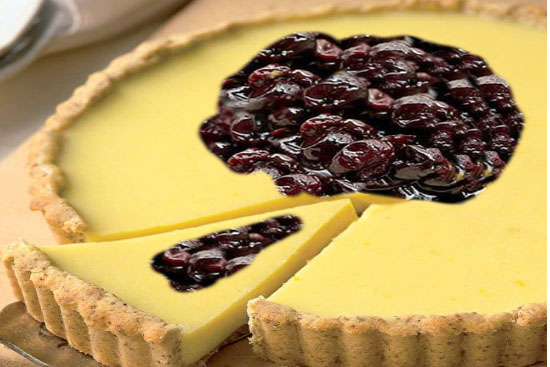
Serves: 8
Preparation time: 40 minutes
Cooking time:25 minutes
For crust: 2/3 cup sliced almonds, toasted
1/4 cup sugar
1/4 teaspoon salt
1 cup vanilla wafer crumbs
1/4 cup unsalted butter, soft
For filling:
1 cup sugar
1/2 cup unsalted butter, cut into pieces
1 tablespoon cornstarch
4 large eggs
1/2 cup lime juice
1 tablespoon grated lime zest
For compote:
3 cups bing cherries, diced
1 cup diced fresh pineapple
1/2 cup diced mango
2 diced apricots
2/3 cup raspberries
1 teaspoon sugar
Preheat oven at 350 degrees.
Make crust:
Butter a 9-inch tart pan with a removable fluted rim. Mix to a fine powder in a food processor, almonds, sugar, and salt. Combine with wafer crumbs and butter. Mix well. Line the bottom and sides of pan with the crust mixture.
Bake 10 minutes to a deep golden color.
Make filling:
In a heavy saucepan, cook sugar, butter, cornstarch, eggs, and lime juice over moderate heat, whisking until thickened and bubbly. Stir in zest and cool.
Filling may be made 2 days ahead. Spoon filling evenly into crust. Cover surface with buttered round of wax paper. Chill for at least 1 hour.
Make compote:
In a bowl, toss compote ingredients and let stand for 15 min. Remove sides of pan, and transfer to a plate.
Serve with the compote.
Make crust:
Butter a 9-inch tart pan with a removable fluted rim. Mix to a fine powder in a food processor, almonds, sugar, and salt. Combine with wafer crumbs and butter. Mix well. Line the bottom and sides of pan with the crust mixture.
Bake 10 minutes to a deep golden color.
Make filling:
In a heavy saucepan, cook sugar, butter, cornstarch, eggs, and lime juice over moderate heat, whisking until thickened and bubbly. Stir in zest and cool.
Filling may be made 2 days ahead. Spoon filling evenly into crust. Cover surface with buttered round of wax paper. Chill for at least 1 hour.
Make compote:
In a bowl, toss compote ingredients and let stand for 15 min. Remove sides of pan, and transfer to a plate.
Serve with the compote.
Dessert Marbled strawberry bombe 
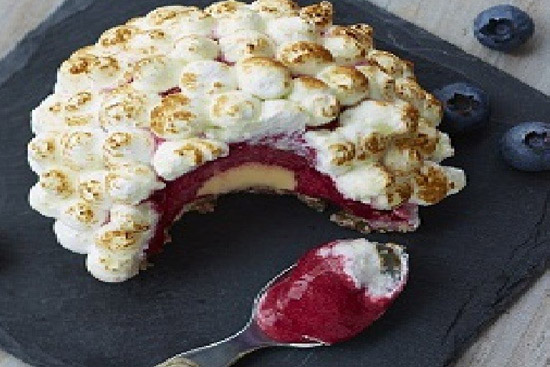
Serves: 8
Preparation time: 25 minutes
Cooking time:3 minutes
1 recipe cocoa sponge cake (see recipe) 1/4 cup Grand Marnier liqueur
1 pint fresh sliced strawberries
1 quart strawberry ice cream
6 egg whites
1 cup confectioners' sugar
Slice the prepared cocoa sponge cake in two horizontally. Sprinkle cakes with Grand Marnier.
Place one cake on a heatproof plate or platter, arrange strawberries over cake, top with remaining cake.
Soften ice cream slightly, spoon onto cake, shape into a dome, cover, freeze until firm.
Beat egg whites in a medium bowl with an electric mixer. until soft peaks form. Gradually add sugar while beating.
Spoon meringue into a large piping bag fitted with a tube. Starting with the base of the cake, pipe mixture evenly around cake and ice cream until completely covered.
Bake in a 500 degree oven for about 3 minutes or until meringue is lightly brown.
Serve immediately.
Place one cake on a heatproof plate or platter, arrange strawberries over cake, top with remaining cake.
Soften ice cream slightly, spoon onto cake, shape into a dome, cover, freeze until firm.
Beat egg whites in a medium bowl with an electric mixer. until soft peaks form. Gradually add sugar while beating.
Spoon meringue into a large piping bag fitted with a tube. Starting with the base of the cake, pipe mixture evenly around cake and ice cream until completely covered.
Bake in a 500 degree oven for about 3 minutes or until meringue is lightly brown.
Serve immediately.
Dessert Meringue baked apples 
Serves: 4
Preparation time: 20 minutes
Cooking time:40 minutes
4 large baking apples 2 ounces butter
3 ounces sugar
3 egg whites
4 ounces powdered sugar
Preheat oven to 350 degrees.
Peel, and core the apples leaving the stem end closed.
Cream the butter with sugar.
Fill cavity of apples with butter mixture. Arrange in a baking dish.
Bake until apple are tender.
Beat the egg whites with cream of tartar until medium firm.
Gradually, add the sugar and continue beating until stiff.
Coat the apples with meringue.
Bake till brown, about 5 to 7 minutes. Serve hot or cold.
Peel, and core the apples leaving the stem end closed.
Cream the butter with sugar.
Fill cavity of apples with butter mixture. Arrange in a baking dish.
Bake until apple are tender.
Beat the egg whites with cream of tartar until medium firm.
Gradually, add the sugar and continue beating until stiff.
Coat the apples with meringue.
Bake till brown, about 5 to 7 minutes. Serve hot or cold.
Dessert Meringue-strawberry 
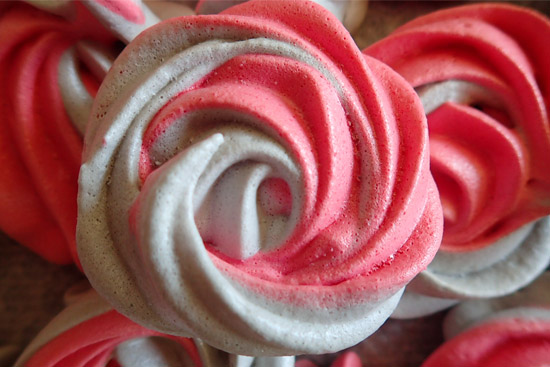
Serves: 8
Preparation time: 20 minutes
Cooking time:15 minutes
1 cup sugar3 ounces water
1 cup strawberry puree, strained
5 egg whites
In a heavy bottom saucepan, boil water and sugar to 270 degrees. Stir in the strawberry puree, and boil to 245 degrees.
Beat egg whites until light. Gradually pour the hot sugar mix while mixing at high speed. Continue beating until cool.
Use for: meringue pies, as cake filling, or soufflé glacés
Beat egg whites until light. Gradually pour the hot sugar mix while mixing at high speed. Continue beating until cool.
Use for: meringue pies, as cake filling, or soufflé glacés
Dessert Orange mousse meringue pie 
Serves: 8
Preparation time: 40 minutes
Cooking time:1 hour 10 minutes
FOR MERINGUE SHELL: 3 egg whites
1/4 teaspoon cream of tartar
1 teaspoon white vinegar
1 cup sugar
1 tablespoon cornstarch
FOR ORANGE MOUSSE FILLING:
1 envelope unflavored gelatin
1 1/2 cups orange juice
3 egg yolks
2 tablespoons grated orange rind
1/2 cup sugar
3/4 cup chilled Cool whip or whipped cream
MERINGUE SHELL:
In a mixing bowl, beat egg whites, cream of tartar and vinegar until soft peaks form. Gradually beat in the sugar, 1 tablespoon at the time until stiff glossy peaks form. Whisk in cornstarch. Line baking sheet with parchment paper or greased foil; spread with meringue to make 9-inch circles, forming 1-inch high rounded rim. Bake in center of 250 degree oven for about one hour or until crisp. Turn oven off and let meringue dry one hour. Remove from oven and gently peel off paper. Place on serving plate.
ORANGE MOUSSE FILLING:
Sprinkle gelatin over 1/2 cup. of the orange juice. Set aside. In a heavy bottom non aluminum saucepan, whisk egg yolks lightly. Add rind, remaining juice, and sugar. Cook over medium heat, stirring constantly for 5 to 10 minutes or until thick enough to coat the back of spoon. Remove from heat. Stir in the gelatin mixture to dissolve. Cover and refrigerate for about 15 minutes or until slightly thickened. In a bowl, fold Cool whip or whipped cream into gelatin mixture until combined. spoon into meringue shell. Cover and refrigerate for about 30 minutes or until set.
In a mixing bowl, beat egg whites, cream of tartar and vinegar until soft peaks form. Gradually beat in the sugar, 1 tablespoon at the time until stiff glossy peaks form. Whisk in cornstarch. Line baking sheet with parchment paper or greased foil; spread with meringue to make 9-inch circles, forming 1-inch high rounded rim. Bake in center of 250 degree oven for about one hour or until crisp. Turn oven off and let meringue dry one hour. Remove from oven and gently peel off paper. Place on serving plate.
ORANGE MOUSSE FILLING:
Sprinkle gelatin over 1/2 cup. of the orange juice. Set aside. In a heavy bottom non aluminum saucepan, whisk egg yolks lightly. Add rind, remaining juice, and sugar. Cook over medium heat, stirring constantly for 5 to 10 minutes or until thick enough to coat the back of spoon. Remove from heat. Stir in the gelatin mixture to dissolve. Cover and refrigerate for about 15 minutes or until slightly thickened. In a bowl, fold Cool whip or whipped cream into gelatin mixture until combined. spoon into meringue shell. Cover and refrigerate for about 30 minutes or until set.
Dessert Panna cotta with berry compote 
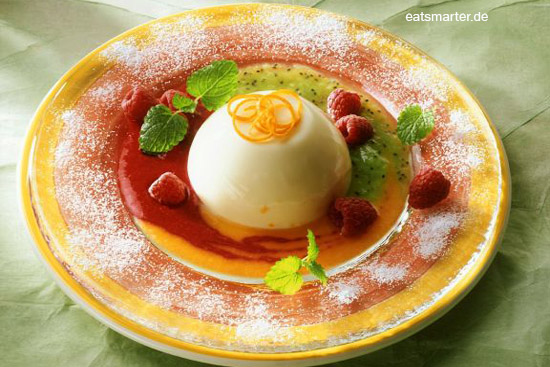
Serves: 6
Preparation time: 10 minutes
Cooking time:10 minutes
1envelope unflavored gelatin 2 tablespoons cold water
1 cup each sour cream, whipping cream and light cream
1/3 cup sugar
1 vanilla bean
Lightly oil six 5-ounce ramekins; set aside.
In small bowl sprinkle gelatin over water; set aside.
In saucepan, combine sour cream, whipping cream, light cream and sugar. Halve vanilla bean lengthwise and scrape out seeds to cream mixture (add vanilla bean halves, if desired, for additional flavor).
Place over medium heat, stirring often, until very hot; do not let boil.
Stir in gelatin mixture until dissolved. Remove vanilla bean halves.
Pour into ramekins. Chill for 4 hours or until set. To serve, run sharp knife around edges and turn out onto serving plates.
Spoon Reisling Summer Berry Compote around panna cottas. Garnish with lemon balm or mint.
In small bowl sprinkle gelatin over water; set aside.
In saucepan, combine sour cream, whipping cream, light cream and sugar. Halve vanilla bean lengthwise and scrape out seeds to cream mixture (add vanilla bean halves, if desired, for additional flavor).
Place over medium heat, stirring often, until very hot; do not let boil.
Stir in gelatin mixture until dissolved. Remove vanilla bean halves.
Pour into ramekins. Chill for 4 hours or until set. To serve, run sharp knife around edges and turn out onto serving plates.
Spoon Reisling Summer Berry Compote around panna cottas. Garnish with lemon balm or mint.
Dessert Peach custard ice cream with fresh peach compote 
Serves: 6
Preparation time: 40 minutes
Cooking time:5 minutes
Ice Cream 1 1/2 cups whipping cream
1 cup half and half
3/4 cup sugar
5 large egg yolks
1 pound peaches, peeled, sliced
1/4 cup light corn syrup
1/2 teaspoon vanilla extract
Compote:
4 large peaches, peeled, sliced
1/2 cup orange Muscat wine
1/2 cup sugar
2 teaspoons fresh lemon juice
For Ice Cream:
Bring 1 cup cream, half and half, and 1/2 cup sugar just to simmer in medium saucepan.
Whisk yolks; gradually whisk in cream mixture. Return mixture to saucepan. Stir over medium heat until custard thickens, about 4 minutes (do not boil). Strain into bowl.
Refrigerate custard until cold, about 3 hours.
Place peaches, corn syrup, and 1/4 cup sugar in medium saucepan. Stir over medium heat until peaches are heated through, about 4 minutes. Mash to coarse puree. Cool completely. Stir into custard along with vanilla and 1/2 cup cream. Process custard in ice cream maker according to manufacturer's instructions.
For Compote:
Mix all ingredients. Let stand 10 minutes and up to 1 hour, tossing occasionally. Serve ice cream with compote.
Adapted from Bon Appétit August 2002
Bring 1 cup cream, half and half, and 1/2 cup sugar just to simmer in medium saucepan.
Whisk yolks; gradually whisk in cream mixture. Return mixture to saucepan. Stir over medium heat until custard thickens, about 4 minutes (do not boil). Strain into bowl.
Refrigerate custard until cold, about 3 hours.
Place peaches, corn syrup, and 1/4 cup sugar in medium saucepan. Stir over medium heat until peaches are heated through, about 4 minutes. Mash to coarse puree. Cool completely. Stir into custard along with vanilla and 1/2 cup cream. Process custard in ice cream maker according to manufacturer's instructions.
For Compote:
Mix all ingredients. Let stand 10 minutes and up to 1 hour, tossing occasionally. Serve ice cream with compote.
Adapted from Bon Appétit August 2002
Dessert Peach ice cream 
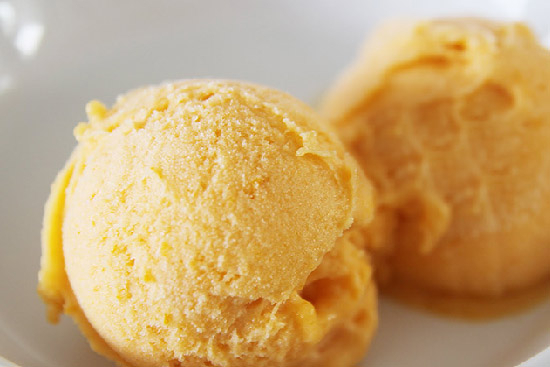
Serves: 6
Preparation time: 1 hour
Cooking time:10 minutes
1 cup milk 1 cup sugar
2 teaspoons flour
2 cups peach puree
2 teaspoons lemon juice
1 cup whipping cream
In a medium saucepan, combine the milk, sugar and flour. Whisk over medium heat until thick.
Transfer to a mixing bowl. Add the peach puree and lemon juice. Whip the cream until stiff.
Fold cream into the ice cream mixture. Freeze in an ice cream maker until creamy.
Transfer to a mixing bowl. Add the peach puree and lemon juice. Whip the cream until stiff.
Fold cream into the ice cream mixture. Freeze in an ice cream maker until creamy.
Dessert Pear tart tatin 
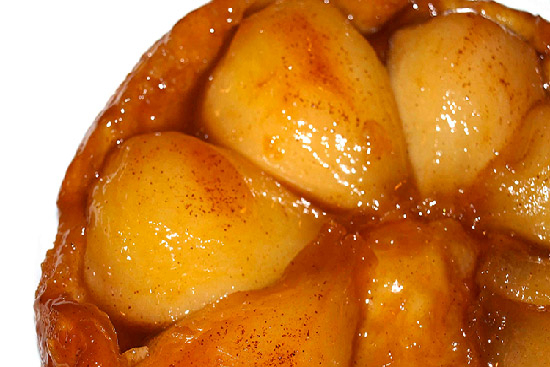
Serves: 8
Preparation time: 20 minutes
Cooking time:40 minutes
2 cans (1-lb, 14-oz size) pear halves 1 cup sugar
1 teaspoon butter
1 9-inch puff pastry circle
1 cup whipping cream
2 teaspoons confectioners' sugar
Preheat oven to 450 degrees.
Drain pears. Caramelize sugar with ¼ cup water until golden brown.
Pour caramel into the bottom of an 8½-inch round baking dish. Arrange pears, rounded side down on caramelized sugar.
Top with a second layer. Dot with butter. Bake 25 minutes. Bake pastry circle for 10 to 15 minutes or until golden brown. Place circle over pears.
Place serving plate over the top of pastry circle. Invert; remove baking dish.
Whip cream with sugar until firm. Garnish pears with whipped cream rosettes.
Drain pears. Caramelize sugar with ¼ cup water until golden brown.
Pour caramel into the bottom of an 8½-inch round baking dish. Arrange pears, rounded side down on caramelized sugar.
Top with a second layer. Dot with butter. Bake 25 minutes. Bake pastry circle for 10 to 15 minutes or until golden brown. Place circle over pears.
Place serving plate over the top of pastry circle. Invert; remove baking dish.
Whip cream with sugar until firm. Garnish pears with whipped cream rosettes.
Dessert Pears vigneronne 
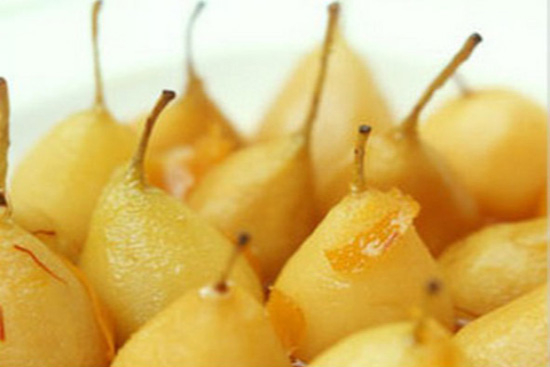
Serves: 6
Preparation time: 25 minutes
Cooking time:30 minutes
6 ripe pears 2 cups dry white wine
1/2 cup sugar
1 lemon
1 stick cinnamon
1 teaspoon vanilla extract
1/4 cup orange marmalade
1/4 cup apricot jam
Peel and core the pears.
Cut them into quarters. Place the pears in a saucepan and add the wine and sugar.
Peel the lemon and cut the peel into very fine julienne strips. Reserve the lemon for another use. Add the peel to the saucepan.
Bring to the boil and simmer for 5 to 10 minutes, or until pears are tender.
Transfer the pears and the lemon peel to a serving dish. Bring the liquid in the saucepan to the boil and add the remaining ingredients.
Bring to the boil and cook for about 10 minutes or until liquid is reduced to half.
Pour the sauce over the pears. Let cool and chill.
Cut them into quarters. Place the pears in a saucepan and add the wine and sugar.
Peel the lemon and cut the peel into very fine julienne strips. Reserve the lemon for another use. Add the peel to the saucepan.
Bring to the boil and simmer for 5 to 10 minutes, or until pears are tender.
Transfer the pears and the lemon peel to a serving dish. Bring the liquid in the saucepan to the boil and add the remaining ingredients.
Bring to the boil and cook for about 10 minutes or until liquid is reduced to half.
Pour the sauce over the pears. Let cool and chill.
Dessert Pizzellis 
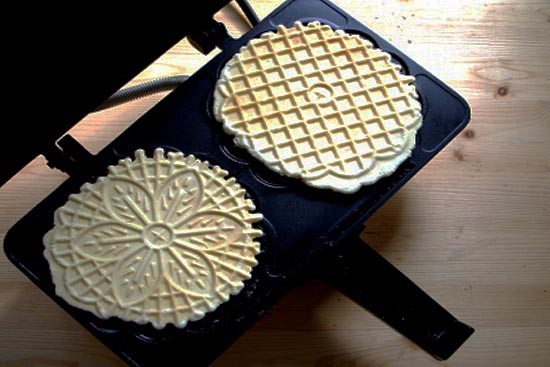
A Pizzelle is a traditional Italian sugar cookie served plain or rolled into a cone and filled with fruit or ice cream.
They can be formed into cups by draping the freshly cooked hot pizzelli over the bottom of a small glass or a similar container. They can also be shaped into ice-cream cones. See also Sicilian cannoli recipe
Serves: 15
1 cup sugar
1/2 cup melted butter
1 cup milk
1 1/2 cups all-purpose flour
1 teaspoons vanilla
Serves: 15
Preparation time: 10 minutes
Cooking time:20 minutes
2 eggs 1 cup sugar
1/2 cup melted butter
1 cup milk
1 1/2 cups all-purpose flour
1 teaspoons vanilla
Beat eggs and sugar until light and creamy.
Stir in the remaining ingredients until smooth. Cook on an electric pizzelli machine to form wafers: Preheat pizzelli maker.
Spoon 2 tablespoons of batter onto the center of the baking surface.
Close iron and gently squeeze together.
Bake for about a minute.
Cookies are baked when golden brown.
Remove from the iron with a spatula and roll-up into a cone, using the wooden rolling cone tool included. Remove and allow to cool.
Serve them cut in wedges, or while wafer is hot, or shape into a cup over a glass or similar container. Store in an airtight container.
Spoon fruit, ice cream or chocolate mousse into cup.
Stir in the remaining ingredients until smooth. Cook on an electric pizzelli machine to form wafers: Preheat pizzelli maker.
Spoon 2 tablespoons of batter onto the center of the baking surface.
Close iron and gently squeeze together.
Bake for about a minute.
Cookies are baked when golden brown.
Remove from the iron with a spatula and roll-up into a cone, using the wooden rolling cone tool included. Remove and allow to cool.
Serve them cut in wedges, or while wafer is hot, or shape into a cup over a glass or similar container. Store in an airtight container.
Spoon fruit, ice cream or chocolate mousse into cup.
Dessert Poached pears in red wine 
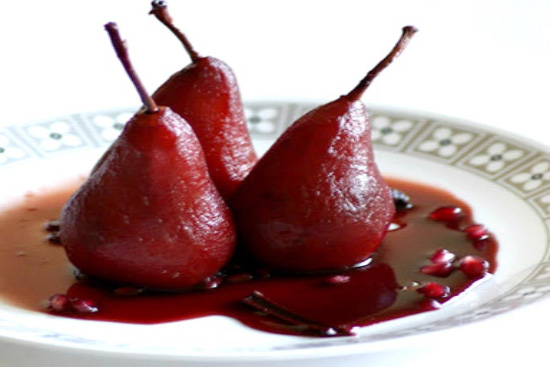
Serves: 6
Preparation time:20 minutes
Cooking time:30 minutes
6 ripe pears 2 cups red wine
1/2 cup sugar
1 lemon
1 stick cinnamon
3 whole cloves
1 teaspoon vanilla extract
Peel and core the pears. Cut them into quarters.
Place the pears in a saucepan and add the wine and sugar. Peel the lemon and cut the peel into very fine julienne strips. Reserve the lemon for another use.
Add the peel to the saucepan with cinnamon, cloves, and vanilla. Bring to the boil and simmer for 5 to 10 minutes, or until pears are tender.
Transfer the pears and the lemon peel to a serving dish.
Bring the liquid in the saucepan to the boil.
Reduce to half or until liquid becomes syrupy. Pour the sauce over the pears.
Let cool and chill.
Place the pears in a saucepan and add the wine and sugar. Peel the lemon and cut the peel into very fine julienne strips. Reserve the lemon for another use.
Add the peel to the saucepan with cinnamon, cloves, and vanilla. Bring to the boil and simmer for 5 to 10 minutes, or until pears are tender.
Transfer the pears and the lemon peel to a serving dish.
Bring the liquid in the saucepan to the boil.
Reduce to half or until liquid becomes syrupy. Pour the sauce over the pears.
Let cool and chill.
Dessert Raspberry hazelnut praline soufflé glacé 
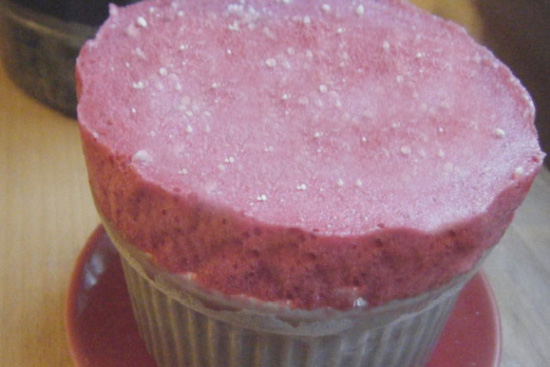
Serves: 20
Preparation time: 45 minutes
Cooking time:12 minutes
4 10-ounce packages frozen raspberries 3 envelopes unflavored gelatin
12 large eggs
3/4 teaspoon cream of tartar
1/2 cup sugar
3 cups heavy cream
1/2 cup sugar
3 cups hazelnut praline paste
2 1/2 cups Frangelico sauce (recipe follows)
FRANGELICO SAUCE:
1 cup sugar
6 ounces unsweetened chocolate
1 cup light cream
1/2 cup Frangelico (a hazelnut flavored liqueur)
Prepare the soufflé dishes:
Fit each of two 1 1/4 quart soufflé dishes with a 6 inch wide band of wax paper to form a collar extending 3 inches above the rim.
Puree raspberries with syrup and strain to remove seeds. Dissolve gelatin in 1/3 cup water.
Beat egg yolks with a cup raspberry puree over a double boiler until thick. Heat gelatin to melt and stir in egg yolk mix. Add remaining raspberry puree. Beat egg whites with cream of tartar to soft peaks. Beat cream until stiff. Fold in raspberry mix the egg whites and cream and praline.
Spoon mousse into soufflé molds. Chill covered for 3 hours. Garnish top with whipped cream. Serve with Frangelico sauce.
FRANGELICO SAUCE:
In a heavy saucepan combine sugar and water. Bring mixture to a boil until sugar is dissolved. Remove pan from heat. Stir in the chocolate until sauce is smooth. Mix in light cream and Frangelico, and allow the sauce to cool at room temperature.
Fit each of two 1 1/4 quart soufflé dishes with a 6 inch wide band of wax paper to form a collar extending 3 inches above the rim.
Puree raspberries with syrup and strain to remove seeds. Dissolve gelatin in 1/3 cup water.
Beat egg yolks with a cup raspberry puree over a double boiler until thick. Heat gelatin to melt and stir in egg yolk mix. Add remaining raspberry puree. Beat egg whites with cream of tartar to soft peaks. Beat cream until stiff. Fold in raspberry mix the egg whites and cream and praline.
Spoon mousse into soufflé molds. Chill covered for 3 hours. Garnish top with whipped cream. Serve with Frangelico sauce.
FRANGELICO SAUCE:
In a heavy saucepan combine sugar and water. Bring mixture to a boil until sugar is dissolved. Remove pan from heat. Stir in the chocolate until sauce is smooth. Mix in light cream and Frangelico, and allow the sauce to cool at room temperature.
Dessert Rose shaped apple dessert 

Serves: 6
Preparation time: 20 minutes
Cooking time:45 minutes
1 frozen puff pastry sheet, thawed2 red organic apples (like red delicious, Rome)
Juice of half lemon
1 tablespoon of flour, to sprinkle the counter
3 tablespoons of apricot preserve
cinnamon
powder sugar for decorating
1. Thaw the puff pastry.
2. Prepare a bowl with some water and the lemon juice. Cut the apples in half, remove the core and cut the apples in paper thin slices, leaving the peel so it will give the red color to your roses. place the sliced apples in the bowl with lemon and water.
3. Microwave the apples in the bowl, for about 3 minutes just to soften them. Or you can also simmer the apple slices in the water in a small pan.
4. Unwrap the puff pastry over a clean and lightly floured counter. Using a rolling pin stretch the dough a little, trying to keep it in a rectangular shape. Cut the dough in 6 strips. These are about 2 in x 9 in (5 cm x 22 cm).
5. In a bowl, place three tablespoons of apricot preserve with two tablespoons of water. Microwave for about one minute, so that the preserve will be easier to spread. Spread the preserve on the dough.
6. Preheat the oven to 375 degrees F (190 degrees C). Drain the apples.
7. Place the apples on the edge of dough, with the unpeeled edges extending over the dough Sprinkle with cinnamon.
8. Fold up the bottom part of the dough.
9. Carefully roll, seal the edge, and place in a greased muffin cup.
10. Do the same for all 6 roses. Bake at 375 degrees F (190 degrees C) for about 40-45 minutes, until fully cooked.
NOTE: make sure the pastry is fully cooked on the inside before removing the roses from the oven! If after 30 minutes the apples on top look fully cooked, move the pan to a lower rack in the oven, and wait for 10-15 more minutes to avoid undercooking the puff pastry.
Sprinkle with powder sugar and enjoy!
2. Prepare a bowl with some water and the lemon juice. Cut the apples in half, remove the core and cut the apples in paper thin slices, leaving the peel so it will give the red color to your roses. place the sliced apples in the bowl with lemon and water.
3. Microwave the apples in the bowl, for about 3 minutes just to soften them. Or you can also simmer the apple slices in the water in a small pan.
4. Unwrap the puff pastry over a clean and lightly floured counter. Using a rolling pin stretch the dough a little, trying to keep it in a rectangular shape. Cut the dough in 6 strips. These are about 2 in x 9 in (5 cm x 22 cm).
5. In a bowl, place three tablespoons of apricot preserve with two tablespoons of water. Microwave for about one minute, so that the preserve will be easier to spread. Spread the preserve on the dough.
6. Preheat the oven to 375 degrees F (190 degrees C). Drain the apples.
7. Place the apples on the edge of dough, with the unpeeled edges extending over the dough Sprinkle with cinnamon.
8. Fold up the bottom part of the dough.
9. Carefully roll, seal the edge, and place in a greased muffin cup.
10. Do the same for all 6 roses. Bake at 375 degrees F (190 degrees C) for about 40-45 minutes, until fully cooked.
NOTE: make sure the pastry is fully cooked on the inside before removing the roses from the oven! If after 30 minutes the apples on top look fully cooked, move the pan to a lower rack in the oven, and wait for 10-15 more minutes to avoid undercooking the puff pastry.
Sprinkle with powder sugar and enjoy!
Dessert Sicilian cannoli 

The recipe makes 30 to 32 wafers. Use 12 for this recipe and reserve the remaining in a closed container.
The cannoli are made using a pizelle maker. A Pizzelle is a traditional Italian sugar cookie served plain or rolled into ice-cream cones or in this recipe into cannoli shells.
Serves: 6
1 cup sugar
1/2 cup melted butter
1 cup milk
1 1/2 cups all-purpose flour
1 teaspoons vanilla Filling:
16 oz Mascarpone
1/3 cup whipping cream
1/2 powdered sugar, plus more for garnish
Garnish: chopped pistachio nuts
The cannoli are made using a pizelle maker. A Pizzelle is a traditional Italian sugar cookie served plain or rolled into ice-cream cones or in this recipe into cannoli shells.
Serves: 6
Preparation time:30 minutes
Cooking time:15 minutes
2 eggs1 cup sugar
1/2 cup melted butter
1 cup milk
1 1/2 cups all-purpose flour
1 teaspoons vanilla Filling:
16 oz Mascarpone
1/3 cup whipping cream
1/2 powdered sugar, plus more for garnish
Garnish: chopped pistachio nuts
Beat eggs and sugar until light and creamy.
Stir in the remaining ingredients until smooth.
Preheat pizzelli maker.
Spoon 2 tablespoons of batter onto the center of the baking surface of the pizzelli maker. Close the cover. Bake for about a minute.
Cookies are baked when golden brown.
While wafer is hot, shape into cannoli shells. Store in an airtight container.
Filling:
Whip the chilled cream until stiff peaks form. Add the powdered sugar. Whisk the mascarpone and gently fold in the whipped cream.
Scoop filling into a piping bag fitted with a tip to fill each shell. Sprinkle chopped pistachios over each end of the filled cannoli and dust with powdered sugar.
Stir in the remaining ingredients until smooth.
Preheat pizzelli maker.
Spoon 2 tablespoons of batter onto the center of the baking surface of the pizzelli maker. Close the cover. Bake for about a minute.
Cookies are baked when golden brown.
While wafer is hot, shape into cannoli shells. Store in an airtight container.
Filling:
Whip the chilled cream until stiff peaks form. Add the powdered sugar. Whisk the mascarpone and gently fold in the whipped cream.
Scoop filling into a piping bag fitted with a tip to fill each shell. Sprinkle chopped pistachios over each end of the filled cannoli and dust with powdered sugar.
Dessert Strawberries with zabaglione sauce 
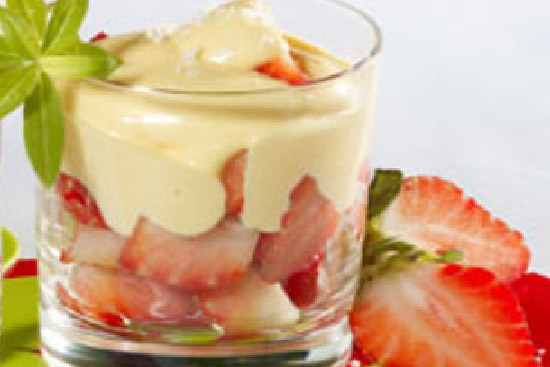
Serves: 6
Preparation time: 15 minutes
Cooking time:8 minutes
2 pints fresh strawberries3 egg yolks
1/4 cup sugar
1/3 cup dry white wine
2 teaspoons Grand Marnier
1/2 cup sliced almonds, toasted
1/2 cup Cool whip
Cut the strawberries into quarters or slices. Place in individual crystal compote dishes or other bowl.
Combine the egg yolks, sugar, and wine in a metal mixing bowl. Set over a pot with boiling water.
Whisk egg yolks until thick and creamy, about 6 to 8 minutes. Stir in the Grand Marnier. Add Cool whip. Spoon zabaglione sauce over strawberries, and top with sliced almonds.
Combine the egg yolks, sugar, and wine in a metal mixing bowl. Set over a pot with boiling water.
Whisk egg yolks until thick and creamy, about 6 to 8 minutes. Stir in the Grand Marnier. Add Cool whip. Spoon zabaglione sauce over strawberries, and top with sliced almonds.
Dessert Strawberry-topped lime mousse tart 
Serves: 8
Preparation time: 40 minutes
Cooking time:30 minutes
For crust: 3/4 cup all purpose flour
1/3 cup whole almonds, toasted
1/3 cup powdered sugar
1/4 teaspoon salt
6 tablespoons unsalted butter, cold
2 teaspoons cold water
For filling:
1/4 cup fresh lime juice
1/2 teaspoon unflavored gelatin
3/4 cup chilled whipped cream, (divided into 1/4 cup and 1/2 cup)
5 ounces white chocolate
1 teaspoon grated lime peel
2 tablespoons sugar
2 tablespoons sour cream
Topping:
3 12-ounce baskets strawberries, washed, hulled, sliced
1/3 cup seedless raspberry jam
Crust:
Preheat oven at 375 degrees.
Blend first 4 ingredients in processor until nuts are ground. Add butter cut into small pieces, and mix until dough has a fine texture. Blend in enough water until mixture forms a ball. Press dough evenly over bottom and up sides of tart pan. Freeze crust for 30 minutes. Bake until golden brown for about 30 minutes.
Filling:
In a small bowl, combine the lime juice and gelatin. Let stand for 10 minutes to soften. Bring 1/4 cup cream to simmer in medium saucepan. Stir in the white chocolate. Add gelatin mixture; stir to dissolve. Mix in peel. Chill until cold and beginning to thicken but not set, stirring often.
Whip sugar, sour cream and remaining 1/2 cup cream to medium-stiff peaks.
Fold whipped cream mixture into the white chocolate mixture. Spoon mousse into crust.
Chill until mousse sets, about 2 hours.
Arrange berries atop the mousse.
Melt jam in small saucepan over low heat. Brush jam over strawberries to glaze.
Preheat oven at 375 degrees.
Blend first 4 ingredients in processor until nuts are ground. Add butter cut into small pieces, and mix until dough has a fine texture. Blend in enough water until mixture forms a ball. Press dough evenly over bottom and up sides of tart pan. Freeze crust for 30 minutes. Bake until golden brown for about 30 minutes.
Filling:
In a small bowl, combine the lime juice and gelatin. Let stand for 10 minutes to soften. Bring 1/4 cup cream to simmer in medium saucepan. Stir in the white chocolate. Add gelatin mixture; stir to dissolve. Mix in peel. Chill until cold and beginning to thicken but not set, stirring often.
Whip sugar, sour cream and remaining 1/2 cup cream to medium-stiff peaks.
Fold whipped cream mixture into the white chocolate mixture. Spoon mousse into crust.
Chill until mousse sets, about 2 hours.
Arrange berries atop the mousse.
Melt jam in small saucepan over low heat. Brush jam over strawberries to glaze.
Dessert Upside-down peach cake 
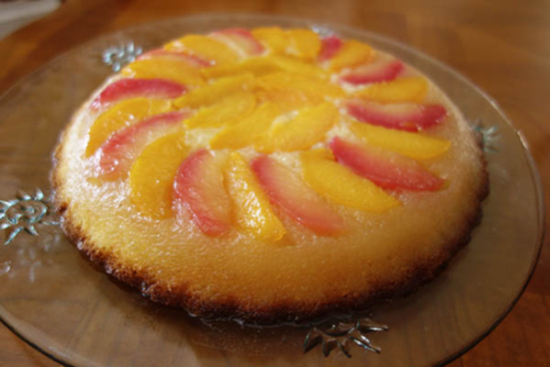
Serves: 8
Preparation time: 30 minutes
Cooking time:55 minutes
8 ripe peaches (fresh, canned or frozen) 3 teaspoons soft butter
1/2 cup sugar
6 tablespoons (3/4 stick) soft butter
1/2 cup sugar
1 egg
1 teaspoon vanilla extract
1 1/4 cup cake flour
1 1/2 teaspoon baking powder
pinch salt
melted apricot glaze or strawberry jam
Preheat oven at 350 degrees.
Blanch and peel 8 ripe peaches. Cut in halves. Or use canned or frozen peaches. Slice 1 inch thick.
Butter a 9-by 1 1/2-inch round cake pan with 3 tablespoons soft butter, and sprinkle with 1/2 c. sugar over butter. Arrange peaches close together in a circle in the pan.
In an electric mixer, cream 3/4 stick (6 tablespoons) soft butter with 1/2 cup sugar. Beat in 1 egg, and 1 teaspoon vanilla.
Sift together 1 1/4 cup cake flour, 1 1/2 teaspoons baking powder, and a pinch salt and combine into butter sugar mixture.
Gradually stir in flour batter over peaches, smoothing top.
Bake cake 55 minutes to 1 hour, or till brown.
Cool on rack for 10 min.
Invert on a platter. Brush peaches with melted apricot glaze or strained strawberry jam. Serve with whipped cream.
Blanch and peel 8 ripe peaches. Cut in halves. Or use canned or frozen peaches. Slice 1 inch thick.
Butter a 9-by 1 1/2-inch round cake pan with 3 tablespoons soft butter, and sprinkle with 1/2 c. sugar over butter. Arrange peaches close together in a circle in the pan.
In an electric mixer, cream 3/4 stick (6 tablespoons) soft butter with 1/2 cup sugar. Beat in 1 egg, and 1 teaspoon vanilla.
Sift together 1 1/4 cup cake flour, 1 1/2 teaspoons baking powder, and a pinch salt and combine into butter sugar mixture.
Gradually stir in flour batter over peaches, smoothing top.
Bake cake 55 minutes to 1 hour, or till brown.
Cool on rack for 10 min.
Invert on a platter. Brush peaches with melted apricot glaze or strained strawberry jam. Serve with whipped cream.
Dessert White chocolate and raspberry tart 
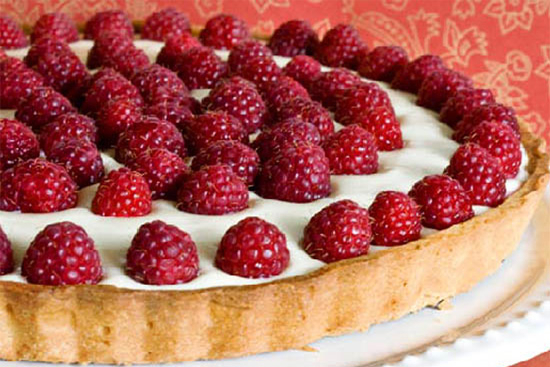
This recipe was featured in Homemaker's Magazine and is from Toronto's Grano Restaurant in Canada
Serves: 10
2 cups flour
1/2 cup sugar
3/4 cup butter, cubed
1 tablespoon water
1 egg, beaten
Filling:
1 pound good quality white chocolate, chopped
5 tablespoons butter
2/3 cup whipping cream
2 cups raspberries
Serves: 10
Preparation time: 30 minutes
Cooking time:30 minutes
Pastry: 2 cups flour
1/2 cup sugar
3/4 cup butter, cubed
1 tablespoon water
1 egg, beaten
Filling:
1 pound good quality white chocolate, chopped
5 tablespoons butter
2/3 cup whipping cream
2 cups raspberries
Pastry:
Place flour, butter and sugar in food processor and pulse until fine crumbs form. Add egg and water. Pulse again until ball of dough forms.
Roll out dough and place in 11-inch flan pan. Chill for 15 to 20 minutes.
Preheat oven to 400 degrees. Cover dough with sheet of foil and weight with dried beans or pastry weights.
Bake for 20 minutes or until pastry is lightly browned.
Remove foil and beans and bake for 5 to 8 minutes longer.
Filling:
Melt chocolate and butter in double boiler over hot (not boiling) water. Stir in cream; remove from heat and let cool slightly.
Arrange raspberries over bottom of pastry shell and cover with chocolate mixture.
Refrigerate for at least 4 hours before serving.
Place flour, butter and sugar in food processor and pulse until fine crumbs form. Add egg and water. Pulse again until ball of dough forms.
Roll out dough and place in 11-inch flan pan. Chill for 15 to 20 minutes.
Preheat oven to 400 degrees. Cover dough with sheet of foil and weight with dried beans or pastry weights.
Bake for 20 minutes or until pastry is lightly browned.
Remove foil and beans and bake for 5 to 8 minutes longer.
Filling:
Melt chocolate and butter in double boiler over hot (not boiling) water. Stir in cream; remove from heat and let cool slightly.
Arrange raspberries over bottom of pastry shell and cover with chocolate mixture.
Refrigerate for at least 4 hours before serving.
Dessert Wine jelly 
Serves: 6
Preparation time: 15 minutes
Cooking time:none
2 envelopes unflavored gelatin 1 cup sugar
1/3 cup orange juice
3 tablespoons lemon juice
1/2 cup red wine
1/2 cup Madeira wine
Mix the gelatin and sugar together in small bowl. Stir in 1/2 cup cold water and let soften for 5 minutes. Pour 1 1/2 cups boiling water over and mix well to dissolve. Add orange juice, lemon juice and wines. Pour into a mold and chill until firm.
conversion of liquids
Weights
Temperatures
Measures of non liquid ingredients
Non-liquid ingredients in volume converted
|
|||||||
|---|---|---|---|---|---|---|---|
Ingredient |
1 cup |
3/4 cup |
2/3 cup |
1/2 cup |
1/3 cup |
1/4 cup |
2 tablespoons |
| All-purpose wheat flour | 120 g | 90 g | 80 g | 60 g | 40 g | 30 g | 15 g |
| All-purpose sifted wheat flour | 110 g | 80 g | 70 g | 55 g | 35 g | 27 g | 13 g |
| White sugar | 200 g | 150 g | 130 g | 100 g | 65 g | 50 g | 25 g |
| Powdered sugar/Icing sugar | 100 g | 75 g | 70 g | 50 g | 35 g | 25 g | 13 g |
| Brown sugar normally packed | 180 g | 135 g | 120 g | 90 g | 60 g | 45 g | 23 g |
| Corn flour | 160 g | 120 g | 100 g | 80 g | 50 g | 40 g | 20 g |
| Cornstarch | 120 g | 90 g | 80 g | 60 g | 40 g | 30 g | 15 g |
| Rice (not-cooked) | 190 g | 140 g | 125 g | 95 g | 65 g | 48 g | 24 g |
| Macaroni (uncooked) | 140 g | 100 g | 90 g | 70 g | 45 g | 35 g | 17 g |
| Couscous (uncooked) | 180 g | 135 g | 120 g | 90 g | 60 g | 45 g | 22 g |
| Quick oatmeal (uncooked) | 90 g | 65 g | 60 g | 45 g | 30 g | 22 g | 11 g |
| Table salt | 300 g | 230 g | 200 g | 150 g | 100 g | 75 g | 40 g |
| Butter / Margarine | 240 g | 180 g | 160 g | 120 g | 80 g | 60 g | 30 g |
| Shortening | 190 g | 140 g | 125 g | 95 g | 65 g | 48 g | 24 g |
| Fruits and légumes chopped | 150 g | 110 g | 100 g | 75 g | 50 g | 40 g | 20 g |
| chopped walnuts | 150 g | 110 g | 100 g | 75 g | 50 g | 40 g | 20 g |
| Nuts /ground almonds | 120 g | 90 g | 80 g | 60 g | 40 g | 30 g | 15 g |
| Fresh bread crumbs (not packed) | 60 g | 45 g | 40 g | 30 g | 20 g | 15 g | 8 g |
| Dry bread crumbs | 150 g | 110 g | 100 g | 75 g | 50 g | 40 g | 20 g |
| Parmesan grated | 90 g | 65 g | 60 g | 45 g | 30 g | 22 g | 11 g |
| Chocolate chips | 150 g | 110 g | 100 g | 75 g | 50 g | 38 g | 19 g |
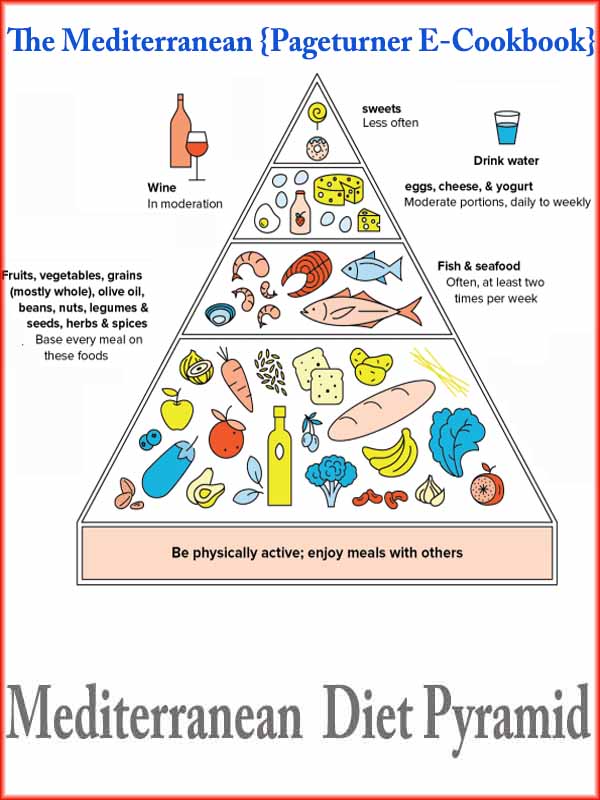

As the sun rises or sets in
ITALY
"May every sunrise hold more promise, and every sunset hold more peace."
The {Page Turner} E-Cookbooks
Library on a world cooking journey
221 Recipes
59 Appetizers
119 Main dishes
43 Desserts











